- Panch Kedar
- Helicopter Services
- Weather in Kedarnath
- Kedarnath Temple
- Badrinath Temple
- Gangotri Temple
- Yamunotri Temple
- Kedarnath Yatra

Kedarnath Trek – 16 Km (Travel Guide)
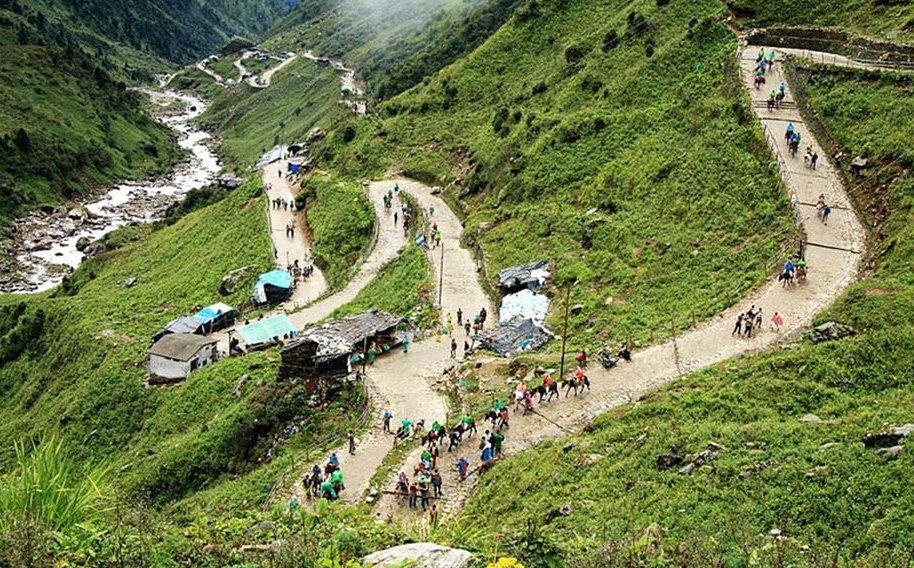
The Kedarnath trek is one of the most challenging and difficult treks in India. But it got easier when pilgrims chant the name of Kedar Baba (Lord Shiva). Here in this article, we have shared a complete travel guide for the trekking tour at Kedarnath Temple.
About Kedarnath Trek
Kedarnath Trek is a popular pilgrimage and trekking destination in the Indian state of Uttarakhand. The trek leads to the Kedarnath temple, one of the four major shrines in Hinduism, located at an altitude of 3,583 meters (11,755 feet) above sea level.
The trek to Kedarnath starts from a place called Gaurikund, which is located at a distance of 16 km from Kedar Nath Temple. The trek takes you through some beautiful and scenic landscapes, including lush green forests, waterfalls, and streams.
The route is steep and challenging in some places, but the stunning views of the Himalayan peaks make it all worth it.
Best Time To Visit Kedarnath Trek
The best time to undertake the Kedarnath trek is from May to June and from September to November, as the weather during these months is mild and pleasant.
During the monsoon season, which is from July to August, the trek can be risky due to the possibility of landslides and flooding.
The Kedarnath trek is considered a holy pilgrimage by Hindus, and thousands of devotees undertake this trek every year to seek the blessings of Lord Shiva.
However, it is also a popular trekking destination for adventure enthusiasts and nature lovers who want to experience the beauty of the Himalayas up close.
Best Time for Char Dham Visit
- Best Time To Visit Kedarnath
- Best Time To Visit Badrinath
- Best Time To Visit Gangotri
- Best Time To Visit Yamunotri
Kedarnath Trek Distance and Time
- The distance of the Kedarnath Trek is around 16 km (one way) from Gaurikund to Kedarnath Temple.
- The trek can be completed in a minimum of 2 days, with a one-night halt at Kedarnath, or it can be completed in a single day by experienced trekkers.
- The trek from Gaurikund to Kedarnath takes around 6-7 hours to complete, depending on the fitness level of the trekker.
On the first day, trekkers usually cover a distance of around 7-8 km from Gaurikund to Kedarnath. The trek route passes through scenic locations like Jangal Chatti, Bheembali, Rambara, Lincholi, and Chhani Camp which are popular camping sites, and there is a hot water spring also.
On the second day, trekkers can explore the Kedarnath temple and surrounding areas and start the return journey to Gaurikund. The return journey takes around 5-6 hours to complete and covers a distance of around 9 km.
Can I Complete Kedarnath Trekking Non-stop?
Yes, Most of the young people complete the Kedarnath trek in one go. and Stay at Kedarnath Temple at the night and then return the next day.
- A young person with a good fitness level can complete this 16km trek in 6-7 hours (non-stop) while going upside to the temple. (Upward direction)
- Returning time for the same distance will be around 5 hours . (Down direction)
Up-Down Daily Timings by the Temple Authority
- Last Timing for Upcoming Visitors – 5 Pm (Evening)
- Last Timing for Downgoing Visitors – 6:30 PM (Evening)
It is important to note that the duration of the trek may vary depending on the fitness level of the trekker and the weather conditions.
It is always advisable to undertake the trek under the guidance of an experienced trekking guide and to carry essential gear and supplies for the trek.
Don’t forget to check out this Best-selling TREKKING Bag on Amazon

Kedarnath Trek Route Map (New)
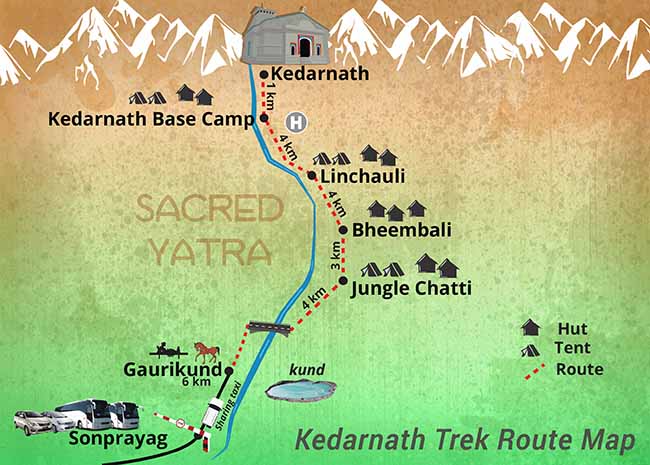
There are mainly 10 Checkpoints in the route of the Kedarnath Trek. These checkpoints are shown below in the order they come during the 16km trekking.
- Gaurikund (गौरीकुंड)
- Jangal Chatti (जंगल चट्टी)
- Bheembali (भीमबली)
- Rambara (रामबाड़ा)
- Chhota Lincholi (छोटी लिंचोली)
- Lincholi (लिंचोली)
- Chhani Camp (छानी कैंप)
- Rudra Point (रूद्र पॉइंट)
- Base Camp (बेस कैंप)
- Kedarnath Temple (केदारनाथ मंदिर)
Kedarnath Trek Route Length
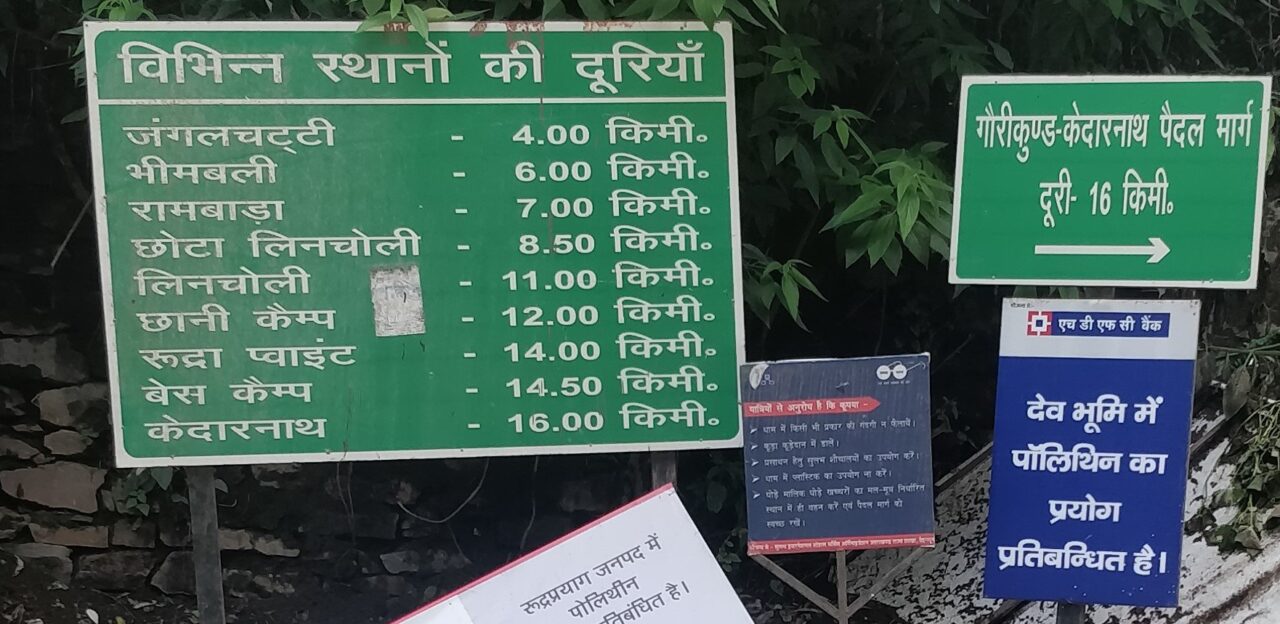
- Gaurikund To Jangle Chatti/Bhairon Chatti distance is 4 km.
- Jangle/Bhairon Chatti To Bheembali distance is 3 km.
- Bheembali To Linchauli distance is 4 km.
- Linchauli To K. Base Camp distance is 4 km.
- K. Base Camp To Kedarnath Temple distance is 1 km.
Char Dham Distance from Delhi
- Delhi to Kedarnath (466 km)
- Delhi to Badrinath (555 km)
- Delhi to Gangotri (530 km)
- Delhi to Yamunotri (485 km)
Gaurikund to Kedarnath Trek
Gaurikund is a Hindu pilgrimage site and base camp for trek to Kedarnath Temple. It is situated at an altitude of 6502 feet above mean sea level in the Garhwal Himalayas in the Rudraprayag district of Uttarakhand.
There are various options available at the starting point (Gaurikund) of the Kedarnath Trek. To complete the trek route, you have three options there.
- by Walking (Trekking)
Read More: Gaurikund to Kedarnath Guide
Explore Kedarnath
- History of Kedarnath
- Weather i n Kedarnath
- Hotels i n Kedarnath
- Meditation Cave i n Kedarnath
- 21 Facts About Kedarnath
- Kedarnath Yatra 2023 Guide
Here are the most Frequently Asked Questions about Kedarnath Trek.
How long is Kedarnath Trek?
The length of the Kedarnath Trekking route is around 16-18 kilometers from Gaurikund to Kedarnath temple.
How much time does it take for Kedarnath Trek?
The Kedarnath Trekking usually takes 2 days to complete (If stops midway for rest). And for a young fit person, it takes 6-7 hours to reach the Kedarnath temple. (nonstop)
From Where Does Kedarnath Trek Start?
The Kedarnath Trekking route starts from Gaurikund.
How difficult is Kedarnath Trek?
The Kedarnath Trekking is considered a moderate to difficult level.
How many km is Trek to Kedarnath?
The trekking route to Kedarnath is around 16 kilometers one way.
How to prepare for Kedarnath Trek?
To prepare for the Trek, one should focus on physical fitness, pack appropriate clothing and gear, carry essential items like water and food, and acclimatize to the high altitude.
What to wear in Kedarnath Trek?
For Trekking at Kedarnath, it is recommended to wear comfortable trekking shoes, quick-drying pants and t-shirts, a warm jacket, a hat, sunglasses, and sunscreen. It is also important to carry rain gear and warm clothes for the night as the temperature can drop significantly.
Which trek is more difficult Kedarnath or Amarnath?
Kedarnath and Amarnath’s treks are both considered challenging, but the Kedarnath trekking is comparatively easier than the Amarnath. (due to the difference in the distance)
How steep is Kedarnath Trek?
The Kedarnath Trek is considered a moderate to difficult level, with several steep ascents and descents along the route.
The trekking route involves walking uphill for a significant portion of the journey, with an altitude gain of around 3,550 feet (1,082 meters) from Gaurikund to Kedarnath.
The terrain can be rocky and uneven at times, and there are several sections of the trail that require careful footing and a good level of fitness. The steepness of the trek can vary depending on the specific route taken and the individual’s level of physical fitness.
Overall, the Kedar Trek is a challenging but rewarding experience, with stunning views of the Himalayan mountain range and opportunities to explore the region’s natural beauty and cultural heritage. It is important to prepare properly and take necessary precautions to ensure a safe and enjoyable trekking experience.
Things to carry for Kedarnath Trek?
Some of the essential things to carry for the Kedarnath Trekking are comfortable trekking shoes, warm clothes, rain gear, sunscreen, sunglasses, a hat, a first aid kit, sufficient water and snacks, and a backpack to carry all the gear. It is also recommended to carry a trekking pole and a camera to capture the beautiful views.
Here is a list of things to carry for the Kedarnath Trekking:
- Clothing: Carry warm clothing such as thermals, fleece jackets, and windcheaters. It can get chilly at night, so bring a warm hat and gloves as well. Wear quick-dry, breathable clothes that are comfortable to trek in. Also, carry an extra set of clothes for emergencies.
- Footwear: As discussed earlier, wear comfortable and sturdy hiking boots or shoes with good grip and ankle support.
- Backpack: A good quality backpack with a capacity of around 40-50 liters is recommended to carry your essentials. It should have padded straps and a waist belt for better support.
- Sleeping Bag: Carry a good quality sleeping bag that is rated for the appropriate temperature range.
- Trekking Poles: Trekking poles help provide extra support and balance on uneven terrain. They are particularly useful when ascending or descending steep slopes.
- Water Bottles : Carry at least 2-3 liters of water, and ensure drink enough water throughout the trek.
- First Aid Kit : Carry a well-equipped first aid kit with essential medicines, band-aids, antiseptics, pain relievers, and any prescription medication you may require.
- Sunscreen, Sunglasses, and Hat : Protect yourself from the harsh sun by carrying sunscreen with SPF 50+, sunglasses with UV protection, and a hat.
- Personal Toiletries : Carry a small towel, hand sanitizer, wet wipes, toilet paper, and any personal toiletries you may require.
- Power bank and Extra Batteries : Carry a good quality flashlight or headlamp with extra batteries for use during early morning starts, late evening walks, or in case of power outages.
Remember to pack light and carry only essentials for the trek. Avoid carrying unnecessary items that add weight to your backpack.
Kedarnath Trek Itinerary?
Here’s a brief itinerary for the Kedarnath Trek:
- Day 1: Reach Gaurikund and hike to Kedarnath (16-18 km)
- Day 2: Explore Kedarnath and acclimatize to the high altitude
- Day 3: Trek back to Gaurikund (16-18 km)
Note : The duration of the trek can be extended depending on the fitness level of the trekker and weather conditions.
Best shoes for Kedarnath Trek?
The best shoes for Kedarnath Trekking are comfortable and sturdy trekking shoes with good grip, ankle support, and waterproofing to tackle the steep and rocky terrain.
Some good options for shoes for the Kedarnath Trek include hiking boots or shoes from well-known brands such as Salomon, Merrell, or The North Face. It is important to break in your shoes before the trek and wear them around for a few weeks to ensure that they are comfortable and fit well.
Trekking to Kedarnath at the night is generally not recommended as it can be quite risky and dangerous. The trek is quite challenging, and even during the day, it requires a good level of fitness and stamina.
Trekking at night can be more challenging due to low visibility and increased chances of slipping, tripping, or losing the trail.
Moreover, the trail to Kedarnath is located in a remote mountainous region with steep inclines, rocky terrain, and unpredictable weather conditions. It can be risky to trek in the dark without proper lighting, equipment, and a guide. There have been cases of trekkers getting lost or injured during night treks to Kedarnath.
Therefore, it is advisable to trek to Kedarnath during the daytime when the weather and visibility are better, and there is more help available in case of emergencies.
If you do plan to trek at night, it is essential to prepare adequately, carry appropriate gear, and seek the advice of experienced guides or local authorities.
- Privacy Policy

Kedarkantha Trek
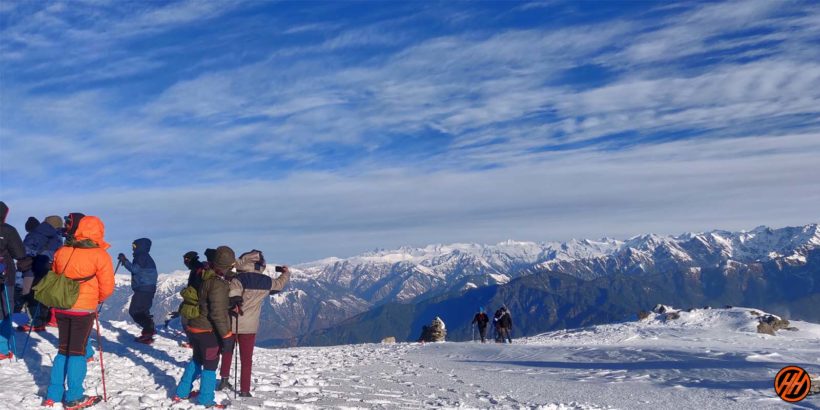
Description
Reviews (68), things to take, available dates, include / exclude, kedarkantha trek – a summit peak at an altitude of 3800 m in uttarakhand himalayas – 2024.
The Kedarkantha winter trek is indeed special, and several aspects contribute to its uniqueness:
Snow-Covered Landscapes: One of the main attractions of the Kedarkantha trek during winter is the snow-covered landscapes. The entire region gets transformed into a winter wonderland, with trees, meadows, and mountains covered in pristine white snow.
Breathtaking Views: The trek offers breathtaking panoramic views of the Himalayan peaks. On a clear day, you can see prominent peaks like Swargarohini, Bandarpoonch, Black Peak, and others, creating a stunning backdrop for your trekking adventure. Winter Camping: Camping in the snow is a unique experience.
If you want to do Kedarkantha Trek with a local trekking organisation then welcome with Himalayan Hikers Team . We treat our trekkers like a family and we have the Most luxurious and expensive hotel and homestay in Sankri like The Grand Shiva Home Stay or Hotel Swargarohini Palace for your luxurious stay and camping stay including with the trek. The Trek route is Sankri, Juda ka Talab, Kedarkantha Base Camp, and Hargaon Camp, and we also provide delicious food every day 4 to 5 times to our trekkers. We have an experienced local Guide, Cooking Team, Helpers, and Transport Pickup and Drop from Dehradun Railway Station.
The special and correct route of the Kedarkantha trek is from Sankri only, from where we have been doing it for about 32 years.
We Provide healthy, and tasty food, served hot all the time, Breakfast, Lunch, evening snacks, soup, and Dinner, along with morning and evening hot water provided to trekkers, which is essential in winter trek to Kedarkantha. Also, medical kits and oxygen cylinders, technical equipment are kept, MICRO spikes for Hiking in snow are provided free of cost during the trek
Route of Kedarkantha Trek
Dehradun to Sankri Base Camp Main Market, Then – Sankri to Juda Ka Talab, Kedarkantha Base camp, Kedarkantha Peak Summit-12500 ft- then Hargaon, Sankri Back to Dehradun
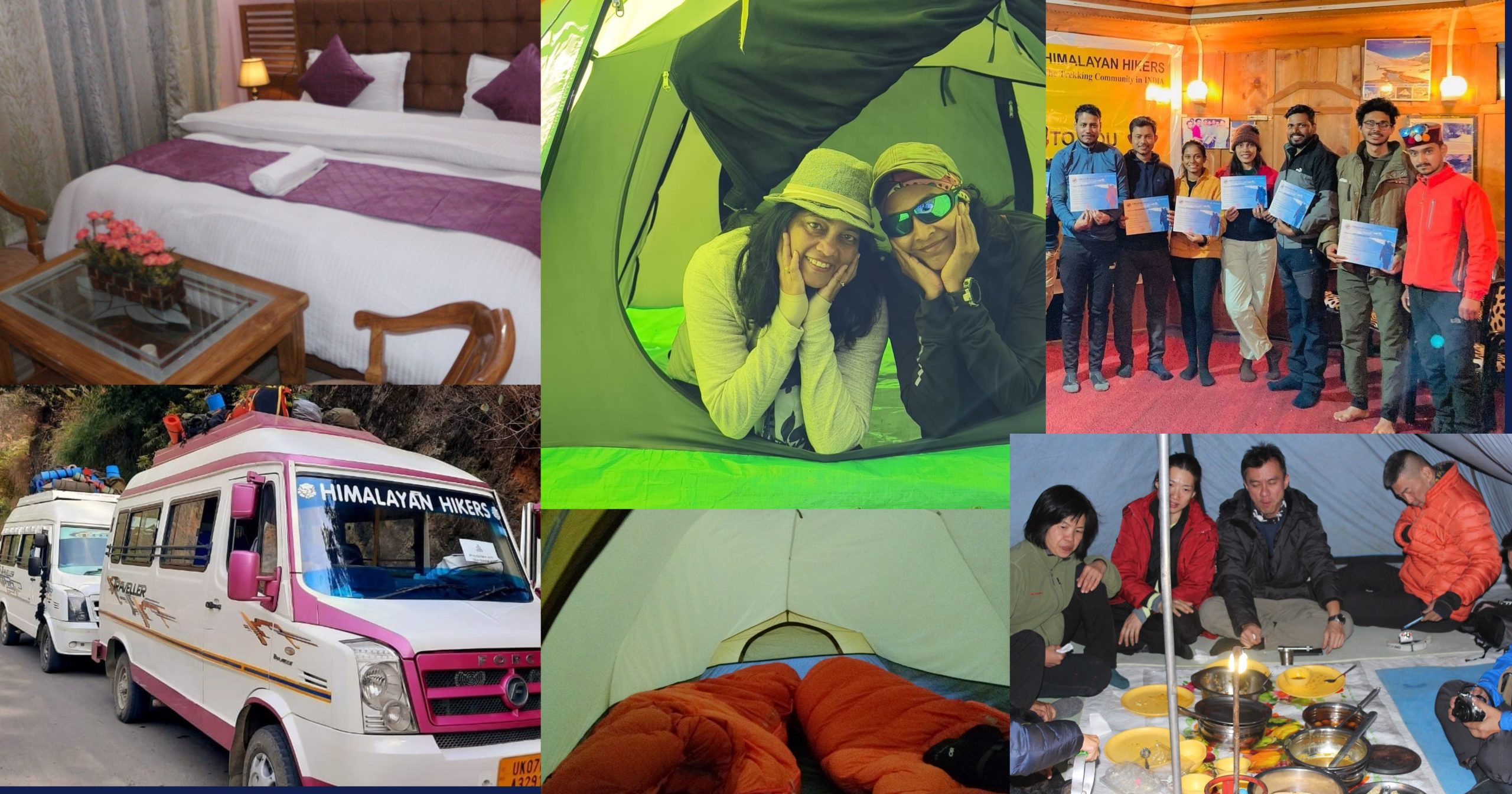
Kedarkantha Trek is a beautiful Winter Trek in Uttarakhand, Himalayas -India
Here are some highlights of kedarkantha trek:.
Snow-covered landscapes: Kedarkantha Trek is famous for its snow-covered landscapes, which offer a breathtaking view of the Himalayan peaks.
Summit climb: The trek involves a summit climb to the Kedarkantha peak, which stands at an elevation of 12,500 feet.
Stunning views: From the summit, you can enjoy stunning views of the surrounding peaks, including Swargarohini, Bandarpoonch, and Kalanag.
Campsites: The trek offers some of the most beautiful camping sites, where you can spend the night under the starry sky.
Local culture: The trek takes you through traditional villages of the Uttarakhand region, where you can get a glimpse of the local culture and way of life.
Difficulty level: The trek is considered a moderate Trek, making it ideal for both beginners and experienced trekkers.
Accessibility: Kedarkantha trek is easily accessible from major cities like Delhi, making it a popular weekend getaway.
Juda ka Talab is a scenic high-altitude lake located in the Govind Wildlife Sanctuary in Uttarakhand, India. Here are some of the highlights of this beautiful destination
Natural Beauty: The lake is surrounded by the majestic Himalayas, with stunning views of snow-capped peaks and lush green forests.
Camping: There are several campsites around the lake where you can spend the night under the stars and enjoy the peaceful ambiance of the surrounding wilderness.
Bird Watching: Juda ka Talab is home to a variety of rare bird species, including Himalayan monals, snow pigeons, and koklass pheasants, making it a paradise for bird watchers.
Flora and Fauna: The lake is surrounded by dense forests of rhododendron, oak, and deodar, which are home to a variety of wildlife species like musk deer, bharal, and leopards.
Religious Significance: The lake is considered sacred by the locals, who believe that it is connected to the Mahabharata epic.
Overall, the Kedarkantha trek is a perfect blend of adventure, natural beauty, and cultural exploration.
We have Trekking Equipment available on Rent, which you can pick up from our Himalayan Hikers Shop at Sankri Base Camp of Kedarkantha
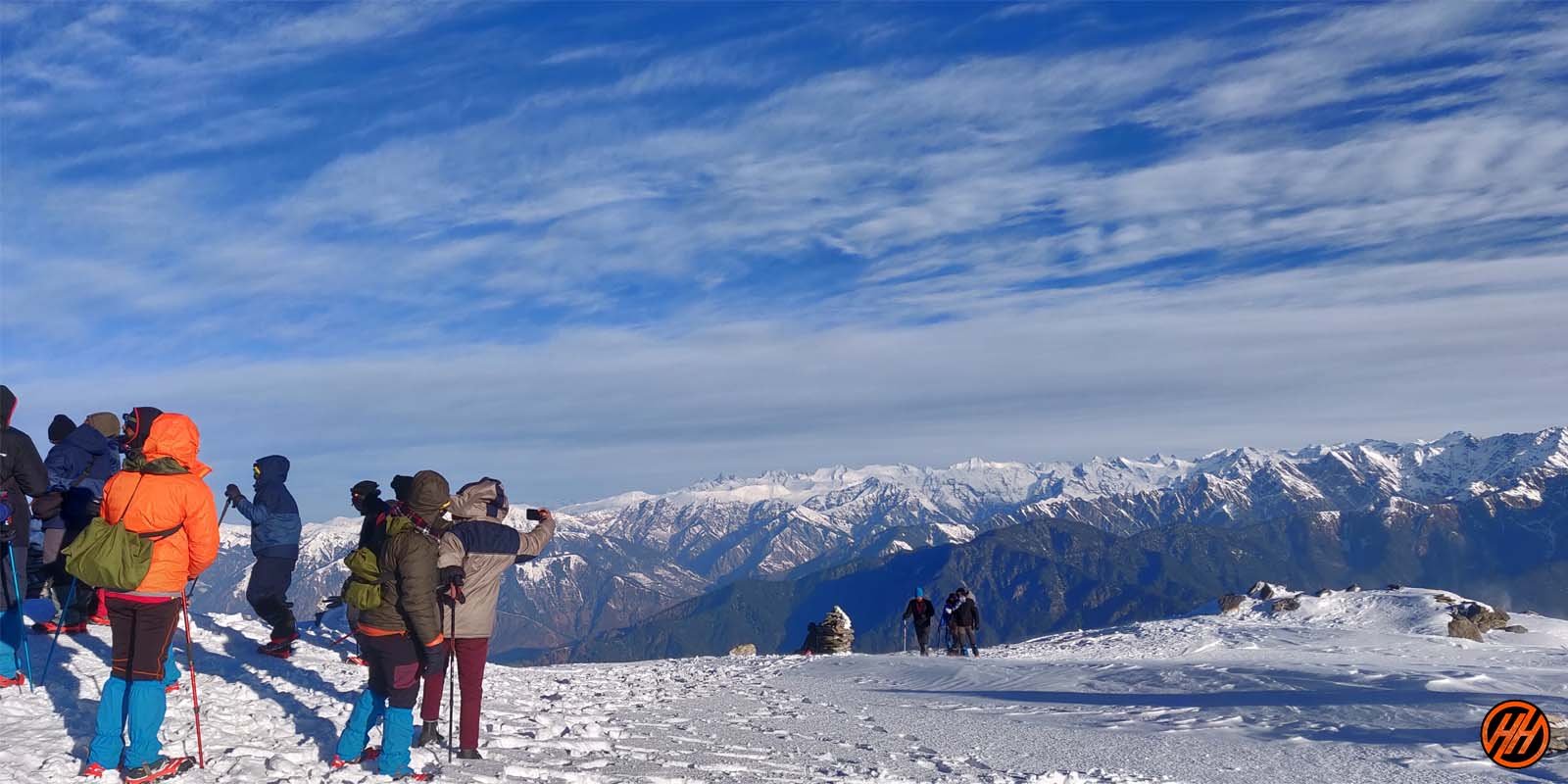
Short Itinerary of Kedarkantha Trek
DAY 01- Pickup Dehradun Railway Station Morning 07:00 Am | Drive to Sankri Base Camp Hotel , Via Mussoorie, Kamptifall, Damta, Purola, Mori Sankri,
Drive Distance: 190 km | Duration: 08-09 hours | Overnight Stay Hotel at Sankri – Twin Sharing or Three Sharing
DAY 2 – Trek from Sankri to Juda Ka Talab Camp 01 | Trek Distance: 05 km | Trek Time : 4/5 hours | Altitude 8,858 ft | Overnight Stay Camp – Twin Sharing or Three Sharing
DAY 3 – Trek from Juda Ka Talab to Kedarkantha Base Camp 02 | Trek Distance: 03 km | Trek Time : 2/3 hours | Altitude 10,498 ft | Overnight Stay Camp – Twin Sharing or Three Sharing
DAY 4 – Early Morning 3:30 am Trek from Kedarkantha Base Camp to Kedarkantha Peak Summit – 12500 ft |After Summit – Back to Kedarkantha Base then after Lunch Trek down Hargaon Camp 3- Trek Distance: 11 km | Trek Time : 7/8 hours | Altitude 8,498 ft | Overnight Stay Camp – Twin Sharing or Three Sharing
DAY 5 – Trek from Hargaon Camp to Sankri Hotel | Trek Distance: 05 km | Trek Time: 4/5 hours | Altitude 6,398 ft | Overnight Stay Hotel – Twin Sharing or Three Sharing
DAY 6 – Drive Back from Sankri Market to Dehradun City Drive Distance: 190 km | Drive Duration:08-09hours | Drop point for Himalayan Hikers trekkers: Dehradun Railway Station
Key Point- Kedarkantha Trek The most popular Winter Trek
Duration: 05 Nights 06 Days from Dehradun to Dehradun
Kedarkantha Trek Cost: Rs. 7,500.00 Per Person including all costs of the trek from 05 nights to 06 Days from Dehradun to Dehradun
Summer Temperature :- Day 5°C to 15°C and Night 2° C to 5° C
Winter Temperature:- Day -2°C to -5° C and Night -5°C to -10°C
Kedarkantha Summit -Altitude: – 12,500 feet
Kedarkantha Weather Conditions – Kedarkantha is one such trek that can be done throughout the year, Here the weather changes every month, But where the weather is very nice and favorable during the day, the night or morning is also cold according to the time.
Trek Level: Moderate
Trek distance: On foot 23 Km – By taxi 420 km
Group Size: – We will have a maximum Group size of 35 people in each group, if someone has to be private for their group, then you will be given a full date.
Kedarkantha is considered one of the most popular winter trek and hiking locations in Uttarakhand, India Altitude is 12500 feet, It is the best trek to fulfill your satisfaction with trekking. Kedarkantha trek is quite special because it has stunning views and it provides the best views of the entire mountains cape. Today Kedarkantha is the topmost trek of Uttarakhand Himalayas. Kedarkantha is an incredible place to stay there and enjoy the sunrise and sunset. The Trek is a classic winter trek that provides a great opportunity for trekkers to explore something new about nature, and experience the life of remote villages of Garhwal Himalayas.
The best time to see snow on Kedarkantha Trek
Every year the snowfall in Kedarkantha starts in the middle of November month. And it starts any time in the month of December too, so a good time to see you here is Snowy December,
Kedarkantha experiences maximum snowfall in January and February, in these two months there is maximum snowfall and there is a white blanket of snow on the entire trek.
You will get to see snow in Kedarkantha from December to March end, which makes this trek a special winter trek.
The most special is the frozen lake, Local name is Juda ka Talab which is in our first camp side it completely freezes in winter.
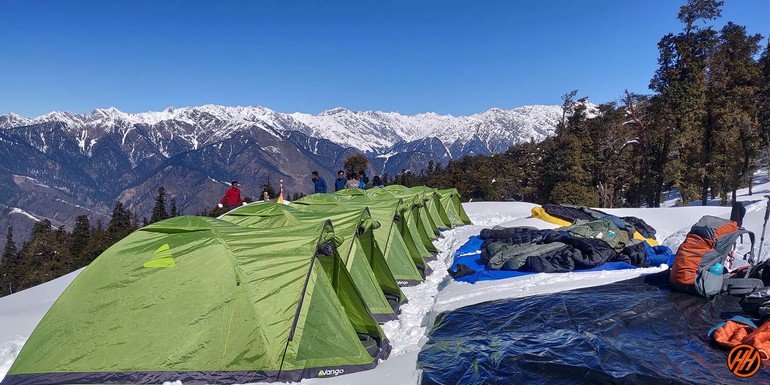
Kedarkantha Mountains Range is Highly Photogenic.
Kedarkantha Trek lies in the Uttarkashi district of Uttarakhand. It starts from the traditional village of Sour – Sankri which is in the Govind Wildlife Sanctuary National Park. Sour village is quite beautiful with snow-covered mountains and the sparkling tons river flowing through it. If you visit it once, then no doubt you will definitely visit here again. The charm is the most beautiful thing about this place. the Sankri is a delightful place set apart by the mountains and chilly climate and weather. Houses made of wood look very beautiful and adorable. In Sour Village, there are various conventions, fairs, and rituals. the people of the village wear traditional costumes and cook traditional food. Folk dances( Naati, raas, and taandi) of the area are a part of amusement and entertainment.
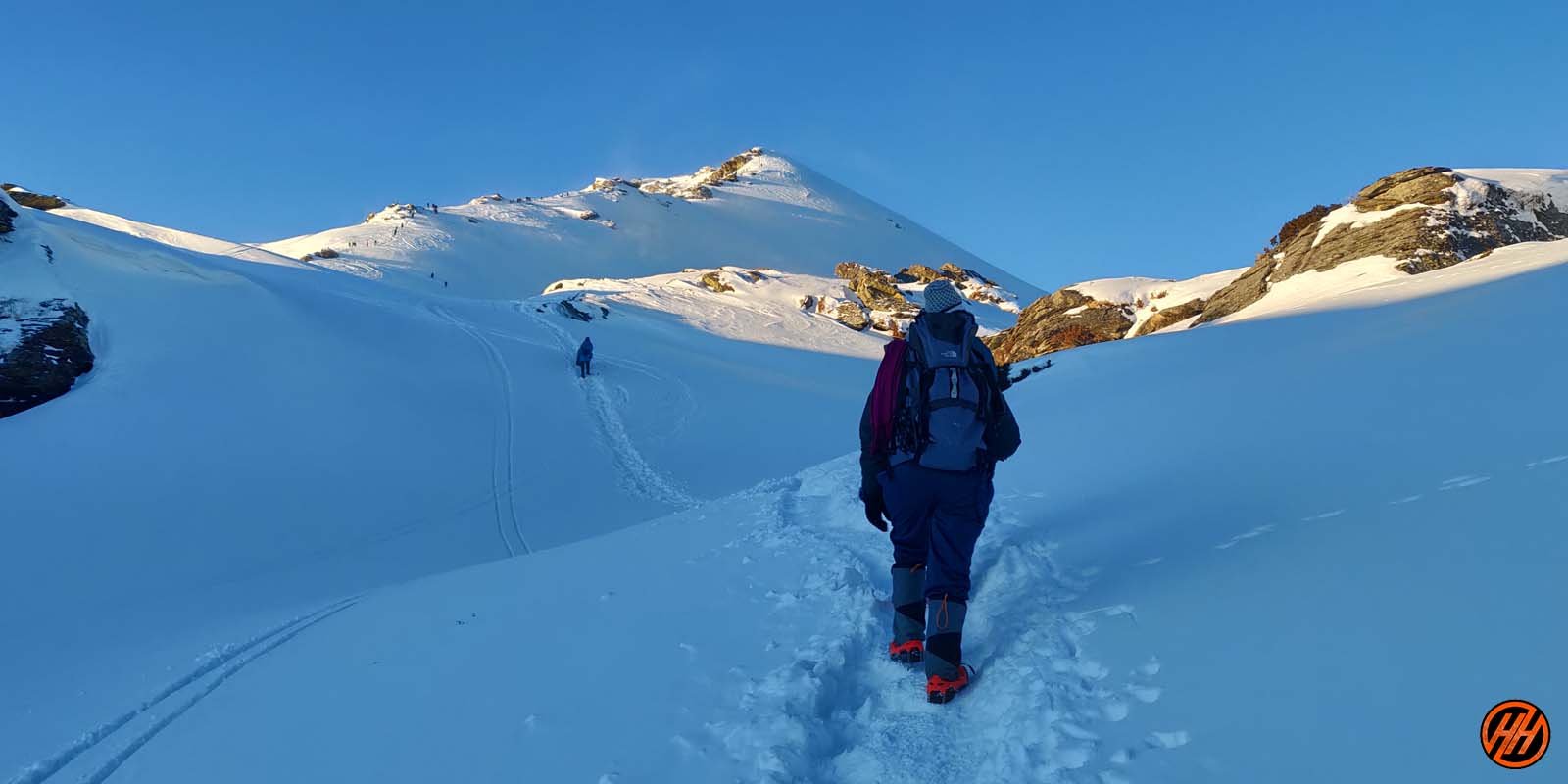
The view from the Kedarkantha Summit
The quite unique thing about the Kedarkantha trek is that from here the most beautiful mountain range of the Himalayas is seen. Which are Swargarohini Peak -I. II.III (6300 meters) , Black Peak (6387 meters), Bandarpunch Peak (6300 meters) , and all the mountains are seen from here like Rupin Pass range, Supin range, Khimloga Peak , Baraadsar Lake range, Vishkhopri range, Ranglana Peak 5800 meters, etc.
From here, the view of all the treks is easily visible from Har Ki Dun Valley and Ruinsara Valley Bali Pass, Borasu Pass, Sarutal, Fachu Kandi Pass Trek . You can view all the treks from a single trek.
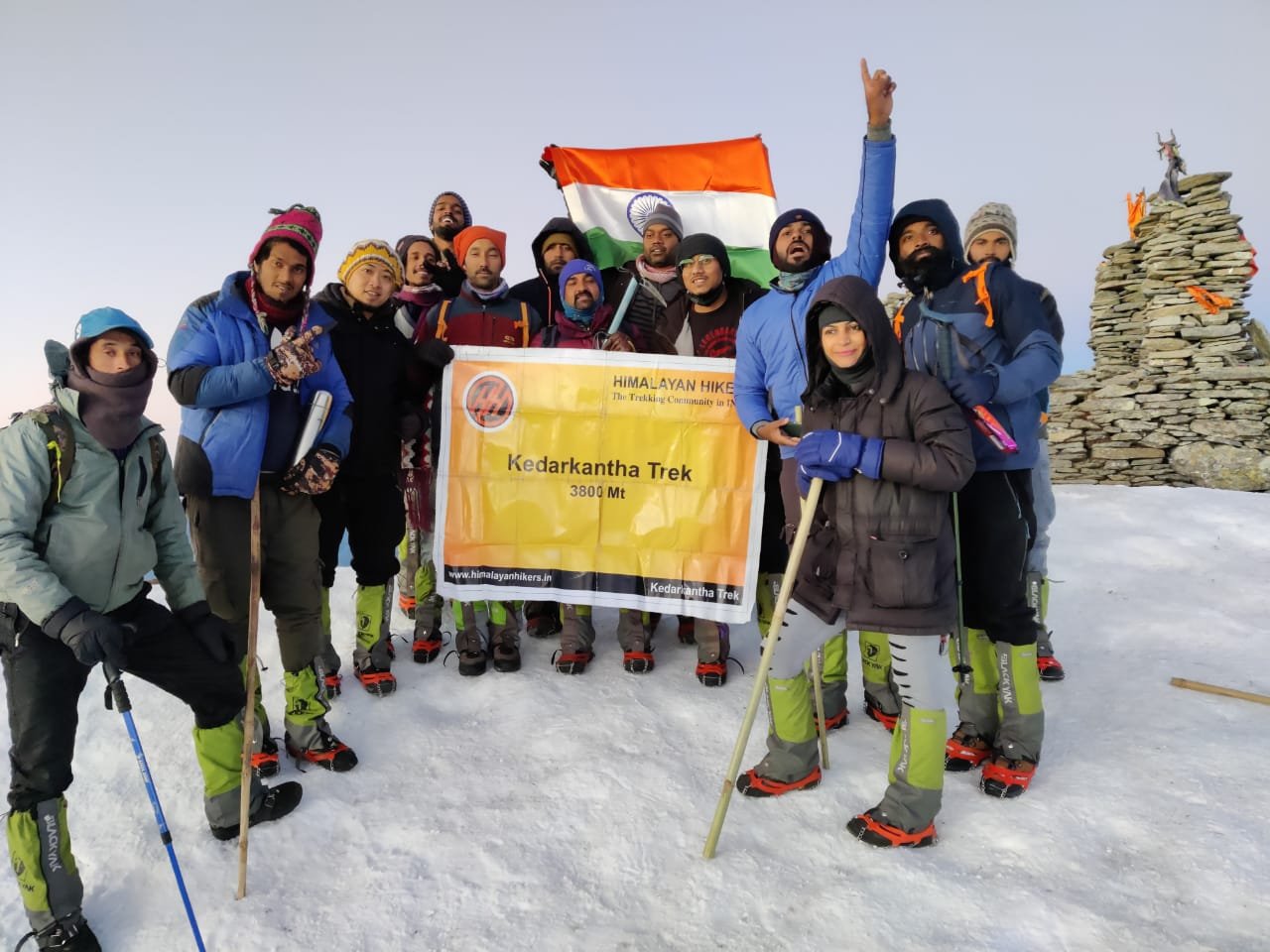
Best Time to Visit Kedarkantha Trek
Kedarkantha is one such trek that you can do throughout the year, it is more popular, especially for winter trek. I believe that these treks are for all those people who consider their second home in the mountains! If you want to spend your time in the mountains then it is an opportunity for you.
from the Kedarkantha trek you will absolutely get some experiences about life and how local people spend their life in backward areas. you will also get peace and satisfaction which everyone wants.
In the early days of my travel every time I went for a hiking or trekking trip. I have done this trek more than 100 times; no one else knows more about this trek than I know! These treks start from near my village, today it seems like when people take this trek and there is joy on everyone’s face. These treks are not very easy and not very difficult.
Age Limit for Kedarkantha Trek
Our personal belief is that people can do this trek for a minimum of 5 years to 60 years but it is necessary to be fit to do this trek. And you can do this trek in the year. These are the plans for both summer and winter.
For Winter Trek, I think it is necessary for people from 10 years to 55 years and this trek will be a relief and joy for first-time visitors. This trek will increase new energy and confidence in you.
You can do the Kedarkantha trek in 05 nights and 06 days. from Dehradun to Dehradun and if anyone has less time, then people can do this trek in 04 nights 05 days, from Dehradun to Dehradun
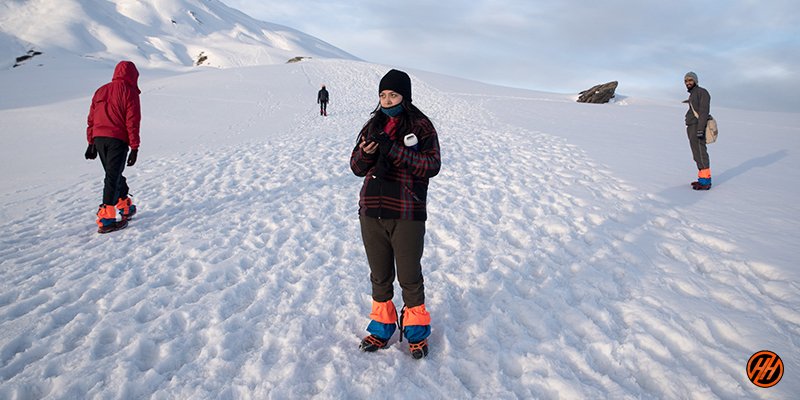
Why Kedarkantha is the Most Popular Winter Trek in Uttarakhand, India?
It is true that Kedarkantha is considered to be the most popular winter trek in Uttarakhand and the world today. Therefore, the Kedarkantha trek is the prominent and most popular winter trek in Uttarakhand. It has got unmatched beauty in winter and the trail hides in a thick blanket of snow almost winter. Kedarkantha trek will offer a large number of stunning views like green stretches of land,fresh flowing water, and thick forests. The snow-clad mountain tops along with the thick forests make the trip worthwhile.
The lush green forests usually turn white, making it a small Switzerland. As a result, The Kedarkantha trek is not only for experienced trekkers but this trek is also for amateurs and children too. Trekking through the forests you can see adorable sights of traditionally dressed villagers collecting fodder for their cattle. It’s a beautiful area to spot various trees like pine,oak, and rhododendron.
The Winter view is a bit different here. There should be snow all around, snow-capped mountains and beautiful river rivulets and birds. Once someone has reached the Sankri market base camp, they have come to another world of mind, Sankri is a small and beautiful market which is famous for shopping among tourists. There are plenty of hotels and homestays that you can spend the night in and then continue with your trek. When you see the sunrise and sunset view here, you will see yourself so close to the sky.
Kedarkantha Winter is different fun playing snowman sliding and throwing snow at each other’s equipment and making snowfall is even more enjoyable. Taking beautiful photos in the snow is a memorable moment and a winter trek can be the best trek in your life. The best thing is that when snow falls, it is a different sight; most people come to see it.
The Moon from the Sankri base camp seems so close that touching it feels possible. And, the sunrise from Sankri is gorgeous because the golden rays of the sun eagerly welcome and wake you up. The day ends, and we don’t even realize – someone said it right that we Kuldeep Ji, you are lucky that you live here. The trekkers told me if the office, airport, everything was here, they would never leave the mountains.
My only answer was – if every facility were here, then the mesmerizing beauty of the mountains would have lost somewhere. The untouched beauty is the thing that provides peace and a spark to know about the hills. We are fortunate and happy to be “Pahadis.”
About the camp of Kedarkantha
The meaning of pond is like a bunch of hair. These are seen in summer when there is no snow here. In Winter, I do not see it because the snow is covered with pure The Juda ka Talab is an incredible camp, where there are dense forests and the beautiful Bugyal in the center, so this is considered a camp. Kedarkantha Base Camp is a beautiful Bugyal. From where you can see the starting Kedarkantha Peak, Kedarkantha Base Camp is in open ground. Kedarkantha Base Camp is a big campsite in this trek, From here you start to see views of the entire Himalayas. It is very nice to spend the night here.
Is it a safe trek for me?
Yes the Kedarkantha trek is very safe. All our professionals strive our best to provide trekkers with the best experience possible.
Kedarkantha Trek is our village’s local trek, which we have been doing for years, here the trek was first done by Himalayan Hikers in 2003 to the children of Woodstock School, Mussoorie since then it has become very popular here. for the winter season,
Difficulty level ?
Kedarkantha is a very beautiful winter trek and an uphill trek in the Uttarakhand Himalayas, this is a moderate trek, The Kedarkantha Trek is great for those people who have a great passion for mountaineering and consider it a special purpose in their life.
Despite the fact that the top is relatively low in elevation, we recommend physical endurance and a strong fitness record. All groups will be Guided by our pros for trekking equipment and impending terrain during the course. We strongly urge beginner trekkers to attempt the Kedarkantha summit due to its modest difficulty.
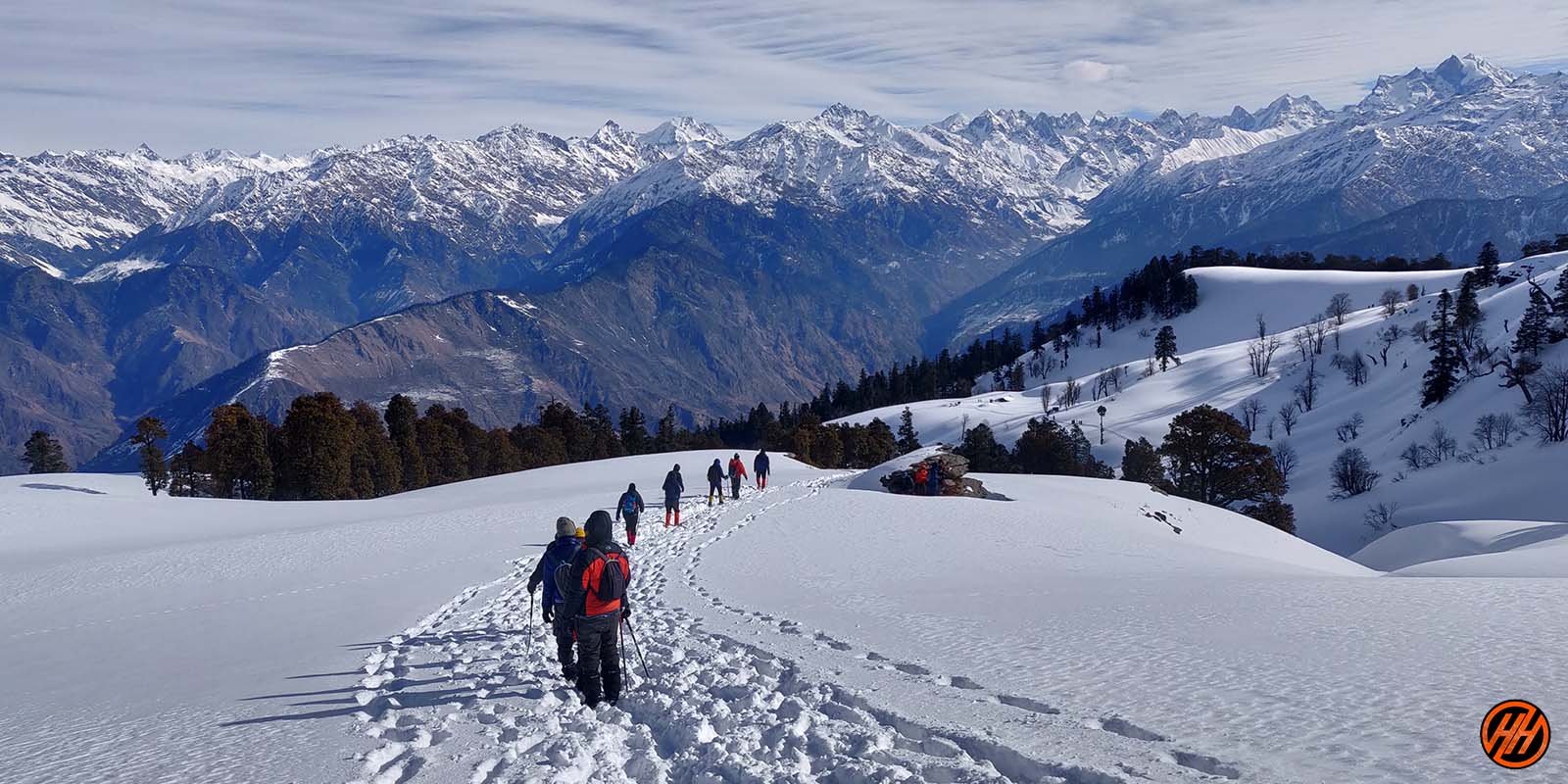
When does snowfall start in the Kedarkantha trek?
In the Kedarkantha trek, snowfall time occurs only in December, but sometimes it happens in early November as well, it is seasonal.
By the way, if it rains sometimes even in October, then the Kedarkantha peak becomes snowfall, but I do not know much longer.
The snow that falls from 15th December lasts for a long time.
Kedarkantha has the highest snowfall in the months of January and February, which lasts till the last of May and does not melt easily.
What should you keep in mind some things for doing the Kedarkantha Trek?
Kedarkantha trek is as good as it is said, you also need to be prepared., Kedarkantha trek is a moderate trek that starts from Sankri and ends at, So what are the special things to keep in mind before coming on this trek?
Winter Season
1. In Kedarkantha Trek Winter Trek, you will need warm clothes a lot, for which you will need proper good uniform clothes
2. Winters are always cold, so only warm clothes can keep you safe on the Kedarkantha trek
3. Always take the information from the company with which you are booking the trek before going on the trek, what do you need to bring
4. In the winter season, the temperature always drops day by day, so warm clothes will help you a lot.
Summer Season
1. The summer trek to Kedarkantha is very special, the view and the temperature are all favorable to you
2. For the summer trek, you have to bring only normal clothes so that your trek can be good, there is no need for hot clothes, but in hiking it is also necessary to bring all the equipment which is necessary for you.
3. It is necessary to have 3 pairs of clothes for trekking, especially the poncho, which you will have to bring every season
4. In the summer season, the temperature is always normal, so there is no need for hot clothes.
Monsoon Season
1. During the monsoon season, it rains occasionally during the Kedarkantha trek, especially in the Uttarakhand Himalayas, so if you have dry clothes here, it is very good, even when wet, it dries quickly.
2. At this time you have to bring at least 4 pairs of clothes, for the monsoon trek you do not have to bring too warm clothes, at this time you, hiking pants and t-Sart, I can trek
3. It’s only a little cold in the morning and evening and the day is a good temperature for you
4. Before going on any trek, it will be easy for you to take information related to each season.
5. Trekkers need to know about these, you can ask us anytime like the trek route, trek map, temperature, weather conditions, difficulty level, trek starting point, endpoint, transport, view of the trek, the best time to visit, How to reach Kedar Kantha, trek distance, Location, etc, keep this information before going.
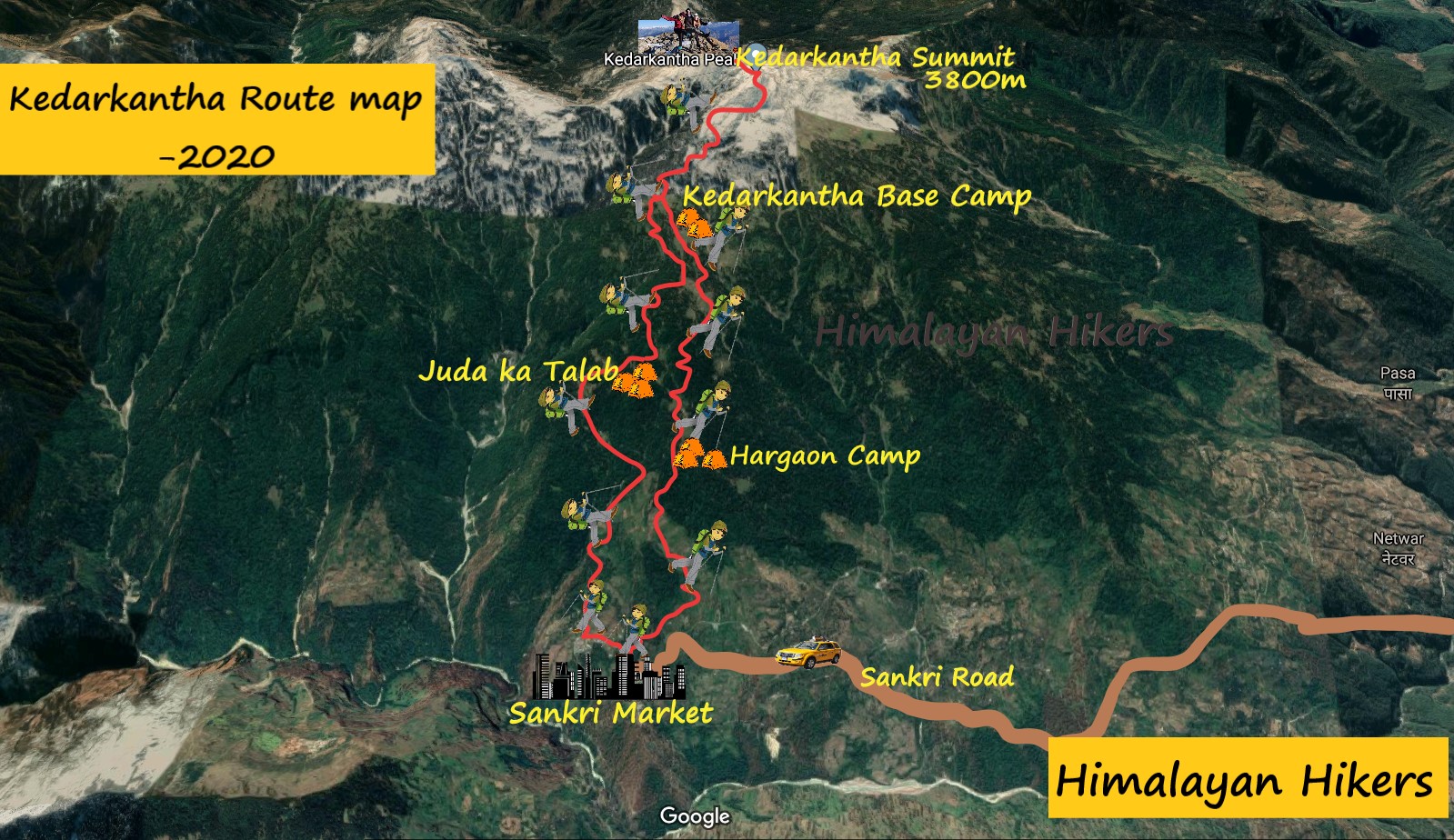
Note: – Our service will remain from Dehradun to Dehradun – for more details please check includes or excludes
How to Reach Sankri Base Camp?
The journey from Dehradun to the Sankri is beautiful and it is you in Dehradun. The way to Sankri is 190 km and it takes 7-8 hours to reach there, the drive is picturesque because you go through some of the beautiful places.
Also, read about – Sankri – A Small Paradise in the Himalayas, Uttarakashi, Uttarakhand
From Rajpur Road you will go and they will come to Mussoorie which is a hill station and it is known as the “Queen of Hills” it is situated at the foothills of the Greater Garhwal ranges and the aura of this place is aesthetic and the environment is soothing so it justifies its title
.After Mussoorie, you will come to Kampitfall. Here you will stop for breakfast. For 45 minutes after breakfast in Kampitfall, you will come along the Yamuna River – Purola, where you will stay for lunch for 1 hour. After that, you will be taken straight to the place where our team will be ready to welcome you.
The drive to Sankri (From where the Kedarkantha trek starts) is one of the most picturesque drives in the Himalayas through Dehradun, Mussoorie, Nain bag, Damta, Nawgano, Purola, Mori, Netwar, Sankri along the Rupin Supin or Tons River Kedarkantha trek is one the easiest treks in the Himalayas to enjoy thick snow cover. With this, you will start seeing the beautiful mountain range.
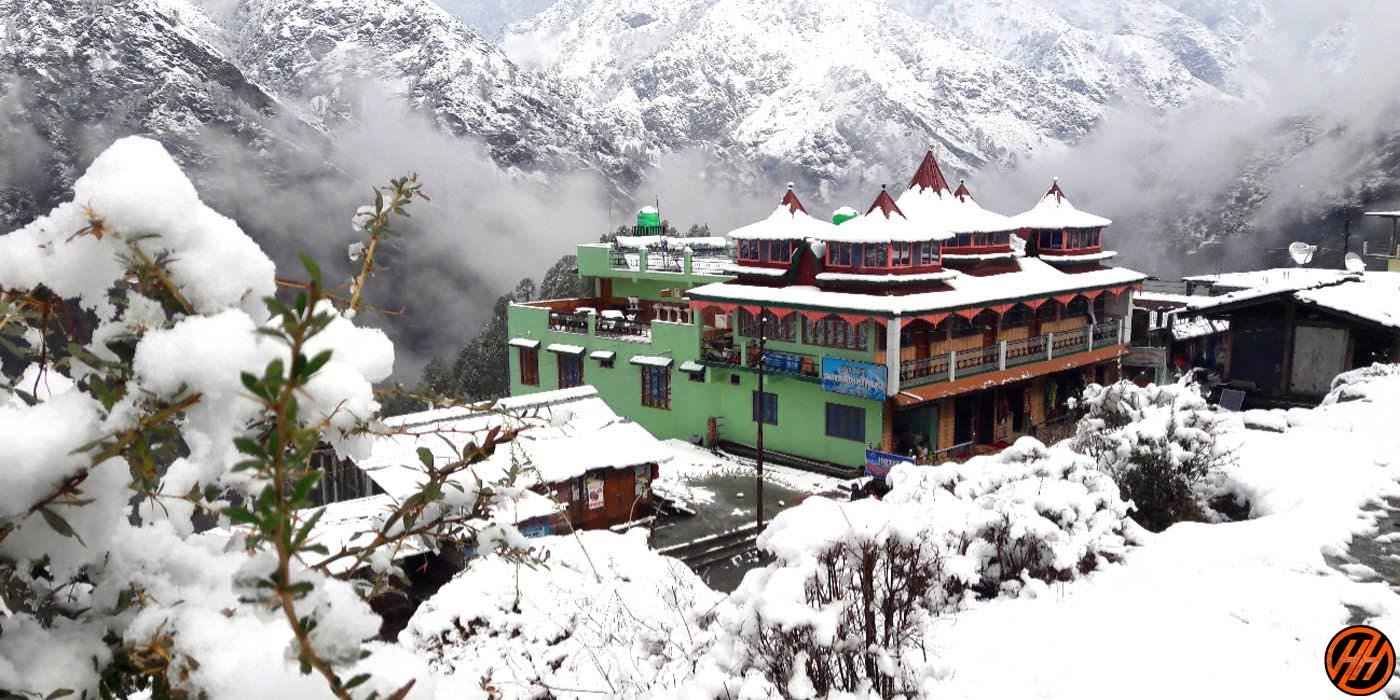
Will there be electricity in the Kedarkantha trek?
Let me tell you that there is no electricity in the forest area of the Kedarkantha trek. Here we use Stobe Light and or Solar Light, candlelight at the nights
If you come on this trek, then you should bring your own headlight and your camera with full charge, if possible, it would be good to bring extra battery backup, and also bring the phone after full charge, today people most of phones use the same
You will get the last electricity only in our hotel Sankri base, where you have to charge the battery of your phone and camera at night.
Phone connectivity and transactions
1) Only the Jio network works in the Sankri base camp, so we will tell our trekkers that if you have any very important thing to do, then Mori, or Purola to good network on your phone It would be better if you call from here to come. Connectivity along the route is unpredictable, so we advise people to complete all their work well in advance.
I will be able to get only Wi-Fi in Sankri, for this you have to pay 50 to 100 rupees.
2) In case of emergency, Himalaya Hikers trekkers will be provided with walkie-talkies in advance so that they can send their messages to the base camp
ATM- The last available ATM transaction will be in Dehradun or Purola. We advise travelers to deposit cash before or while in Dehradun as ATMs available at other locations may not dispense cash at times.
We pick up to you from Dehradun so take out cash from there itself.
How to reach the Kedarkantha trek
The easiest way to reach Dehradun is by flight, Direct flights are always available for Dehradun from Bangalore, Chennai, Delhi, Mumbai, Lucknow, Pune, Kolkata, Gujrat, and more
You can also easily reach Dehradun by train Via Delhi. Trains are available from all states of India.
1. Nanda Devi Express -12205 ( New Delhi to Dehradun ) · Classes: 1A,2A,3A ·
2. Trains from Dehradun DDN to Howrah Jn HWH DDN SPL 02327)
3. Doon Express -13010
4. Mussoorie Express -14041 ( Delhi S Rohilla to Dehradun )
5. Dehradun Shatabdi Express, 12017
Himalayan Hikers will arrange transport for you to go from Dehradun to Sankri Base Camp
Mode of Transport is Tempo Travelers and Bolero taxi, Swift taxi, more
Sankri is our main base Camp office of Kedarkantha trek and Har Ki Dun, Rupin Pass, Bali pass, Borasu pass, Baraadsar lake , more treks
You can reach Dehradun from Delhi by bus, and board it from (Delhi) ISBT, Kashmiri Gate it is good if you are booking the seats.
(Reach ISBT between 5:30 am to 7:00 am and the vehicle will be arranged from there.)
What is the distance to reach Kedarkantha from other state
- Delhi to dehradun distance by flight -207 Kms) and Dehradun airport to Sankri 217 kms by taxi and (Sankri to Kedarkantha 23 km on foot )
- Delhi to dehradun distance by train 302 kms ) and Dehradun to Sankri 190 kms by taxi and (Sankri to Kedarkantha 23 km on foot )
- Delhi to dehradun distance by bus 249 kms) and Dehradun to Sankri by taxi 190 kms, and (Sankri to Kedarkantha 23 km on foot )
- Bangalore to dehradun distance by air 1924 kms) (By Train – 2371 kms) and Dehradun airport to Sankri 217 km by taxi, and (Sankri to Kedarkantha 23 km on foot )
- Mumbai to dehradun distance by air 1344 kms) (By Train – 1724 kms ) and Dehradun to Sankri 190 km by Taxi and (Sankri to Kedarkantha 23 km on foot )
- kolkata to dehradun distance by air 1518 kms ( By Train – 1694 km) and Dehradun to Sankri 190 km by taxi and (Sankri to Kedarkantha 23 km on foot )
- The distance from Dehradun to Sankri is 190 kms.
- Musoorie to Sankri distance is 160 km.
What do we do for safety in Kedarkantha trek?
First of all, the safety of trekkers is much more for us, if you see in the trek, then there are all the risks, which I do not think about.
Himalayan Hikers worry more about you that no one should ever have any problem in the trek.
What should we and you keep more safety in the trek
- Whenever you are going for any trek, it is very important that you go completely fit and ready.
- The trek is not difficult, if you make your feet and your mind calm and strong, you will find the trek very easy.
- While trekking, keep in mind that you are walking on the right route or not always with your guide.
- Most people look somewhere and where they are walking, this can cause twitching in your legs, which can ruin your entire trek.
- It is important to ask your doctor if you have any medical problems
- I should always keep my medical kit with me, it is very important.
- Himalayan Hikers always keep a medical kit with you, such as oxygen cylinders, medicine to be given in emergency on the trek
- If any trekkers have any more problems, then they are brought back to the base camp by laying them in the stretcher.
- Our camp in Kedarkantha trek is around the tree line where you can not have any problem of oxygen
- In case of any medical problem, the help of your guide or well-informed trekkers should be taken
Why should you go for the Kedarkantha trek with Himalayan Hikers?
- Himalayan Hikers is one of the oldest trekking organizations, which is organizing trekking and adventure expedition in Uttarakhand Himalayas from almost past 30 years.
- Himalayan Hikers have started their journey from Sankri Base Camp. Sankri is base camp of more than 25 treks, Which we are organizing like – Kedarkantha, Har Ki Dun, Phulara Ridge trek, Bali pass, Borasu Pass, Rupin Pass. Dhumdharkandi pass. fachu kandi pass. Baraadsar lake, Rupin Supin trek, Nalgan pass, Kanasar lake and many more.
- We are the local people of Sankri village who can provide you the best experience here
- Good and experienced people from more than 20 villages are working with us, who will continue to serve you in your trek and will always be there with you throughout the trek.
- Himalayan Hikers provide the safety of their trekkers and good experience throughout the trek as well as share every story related to the mountains with you.
- Himalayan hikers will feed you with good, healthy and delicious food every day during the trek
- Where you can get the experience of Himalaya Hikers
- Himalayan Hikers own 1 hotel and 1 home stay in Sankri – Sour Village where you can spend some quality time with your family, friends and your loved once.
PARTICIPANTS MUST BRING FOR KEDARKANTHA TREK: SEASON 2023
- Backpack of 50 -60 ltrs
- Sturdy hiking boots: preferably all leather upper as it provides better ankle support. If you do not own a pair yet, it is advisable that you buy one as soon as possible & wear it often so that they are well broken. This will help prevent blisters.
- Lightweight tennis shoes/sandals: for wearing in camp
- Wool socks: 2 pairs: preferably thick wool socks.
- Nylon socks: 2- Pairs, of the type you wear daily to be worm under the wool socks to prevent blisters.
- Hiking shirt: 1 Preferably long sleeve
- Long John top: 2 also known as thermal underwear, preferably wool to be worm as the first layer.
- Warm shirts & pants for camp : 2 each
- Rain cot/ Poncho 1 each • Warm Jacket: 1
- Wool gloves: 1 pairs as thick as available in the market.
- Long John bottoms: Preferably wool to be worm as first layer.
- Under wear: 2-3 changes Hiking shorts/ pants: 1
- Sun hat: Cotton or nylon. Sun Glasses: Preferably with an anchor
- Sun Protection Lotion: optional Lip balm/chap stick: optional
- Water bottle: 2 Bottles of 1 Liter capacity (Pepsi bottles work well) please insure that they do not leak.
- Head lamp / flashlight: Preferably a headlamp as it leaves your hands free to work please bring extra batteries.
- Toilet articles: Tooth brush, tooth paste, etc+ And personal medical kit small one
Kedarkantha Trek FAQs
Q- what is special about the kedarkantha winter trek.
Answer- The Kedarkantha Winter Trek is renowned for its stunning snow-covered landscapes and breathtaking views of the Himalayas. Here are some key highlights and special features of the Kedarkantha Winter Trek:
Snow-covered trails: The trek takes you through dense forests and pristine meadows blanketed with snow, creating a picturesque winter wonderland.
Panoramic views: One of the main attractions of the Kedarkantha trek is the breathtaking panoramic views of the Himalayan peaks, including Swargarohini, Bandarpoonch, Black Peak, and Ranglana.
Camping experience: The trek involves camping at various scenic locations, allowing trekkers to experience the serenity of the mountains and the beauty of camping under the stars amidst snow-capped peaks.
Cultural immersion: The trek passes through several remote villages, providing trekkers with an opportunity to interact with the local Garhwali people and experience their culture and way of life.
Wildlife sightings: The trek offers the chance to spot various Himalayan wildlife species such as musk deer, monal pheasants, and Himalayan langurs in their natural habitat.
Q- Children up to what age can do this trek? And the older ones who are around 60 years of age?
Answer – The suitability of the Kedarkantha Winter Trek for children and older adults can depend on various factors such as their physical fitness, prior trekking experience, and ability to withstand cold weather conditions. Here are some general considerations:
Children : While there is no strict age limit for children to do the Kedarkantha trek, it is generally recommended for children above the age of 8 or 10 years old, depending on their physical fitness and endurance levels. Younger children may find the trek challenging due to its duration, altitude, and cold weather conditions. Parents should assess their child’s physical abilities and consult with trek organizers for specific age recommendations.
Older adults (around 60 years of age) : Older adults in good health and with a reasonable level of fitness can certainly undertake the Kedarkantha trek. However, they need to consult with a healthcare professional before embarking on the trek, especially if they have any pre-existing medical conditions. Trek organizers may also recommend a slower pace and adequate rest breaks to accommodate the needs of older trekkers. Older adults must acclimatize properly to the altitude and listen to their bodies throughout the trek to avoid overexertion or altitude-related issues
Q- The special points in Kedarkantha winter we should prepare for?
Extreme Cold : Temperatures during winter months can drop well below freezing, especially at higher altitudes. It’s essential to pack appropriate cold-weather gear such as insulated clothing, thermal layers, gloves, hats, and a good quality sleeping bag rated for sub-zero temperatures.
Snow and Ice : The trail to Kedarkantha can be covered in snow and ice during winter, making it slippery and potentially hazardous. Ensure you have sturdy, waterproof trekking boots with good traction. Carry microspikes or crampons for extra grip on icy sections.
Altitude : While Kedarkantha is not an extremely high-altitude trek compared to some other Himalayan treks, it still reaches altitudes above 3,800 meters (12,500 feet). Acclimatize properly by ascending gradually and staying hydrated. Be aware of symptoms of altitude sickness and descend if necessary.
Packing the right amount and type of clothing is crucial for staying comfortable and safe during a winter trek to Kedarkantha. Here’s a general guideline for the types and quantities of clothing to consider:
- Long-sleeved thermal tops: 1-2
- Thermal leggings: 1-2 pairs
- Thermal socks: 3-4 pairs
- Fleece jacket or sweater: 1-2
- Insulated down jacket or synthetic equivalent: 1
- Insulated pants or trousers: 1 pair
- Waterproof, windproof jacket: 1
- Waterproof, windproof pants: 1 pair
- Gaiters (to keep snow out of boots): 1 pair
- Wool or fleece hat: 1
- Balaclava or neck gaiter: 1
- Sunglasses with UV protection: 1
- Ski goggles (for windy or snowy conditions): 1
- Insulated gloves or mittens: 1 pair
- Waterproof outer gloves or mittens: 1 pair
- Insulated, waterproof trekking boots: 1 pair
- Extra pairs of woolen socks: 2-3 pairs
- Trekking poles (for stability on snow and ice): 1 pair
- Backpack rain cover (to keep your gear dry): 1
- Spare set of dry clothes for sleeping
Q- How risky is the Kedarkantha trek for beginners?
Moderate Level : Kedarkantha is generally considered a moderate trek suitable for beginners with a reasonable level of fitness. The trail involves ascending and descending through varied terrain, including forested paths, snow-covered slopes, and rocky sections. While it’s manageable for most beginners, some may find certain sections challenging, especially in winter when snow and ice are present
Q- How Do I prepare for the Kedarkantha winter trek physically?
Preparing for the Kedarkantha trek physically requires a combination of cardiovascular endurance, strength training, flexibility, and altitude acclimatization. Here’s a more detailed plan to help you get ready:
- Start with regular aerobic exercises like brisk walking, jogging, cycling, or swimming.
- Gradually increase the duration and intensity of your workouts to simulate the demands of trekking.
- Aim for at least 30-60 minutes of cardio activity, 3-4 times per week.
- Pull-ups or lat pulldowns
Focus on compound exercises that target multiple muscle groups simultaneously. Aim for 2-3 strength training sessions per week, allowing at least 48 hours of rest between sessions to allow for muscle recovery.
- Hip flexors
Incorporate dynamic stretches and mobility exercises to improve range of motion and joint stability.
- If possible, spend some time at moderate altitudes before the trek to allow your body to acclimatize gradually.
- Stay hydrated by drinking plenty of water throughout the day.
- Ascend gradually during the trek, allowing time for your body to adjust to the altitude.
- Be aware of symptoms of altitude sickness and descend if you experience severe headaches, nausea, dizziness, or difficulty breathing.
- Practice Trekking : If you have access to hiking trails in your area, go on regular hikes to simulate trekking conditions. Start with shorter hikes and gradually increase the distance and elevation gain as you build your fitness level.
- Pack Training : Train with a weighted backpack to simulate the load you’ll be carrying during the trek. Start with a lighter pack and gradually increase the weight as you get stronger.
- Rest and Recovery : Make sure to incorporate rest days into your training schedule to allow your muscles to recover and rebuild. Listen to your body and adjust your training intensity as needed to avoid overtraining and injury.
Our Extra Luggage Where do we keep, in Sankri?
Hotels, guesthouses, or homestays : Extra luggage keep our sankri Hotel Sankri offers luggage storage facilities for their guests. You can inquire about the place where you are staying,
What are offloading luggage charges on Kedarkantha Trek?
The cost of luggage offloading charges on the Kedarkantha Trek ranged from Per bag per day Rs. 300 Indian Rupees per day per bag. 8 kg to 10 kg allowed
What type medicines carry for kedakantha trek ?
it’s essential to carry a basic medical kit to address common ailments and emergencies. Here’s a suggested list of medicines and supplies you might consider bringing:
- Acetaminophen or Ibuprofen for general pain relief.
- Aspirin for mild pain relief and as a blood thinner (useful in case of suspected heart attack).
- For indigestion and heartburn.
- For allergic reactions and insect bites/stings.
- Also, useful for managing symptoms of cold or allergies.
- Such as loperamide, in case of diarrhea.
- Oral rehydration salts to replenish electrolytes in case of dehydration.
- Broad-spectrum antibiotic for treating bacterial infections (e.g., respiratory infections or wound infections).
- Prescription from a doctor might be necessary.
- For treating minor wounds or cuts.
- For cleaning wounds.
- For dressing wounds and injuries.
- For preventing and treating blisters.
- SPF 30 or higher to protect against sunburn at high altitudes.
- To prevent chapped lips.
- For removing splinters and cutting bandages or tape.
- To ensure safe drinking water during the trek.
- Any prescription medications you regularly take.
- List of emergency contacts and any relevant medical information.
How many days before booking the Kedarkantha Trek Package?
The number of days before booking a Kedarkantha trek package can vary depending on several factors such as the availability of slots, the policies of the trekking company or tour operator, and personal preferences. However, it’s generally advisable to book your trek package well in advance, especially during peak trekking seasons or popular times of the year.
Here are some considerations regarding booking timing:
- Peak Seasons: If you plan to trek during peak seasons like ( December to March) or autumn (September to November), it’s recommended to book several months in advance, sometimes even 2 months to a year ahead, to secure your spot.
- Off-Peak Seasons: If you’re flexible with your travel dates and prefer trekking during off-peak seasons like winter (December to February) or monsoon (June to August), you might have more flexibility in booking closer to your preferred dates. However, it’s still advisable to book at least a few weeks in advance to ensure availability and to allow for necessary preparations.
- Group Size: Larger groups may need to book further in advance to secure accommodations and permits, especially if you’re traveling during peak seasons.
- Last-Minute Booking: Last-minute bookings might be possible, especially if you’re traveling solo or in a small group, and if there’s availability. However, there’s a risk of limited options and higher prices.
- Tour Operator Policies: Check the policies of the trekking company or tour operator you’re considering booking with. Some may require booking well in advance, while others may offer last-minute deals or flexible booking options.
Himalayan Hikers – Provided food During the Kedarkantha Trek
We serve five -05 times meals a day including- Breakfast, Lunch, Eevening Snakes, Soup, Dinner, A variety of delectable and healthy food is provided which includes; Indian, Chinese and other Western meals. They are nutritious and keep you fit and healthy on the trek.(Veg or non-veg food) With our local food and Day Pack, for Summit Day like fresh fruits
Food Menu – Roti + Rice + Salad + Papad +Matter paneer +Daal +mix veg+ daily more vegetable +sweet+ Bread +Omelets +Nutella + jam + butter +Muesli, Milk+Banana+ Allo parantha +Tea & coffee Cornflakes, Milk +Egg bhurji +Bread, Peanut Butter +Pancake +Plain parantha +Fruits+ Porridge Oats+ +Bread & cheese +Poha +Boiled egg + Gulab Jamun+ Custard+ Jalebi+ Chilla +Honey+ Puri + Chole more
Note: – This is only list Himalayan Hikers Team or Cook provide you more healthy food and more items of per day menu
The type of food provided during a trek can vary depending on factors like the location, duration, and the trekking company or organization you’re with. However, there are some common types of food that are often included in trekking provisions:
- Carbohydrates : Foods high in carbohydrates provide energy for the trek. This includes items like rice, pasta, bread, and potatoes. More
- Proteins : Protein-rich foods help with muscle repair and recovery. Common protein sources include lentils, beans, tofu, meat (if available), eggs, and dairy products.
- Fruits and vegetables : These provide essential vitamins, minerals, and fiber. While fresh produce may not always be available, dried fruits and vegetables or canned options might be included.
- Snacks : Trekking often involves long hours of physical exertion, so snacks are important for quick energy boosts. Snacks like nuts, energy bars, trail mix, and chocolate are common choices.
- Local cuisine: Depending on the region you’re trekking in, you might also get the chance to sample local dishes. This can be a delightful way to experience the culture and flavors of the area.
Day 1: Pickup from Dehradun Railway Station and Drive to Sankri (base camp) by Tempo Travellers 13+D
Total distance 190 km – 8/9 Hours journey
Mode of journey – By taxi
Altitude – Sankri base camp – 1920 Meters
Night stay – Our Swargarohini Hotel – on a share basis
Himalayan Hikers organizes transport for trekkers from Dehradun Railway Station in the morning which will leave for Sankri around 6:00 am to 7:00 am.
Dehradun is the capital of Uttarakhand and one of the most beautiful places in India. The main attraction of this place is Rajpur road go through it and get a glimpse of Dehradun’s beauty. Reach Mussoorie after an hour which is also known as “Queen of Hills”. People visit it heavily during vacations with their family and friends.
- Dehradun to Mussoorie: The drive often begins in Dehradun and takes you through the picturesque hill station of Mussoorie. The scenic beauty of the Mussoorie hills with its lush greenery and pleasant weather is a great start to your journey.
- Mussoorie to Kempty Falls: As you continue your drive, you can make a detour to Kempty Falls, a popular tourist spot. The falls offer a refreshing stopover with beautiful cascades surrounded by green hills.
- Purola: After Kempty Falls, you’ll continue your journey through Purola. This is where the terrain starts to become more hilly and remote, offering a glimpse of rural Himalayan life.
- Beautiful Villages: The drive takes you through several small villages and hamlets, each with its own charm. You’ll pass by terraced fields, pine forests, and quaint houses that dot the landscape.
- Stunning Valleys: As you get closer to Sankri, you’ll enter valleys with breathtaking views. The Tons River Valley is particularly beautiful, and you’ll cross it on your way to Sankri. The river, surrounded by lush green hills, is a sight to behold.
- The Last Stretch to Sankri: The final part of the drive is through dense forests and narrow mountain roads. The road might be challenging, but the natural beauty is truly remarkable. As you get closer to Sankri, you’ll notice the mountain vistas opening up, and you’ll be surrounded by towering peaks.
- Sankri: When you arrive in Sankri, you’ll find it to be a charming village with a Himalayan backdrop. The views of the surrounding mountains, especially during sunrise and sunset, can be awe-inspiring.
Go to Hotel Swargarohini, freshen up, and enjoy evening snacks in the open terrace with great views. You will be provided some details after which you can go for an evening walk but be at the hotel for dinner.
Enjoy a delicious dinner and spend a comfortable night in the mountains.
Day 2 : Trek from Sankri to Juda Ka Talab
Trek Distance 5 Km – 4/5 Hours Trek
Mode of journey – on foot
Altitude – Juda ka talab – 2700 Meters
Night Stay – Camp in tents – on a shared basis
Today, the heartwarming morning is eagerly waiting for you to wake up. Feel the peace amid the mountains; no connectivity and no materialistic thing is here to disturb you, the only thing is peace.
Relish the hot cup of coffee/tea at 6:00 a.m. and get ready for your breakfast at 7:30 a.m. You have to strictly leave at 8:30 am after the instructions of your guide
The trek from Sankri to Juda Ka Talab on the way to Kedarkantha is a beautiful journey that takes you through the lush forests of the Govind National Park in Uttarakhand, India. Here’s a rough route and some of the scenic highlights along the way:
- Sankri (Base Camp): Your trek to Kedarkantha starts from Sankri. Sankri is a picturesque village surrounded by snow-capped peaks and lush green meadows.
- Forest Trail: As you leave Sankri, you’ll enter a dense forest with pine, oak, and rhododendron trees. The forest trail is particularly beautiful during spring when the rhododendron trees are in bloom.
- Scenic Views: As you ascend, you’ll have occasional openings in the forest that offer glimpses of the snow-capped peaks in the distance. The Swargarohini range and Bandarpoonch are some of the prominent peaks you might spot.
- Water Crossings: You’ll encounter a few small streams and water crossings along the way. These add to the charm of the trek and provide opportunities for refreshing breaks.
- Kedarkantha Base Camp: After a few hours of trekking, you’ll reach the Kedarkantha Base Camp. This campsite is located in a meadow and offers panoramic views of the surrounding mountains.
- Juda Ka Talab: From the Kedarkantha Base Camp, you’ll continue your trek to Juda Ka Talab. The trail meanders through more forests and meadows. Juda Ka Talab is a small, picturesque lake surrounded by a meadow and is an excellent camping spot. The reflections of the surrounding mountains in the clear water make it a beautiful setting.
- Mountain Views: While at Juda Ka Talab, you’ll have stunning views of Kedarkantha Peak, which appears quite close from here. The clear mountain air and the serene atmosphere make this campsite a wonderful place to spend the night.
The trek from Sankri to Juda Ka Talab is known for its natural beauty and relatively moderate difficulty, making it a popular choice for trekkers. It’s advisable to undertake this trek with a guide or in a group, especially if you’re not familiar with the route, as weather conditions can change rapidly in the mountains, and a guide can provide important local knowledge and safety.
Day 3 : Trek from Juda Ka talab to Kedarkantha base
Trek Distance 03 Km – 2/3 Hours Trek
Altitude – Kedarkantha basecamp – 3200 Meters
Night Stay – Camp in a tent- on a share basis
The trek from Juda Ka Talab to Kedarkantha Base Camp is a crucial part of the Kedarkantha trek in Uttarakhand, India. It offers some breathtaking views of the Himalayan landscape. Here’s an overview of the route and what you can expect to see along the way:
- Juda Ka Talab: You’ll start your trek from Juda Ka Talab, a picturesque alpine lake surrounded by meadows. The lake’s pristine waters and reflections of the surrounding peaks create a serene atmosphere. Take in the beautiful surroundings before setting out.
- Gradual Ascent: The trail from Juda Ka Talab to Kedarkantha Base Camp involves a gradual ascent through a mix of meadows and forests. The path can be snowy, especially in the winter months, so make sure to wear appropriate footwear and carry trekking poles for stability.
- Views of Kedarkantha Peak: As you trek, you’ll have periodic views of the Kedarkantha Peak in the distance. The snow-clad peak stands tall and is an ever-present reminder of your ultimate goal.
- Pine Forests: You’ll pass through dense pine forests with towering trees. The forested sections offer a refreshing change of scenery from the meadows and are particularly enchanting in the snow.
- Mountain Vistas: The trek provides stunning panoramic views of the surrounding Himalayan peaks, including Swargarohini, Bandarpoonch, and the Gangotri-Yamunotri range. These views get more captivating as you gain altitude.
- Kedarkantha Base Camp: After a few hours of trekking, you’ll reach the Kedarkantha Base Camp. The campsite is located in a high-altitude meadow with stunning 360-degree views of the Himalayas. The Kedarkantha Peak is prominently visible from here, and it makes for an ideal spot to rest and acclimatize.
- Snow (in Winter): Depending on the season and recent weather, you might encounter snow on the trail. This can make the trek more challenging but also more beautiful.
The Kedarkantha Base Camp is a popular spot for trekkers to spend the night before making the final ascent to the summit of Kedarkantha Peak. The clear mountain air and the quiet, serene environment at the base camp create a peaceful setting for trekkers to prepare for the next day’s adventure.
Day 4 : Trek from Kedarkantha base camp to Kedarkantha Summit (3800 Meters) and descent to Hargaon Thach
Trek Distance 11 Km – 6/7 Hours Trek
Altitude – Hargaon thach – 2645 Meters
Today is the main day of your trek, so be ready at 3:30 am in the morning to witness the sunrise from the Kedarkantha summit. Nothing can be better than watching the rising sun from the summit because then the views are jaw-dropping. Whoever watches it gets mesmerized.
The Kedarkantha summit is the final destination of the Kedarkantha trek, and it offers breathtaking views of the surrounding Himalayan peaks. Here’s a description of the route from Kedarkantha Base Camp to the Kedarkantha summit and its location:
- Starting from Kedarkantha Base Camp: The trek to the Kedarkantha summit typically begins from the Kedarkantha Base Camp. This campsite is situated in a high-altitude meadow and serves as the starting point for the summit attempt.
- Early Start: To reach the summit and enjoy the best views, it’s recommended to start very early in the morning, usually before dawn. The early start allows you to ascend while the snow is still firm and the weather is clear.
- Ascend through Alpine Meadows: The trail from the base camp to the summit involves a gradual ascent through alpine meadows. The landscape becomes more open, and you’ll be walking on a mix of snow and rock.
- Snow Clad Terrain (in Winter): Depending on the season, you might encounter varying degrees of snow as you climb higher. In the winter months, the trail is often covered in snow, which can make the trek more challenging but incredibly beautiful.
- Views of Surrounding Peaks: As you ascend, you’ll be treated to breathtaking views of the surrounding Himalayan peaks, including Swargarohini, Bandarpoonch, Kalanag, and others. The views become more and more stunning as you get closer to the summit.
- Kedarkantha Summit: The Kedarkantha summit is a small, snow-clad peak. Once you reach the summit, you’ll be rewarded with panoramic views of the Himalayan ranges. The Kedarkantha Peak itself is a remarkable sight, and you’ll also have a clear view of the Har Ki Dun Valley.
The Kedarkantha summit is at an elevation of approximately 12,500 feet (3,800 meters), and it’s known for its captivating 360-degree views of the surrounding mountains and valleys. It’s a popular spot for trekkers to take in the beauty of the Himalayas, especially at sunrise when the peaks are bathed in golden light.
Day 5: Trek from Hargaon thach to Sankri – Hotel Swargarohini
Trek Distance- 0 5 Km – 4/5 Hours Trek
Night Stay – Hotel – on twin share basis
Today morning enjoy breakfast at your last camp of this trek. Start trekking and while descending from Hargaon to Sankri you will come across many viewpoints and reach the apple orchards.
- Hargaon Campsite: Your last day of trekking usually starts from the Hargaon campsite. Hargaon is a picturesque campsite located in a forested area. It’s a serene and peaceful spot with the soothing sounds of the forest.
- Descend through Forest: The trail from Hargaon to Sankri is primarily a descent through the forested area. You’ll be walking through dense pine and oak forests, which can provide a different but equally enchanting view compared to the alpine meadows higher up on the trek.
- Mountain Views: While descending through the forest, you might still have occasional glimpses of the surrounding Himalayan peaks. These views can be especially beautiful with the play of light and shadow through the trees.
- Passing Through Villages: As you get closer to Sankri, you’ll pass through small villages and settlements. These provide a glimpse of local life in the region, and you may encounter friendly villagers along the way.
- Sankri: Your trek concludes when you reach Sankri. Sankri is a charming village in the Uttarkashi district of Uttarakhand and serves as the starting and ending point for the Kedarkantha trek. The village is surrounded by snow-capped peaks and lush landscapes.
- Village Scenery: The village of Sankri itself is quite picturesque, with traditional wooden houses, terraced fields, and the beautiful backdrop of the Himalayan mountains.
Day 6: Return from Sankri to Dehradun by Tempo Travellers
Distance 19 0 Km – 8/9 Hours Trek
Mode of the journey – Bay Tempo Travellers
Our service ends here
Today – It is your last breakfast on this trek with the Himalayan Hikers team. The certificates will be given and after some beautiful photos, we will bid you all goodbye from Sankri.
Mandatory Documents
Please carry the documents given below.
Original and photocopy of government photo identity card- (Aadhar Card, Driving License, Voters ID, etc, Passport and Visa important to foreigners Medical Certificate (First part should be filled by the Doctor and Second part by the Trekker) Declaration Certificates
Note: – Many trekkers commit the same mistake of carrying unnecessary items on a trek which only makes the backpack heavy. It is important to know the right items to carry. It differs from season to season if you are trekking in summers then carry less layers of warm clothing and if you are trekking in winters carry enough layers to protect yourself against chilly cold.
Necessary Items for trekkers

Backpack (50 to 60 liters) A strongly built backpack with good support is compulsory for a trek. (Rain cover is important)
Sturdy Trekking Shoes The shoes should be strong enough with good support. The people ask if sports shoes would be comfortable but it is good to bring the right trekking shoes.
The Clothes You Should Bring On a Trek Avoid keeping extra clothes because it only makes you backpack heavy.
Trek Pants – The jeans are never suitable for a trek so you need at least 2-3 trek pants for treks carry more for longer treks.
Jacket – Jackets are very important to carry on a trek it protects you against the chilly weather. So carry 2 jackets on a week long trek.
Layers of warm Clothing Carry warm woolen layers or fleece. Carry more layers during winter season (at least 2 to 3) and less during summer.
Thermals – The Temperature decreases at night so you might be need thermals for Night.
T- Shirts – Bring those t shirts which dry fast.
Poncho –They are needed if you are trekking on a Rainy day to keep you dry.
Hiking Pole
Water Bottle 2
Cap or Balaclava
Woolen and Waterproof Gloves
Socks (Woolen and Regular)
Torch head light
Personal Toiletry Items – (toothpaste, toothbrush, toilet paper, sanitizer etc.)
Carry Personal Medical Kit
Personal Medical Kit (Carry minimum 5 tablets and maximum 10)
Medicine for Altitude Sickness
Medicine for acidity and discomfort.
Fever and Headache Medicines
Pain Reliever
Motion Sickness Medicine
Medicine for Allergies
Medicine for Diarrhoea
Sprains Cream or Spray
Antiseptic Cream
Stretchable/Elastic bandage
Note:- Please take all medicines only when prescribed by the doctor. In case you face any problem during your trek, discuss and take advice from the Professional guide.
It is important to have some guidelines in place in case something unexpected happens. Here are some general guidelines that may be helpful:
- Have a first-aid kit: Make sure to carry a well-equipped first-aid kit that can be used to treat minor injuries and ailments.
- Follow safety protocols: It is important to follow all safety protocols and guidelines related to the trek. This includes staying on designated trails, avoiding risky or dangerous areas, and staying with your group.
- Have a communication plan: Make sure to have a communication plan in place in case of emergencies. This may include carrying a mobile phone or a satellite phone, or using a walkie-talkie to stay in touch with other members of your group.
- Know the local emergency services: Be aware of the local emergency services available in the area where you will be trekking. This includes knowing the location of the nearest hospital, police station, or rescue service.
- Carry proper gear and equipment: Make sure to carry appropriate gear and equipment for the trek, including proper footwear, warm clothing, and rain gear. This will help you stay comfortable and safe during the trek.
- Follow Leave No Trace principles: Follow Leave No Trace principles and leave the trekking area as you found it. This includes packing out all trash and waste, avoiding damaging vegetation, and respecting wildlife.
- Stay calm and collected: In case something unexpected happens, try to stay calm and collected. Assess the situation and take appropriate action to stay safe and help others in your group.
It’s also a good idea to consult with a local trekking agency or experienced guide before embarking on a trek, as they can provide additional guidance and support to ensure a safe and enjoyable experience.
Kedarkantha Trek FAQ
1. What is the Kedarkantha Trek? Kedarkantha is a popular winter trekking destination in the Garhwal Himalayas of Uttarakhand, India. It is known for its scenic beauty, dense pine forests, expansive meadows, and panoramic views from the summit.
2. Where is Kedarkantha located? Kedarkantha is located in the Govind Wildlife Sanctuary in Uttarkashi district, Uttarakhand.
3. How do I reach the starting point of the trek? The trek starts from a village called Sankri. Here’s how you can reach Sankri:
- By Air : The nearest airport is Jolly Grant Airport in Dehradun, about 220 km from Sankri. From there, you can hire a taxi to Sankri.
- By Train : The nearest railway station is Dehradun Railway Station, around 200 km from Sankri. You can take a bus or taxi from Dehradun to Sankri.
- By Road : Sankri is well-connected by road. You can take a bus or taxi from Dehradun, which is approximately an 8-10 hour drive.
4. What is the best time to visit Kedarkantha? The best time to trek to Kedarkantha is during the winter months of December to April, when the region is covered in snow, offering a beautiful winter trekking experience. It can also be trekked from April to June and September to November, but winter is the most popular season.
5. What is the duration of the trek? The Kedarkantha trek typically takes 5-6 days, including travel time to and from Sankri.
6. What is the difficulty level of the trek? The trek is considered easy to moderate. It involves gradual ascents and is suitable for beginners with good physical fitness.
7. What is the altitude of Kedarkantha? The summit of Kedarkantha is at an altitude of approximately 3,810 meters (12,500 feet).
8. What should I pack for the trek? Here’s a list of essential items to pack:
- Warm clothing (layers, thermal wear, down jacket)
- Trekking shoes with good grip
- Trekking poles
- Backpack (40-60 liters)
- Sleeping bag (if not provided by the trekking company)
- Personal medical kit
- Water bottles and purification tablets
- Snacks and energy bars
- Raincoat/poncho
- Sunscreen, sunglasses, hat
- Flashlight/headlamp with extra batteries
- Toiletries and personal hygiene items
9. Do I need a permit for the trek? Yes, you need permits to trek in the Govind Wildlife Sanctuary. These can usually be arranged by your trekking company or obtained from the forest department office in Sankri.
10. What kind of accommodation is available during the trek? Accommodation during the trek typically includes camping in tents at designated campsites. The facilities are basic but comfortable.
11. Are there any risks or challenges on the trek? The trek involves challenges such as:
- Cold weather and potential snowfall
- Physical strain from long trekking days
- Altitude-related issues It’s essential to acclimatize properly, stay hydrated, and follow the guidance of your trek leader.
12. Is it safe to trek alone? While it is possible to trek alone, it is highly recommended to join a group or hire a local guide for safety, navigation, and a richer experience.
13. Can I do the trek if I have no prior trekking experience? Yes, beginners can do the Kedarkantha trek, but it is advisable to be in good physical condition and perhaps undertake some shorter treks beforehand to build endurance.
14. What kind of food is provided during the trek? Most trekking packages include vegetarian meals, which are nutritious and catered to trekking needs. The food usually includes local cuisine, rice, chapati, vegetables, dal, and snacks.
15. What are some key highlights of the trek?
- Spectacular views of peaks like Swargarohini, Bandarpoonch, and Black Peak
- Dense forests of pine, oak, and rhododendron
- Snow-covered landscapes in winter
- The serene Juda ka Talab (a high-altitude lake)
- The panoramic views from the Kedarkantha summit
16. Are there any cultural or historical aspects of the trek? The trek passes through traditional villages like Sankri, which offer a glimpse into the local culture and lifestyle of the people living in the Garhwal Himalayas.
17. What kind of fitness is required for the trek? A basic level of fitness is required for the Kedarkantha trek. Regular cardiovascular exercise, such as jogging, swimming, or cycling, and leg strengthening exercises can help prepare for the trek.
18. What should I be aware of regarding altitude sickness? Altitude sickness can affect anyone above 2,500 meters. To minimize the risk:
- Acclimatize properly
- Stay hydrated
- Avoid alcohol and smoking
- Ascend slowly and give your body time to adjust
This FAQ should provide a thorough overview for anyone considering the Kedarkantha trek. If you have more specific questions, feel free to ask!
Are you Looking for Trekking Equipment on Rent?
If any trekker needs trekking equipment on Rent then Himalayan Hikers has the best trekking equipment available on rent.
There are many people behind this who are in great need of it, it is better to hire it at affordable price without spending much money for just a few days.
Rent Costs per Day
1. Hiking shoes Per day Rs. 100/-
2. Hiking Pant Per Day Rs. 100/-
3. Down Jacket Per Day Rs. 100/-
4. Hiking Pole Per Day Rs. 50/-
5. Headlight Per Day Rs. 50/-
6. Trekking Bag 50 to 60 litter Per Day Rs. 50/-
7. Gloves Per Day Rs. 50/-
Trek Equipment You can book directly on first day at the Sankri Base Camp.
October- 2024
04 Oct to 09 Oct 2024 (Open)
05 Oct to 10 Oct 2024 (Open)
06 Oct to 11 Oct 2024 (Open)
11 Oct to 16 Oct 2024 (Open)
12 Oct to 17 Oct 2024 (Open)
13 Oct to 18 Oct 2024 (Open)
18 Oct to 23 Oct 2024 (Open)
19 Oct to 24 Oct 2024 (Open)
20 Oct to 25 Oct 2024 (Open)
25 Oct to 30 Oct 2024 (Open)
26 Oct to 31 Oct 2024 (Open)
27 Oct to 01 Nov 2024 (Open)
November-2024
01 Nov to 06 Nov 2024 (Open)
02 Nov to 07 Nov 2024 (Open)
03 Nov to 08 Nov 2024 (Open)
08 Nov to 13 Nov 2024 (Open)
09 Nov to 14 Nov 2024 (Open)
10 Nov to 15 Nov 2024 (Open)
11 Nov to 16 Nov 2024 (Open)
15 Nov to 20 Nov 2024 (Open)
20 Nov to 25 Nov 2024 (Open)
21 Nov to 26 Nov 2024 (Open)
22 Nov to 27 Nov 2024 (Open)
23 Nov to 28 Nov 2024 (Open)
24 Nov to 29 Nov 2024 (Open)
25 Nov to 30 Nov 2024 (Open)
26 Nov to 01 Dec 2024 (Open)
27 Nov to 02 Dec 2024 (Open)
28 Nov to 03 Dec 2024 (Open)
29 Nov to 04 Dec 2024 (Open)
30 Nov to 05 Dec 2024 (Open)
December -2024
01 Dec to 06 Dec 2024 (Open)
02 Dec to 07 Dec 2024 (Open)
03 Dec to 08 Dec 2024 (Open)
04 Dec to 09 Dec 2024 (Open)
05 Dec to 10 Dec 2024 (Open)
06 Dec to 11 Dec 2024 (Open)
07 Dec to 12 Dec 2024 (Open)
08 Dec to 13 Dec 2024 (Open)
09 Dec to 14 Dec 2024 (Open)
10 Dec to 15 Dec 2024 (Open)
11 Dec to 16 Dec 2024 (Open)
12 Dec to 17 Dec 2024 (Open)
13 Dec to 18 Dec 2024 (Open)
14 Dec to 19 Dec 2024 (Open)
15 Dec to 20 Dec 2024 (Open)
16 Dec to 21 Dec 2024 (Open)
17 Dec to 22 Dec 2024 (Open)
18 Dec to 23 Dec 2024 (Open)
19 Dec to 24 Dec 2024 (Open)
20 Dec to 25 Dec 2024 (Open)
21 Dec to 26 Dec 2024 (Open)
22 Dec to 27 Dec 2024 (Open)
23 Dec to 28 Dec 2024 (Open)
24 Dec to 29 Dec 2024 (Open)
25 Dec to 30 Dec 2024 (Open)
26 Dec to 31 Dec 2024 (Open)
27 Dec to 01 Jan 2025 (Open)
28 Dec to 02 Jan 2025 (Open)
29 Dec to 03 Jan 2025 (Open)
30 Dec to 04 Jan 2025 (Open)
31 Dec to 05 Jan 2025 (Open)
January -2025
01 Jan to 06 Jan 2025 (Open)
02 Jan to 07 Jan 2025 (Open)
03 Jan to 08 Jan 2025 (Open)
04 Jan to 09 Jan 2025 (Open)
05 Jan to 10 Jan 2025 (Open)
06 Jan to 11 Jan 2025 (Open)
07 Jan to 12 Jan 2025 (Open)
08 Jan to 13 Jan 2025 (Open)
09 Jan to 14 Jan 2025 (Open)
10 Jan to 15 Jan 2025 (Open)
11 Jan to 16 Jan 2025 (Open)
12 Jan to 17 Jan 2025 (Open)
13 Jan to 18 Jan 2025 (Open)
14 Jan to 19 Jan 2025 (Open)
15 Jan to 20 Jan 2025 (Open)
16 Jan to 21 Jan 2025 (Open)
17 Jan to 22 Jan 2025 (Open)
18 Jan to 23 Jan 2025 (Open)
19 Jan to 24 Jan 2025 (Open)
20 Jan to 25 Jan 2025 (Open)
21 Jan to 26 Jan 2025 (Open)
22 Jan to 27 Jan 2025 (Open)
23 Jan to 28 Jan 2025 (Open)
24 Jan to 29 Jan 2025 (Open)
25 Jan to 30 Jan 2025 (Open)
26 Jan to 31 Jan 2025 (Open)
27 Jan to 01 Feb 2025 (Open)
28 Jan to 02 Feb 2025 (Open)
29 Jan to 03 Feb 2025 (Open)
30 Jan to 04 Feb 2025 (Open)
31 Jan to 05 Feb 2025 (Open)
February- 2025
01 Feb to 06 Feb 2025 (Open)
02 Feb to 07 Feb 2025 (Open)
03 Feb to 08 Feb 2025 (Open)
04 Feb to 09 Feb 2025 (Open)
05 Feb to 10 Feb 2025 (Open)
06 Feb to 11 Feb 2025 (Open)
07 Feb to 12 Feb 2025 (Open)
08 Feb to 13 Feb 2025 (Open)
09 Feb to 14 Feb 2025 (Open)
10 Feb to 15 Feb 2025 (Open)
11 Feb to 16 Feb 2025 (Open)
12 Feb to 17 Feb 2025 (Open)
13 Feb to 18 Feb 2025 (Open)
14 Feb to 19 Feb 2025 (Open)
15 Feb to 20 Feb 2025 (Open)
16 Feb to 21 Feb 2025 (Open)
17 Feb to 22 Feb 2025 (Open)
18 Feb to 23 Feb 2025 (Open)
19 Feb to 24 Feb 2025 (Open)
20 Feb to 25 Feb 2025 (Open)
21 Feb to 26 Feb 2025 (Open)
22 Feb to 27 Feb 2025 (Open)
23 Feb to 28 Feb 2025 (Open)
24 Feb to 01 Mar 2025 (Open)
25 Feb to 02 Mar 2025 (Open)
26 Feb to 03 Mar 2025 (Open)
27 Feb to 04 Marc 2025 (Open)
28 Feb to 05 Mar 2025 (Open)
What is Included In This Trek?
Transport from Dehradun to Dehradun – Tempo Travellers or Bolero Taxi
Forest Permit and entrance fee
Accommodation in Hotel Sankri – Swargarohini Hotel and The Grand Shiva Home stay
Accommodation in tents on twin/three share basis
All meals: Breakfast, Lunch, Tea, Coffee, Snacks, Soup and Dinner
High quality Dome tents
Sleeping bags
Separate Toilet tents – Ladies and Gents
Dining Tent
Dining Table
Kitchen team
Radio Walkie Talkie for Communication
Good Experience Trek Leader guide and Technical guide
Medical Kit
Oxygen Cylinders
Crampons and Gaiters
What is Not Included In This Trek?
Personal Insurance
Medical Certificate if you Age 50 above
Personal toiletry Items and Personal Medicine kit
On first day En Route to base camp the Breakfast and Lunch are Not Included
Last Day En Route Lunch and Dinner are Not Included
Offloading Costs Per Bag Per Day Rs. 300.00 Pay to Directly our Branch Office at Sankri
68 reviews for Kedarkantha Trek
Ravindra Meena – April 14, 2024
Overall I really enjoyed this trek. My first snow trek and I did a lot of fun here. Specially the arrangement and activities Himalayan hikers provides at such locations were just amazing. our guide Nishu Rana was very helpful, friendly, funny and careful throughout the trek. I really like that… It was a memorable trek for me. Thank you Himalayan Hikers for such a good trek hope to do so more with you.
Kapil Sabdhani – April 11, 2024
Excellent food and travel guide. Overall amazing experience.
Onal Bhatt Shah – April 11, 2024
This was my first ever trekking experience and I must say I couldn’t have made a better decision than choosing Himalayan Hikers for the same. First and foremost our guides- Dinesh Rawat ji and Suresh Shah ji made it possible for us to do the trek specially the summit and that too before sunrise.The chefs Kamlesh ji and Kedar ji made food that was both tasty and healthy.The tents were good, the campsites were better and our company from guides, to chefs, to locals, to co-trekkers was excellent. Full marks to Himalayan Hikers for such comfort in such adversity and kudos to our entire team. We did it.The summit with the sunrise view. Hip Hip Hurray.🫡🥳
Atul Bharti – April 11, 2024
Trekking with Himalayan Hikers was the best experience. The whole trip is not only about trekking but camping. In camps we had the best and comfortable experience with amazing food. We ate Gulab Jamun and custored and so many things. The best part of the whole trip was the company and support of the trekk guide. He supported and motivated in the trip, also arranged cricket sport during our camping.
Overall, it was an amazing experience, I would personally recommend others to trek with Himalayan Hikers.
saurabh Kumar Verma – March 21, 2024
Good Experience with Himalayan Hikers … and Himalayan Hikers team leader ( guide) Very Experience Person..
Aman Kumar madesia – March 21, 2024
Himalayan Hikers made my Kedarkantha trek an absolute delight! The guides were so friendly and experienced, ensuring our safety every step of the way. The breathtaking views from the summit were worth every bit of effort. I highly recommend Himalayan Hikers for an incredible trekking experience!🏔️😊
Amol Jadhav – March 18, 2024
This was my first time with Himalayan Hikers for the Kedarkantha Trek. I did my Sumit on 12 March 2024. whole process was smooth. I would highly appreciate our Trek Guides- Rupesh sir, Rana sir and Alok sir, they were very enthusiastic and encouraged each one of us. some scope is there for betterment like food options and food serving timings. Tents were good but snow /ice could have been removed from the tents area because that was the problem for many of us. Overall experience was good. 3.5 out 5 for the facilities that has been provided to us like hotel, equipment and food.
Umang Chheda – March 15, 2024
This was my first time Snow trek and it had been thrilling adventure experience. Team had well organized right from Transport, Accomodation and Food (Super Tasty). Thanks to the entire team for making this journey so smooth in such tough conditions, so hatsoff for the same.
workforankitjena19 – March 15, 2024
These trek was a lifetime experience which I cannot forget it was the best experience with our guide Sonu and kedar sir there expertise helped us to complete the trek in all conditions.The food was very good and up to the mark.Best Experience Ever.
sachinvasaniya27 – March 15, 2024
Amazing experience.. Good food.. Good guidance kedarsir and sonusir were so supportive..
divysharma367 – March 15, 2024
One of the finest trekking company. Our trek leader sonu sir and kedar sir helped us complete our trek and provided assistance in every possible way. Food in the camps was on top. Thank you Himalayan Hikers!
mandarchavan021100 – March 15, 2024
Best trekking experience, Trek guides guided us well, food was delicious, stays were warm and cozy, and the view was worth every penny. Next trek will be planned soon through Himalayan hikers
Divyanshu Kataria – March 15, 2024
Best experience
Darshit Soni – March 12, 2024
I did my Kedarkantha Trek from 9/3/24 to 12/3/24 with the Himalayan Hikers. It was indeed adventurous and thrilling. About the services of the Himalayan Hikers, it was much better with respect to accomodation, food, transportation and trekking experience and the team of Harimohanji Rawat, Amitji, Babluji and others gave an extra edge. The things that which made me prefer them over others are their time management, pricing, constant support and their ready to serve attitude. At the end, every organisation should work constantly to improve their services and I also feel same regarding this organisation. If one is confused regarding the organisation, I firmly believe that you can go ahead with Himalayan Hikers for your trekking.
Darshan Panchal – March 12, 2024
As my first snow trek it was a wonderful experience. There was team of 3 guides. They managed the group successfully. The morning tea was a new thing which made me fresh from the start of the day. As a science student I want to add a point that you can sprinkle salt around area of camp site to keep camp site clean. Rest all was very good.
ROSHMI UMBOWN – February 14, 2024
I did my Kedarkantha Trek on 7th Feb’24. One of the best traking experience with team Himalayan Hikers. I must say there is no one better than them. Himalayan Hikers have absolutely fantastic, knowledgeable and reliable guides and experience leaders . They have provided us very good quality of food, beautiful camp site and best quality of sleeping bag . I would love to join again with the team HH and also loved to recommend my family and friends. Spacial thanks to Rawat Sir, Nishu Bhai, Devid Bhai, Joggi bhai and all the team members.
Ajay Kumar – February 10, 2024
my experience with this himalayan hikers team was terrific. this was my first ever trek so there was a lot of excitement . But when i came here then i came to know that due to heavy snowfall sunmit was closed , but our trek leaders & our guides were too dedicated to do the summit with us . they kept our motivation high . we made the trail from base camp to summit . & this was a great experience with such a professional & supportive team.
Surajit Mandal – February 2, 2024
Brimming with precious memories and yearning to go back…. Thanks Manoj ji and your team and management of Himalayan Hikers for everything! Love from Bengal!
Subrahmanya Shetty (verified owner) – January 31, 2024
In one word “Amazing”.I had never been to Himalayas and Kedarkantha was my first ever trekking experience. First day we stayed at swarg rohini. The food provided over there was delicious and nutritious. Second day we started our hike. The guide Mahaveer rana was very knowledgeable and made our trekking experience smooth and joyful. The food provided in the camping site was exceptional as well. The climb to the summit was bit hard due to black ice but with the help our guide we sailed through. And in the end experienced my first ever snow fall.
Ankit Kumar – January 31, 2024
The Trek experience was really awesome. Food provided was very healthy, tasty and nutritious. No chinese or junk food. The camping site was also really awesome with proper facilities and amenities provided. Happened to trek with very experienced guide “Mr. Mahavir Rana” and had a wonderful life experience. The guide was very helping and professional with very supportive nature. He helped us to capture the essence of himalyas with its beauty and its local flavours. Overall the experience was very satisfying and lively. The only thing fishy was at the Hotel provided at Sankari which was Hotel Swargrohini where food quality was below average and No geysers provided at the room.
Sameer Agrawal – January 31, 2024
Recently booked kedarkantha trek with them and the experience was exceptional. The trek guide, the camping sites, the food everything was great! The trek guide, Mr. Mahavir Rana, was very experienced. He supported and motivated us through the trek to the summit. The food provided at the camping sites was healthy, tasty and nutritious. No junk food provided! The overall experience was amazing and exceptional. Will surely recommend them to friends and family!
deepak – January 31, 2024
The guide mahaveer rana is exceptionally skilled as a guide. The behaviour of staff is friendly and very sweet. Camping site is neat and sleeping bags are of good quality. Menu is full of healthy foods, no junk food was served. Mahaveer rana Guide helped us in completing the summit and motivated us throughout the summit. He also helped in exploring various tastes of Himalayas and vegetation. He not only guided us but also taught the technique of trekking on ice snow and white ice.
Priyadarshan – January 30, 2024
I enrolled and took part in Kedarkanth Trek from December 30, 2023. And what an experience it was!! Himalayan Hikers (HH) and Kuldeep in particular were outstanding in planning and execution of the trek. Not only this is scenic trek but little difficult for beginners and those with little age on their back, like me 69 years old! Both guides on this trek, Ganga Panwar and Tripan are very knowledgeable, encourage and inspire every tracker, would look for everyone for morning tea, breakfast or dinner. Food quality was very excellent. If health permits, I will not mind joining Har Ki Doon trek in October!
AMIT GUPTA – January 30, 2024
I have completed Kedarkanth Trek with Himalayan hikers its was Amazing experience. From Pick up point to Drop point you don’t have to worry about food food & stay. Food Quality is Awesome. I would also thanks to our guide Jogi bhai he is very knowledgeable and supportive with good behavior. Over all it was a awesome experience. Would surely recommend every one to trek with Himalayan hikers, since the end to end support and it’s really helpful..!!
Himabindu – January 29, 2024
Please choose Himalayan Hikers for kedarkantha trek without any hesitation.
kedarkantha trek was my first trek and the experience was really fantastic. I would never forget this experience and the HH team made the journey more intresting and memorable. Radhey ji taught us about Mountains and I got to learn about Mountains from different perspective that would be my lifelong learnings Radhey ji along with Anirudh ji,David ji and Sanjay helped me and my friends to reach the summit and clarified lot of doubts and had lot of fun conversations during the trek. The food is top notch and the team made sure that all the members reached the summit safely by being with us.
Ayush Gupta – January 26, 2024
I’m Ayush Gupta from Bhopal.This was my first trek. It was an awesome experience. I never imagined it to be so good. Food was so tasty. Cleaning was good everywhere in tents, the camping, etc. Cutlery was provided for all the meals. They were also very clean. The guides were helping and taking care of every individual personally. They motivated us for the summit. The summit was unbelievably amazing. Radhey Sir always led from the front. He gave a lot of pep talks to motivate us for the peak. David sir and Anirudh sir (bhaiya) helped us with important tactics required to cross trickey sections of the trek. Anirudh bhaiya was very friendly. He played a lot of games with us. It’s the best trek I have so far in my life.
Rukman Parihar – January 26, 2024
Trek Leader of Himalayan hikers Special Radhe, David and Anirudh of are very helpful. All the facilities provided during the trek were very good. Got a very good chance to know nature. The entire team of Himalaya Hikers is very helpful. thank u Himalayan hikers team.
Ayushi Choudhary – January 26, 2024
The Kedarkantha trek with Himalayan Hikers was an exceptional experience. The team’s organization, from accommodation to meals, was top-notch. Knowledgeable guides and breathtaking views made the trek memorable. Highly recommend their services for a seamless adventure. Embarking on my first trek with Himalayan Hikers marked a significant milestone in my life. The experience has sparked a newfound love for trekking, and I’m grateful for the supportive team at Himalayan Hikers for making my first trek so memorable. All our trek leaders Radhe sir, Anirudh sir, David sir, Sanjay sir are very supportive during the trek it was my first experience of trek and it was all worst Thankyou so much Himalayan Hikers for the best experience.
Harsh Malviya – January 26, 2024
Trekking to Kedarkantha was an unforgettable journey that surpassed all expectations. From the breathtaking landscapes to the warm hospitality, every moment felt like a dream come true.
The food on the trek was a delightful surprise. Amidst the rugged mountains, we were treated to delectable meals that energized us for each day’s adventure. And who would have thought we’d indulge in piping hot jalebis and gulab jamuns amidst the mountains? It was truly a culinary delight!
A special mention goes to our trek leaders: Radha, David, Sanjay, and Anirudh. Their guidance and support were invaluable throughout the trek. They not only ensured our safety but also made sure we had the best possible experience. Their expertise and care provided us with the confidence to conquer each trail.
Aditya Aryan – January 25, 2024
very good experience. food was great and team was very helpful at all steps.
Progga Datta – January 25, 2024
Kedarkantha trek was the first trek of my life. I did not have much idea about how challenging this can be. A big and heartfelt thanks to team Himalayan Hikers for their unmatched support and motivation that helped me to get to the summit and come back safely. Thanks for the great experience.
Prasana Ezhilan K R (verified owner) – January 25, 2024
Such a great experience. Excellent team supporting us all the way till the end. great and healthy food.
Mohak jain – January 5, 2024
I’m mohak jain from kota (raj.) i have recently completed my winter trek with Himalayan hikers on new year. The all the arrangements by the Himalayan hikers were best and properly managed wether providing food , tent , accommodations, guide , transportation etc even they provided me with jain food separately though i was single person who required jain food then also they prepared it for me separately. And coming on the guide the all the guides david bhai , ramveer bhai , khajan singhi ji , rawat ji , netra , dani bhai, sonu all were very cooperative and expert despite of cold weather and snow on trails they helped each and every trekker properly to cross it. Big thanks to owner bhagat singh ji and Kuldeep bhai for providing us with the best team and facilities.
Himalayan Hikers – January 5, 2024
thanks Mohak jain sir
Naveen (verified owner) – January 5, 2024
i have my best trekking experience with Himalayan hiker, best food ..best trek leader and best guides with a reasonable price …
Zil Maravaniya – January 4, 2024
Trek experience was amazing!!! Specially the trek guides (Rahul sir, anirudh sir , manoj sir) …👍🏻 And the food and living arrangements at even 10500 ft. Hat’s off !!!🫡 Thanks for this unforgettable experience!!!👊🏻
Rushil Nandaniya – January 4, 2024
A wondergul experince away from all the worries of everyday life away from internet away from social media. The trek was under the guidance of trek leaders- Rahul Pathakji, Anirudh Chauhanji and Manojji all of them were very polite and pushed us to our limits. Verything was top notch from food to hygiene. Cheers to the guides and our team of 33 members for experince of a lifetime. Best trek for beginners
Prasham Trivedi – January 4, 2024
Mihir – December 20, 2023
Top notch management, everything was perfect . loved the food on the trek and staff nature
Himalayan Hikers – December 21, 2023
Arun Parihar – December 9, 2023
Recently conquered the Kedarkantha trek with Himalayan Hikers, and the experience was amazing ! The trek guides were not only incredibly helpful but also genuinely good-natured, making every step enjoyable. The food was absolutely awesome! Every meal was a delight, fueling our adventure with delicious flavors. Big shoutout to the Himalayan Hikers team for turning this trek into an unforgettable journey.
Himalayan Hikers – December 9, 2023
Vytesh R (verified owner) – November 25, 2023
Excellent experience with Himalayan hikers for kedarkantha trek. It was my first Himalayan trek and it was my best decision to go with Himalayan hikers. Everything was very well arranged, food, tent, camps etc. special mention to food – it was like home food, such healthy food which made it very conducive to optimum trekking, would really recommend Himalayan hikers kedarkantha trek to everyone! Don’t miss the experience of the lifetime!
Saral Shrivastava – January 14, 2023
Himalayan Hiker’s Kedarkantha Trek
Write a review on Himalayan Hikers for kedarkhantha trak and special mention David bhiya and Sanoj bhiya as my guide
I recently had the pleasure of going on the Kedarkantha trek with Himalayan Hikers and I couldn’t be happier with my experience. Our guides, David bhiya and Sanoj bhiya, were incredibly knowledgeable and attentive throughout the entire trek. They made sure we were safe and comfortable at all times, and their passion for the mountains was evident in the way they shared their knowledge and love for the area with us. The trek itself was challenging but extremely rewarding, with beautiful views and a sense of accomplishment at the summit. I highly recommend Himalayan Hikers and specifically David bhiya and Sanoj bhiya as guides for anyone looking to experience the beauty of the Kedarkantha trek.
Himalayan Hikers – January 17, 2023
thanks Mr. Saral shrivastava ,
ashishsingh.bme (verified owner) – December 27, 2022
wonderful experience . never imagined such kind of service like custard and gulab jamun on trek , matar paneer , ontime tea and foods etc. Our guide mahavir ji and chaturvedi ji aka pandit ji were very supportive and always encouraged us to complete the trek. Himalayan hikers are the best trek agency as far as I seen.
Himalayan Hikers – December 28, 2022
thanks Mr. Ashish ji have a great day
apoorva1997.as – December 7, 2022
It was the best experience of my life till date. The staff was very helpful, we were served home cooked meals at all intervals. The guide who went with our group, Mr. Kamal Thappa, he was very helpful from beginning till the very end. I’m a beginner trekker and this was my first trek but he made it easy for me and helped me out at every step of the way wherever I got stuck. They treated us like family and it didn’t feel like a second that we were away from home. We were even served food in our tents itself because we were too cold to come out. In all the greatest experience and the credit goes entirely to the Himalayan Hikers family. ?
Himalayan Hikers – December 7, 2022
Thanks Apoorva ji , you have shared your experience kedarkantha , we will continue to do better in future also.
rishabhkhetan1995 – December 7, 2022
One thing I can assure is that there is no better company than Himalayan hikers. It is the best in terms of everything, be it the trek guide, food, experience and so on. Special thanks to our trek guide Mr Kamal. He is the best guide you can ever come across. He helped us in all the way possible and I can assure you nobody does everything in such a personal way. I loved the trek and its memories are going to stay lifelong with me.
Mubaraq Shazan – December 4, 2022
I am coming back today after doing Kedarkantha trek, very special experience with Himalayan hikers team , Kedarkantha my 1st winter trek is really a special for me, Himalayan hikers took great care, food was super every day, guides helpful, they have their own wonderful Hotels sankri Thanks HH
Himalayan Hikers – December 4, 2022
Thanks Mubaraq sir – Have a great day –
Bimbita Dasgupta (verified owner) – April 7, 2022
I did Kedarkantha trek with HH team from 6th-11th Feb’22. This was my first winter trek. This was a life altering solo trip for me. I thank the whole team for the brilliant arrangement overall, be it food, hotel room, tents, hospitality of every individuals of the team. I would definitely recommend my near & dear ones to go for treks with HH team. Thank you once again, looking forward to again some awesome new experiences of my life with HH team. Till then cheers!!! 🙂
Himalayan Hikers – April 7, 2022
thanks you so much
Manali Panwar – February 16, 2022
Had a wonderful experience with Himalayan hikers Starting from sankri to Kedarkantha the visuals were amazing The guides were super supportive and the accommodation provided by them were amazing Never have I imagined to eat jalebi and gulab jaamun at such peak If you want to visit Kedarkantha , do book your travel with them , you will not be disappointed
Manali – February 16, 2022
Neha Bisht (verified owner) – November 17, 2021
I recently booked the Kedarkantha with my friend and had an amazing experience with Himalayan Hikers. Thanks to our trek guide Ashu and Suresh bhaiya. They took great care of us. Being a small group there were lots of fun and our trek guide made sure that we are having fun and not having any issue. Hope you meet you soon.
senifa – July 13, 2021
I have done my first winter trek to kedarkantha in march 2021 through himalayan hikers .The food provided on the trek on all days was really nice and much appreciated as it was difficult for cooks to prepare in such cold weather ,its a lifetime experience to witness snow ,walk in snow and slide in snow,I am thankful to my guides(ashutosh,rajesh,Manoj) who really motivated us till the summit and to bring back some good memories .
Susmita – April 8, 2021
Me and my husband did this trek during Holi on 29.03.21 to 01.04.21.This is our first trek, enjoyed a lot, experience with Himalayan Hiker team was quite good from pickup to drop. Ours was a 47 people group and were guided by four(RADHE, BIJU Bhaiya, Ramesh Bhaiya and forgot other’s name).The guides were very helpful, charming, and funny too, they gave their helping hands whenever we needed. On the very 1st day of our trek, after 1 hour climbing we were exhausted by our backpack, but the guides helped us by carrying our backpack by themselves for the rest of the trek(as Mules were already booked at the beginning).Thank you guys and also sorry for the inconvenience. Food was good at Hotel & Camp. Only problem was electricity & wifi at Hotel, though it is understandable at such a remote location. Above all Himalayan Hikers Rock. Will meet you soon and recommend you to others.
Amol Bhosale – March 30, 2021
Had an experience worth a million dollars, a million smiles and so much more. This was one amazing trek for our group of 6 mountaineers and we want to do it all over again, just to see the amazing view of the mountains once again. The trek guide and instructor Mr. Kuldeep Panwar were really amazing. He had all the info about the trek and made it real easy for us.Recommend this for all nature lovers and hard core adventurers alike
Devesh S. Dhake – March 9, 2021
I have been waiting for Kedarkanta Trek for around 6 months, but today I have finally succeeded with it because of our fabulous guide Kuldeep Panwar. On summit day it snowed really heavy so it was risky to climb up the summit but our guide made it fun for us and finally we completed the summit.
Rajesh – January 25, 2021
Hi, Thanks Himalayan hikers team for a wonderful winter trek experience. Starting with Kuldeep ji for answering all our queries and arranging the transportation from dehradun. Next a big thanks to our guides Santosh and brijmohan for taking such good care of our group. They lead the group very professionally and we were instructed about all the activities in detail. Also thank to the cooks who provided such delicious food on all days. The tents and equipments were first class.
Coming to the trek the long walks on snow and reaching the summit before sunrise was too good. The sunrise view from summit makes you forget everything else. A must do winter trek. Thanks once again HH team.
Sachin Raj – December 26, 2020
It was very amazing trip, very good planned and executed! See you soon with another amazing trek in coming years!
Nilesh Phutane – November 18, 2020
Hello Himalayan team , Myself and my son r planning to do our first snow trek of kedarkanth , we r from pune if we reach airport at 8.00 am from mumbai how will be the transport 2) query about trekking gears do we get in sankri 3) for 22 December we r planning and pl inform for COVID safety measures
admin – November 18, 2020
Hello sir its pleasure to hear, you planning Kedarkanhta Trek with us. So can you please call or WhatsApp us at +91-9756197558 so that we can give you all details about Kedarkanhta.
SHREEVIBHA JEEVARATHINAM – May 4, 2020
HI I AM SHREEVIBHA JEEVARATHINAM FROM BANGALORE Kedarkantha Trek with Himalayan hikers. Was one of my best experiences in 2015! Thank you Akshata Bv for letting me know and Priyanka Pai for organizing and accommodating me and Himalayan hikers for ensuring every little thing was taken care of! Shared elaborate story pics from google plus one of the best experiences in my life… thanks Kuldeep ji and Priyanka for connecting us to this experience
Sagar & Pallavi – March 5, 2020
Great experience we have had with Himalayan Hikers (HH), this was the first snow trek for us with lots of queries in mind but HH team made it very simple for us, HH people are really very nice, kind, polite and helpful. Thanks to Mr. Kuldeep Rawat sir and his team for giving us a lifetime memorable trekk. If anyone is going first time then you don’t need to worry, simply connect with Kuldeep sir he will guide you nicely. Just don’t compromise the necessary things to carry which HH suggest you to carry. All hiking gears you can get on rent in Sankri if you don’t want to carry luggage with you.
Summary about Himalayan Hikers: ✓ Safe. ✓ Great food quality. ✓ All time support for any queries. ✓ Well mannered staff and guides. ✓ No hurry for fresh or slow trekkers. ✓ Stay facility is fantastic.
Manali – February 19, 2020
I did my First Snow trek ‘Kedarkantha trek’ with Himalayan hikers in February 2020. It was the best best experience ever in my lifetime.. from pick up from dehradun, stay at hotel Swargarohini, trekking experience, stay at tent, best food at this much high altitude. Its was the life remembering experience. And the guides we got were the best till date. Rajat sir, pardeep bhaiya, deshraj bhaiya and Nilam di.. i dont have enough words to thanks them.. they were so polite and so nice with us. They helped me to reach the summit nd the view from top wss mesmerising and unforgettable. Thanks to himalyan hikers for the best experience nd waiting for the next trek to do with you again…
Neha Dwivedi – February 9, 2020
This was my first trekking experience in uttarakhand. I had decided to book with himalayan hikers. At the start i was little worried about the services and the place but the team has won my heart. The guides were so supportive “brijmohan jee” ratan jee, mahendra jee. Thank you for all your support. The team has provided fresh food that too steaming hot at such an altitude which is almost impossible for me to think. They have taken soo good care of us like their own child. The team has provided us food at 3 am when we were going for summit which is incredible. Also i would like to thank kuldeep jee for helping me understand what to take and what not in the trek. Overall it was an amazing experience with himalayan hikers and i will surelly book another trip with this group. Kudos to all team members. Love you himalayan hikers team. Will surelly recommend to my friends.??
Abhra Gupta – December 1, 2019
When you review a trekking company, you must also keep in mind why you chose it in the first place. I came to know about them because one of my good friend suggested me to join there. Firstly, these guys are NOT for the fussy people, in fact trekking as a sport is NOT suitable for the fussy and beta males. The Himalayan Hikers are in a league of their own. The guides are local and ARE total beasts at what they do. It is not a company for candyfloss people who throw money at companies expecting a luxurious itinerary in return. It is not one of those places. If you want to know the history behind each mountains, connect with the local culture, experience what hardship in the Himalayas actually means, Himalayan Hikers are at the top of the food chain. I had the chance to trek with Surender Rana, my guide during Kedarkantha. We started the summit at 3:45 am from BC. We were the first to reach the peak with the lowest duration. About the food, they have employed probably the best cooks from the valleys. I doubt if any other companies come close to them in terms of experience in trekking, cooking. The secretary, Shri Chain Singh, is what a gentleman and businessman should be. He eats his food with his employees. The guides and his subordinates respect him to the fullest. And maybe that is why Himalayan Hikers have such an incredible customer retention.
Shirish Gupta – November 30, 2019
It was simply an A+ experience for me and our entire group. From the second to the fifth day, there was only trekking and trekking. Great views of the Himalayas, amazing trekking routes, snow blankets to walk over, everything was so beautiful and clear. Kudos to HH team! Such a delight Kedarkantha trek!
Sudipta Mitra – November 21, 2019
Kedarkantha as a trekking place is a very fantastic place and every should have a trek here in winter season to enjoy the snow and the vast ice fields along with the long walks . As an overall review I would like to say that it’s quite good. As for the Campsite and the service you provided during the trek and the guides and everything is awesome. However some changes to be done to make it even better . For example the hotel in which we were staying was not up to the mark with relation to other other trekking companies . Especially , the hot water supply in the hotel was not up to the mark and they need to add diverse types of food. Also, I can remember the equipment that we had been given was not good , especially the crampon . However, my hats off to the guides as the night we had a snowstorm , they worked very hard to keep the snow away from our tent. I strongly recommend that you undergo this trek during winter and of course , with this organisation.
Jogesh patel – November 20, 2019
A very beautiful natural place for mountain and snow lover. It is my third and first trek in uttrakhand region we booked with Himalayan hikers for fist time but we surprise with this hospitality,nice trek leader,nice set up with good views all thing is good for me. Specially team serve ” hot jalebi” at 12k it’s awesome expireance for like me Gujarati person. Food is always hot and team is very comparative and motivational. Keep it up and looking for next trip. Best
Usha Adhikari – November 20, 2019
Awesome experience, Kedarkantha was my first trekking experience , its not about only treck but also the guid and other services including food/ lodging. I and my team are like beginner for treck, but the team of guids(Ramesh bhaiya, narender bhayia and gyan bhayia) provided by Rawat ji was really nice.They all are so supportive and motivational people, it is very important to have a great guide. This team has proved to be quiet efficient in a lot many ways. They are patient for the slow trekkers, great entertainers and even greater cooks. Most important was food which was served was really giving us homely feel and commendable .
Our experience with the Himalayan hikers was really amazing.
Mansi Nagda – November 20, 2019
Amazing experience and best part was the service Better ng vegetarian I always had this doubt of good food but they provide superb and amazing quality food and that’s not it A such an altitude where we won’t even get water to drink we would get food like almost atleast 4 times a day ( freshly cooked not packaged )
Being a first timer and beginner in trekking we could complete it with utmost ease
The guide and the staff is amazing
I was in constant touch with Kuldeep ji and right from our pick up from Dehradun station and drop to.Dehradun station we did not feel uncomfortable or anything
It was the best experience
Also when we went there were many trekeking groups which were closed due to government regulations for their problems
But Himalayan Hikers have their own property and you can totally rely on them
Akshata Dorkadi – November 19, 2019
I have been trekking the Himalayas for 7 years now (not too many years, I know!) But trekking is my life. I like to explore new places, new people, experience life as it comes. Himalayan hikers is a great team of different, warm and fun people who help you through the trek. For trekking at extreme temperatures, it is very important to have a great guide. This team has proved to be quiet efficient in a lot many ways. They are patient for the slow trekkers, great entertainers and even greater cooks.
Our experience with the Himalayan hikers have been amazing!
Kudos to the team!
One can never go unless the mountains call for you. Have a great time trekking the Himalayas!
pooja – November 19, 2019
I had never been to Himalayas and Kedarkantha was my first trekking experience. I did not know much about the places and what things to carry, but thanks to Mr Kuldeep who helped a lot. It was once in a lifetime experience, the steep climb was very hard for me but the support and motivation by our trek leader “Mahendra” was enough to boost my confidence. When I reached the summit I felt out of this world and words are less to explain them!The towering mountains looked extremely captivating and the peaceful aura of this place is unforgettable. Thanks to all the mates and team members for being so kind and helpful.
Your email address will not be published. Required fields are marked *
Name *
Email *
Save my name, email, and website in this browser for the next time I comment.
Related Tours
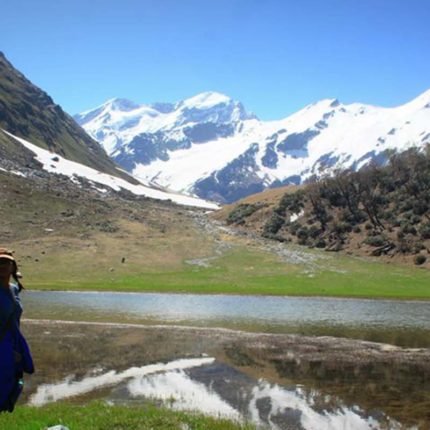
Ruinsara Tal – Har Ki Dun Trek
Harkidun – Ruinsara tal Trek is one of the best trek in Himalayas
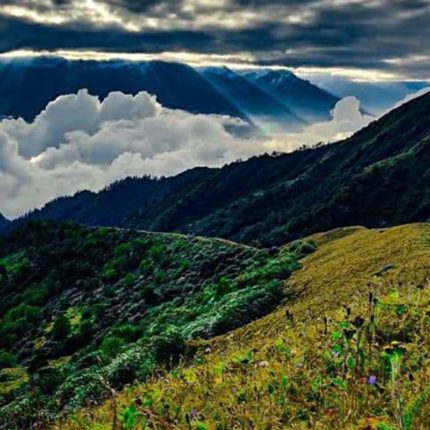
Gidara Bugyal Trek
Gidara Bugyal Trek The Secret Meadow in the Himalayas
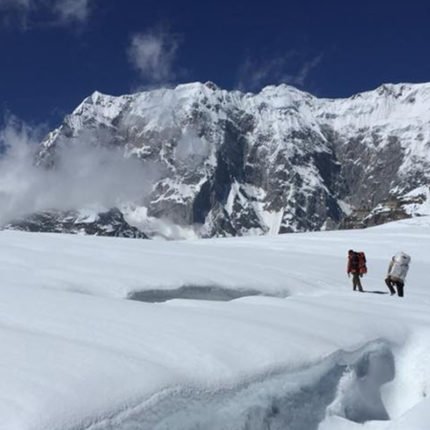
Panpatia Col Trek
An effective and beautiful trek in Chamoli, Uttarakhand.
Price: ₹ 7,500.00
Book the tour
Send a quick enquiry.
- Overview Itinerary Dates Include/Exclude
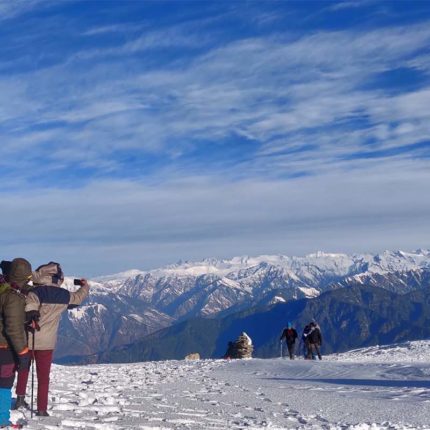
Kedarnath Trek Guide: Exploring the Serene Beauty of the Himalayas
Are you an adventure enthusiast seeking a thrilling journey amidst the towering peaks of the Himalayas? Look no further than the Kedarnath Trek, an expedition that offers breathtaking landscapes, spiritual encounters, and a taste of nature’s grandeur. In this comprehensive guide, we’ll take you through the ins and outs of this incredible trekking experience.
Table of Contents
Introduction to the Kedarnath Trek
Nestled in the Garhwal region of Uttarakhand, India, the Kedarnath Trek is a revered pilgrimage and an adventure seeker’s paradise. The trek takes you to the sacred Kedarnath Temple, dedicated to Lord Shiva, situated at an elevation of 3,583 meters above sea level. The journey is not just about conquering heights; it’s a spiritual quest that connects you with nature’s raw beauty and ancient legends.
Preparation and Essentials for the Trek
Before embarking on this memorable journey, meticulous planning is key. Ensure you have sturdy trekking gear, including comfortable clothing, sturdy hiking shoes, a durable backpack, and other essentials such as water bottles, energy snacks, a first aid kit, and a map. Acclimatization is vital, so engage in light exercises a few weeks prior and stay hydrated.
Best Time to Visit
The ideal time for the Kedarnath Trek is during the months of May to June and September to October. The weather during these periods is relatively mild, offering clear skies and pleasant temperatures. Monsoon season is best avoided due to the risk of landslides and slippery trails.
How to Reach Kedarnath
To reach Kedarnath, one of the most revered pilgrimage sites in India located in the state of Uttarakhand, you can follow these steps:
- Reach Haridwar or Rishikesh : Most journeys to Kedarnath start from either Haridwar or Rishikesh. These towns are well-connected by road and rail to major cities in India.
- By Road : From Haridwar or Rishikesh, you can hire a taxi or take a bus to Gaurikund, the base camp for the Kedarnath trek. The distance is around 200-220 km and the journey takes about 8-10 hours.
- By Helicopter (Optional) : If you prefer a quicker and more convenient option, you can take a helicopter ride from Phata, Guptkashi, or Sersi to Kedarnath. This significantly reduces the travel time, but bookings need to be made in advance.
- Trek to Kedarnath : The main way to reach the temple is by trekking from Gaurikund. The trekking distance is around 16-18 km, and it usually takes about 6-8 hours to complete. The trek route is well-marked and passes through picturesque landscapes. You can also hire mules or ponies to carry your luggage or to assist you in the trek.
- Stay En Route : There are rest stops and accommodations available along the trekking route, such as Rambara and Kedarnath Base Camp. You can choose to stay overnight at these places if you find the trek challenging to complete in a single day.
- Reach Kedarnath : Once you reach Kedarnath, you can visit the famous Kedarnath Temple dedicated to Lord Shiva. The temple is nestled amidst the Himalayas and holds immense religious significance.
- Return Journey : After your visit to the temple, you can retrace your steps back to Gaurikund either by trekking or by availing helicopter services.
Kedarnath Trek Distance
The journey to Kedarnath spans 18 kilometers and commences from Gaurikund, extending all the way to the sacred destination of Kedarnath. This trek underwent modifications following the 2013 flood disaster in Uttarakhand, resulting in the expansion of the previous 14 km route to a new distance of 16 kilometers.
Route Map of the Kedarnath Trek:
- Rishikesh to Sonprayag: The journey usually starts from Rishikesh, where trekkers travel to Sonprayag by road. Sonprayag is the base camp for the Kedarnath Trek.
- Sonprayag to Gaurikund: From Sonprayag, trekkers proceed to Gaurikund, which is around 5 kilometers away. Gaurikund is named after Goddess Parvati and serves as the starting point of the actual trek.
- Gaurikund to Rambara: The trail from Gaurikund leads to Rambara, which is approximately 7 kilometers from Gaurikund. The path offers scenic views of the surrounding mountains and the Mandakini River.
- Rambara to Kedarnath: The journey continues from Rambara to Kedarnath, which is about 6 kilometers away. The route becomes steeper as trekkers ascend towards Kedarnath. The final stretch is known for its breathtaking views but can be challenging due to the altitude gain.
- Kedarnath Temple: At an altitude of around 3,583 meters (11,755 feet), the Kedarnath Temple is one of the holiest Hindu shrines dedicated to Lord Shiva. Pilgrims and trekkers visit the temple to offer prayers and seek blessings.
Route Map for Kedarnath Trek
Embarking on the Kedarnath trek, an 18 km journey, is a pilgrimage of both physical and spiritual significance. The expedition commences from Gaurikund, presenting trekkers with an enriching experience in the heart of the Himalayas. The route itself has undergone modifications, a response to the 2013 disaster that wiped away the original path. The new route, outlined below, serves as your comprehensive travel guide for the Kedarnath trek.
1. Gaurikund: To commence this memorable journey, one must first reach Gaurikund. This preliminary step involves a shared taxi ride of approximately 6 km from Sonprayag.
2. Gaurikund to Jungle Chatti: Begin the trek by moving from Gaurikund to Jungle Chatti, a distance of 6 km. This segment involves traversing the Rambara Bridge and immersing oneself in the scenic surroundings.
3. Jungle Chatti to Bheembali: Progress further along the path, covering a distance of 4 km to reach Bheembali. The natural beauty of the region accompanies your trekking endeavor.
4. Bheembali to Linchauli: Continue your journey through the mountainscape, venturing 3 km to arrive at Linchauli. Each step embraces the serenity of the environment.
5. Linchauli to Kedarnath Base Camp: Traverse a distance of 4 km as you approach the Kedarnath Base Camp. The gradual transition in landscape offers trekkers a sense of the grandeur that lies ahead.
6. Kedarnath Base Camp to Kedarnath Temple: The final stretch, spanning 1 km, leads from the Kedarnath Base Camp to the revered Kedarnath Temple. This sacred site, nestled amidst the heights, marks the culmination of your trek and the beginning of a spiritual sojourn.
Facilities at the Kedarnath Trek
Trail highlights and scenic views.
The Kedarnath Trail boasts an array of captivating highlights and breathtaking scenic views. Trekking through dense forests, tranquil meadows, and challenging terrains, adventurers are treated to glimpses of the Mandakini River’s sparkling beauty. The trail’s crescendo is the Chandrashila summit, offering panoramic vistas of snow-clad peaks that leave an indelible mark on the heart. Additionally, the Vasuki Tal glacial lake enchants trekkers with its serene turquoise waters against the backdrop of towering mountains.
Camping and Accommodation Options
Kedarnath holds a distinguished position among the revered shrines dedicated to Lord Shiva and is an integral part of Uttarakhand’s Char Dham Yatra . Once teeming with hotels, lodges, and ashrams in locations like Kedarnath, Gaurikund, and Rambara, providing budget-friendly lodging for pilgrims, the landscape underwent a transformation due to the devastating flash floods in 2013, resulting in the obliteration of all accommodations.
Please note that in response to this, entities like NIM and other aiding authorities have constructed a limited number of budget camps and tents within the Kedarnath region. These endeavors aim to expand the range of accommodation choices for tourists. At present, tourists and pilgrims can exclusively avail lodging at GMVN Tents & Camps, offering a secure and reliable place to stay.
Cultural and Spiritual Significance
Apart from its natural beauty, the Kedarnath Trek holds deep spiritual significance. According to Hindu mythology, this region is believed to be the abode of Lord Shiva, making it an essential pilgrimage for devotees. The journey itself becomes a spiritual cleansing, fostering a deep connection with the divine.
Challenges Faced During the Trek
While the Kedarnath Trek is a rewarding adventure, it comes with its share of challenges. The steep ascents and descents on rocky terrains demand physical stamina and mental determination. Acclimatizing to the high altitudes is essential to avoid altitude sickness, which can cause discomfort. The weather can be unpredictable, ranging from sunny skies to sudden rain or snowfall. Navigating through varying landscapes, such as narrow trails and river crossings, requires careful attention. Additionally, the lack of basic amenities along the route and limited mobile network coverage might test your self-sufficiency. Despite these obstacles, conquering the challenges of the Kedarnath Trek yields a sense of accomplishment and an unparalleled connection with nature.
Safety Measures and Health Considerations
Prioritizing safety and health considerations is paramount when embarking on the Kedarnath Trek. Begin by trekking with a certified guide who knows the trail and can navigate challenges. Stay informed about weather forecasts to prepare for changing conditions. Acclimatize gradually to prevent altitude sickness – stay hydrated, avoid alcohol, and ascend slowly. Carry essential medications and a well-stocked first aid kit. Respect the environment by following the “Leave No Trace” principle, ensuring the trail remains pristine for future trekkers. Finally, communicate your itinerary to someone and stay connected, as mobile network coverage can be limited in certain areas. By adhering to these safety measures, you can enjoy a secure and fulfilling trekking experience.
Packing Tips for the Trek
When preparing for the Kedarnath Trek, strategic packing can make your journey smoother and more enjoyable. Prioritize essentials like sturdy hiking boots for rocky terrains, moisture-wicking clothing to handle varying weather, and a waterproof jacket to combat unexpected rain. Don’t forget to pack a reliable backpack with adjustable straps for comfortable carrying, along with essentials like a first aid kit, energy-packed snacks, a reusable water bottle, and a compact sleeping bag. Trekking poles can provide stability, especially on steep ascents and descents. Lastly, a fully charged camera, sun protection, and a hat are crucial for capturing memories and shielding yourself from the elements.
Exploring Nearby Attractions
While embarking on the Kedarnath Trek, the adventure extends beyond the trail itself, offering the opportunity to explore nearby attractions that add depth to your journey. After paying homage at the revered Kedarnath Temple, consider extending your exploration to destinations like Badrinath, a significant pilgrimage site renowned for its temple dedicated to Lord Vishnu. Rudraprayag, where the Alaknanda and Mandakini rivers confluence, offers a serene atmosphere and a chance to connect with nature. Chopta, known as the “Mini Switzerland of India,” beckons with its captivating meadows and breathtaking views of the Himalayan peaks. These nearby attractions enhance your overall experience, painting a richer picture of the region’s cultural and natural diversity.
Capturing Memories: Photography Tips
As you embark on the Kedarnath Trek, don’t miss the chance to capture the awe-inspiring landscapes through your lens. To truly encapsulate the beauty of the journey, embrace natural lighting – early mornings and golden hours before sunset offer magical illumination. Experiment with different angles to showcase the vastness of the Himalayas, the serenity of the meadows, and the intricacies of the trails. Focus on details like vibrant wildflowers, flowing streams, and rugged terrains to convey the trek’s diversity. Additionally, consider using people in your shots to provide a sense of scale and perspective. Lastly, let the breathtaking views inspire you; tell a story through your photos and immortalize the memories created during this remarkable expedition.
Trekking Solo vs. Group Trek
When considering the Kedarnath Trek, the choice between embarking solo or joining a group trek comes down to personal preferences and desired experiences. Trekking solo offers introspection and a unique connection with nature, allowing you to set your own pace and relish the solitude. It’s a chance for self-discovery and embracing the trail at your own rhythm. On the other hand, a group trek infuses camaraderie and shared memories. It’s an avenue for forming bonds with fellow trekkers, exchanging stories, and enjoying collective triumphs. Group treks often offer organized logistics, easing the burden of planning and navigation. Ultimately, whether solo or in a group, the Kedarnath Trek promises transformative moments and breathtaking vistas, tailored to your chosen path.
Important Points to Keep in Mind Before Going Kedarnath Trek
Embarking on the Kedarnath Trek is an exciting adventure, but thorough preparation is key to ensure a safe and enjoyable experience. Here are important considerations before you begin your journey:
- Physical Readiness: The Kedarnath Trek involves challenging terrain and high altitudes. Make sure you’re physically fit and ready for the demands of the journey. Regular exercise and cardiovascular training can help build stamina.
- Weather Readiness: Weather conditions can change rapidly in the mountains. Pack clothing suitable for both warm and cold weather. Don’t forget rain gear to stay dry during unexpected rain showers.
- Footwear Selection: Invest in sturdy, comfortable trekking shoes with proper grip. Well-fitting footwear prevents discomfort and minimizes the risk of injuries.
- Appropriate Clothing: Layer your clothing to adapt to varying temperatures. Bring warm clothing like jackets, gloves, and hats, as temperatures can drop significantly at higher elevations.
- Important Documents: Safeguard your identification, permits, and relevant documents in a waterproof pouch. These might be necessary at different checkpoints during the trek.
- Hydration and Nutrition: Carry an ample supply of water to stay hydrated throughout the trek. Pack energy-rich snacks such as nuts, trail mix, and energy bars to sustain your energy levels.
- Basic First Aid Kit: Prepare a basic first aid kit containing essentials like bandages, antiseptic cream, pain relievers, and any personal medications you require.
- Communication Plans: Although mobile network coverage might be limited, carrying a fully charged power bank is useful. Inform a trusted person about your trekking plans and expected return date.
- Respect for Local Customs: The Kedarnath region holds deep religious significance. Respect local customs, traditions, and sacred sites. Dress modestly and avoid littering.
- Trekking Permits: Check whether you need permits to access the trekking route. Obtain these permits beforehand to prevent any delays.
- Guided Trek or Solo: Decide whether you’ll undertake the trek with a guided group or as a solo traveler. Guided treks offer expertise and logistical support.
- Altitude Adjustment: Allow your body time to acclimatize to higher altitudes. Take breaks, avoid rapid ascents, and pay attention to your body’s signals.
- Environmental Responsibility: Adhere to the Leave No Trace principles. Carry all your waste back with you and help preserve the natural beauty of the environment.
- Emergency Contacts: Keep emergency contact numbers readily accessible. Be aware of nearby medical facilities and rescue services.
- Travel Insurance: Consider obtaining travel insurance that covers potential medical emergencies and trip cancellations.
Conclusion: A Transformative Experience
The Kedarnath Trek transcends the ordinary, offering an unforgettable blend of adventure, spirituality, and natural beauty. As you trek through the breathtaking Himalayan terrain, you’ll find solace, courage, and a renewed sense of wonder. So, gear up for this life-changing expedition and embrace the journey of a lifetime.
FAQs (Frequently Asked Questions)
- Is prior trekking experience necessary for the Kedarnath Trek? While prior experience is beneficial, beginners with reasonable fitness levels can undertake the trek with proper preparation.
- Are there any age restrictions for the trek? The trek is suitable for individuals in good health. It’s recommended to consult a physician before embarking, especially for senior citizens.
- What’s the significance of Kedarnath Temple? Kedarnath Temple holds immense religious importance for Hindus and is one of the twelve Jyotirlingas of Lord Shiva .
- Are there any wildlife concerns during the trek? While encounters are rare, the region is home to various wildlife species. Trek in groups, make noise, and avoid venturing into dense forests.
- Can I undertake the trek during winter? The trek is not recommended during winter due to heavy snowfall and extreme cold temperatures.
Leave a Reply Cancel reply
Your email address will not be published. Required fields are marked *
Plan Your Trip Our expert will get in touch with you shortly
Mobile No *

Roamanch Travel Blog
Your Travel Wingman
The Ultimate Guide to the Kedarnath Trek
Nestled amidst the majestic peaks of the Garhwal Himalayas, the Kedarnath Trek stands as a testament to spiritual devotion and unparalleled natural beauty. Spanning across rugged terrains and breathtaking landscapes, this trek is not just a physical journey but a soul-stirring odyssey that connects pilgrims and adventurers alike with the divine essence of the Himalayan region. In this comprehensive guide, we delve deep into the intricacies of the Kedarnath Trek, providing a detailed roadmap, essential tips, and insights to ensure an enriching and fulfilling experience for all those who embark on this sacred pilgrimage.
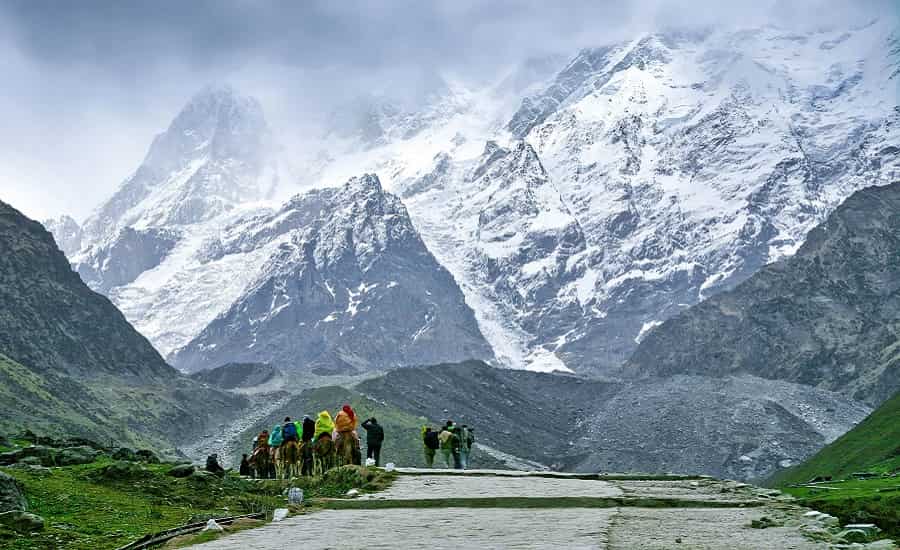
Table of Contents
How to Reach Kedarnath by Road
Reaching Kedarnath by road involves a journey through the picturesque landscapes of Uttarakhand, navigating winding mountain roads and scenic valleys. The nearest town to Kedarnath is Gaurikund, which serves as the base camp for the trek to the temple. Here are the steps to reach Kedarnath by road:
- From Delhi : The most common starting point for travelers is Delhi, the capital city of India. From Delhi, you can embark on a road trip to reach Kedarnath.
- Route: The route from Delhi to Kedarnath typically involves driving through the following cities and towns: Delhi – Haridwar – Rishikesh – Devprayag – Srinagar – Rudraprayag – Agastmuni – Guptkashi – Sonprayag – Gaurikund.
- Distance: The total distance from Delhi to Gaurikund is approximately 450 kilometers, which takes around 14-16 hours by road, depending on traffic and road conditions.
- Transportation Options: Travelers can choose between self-driving, hiring a taxi, or using public transport like buses. Private taxis are readily available from Delhi, Haridwar, and Rishikesh for the entire journey or up to Gaurikund.
- Road Conditions: While most of the route is well-maintained, some stretches may be narrow and winding, particularly after Devprayag. It’s advisable to travel during daylight hours and exercise caution while driving.
- Parking Facilities: At Gaurikund, parking facilities are available for vehicles, where travelers can leave their cars or hire ponies and porters for the trek ahead.
Kedarnath Route from Delhi
The route from Delhi to Kedarnath offers breathtaking views of the Himalayas and passes through several towns and landmarks of cultural and historical significance. Here’s a detailed overview of the route:
- Delhi to Haridwar : The journey begins from Delhi, heading towards Haridwar, a sacred city on the banks of the Ganges River, known for its ghats and temples.
- Haridwar to Rishikesh : From Haridwar, travelers proceed to Rishikesh, the “Yoga Capital of the World,” famous for its ashrams, suspension bridges, and river rafting activities.
- Rishikesh to Devprayag : Continuing the journey, the route takes travelers to Devprayag, where the Alaknanda and Bhagirathi rivers converge to form the holy Ganges.
- Devprayag to Srinagar : Traveling further, the route passes through Srinagar, a picturesque town on the banks of the Alaknanda River, known for its scenic beauty and educational institutions.
- Srinagar to Rudraprayag : The journey then proceeds to Rudraprayag, a confluence of the Alaknanda and Mandakini rivers, offering panoramic views of the surrounding mountains.
- Rudraprayag to Agastmuni to Guptkashi : From Rudraprayag, travelers continue towards Agastmuni and Guptkashi, important stopovers en route to Kedarnath, where they can rest and refresh.
- Guptkashi to Sonprayag to Gaurikund : Finally, the route leads to Sonprayag and Gaurikund, the last motorable point before the trek to Kedarnath Temple begins.
- Gaurikund to Kedarnath Temple : From Gaurikund, pilgrims and trekkers commence their journey on foot, covering a distance of approximately 16 kilometers to reach the sacred Kedarnath Temple.
Kedarnath Trekking Distance
The trekking distance from Gaurikund to Kedarnath Temple is approximately 16 kilometers (10 miles) one way. The trail winds its way through steep ascents, rocky paths, and scenic landscapes, offering pilgrims a challenging yet rewarding experience. Depending on one’s pace and physical condition, the trek can take anywhere between 6 to 9 hours to complete.
Facilities at Kedarnath Trek
Despite its remote location, the Kedarnath Trek offers basic facilities and amenities to ensure the comfort and safety of pilgrims and trekkers. Here are some of the facilities available along the trekking route:
- Accommodation : Along the trekking route, pilgrims can find various accommodation options, including guesthouses, dharamshalas (pilgrim shelters), and tents. These facilities provide basic amenities such as beds, blankets, and meals for travelers.
- Food and Water : There are several tea stalls and small eateries along the trekking route, offering snacks, tea, and meals to pilgrims. It’s advisable to carry sufficient water and energy snacks to stay hydrated and energized during the trek.
- Medical Facilities : Basic medical facilities are available at several points along the trekking route, including first aid kits, emergency medical assistance, and access to oxygen cylinders for altitude sickness.
- Ponies and Porters : For travelers who may find the trek challenging, ponies and porters are available for hire at Gaurikund to carry luggage and provide assistance during the journey.
- Toilets : Temporary toilet facilities are set up at regular intervals along the trekking route for the convenience of pilgrims. It’s essential to maintain cleanliness and hygiene while using these facilities.
- Mobile Connectivity : While mobile network coverage may be limited or non-existent in certain areas, there are designated spots along the route where pilgrims can find network connectivity to make calls or access the internet.
- Security : Security personnel are deployed along the trekking route to ensure the safety and well-being of pilgrims. Travelers are advised to follow instructions and guidelines provided by authorities for a smooth and secure trekking experience.
Kedarnath Distance Chart from Major Cities
Here’s a distance chart indicating the approximate distance from major cities to Kedarnath:
- Delhi to Kedarnath: Approximately 450 kilometers
- Haridwar to Kedarnath: Approximately 240 kilometers
- Rishikesh to Kedarnath: Approximately 220 kilometers
- Dehradun to Kedarnath: Approximately 290 kilometers
- Gaurikund to Kedarnath Temple: Approximately 16 kilometers (trekking distance)
Kedarnath Trek Itinerary
A typical itinerary for the Kedarnath Trek involves the following stages:
Day 1: Arrival in Gaurikund
- Travel from Delhi to Gaurikund by road
- Check-in at accommodation in Gaurikund
- Rest and acclimatize for the trek ahead
Day 2: Trek from Gaurikund to Kedarnath
- Start early morning trek to Kedarnath Temple
- En route visit Rambara Bridge and other landmarks
- Reach Kedarnath by afternoon/evening
- Darshan at Kedarnath Temple
- Overnight stay in Kedarnath
Day 3: Return Trek from Kedarnath to Gaurikund
- Early morning darshan at Kedarnath Temple
- Start trek back to Gaurikund
- Rest and relax upon reaching Gaurikund
- Optional: Visit nearby attractions or continue journey
New Trekking Route for Kedarnath Dham
In recent years, efforts have been made to develop a new trekking route for Kedarnath Dham to improve accessibility and enhance the trekking experience. The new route, known as the Chopta-Kedarnath Trek, offers an alternative approach to reaching the sacred temple. Here are some key features of the new trekking route:
- Scenic Beauty : The Chopta-Kedarnath Trek passes through breathtaking landscapes, including lush forests, alpine meadows, and panoramic viewpoints, providing travelers with a memorable journey amidst natural splendor.
- Less Crowded : Compared to the traditional trekking route from Gaurikund, the Chopta-Kedarnath Trek is relatively less crowded, offering pilgrims a more serene and peaceful trekking experience.
- Shorter Distance : The new route is shorter in distance compared to the Gaurikund-Kedarnath route, making it ideal for travelers seeking a quicker and less strenuous trek to the temple.
- Facilities : Basic facilities such as accommodation, food stalls, and medical aid are available along the Chopta-Kedarnath Trek route, ensuring the comfort and safety of pilgrims and trekkers.
Challenges Faced During the Trek
While the Kedarnath Trek offers a spiritually enriching experience, it also presents several challenges that pilgrims and trekkers need to be aware of:
- Altitude : The trek involves ascending to high altitudes, with Kedarnath Temple located at an elevation of approximately 3,583 meters (11,755 feet). Altitude sickness can occur, especially for those not acclimatized to high altitudes.
- Weather Conditions : Weather in the Himalayas can be unpredictable, with sudden changes in temperature, rainfall, and snowfall. Trekkers should be prepared for varying weather conditions and carry appropriate clothing and gear.
- Physical Exertion : The trek involves walking long distances over challenging terrain, including steep ascents and descents. Trekkers need to be physically fit and prepared for the strenuous nature of the journey.
- Limited Facilities : While basic facilities are available along the trekking route, amenities may be limited, particularly in remote areas. Pilgrims should carry essential supplies such as water, snacks, and medicines to sustain themselves during the trek.
- Environmental Impact : The fragile ecosystem of the Himalayas is susceptible to environmental degradation due to increased tourism and trekking activities. Pilgrims should follow eco-friendly practices and minimize their environmental impact while trekking.
Trekking Tips & Things to Carry
To ensure a safe and enjoyable trekking experience to Kedarnath, here are some essential tips and things to carry:
- Fitness Preparation : Engage in regular exercise and physical activity to build stamina and endurance for the trek. Practice hiking on inclines and uneven terrain to simulate trekking conditions.
- Acclimatization : Spend a day or two in Gaurikund or nearby towns to acclimatize to the high altitude before starting the trek to Kedarnath Temple. Take it slow and allow your body to adjust to the altitude.
- Appropriate Clothing : Dress in layers to adapt to changing weather conditions. Carry warm clothing, including jackets, thermals, gloves, and hats, as temperatures can drop significantly at higher altitudes.
- Footwear : Wear sturdy and comfortable trekking shoes with good grip to navigate rocky terrain and uneven paths. Avoid wearing new shoes and break them in before the trek to prevent blisters and discomfort.
- Hydration and Nutrition : Stay hydrated by drinking plenty of water throughout the trek. Carry energy snacks such as nuts, dried fruits, chocolates, and energy bars to replenish energy levels during the trek.
- First Aid Kit : Pack a basic first aid kit containing essential medications, bandages, antiseptic ointment, pain relievers, and any personal medications you may require.
- Trekking Gear : Carry trekking essentials such as a backpack, trekking poles, headlamp or flashlight, sunglasses, sunscreen, lip balm, and a multi-tool or Swiss army knife.
- Navigation Tools : Carry a map, compass, or GPS device to navigate the trekking route, especially in areas with limited visibility or trail markings.
- Emergency Contacts : Carry a list of emergency contacts, including local authorities, trekking guides, and medical facilities, in case of any unforeseen circumstances or emergencies.
- Leave No Trace : Practice Leave No Trace principles by disposing of waste properly, avoiding littering, and respecting the natural environment and wildlife.
Best Time for Kedarnath Yatra Trek
The best time to undertake the Kedarnath Yatra Trek is during the summer months from May to June and the autumn months from September to October. During these periods, the weather is relatively stable, with clear skies and mild temperatures, making it ideal for trekking and pilgrimage. However, it’s essential to avoid the monsoon season from July to August and the winter months from November to April due to heavy rainfall, landslides, and snowfall, which can make the trek challenging and dangerous.
- Also Read : Best Time to Visit Kedarnath Dham
Camping and Accommodation Options
Along the trekking route to Kedarnath, pilgrims and trekkers have various options for accommodation, including:
- Guesthouses and Dharamshalas : Several guesthouses and dharamshalas (pilgrim shelters) are available along the trekking route, offering basic accommodation with amenities such as beds, blankets, and meals.
- Campsites : Camping is a popular option for trekkers who prefer to immerse themselves in nature. There are designated campsites along the trekking route where travelers can pitch tents and spend the night under the stars.
- Temporary Shelters : During peak pilgrimage seasons, temporary shelters are set up at strategic locations along the route to accommodate the influx of pilgrims. These shelters provide basic facilities such as sleeping mats, blankets, and food services.
- Pilgrim Tents : At Kedarnath Temple, pilgrim tents are available for rent, offering a convenient accommodation option for travelers seeking proximity to the temple complex.
While booking accommodation, it’s advisable to make reservations in advance, especially during peak pilgrimage seasons, to ensure availability and avoid last-minute inconvenience.
Exploring Nearby Attractions
In addition to the pilgrimage to Kedarnath Temple, travelers have the opportunity to explore several nearby attractions and points of interest:
Badrinath Temple : Located approximately 223 kilometers from Kedarnath, Badrinath Temple is another prominent pilgrimage site dedicated to Lord Vishnu. Pilgrims can visit Badrinath Temple to complete the Char Dham Yatra circuit.
Rudraprayag : Situated at the confluence of the Alaknanda and Mandakini rivers, Rudraprayag is known for its scenic beauty and spiritual significance. Travelers can visit temples and ashrams in Rudraprayag to experience its cultural heritage.
Chopta : Often referred to as the “Mini Switzerland of India,” Chopta is a picturesque hill station located approximately 25 kilometers from Gaurikund. It offers stunning views of the Himalayan peaks and is a popular destination for trekking and camping.
Tungnath Temple : En route to Kedarnath, travelers can visit Tungnath Temple, the highest Shiva temple in the world, situated at an altitude of approximately 3,680 meters (12,073 feet). The temple holds great religious significance and offers panoramic views of the surrounding mountains.
Deoria Tal : Located near Chopta, Deoria Tal is a pristine lake surrounded by lush forests and snow-capped peaks. Trekkers can undertake a short hike to Deoria Tal from Sari Village and enjoy the tranquility of the lake amidst natural beauty.
Q-1 Is the Kedarnath Trek suitable for beginners? Ans: While the Kedarnath Trek is manageable for beginners with a moderate level of fitness, it does involve long distances and steep ascents. It’s essential to prepare physically and mentally for the trek and take adequate rest breaks along the way.
Q-2 Are there medical facilities available along the trekking route? Ans: Basic medical facilities are available at various points along the trekking route, including first aid stations and access to oxygen cylinders for altitude sickness. However, travelers with pre-existing medical conditions should consult their healthcare provider before embarking on the trek.
Q-3 What is the best time to visit Kedarnath Temple? Ans: The best time to visit Kedarnath Temple is during the summer months from May to June and the autumn months from September to October when the weather is favorable for trekking and pilgrimage. It’s advisable to avoid the monsoon season from July to August and the winter months from November to April due to inclement weather conditions.
Q-4 Is it safe to trek to Kedarnath Temple alone? Ans: While solo trekking is possible, it’s recommended to trek in a group or with experienced guides for safety and support, especially for first-time trekkers. Travelers should also inform their itinerary to family or friends and stay updated on weather forecasts and trail conditions.
Q-5 What should I do in case of an emergency during the trek? Ans: In case of an emergency, travelers should stay calm and seek assistance from fellow trekkers, guides, or local authorities. It’s essential to carry a list of emergency contacts and follow safety protocols to ensure a prompt and effective response to any unforeseen situation.
In conclusion, the Kedarnath Trek offers pilgrims and trekkers a unique opportunity to embark on a spiritual journey amidst the majestic Himalayas. With proper planning, preparation, and respect for nature, travelers can experience the beauty and serenity of this sacred pilgrimage route while paying homage to one of the holiest shrines in Hindu mythology. Whether seeking adventure, spiritual enlightenment, or communion with nature, the Kedarnath Trek beckons travelers from around the world to embark on a transformative quest to the abode of Lord Shiva.
Also Read:
- History of Kedarnath Dham
Best Time to Visit Kedarnath
More stories.
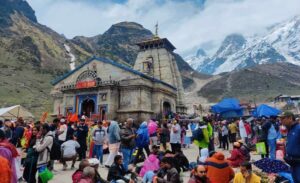
History of Kedarnath Temple
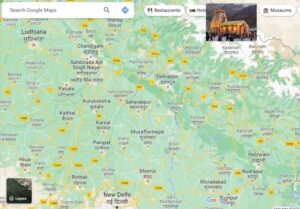
Kedarnath Yatra Route Map
Leave a reply cancel reply.
Your email address will not be published. Required fields are marked *
Save my name, email, and website in this browser for the next time I comment.
You may have missed
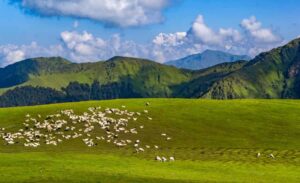
- Uncategorized
- Uttarakhand
Bugyal of Uttarakhand
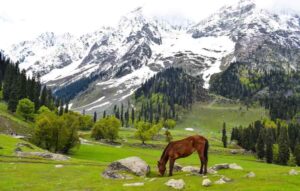
- Places to Visit
Best Places to Visit in North India

Must Try Street Food in Vadodara
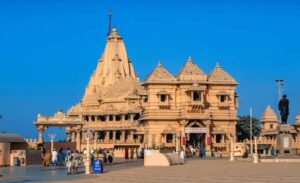
- Somnath Temple
Tourist Places To Visit in Somnath
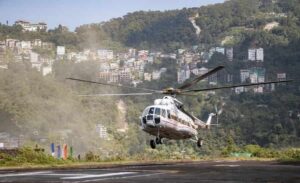
Helicopter Rides Destinations In India

Top 5 Places to Visit in Dubai With a Car

Family Boating Trips: 5 Tips To Consider Before Your Next Holiday!

How to Experience the Real Cuba Beyond the Tourist Areas
How Gps Tracker for Kids is a Boon for Working Mothers?

Waterfalls Near Bangalore Within 100 Kms: Amidst Cascading Water And The Sound Of Nature

7 Top Archaeological Wonders of the Holy Land
Sorry, but nothing matched your search " ". Please try again with some different keywords.
Kedarnath Trek: A Holy Journey To Complete The Char Dham Yatra (Explore The Complete Guide)
Sibashree bhattacharya.
Aug 27, 2024
Travel Guides
Kedarnath Trek is beyond a mountaineering experience. In the Rudraprayag district of Uttarakhand , this route is the most wonderful fusion of trekking, spirituality, religious fulfillment, and cultural enrichment.
From the first ray of the Sun kissing the snow-capped peaks to spending the dark evening in the Kedarnath temple, the journey is something that touches your mind, soul, and body together.
Here, I present a concise guide, discussing a brief itinerary, expenses, preparations, and more about this trekking route in Uttarakhand . Let’s get going!
How Long Is Kedarnath Trek? (With A Detailed Itinerary)
🏔️ Kedarnath trek distance – 16 Km (From Gaurikund)
🏔️ How Much Time It Takes For Kedarnath Trek : 3 to 4 Days
🏔️ Difficulty Level : Moderate
🏔️ Altitude : 3583 Meters
You can reach Gaurikund by air, train, bus, and taxi from various points like Dehradun , Rishikesh, and Haridwar.
Further, if you have physical limitations, you can make this beautiful journey by helicopter from Sirsi, Phata, and Guptkashi. You can avail yourself of this helicopter facility from May to October with prior bookings .
Here is a detailed picture of the itinerary that will help you better understand your journey to and from the holy shrine of Kedarnath. The journey here begins from Gaurikund . It has many camping sites like Linchauli, Jungle Chatti, and Bheembali .
Like any trekking in India , the trek to Kedarnath can also take longer than usual based on your physical fitness level and weather conditions like cloud bursts . One great thing is that the Kedarnath trekking route has many amenities. However, the amenities do not eliminate your requirements to acclimatize to the conditions and maintain a certain fitness level.
In addition, you must be respectful of the local people, culture, and their religious sentiments.
Do you want to hear a short anecdote that I heard from my father from his Kedarnath trek?
Here it is!
My father completed the Kedarnath trek twice. On his second trip, he found that all the lodges and hotels were filled with tourists. The owners could not do anything even with prior bookings, as the tourist pull was massive that year.
Anyway, my father somehow managed to spend the night at an Ashram.
He could not sleep all night as the bed felt wet with dew and drizzles of snow. However, as the darkness started going away, he thought that there could be no better accommodation than what he got.
He saw the first light of the Sun seeping through the highest clouds and hitting the snow-capped mountains. To my father, it appeared like a sage meditating on the mountain peak with divine auras surrounding him. That’s the magic of the Kedarnath trek!
How Many Km Trek To Kedarnath Through The Kedarnath Musk Deer Conservation Trek Route?
Today, many people take the Kedarnath Musk Deer Conservation trek route . As a part of the Kedarnath Wildlife Sanctuary, this route allows for an encounter with the Himalayan wildlife, vegetation, and mesmerizing Himalayan range.
The duration of this trek is similar to the one from Gaurikund. However, to complete this 3-4 days trek , you will need prior permits and bookings. Further, this trek in Uttarakhand will need to be more particular with your clothes, gear, first-aid arrangements, and other essentials.
If you are taking this route, you must completely follow the guidance of your trek mentor.
What Are The Amenities Available During Kedarnath Trek?
The Kedarnath trek is not just a route for pursuits in the mountains. It is also a celebrated pathway to reach one of the holiest shrines of the Hindus. It is a part of the Char Dham Yatra , which every religious Hindu wishes to complete in their lives.
So, this trekking route has many amenities to support your journey. Let’s find out what you can find here.
Food, Water, And Accommodation
You will find local food and bottled water in the restaurants and roadside shops in Gaurikund and Kedarnath. The accommodation in the local lodges and guesthouses is basic but comfortable.
Medical Facilities
Pilgrims and trekkers get immediate medical attention on the trekking route thanks to various medical aid posts and facilities.
Pony And Mule Services
The elderly pilgrims and ones with certain physical conditions can hire mules and ponies from Gaurikund.
Mobile Network
Mobile network is available throughout the Gaurikund to Kedarnath trek route. However, in places, you may see poor or inconsistent network connections.
What Is The Best Time For The Kedarnath Trek?
September to November is the best time for the Kedarnath trek. So, essentially, Kedarnath is an autumn trek. Further, many people consider visiting Kedarnath during Diwali holy.
This season is also great as it comes just after the monsoon ends. So, the sky remains clear most of the time. The daytime temperature is moderate in Kedarnath during these months. It will be around 5 to 15 degrees Celsius . However, the temperature starts falling at night, reaching zero to 7 degrees Celsius .
You can even complete the Kedarnath trek from May to June . The average temperature of 10-20 degrees Celsius and Sunny days make the season delightful for trekkers.
How Much Is Kedarnath Trek?
The cost of the Kedarnath trek will depend on various factors, including the size of your group, how you are commuting to Gaurikund, and the purpose of your visit.
For example, if you are going to Kedarnath as a pilgrim, you will want to stay there for a couple of more days. So, the overall expenditure will be more. At the same time, when you are a trekker, your route and itinerary will be more definite.
As there are so many factors to consider, the cost of the Kedarnath trek will be between INR 9000 and 32000 per person . The cost will include accommodation, mule and pony charges, food, water, medical expenses, permits, transportation costs, etc.
How To Prepare For Kedarnath Trek Physically?
Despite having a moderate difficulty level , the Kedarnath trek comes with steep slopes. So, you need to prepare yourself physically before making the attempt. Your physical training should begin at least one month prior to the trek.
The fitness training will involve strength training, cardio training, and altitude training . These exercises will help your body to be in the perfect shape. Further, the strength training will be more focused on your core and leg muscles.
Cardio training, such as running, walking, and swimming, will improve your stamina and will not allow you to feel fatigued easily. Finally, short trekking sessions will be the best for your altitude training as you will learn to walk or trek a certain distance while carrying your luggage.
Along with physical training, you will also need to focus on mental training or conditioning. Yoga and meditation are the most popular techniques to get rid of their mental blockage.
Moreover, to keep your body in sound condition, you must be careful about your food and hydration . You can have seeds, fruits, pulses, and veggies.
Which Trek Is Difficult Kedarnath Or Tungnath?
Kedarnath and Tunganath , despite officially being moderate treks, have their share of difficulties. Kedarnath is more popular, and thanks to the massive crowd pull today, it has many amenities.
However, the Tungnath-Chandrashila trek of 3.5 Km is quite difficult to climb. At least 1.5 Km of this route is muddy and filled with stone.
Further, with an elevation of 12k feet , Tunganath is the highest Shiva temple in the world . Altitude sickness is common at such a height.
Here are some common challenges in the Tungnath trek.
Steep Terrain
As mentioned, the terrain is rocky, and it’s quite steep in the Tungnath. So, you have to wear the right boots with the best grip and use hikers’ poles to trek safely.
Extreme Weather Conditions
Heavy snowfall is common on this route. The subzero temperatures cause hindrances in movement and trekking.
Altitude Sickness
With an elevation of 12k feet, the Tunganath temple trek can cause nausea, breathing problems, and headaches.
Accommodation Problems
The number of camps, lodges, and hotels is very low on this route.
Kedarnath Trek: History, Legend, And Mythological Stories
The Kedarnath Trek has a deep association with Hindu mythology, and the story of Pandavas is the most popular among the stories.
The Pandavas prayed to Lord Shiva to repent for their sin of killing their kin. However, Lord Shiva took the disguise of a bull as he wanted the Pandavas to repent.
The Pandavas were continuously trying to get hold of Lord Shiva, and finally, Bhima, the strongest of them all, could hold the hump of the bull or Lord Shiva. That hump is believed to be the “Linga” of Kedarnath.
Kedarnath is one of the 12 Jyotirlingas in India. Devotees believe that this Shiva Linga exudes the celestial light of Lord Shiva. In addition, Kedarnath is the first of the Panch Kedar locations . In these sites, Lord Shiva took the form of various body parts of bulls.
Adi Shankaracharya, the pioneer of the Hindu school of Advaita Vedanta, is said to be instrumental in reconstructing Kedarnath .
There is another mythological story about the Kedarnath. It is said to be the meeting ground of sages Nara and Narayana. They received blessings from Lord Shiva and became permanent dwellers of this holy place.
Final Words
The Kedarnath trek in the Himalayas is a trekkers’ delight and one of the holiest sites for Hindus . The high altitude, diverse landscape, and meditative nature of the place ensure an immersive experience. The “Har Har Mahadev” chant and soaking in the hot springs of Gaurikund keep you going through this moderate terrain.
The evening and morning Aartis at the Kedarnath temple are the two biggest highlights of the journey. So, take this holy journey toward one of the most venerated Hindu pilgrimages in the world and into the lap of the Himalayas.
And once you come back, don’t forget to share your experience with us!
Related Posts..
- Did You Know These Things About Hampta Pass Trek?
- Annapurna Base Camp Trek: Know The Tales From The Trails
- Valley of Flowers Trek: A Complete Guide With Things That Will Make Your Days And Nights Special
Share on Social Media
Sibashree is the go-to person if Kafkaesque travel escapades are what you are all about! 10 years of experience in acting as the vessel for her readers to escape daily life, she has profound travel guides and exquisite beach and restaurant recommendations that make you want to pack your bags and hop on the next flight! Intrigued by the mystery of the mountains, she can also be seen dreaming about the blue water meeting the warm sand while she mentally jots down everything she cannot wait to share with her loyal readers!
Leave a reply cancel reply.
Your email address will not be published. Required fields are marked *

A Sports Fan’s Guide To Phoenix

The Rise Of Eco-Friendly And Sustainable Travel Options

Why Bangkok Is A Global Hub For Cosmetic Procedures?
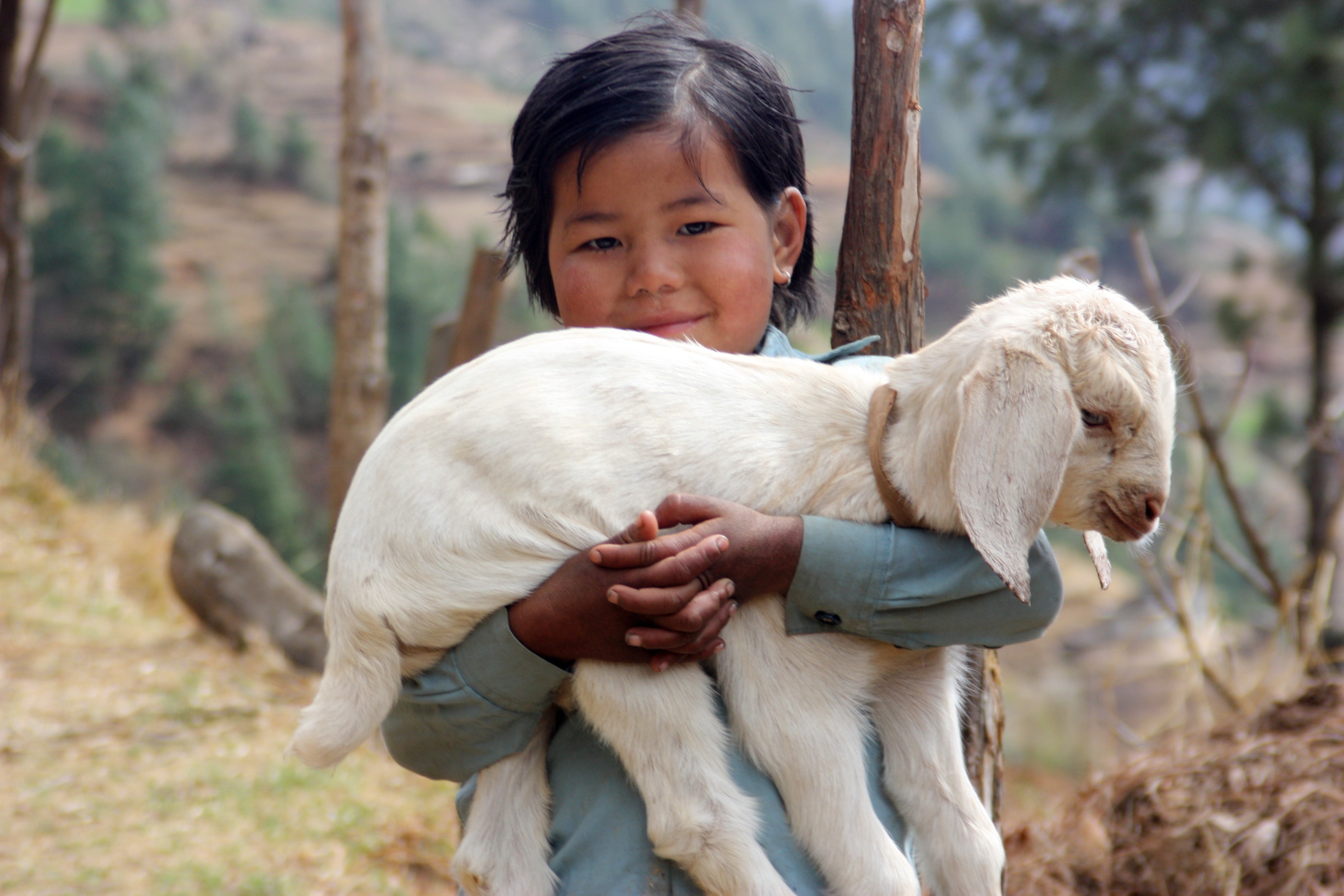
Top Five Treks in Nepal
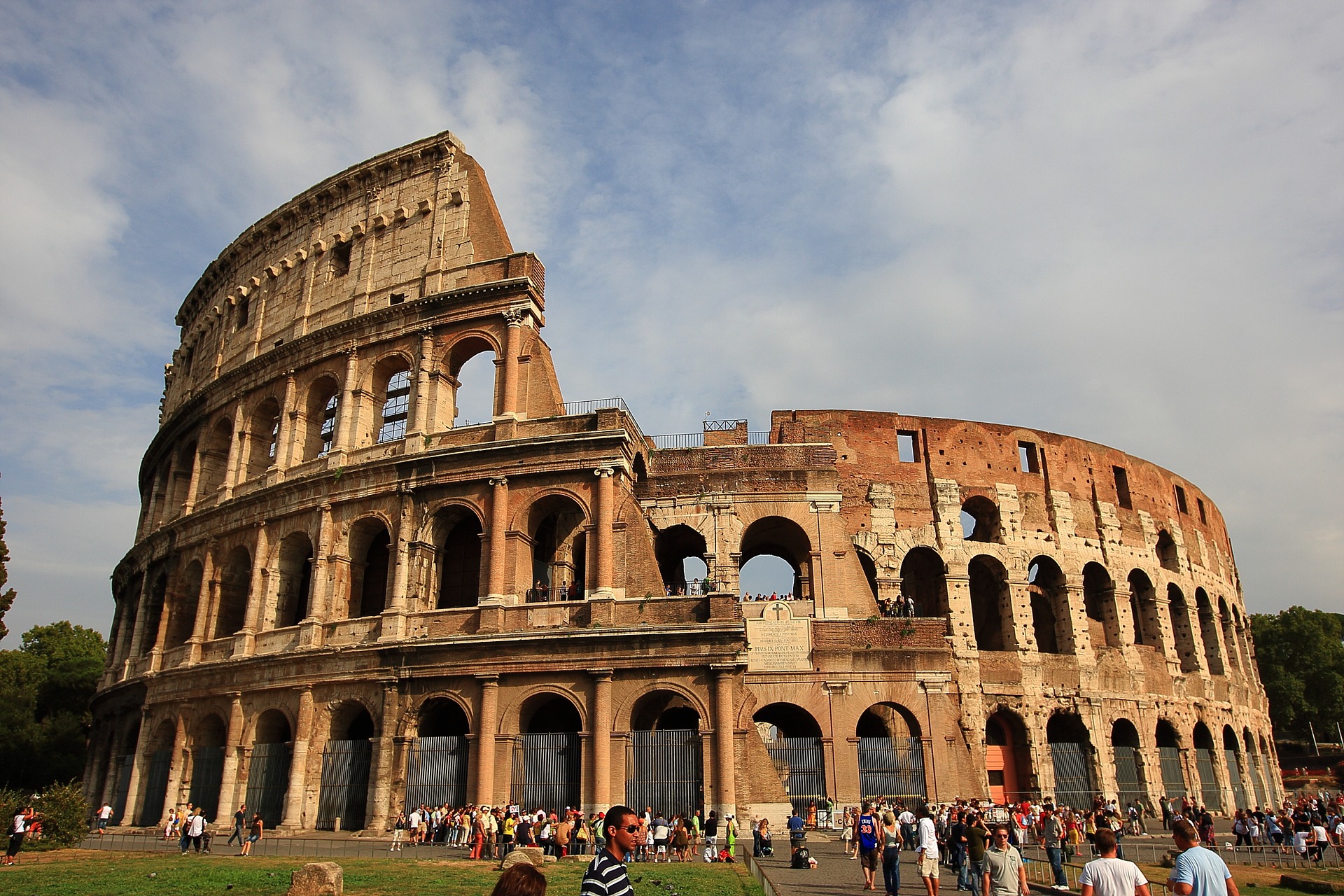
The New Seven Wonders of the World
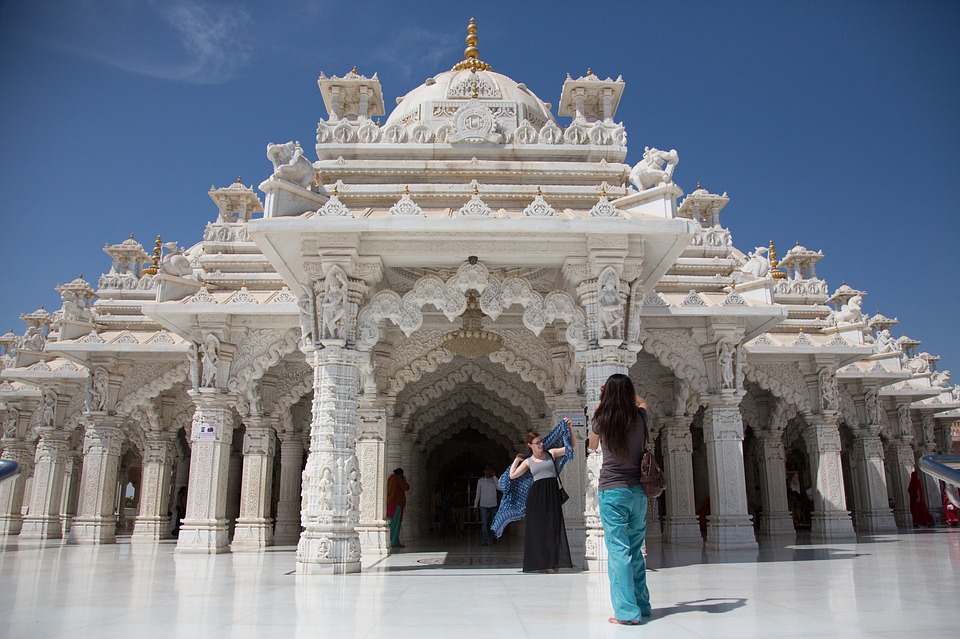
10 Famous Temples in South India for a Spiritual Journey

Top Sahara Desert Countries You Should Visit
Here’s Everything You Need To Know About Kedarkantha Trek
Nestled in the embrace of the Garhwal Himalayas in Uttarakhand , Kedarkantha Trek is a popular winter trekking destination. The trek leads to the summit of Kedarkantha Peak promising a mesmerizing journey through the beautiful winter landscapes of the Himalayas. From dense pine forests to frozen lakes, and vast snowscapes to panoramic mountain views, the trek offers it all. I am sure most of you have heard about this incredible trekking destination and may want to venture to this beautiful land of snow. We have prepared this guide to give you all the information regarding the Kedarkantha Trek so that you have a smooth and fulfilling adventure.
Location & Accessibility
%20(1).webp)
The Kedarkantha Peak is located in the Govind Pashu Vihar National Park in Uttarakhand. The Kedarkantha trek typically starts from Sankri, a picturesque village that serves as the gateway to this winter wonderland. Trekkers often find themselves captivated by the charm of this quaint village, which serves as a base camp for the adventure that lies ahead.
Sankri is accessible by well-connected roadways from Dehradun and Rishikesh. The easy accessibility of the Kedarkantha location ensures a smooth transition into the heart of the Himalayas.
The Height Of Kedarkantha Trek
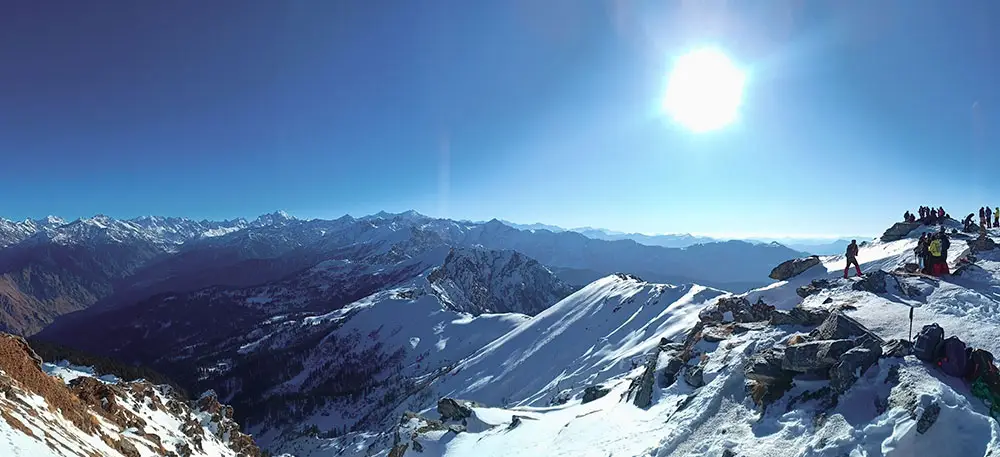
The Kedarkantha summit stands at an impressive elevation of 12,500 ft showcasing a gallery of Greater Himalayan Ranges.
Elevation of Sankri : 6,400 ft
Kedarkantha elevation : 12,500 ft
From the base camp to the summit, you gain an altitude of about 6,100 ft in a period of 3 days. The gradual ascent allows for acclimatization, ensuring that participants can savour every moment of the journey without compromising on their well-being.
Best time to do the Kedarkantha Trek
.webp)
For those who have been planning their Kedarkantha trekking adventure , winter is definitely the best time for Kedarkantha Trek.
The winter months, spanning from December to April, transform the region into a magical winter wonderland, Kedarkantha trek best time in our opinion. Trekking through the powdery snow, adventurers encounter frozen lakes, dense alpine forests, and a challenging yet rewarding journey. The chilly temperatures add an element of thrill, making it an ideal choice for those seeking a quintessential winter trek experience. For those looking for the thrills of a snow trek December to April is the best time to visit Kedarkantha.
How difficult is the Kedarkantha Trek?
.webp)
Kedarkantha Trek is an easy to moderate-grade trek. However, embarking on the Kedarkantha trek in December or other winter months presents enthusiasts with a unique blend of adventure and challenges. While the trek is renowned for its accessibility to a wide range of trekkers, the winter conditions add an extra layer of complexity.
Kedarkantha Trek is generally categorized as moderate, making it suitable for individuals with basic fitness levels and trekking experience. The well-marked trails and gradual ascents contribute to a trek that strikes a balance between thrill and manageability. While the Kedarkantha winter trek presents additional challenges with the snowy terrain, its moderate difficulty level and the support provided by experienced Trek Leaders make it an achievable and exhilarating winter adventure.
Who is this trek suitable for?
The Kedarkantha trek is suitable for a diverse range of trekkers, making it an inclusive and accessible adventure. Beginners, experienced trekkers, families, nature enthusiasts, and photography enthusiasts, all can join this trek with a moderate level of fitness.
Major highlights of the trek
.webp)
Unlike the itinerary of Kedrakantha Trek India hikes, we follow a different route to the Kedarkantha Trek and it offers the best views and surprises. Here are some key highlights from our Kedarkantha Trek route .
The Kedarkantha summit
The pinnacle of the trek, standing at an elevation of approximately 12,500 feet is the key highlight of the trek. Climbing to the Kedarkantha summit is truly a rewarding experience. The struggle to reach the top is worth it once you make it to the summit and the marvellous views of the Himalayas await you. You will literally feel like you are on top of the world and filled with a sense of accomplishment and inner peace. The astounding views will rejuvenate you after the strenuous journey. There’s also a small temple of Lord Shiva, Goddess Parvati, and Lord Ganesha at the summit.
The mountain panorama from the summit
At the summit, the trekkers are rewarded with a spectacular view of prominent peaks, including Swargarohini, Bandarpoonch, and Black Peak . The sunrise from the summit unveils a mesmerizing play of colours over the snow-clad peaks.
Juda Ka Talab Lake
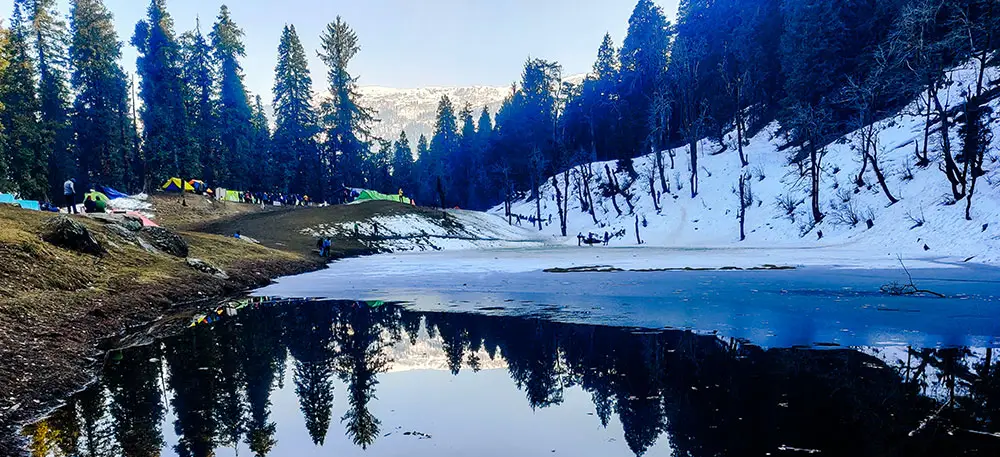
The Juda Ka Talab campsite is extremely scenic with an alpine lake on one side and a pine forest on the other, it almost feels surreal here. In the lap of mountains and the middle of pine and snow, the surreal beauty of Juda Ka Talab is simply otherworldly. During peak winters, a sheet of ice forms on the lake, creating a picture-perfect view. The lake also has a natural tunnel that provides water to the villagers nearby. The locals consider the lake as sacred and believe that Lord Shiva meditated at Kedarkantha and droplets falling from his hair formed the lake.
The amazing sunsets
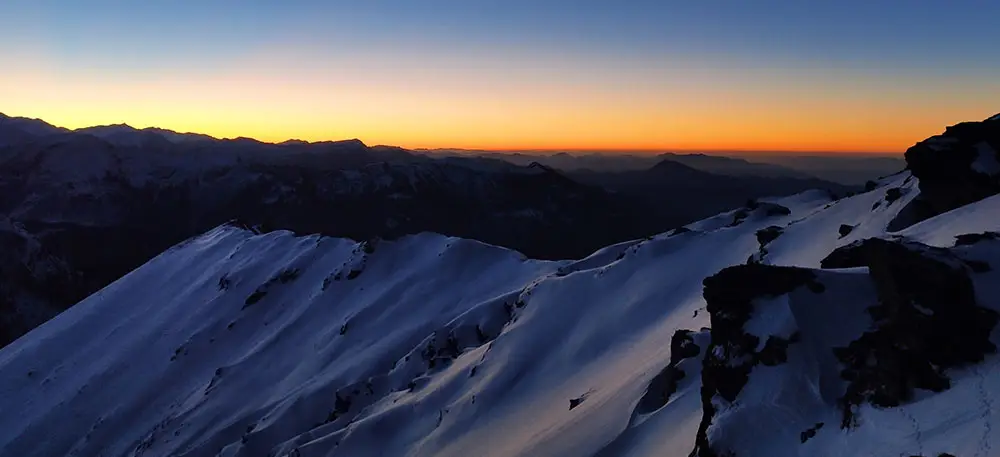
Sunsets from the Kedarkantha trek are quite unsurpassed and there are very few treks that offer such wonderful sunset views as Kedarkantha. Since Kedarkantha Peak is located in the western part of the Garhwal Himalayas, you can get an untarnished view of the setting sun in all its glory. The golden hour when the snow changes its colour from blue-white to that of molten gold is indeed a mesmerizing sight to behold.
The mesmerizing Pine and Oak forests
The Pine and Oak forest cover in Kedarkantha adds to the beauty of the trek and creates an aura of serenity. These are some of the most pristine alpine forests and being a forest cover at such a high altitude, they do not appear manicured but rather have a wild touch to them. In some places, the forest cover is pretty dense giving a very surreal feel to your climb. In winter the forests seem even more surreal with the snow covering the leaves and branches of the trees.
Is the Network Available on the Trek?
At Sankri BSNL network is available but it is very erratic. Past this point, you won’t get mobile connectivity on the trek. So it's recommended that you make all your important calls before starting the trek at Sankri. You may get a mobile network for short spans at certain points on the trek.
Is there Electricity on the trek?
Sankri is the last point where you will get electricity on the trek. We strongly recommend bringing extra batteries for cameras and power banks to keep your mobile devices charged. Also, note that power from your batteries will drain faster in cold conditions. So store them in bags and keep them inside your sleeping bag at night.
What is the Accommodation like on the trek?
As a part of our Kedarkantha Trek Package , we offer guesthouse accommodation in Sankri and throughout the trek, you will be staying in camps in different campsites. The camping is done on a twin-sharing basis for optimum comfort and convenience.
Can I Avail of Offloading Services?
Yes, you can avail of the offloading services for Kedarkantha Trek. The offloading charges are not included in the Kedarkantha Trek cost and you have to pay an additional charge for booking the offloading service.
Your offloading bag weight should not be more than 10 kg.
Is there a Cloakroom at the Base Camp?
At the Base Camp, you can store your luggage in our guesthouse which you can pick up at the end of your trek. Please make sure that you do not keep any valuable items in the bags that you leave behind.
What is the Nearest ATM Facility to the trek?
Mori is the last point on the route to Sankri which has an ATM. However, there may not be cash available at this ATM always. So to be safe, carry cash with you or withdraw cash at Dehradun.
Can I Rent Gear at the Base Camp?
.webp)
Sankri serves as the Base Camp for many Himalayan treks including Kedarkantha and as such you find some trekking gear and equipment at the Base Camp. However, to be on the safe side, you should buy or rent your gear in advance so that you do not miss out or get bad-quality gear for the trek. This can affect the quality of your trekking experience. If you want to rent your gear, we offer gear rental services at an additional cost along with the Kedarkantha Trek price .
Fitness Requirements For Kedarkantha Trek
.webp)
The Kedarkantha Trek, while accessible to trekkers with a range of experience levels, does require a reasonable level of physical fitness due to the varied terrain and altitude gain. Here are some fitness considerations for the Kedarkantha Trek :
Cardiovascular Endurance
The trek involves continuous walking, often at varying elevations. Building cardiovascular endurance through activities like jogging, cycling, or brisk walking helps prepare for sustained physical activity.
Leg Strength and Muscular Endurance
The trek includes ascending and descending trails, sometimes through snow. Strengthening leg muscles, especially quadriceps and calves, is beneficial. Activities like stair climbing and uphill walking can help.
Flexibility
Flexible muscles and joints contribute to agility on uneven terrains. Incorporate stretching exercises for the lower body, back, and shoulders into your routine.
Tips For the Best Trekking Experience
To get the best out of your Kedarkantha trekking , here are some useful tips:
⏩ Start a fitness routine well before the trek to build endurance, strength, and flexibility.
⏩ Prioritize essential items and pack them efficiently.
⏩ Dress in layers to regulate body temperature.
⏩ Invest in high-quality, comfortable trekking boots.
⏩ Carry an adequate supply of water and stay hydrated throughout the trek.
⏩ Check weather forecasts before the trek and pack accordingly.
⏩ Respect local customs and traditions.
⏩ Carry a basic first aid kit and know how to use it.
⏩ Be aware of common trekking ailments and their prevention.
Are you ready for a journey that transcends the ordinary? Join us on the breathtaking Kedarkantha Trek, an adventure that promises snow-laden landscapes, stunning mountain panoramas, and a soulful connection with nature.
Upcoming Treks
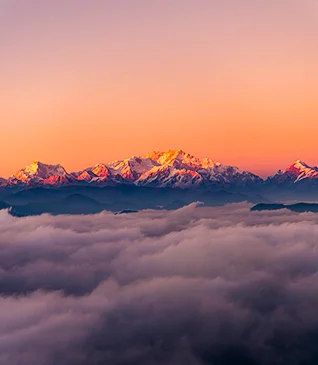
Sandakphu Trek
West Bengal
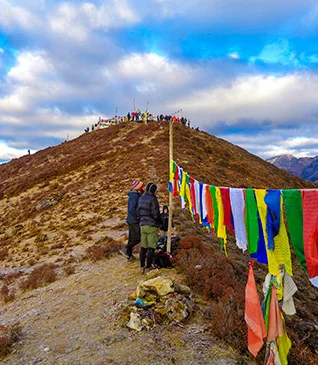
Goechala Trek
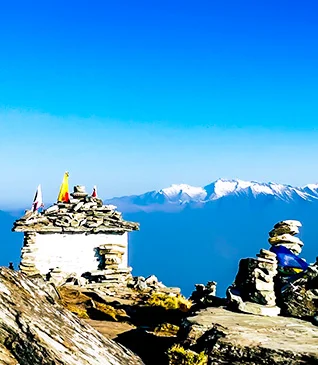
Chopta Chandrashila Tungnath Trek with Deoriatal
Uttarakhand
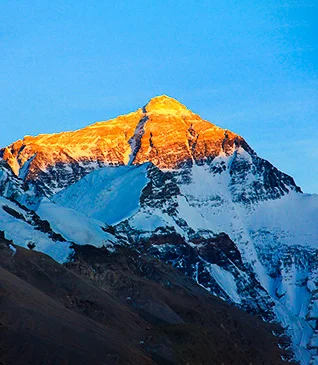
Everest Base Camp Trek
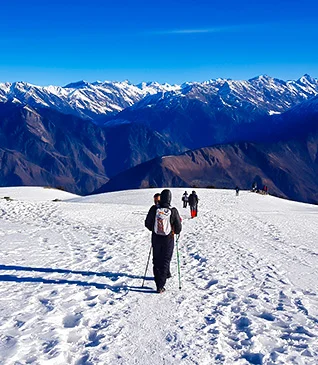
Kedarkantha Trek
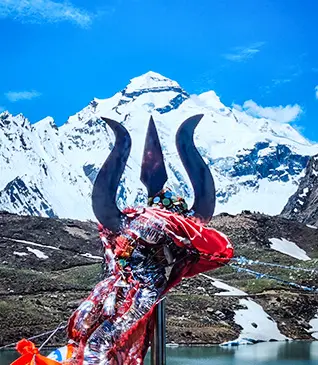
Adi Kailash and Om Parvat
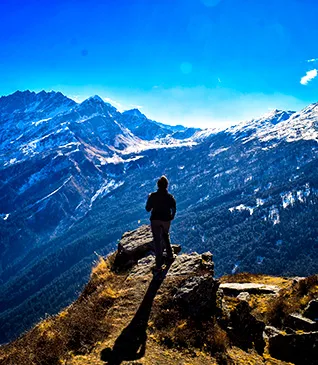
Winter Kuari Pass Trek
.webp)
Gaumukh Tapovan Trek
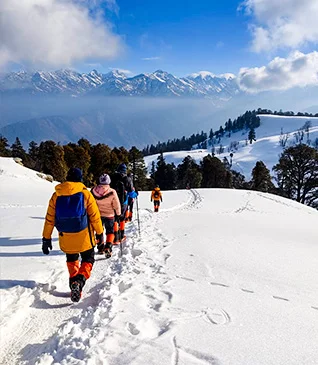
Brahmatal Trek
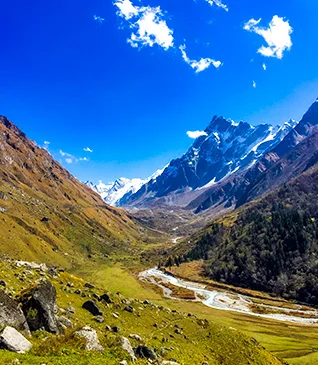
Har Ki Doon Trek
.webp)
Annapurna Base Camp Trek
.webp)
Ranthan Kharak Trek
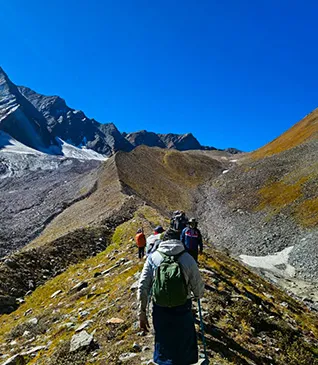
Bali Pass Trek
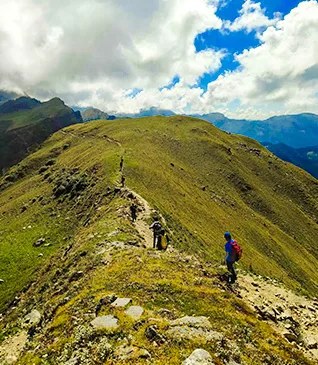
Phulara Ridge Trek
.webp)
Rupin Pass Trek
Himachal Pradesh
.webp)
Ali Bedni Bugyal Trek
.webp)
Dayara Bugyal Trek
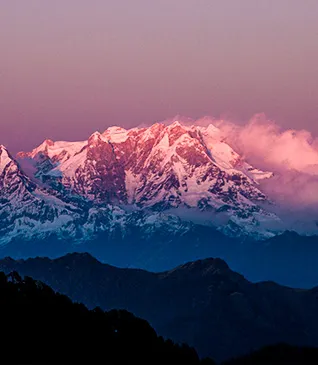
Panwali Kantha Trek
Recent articles.
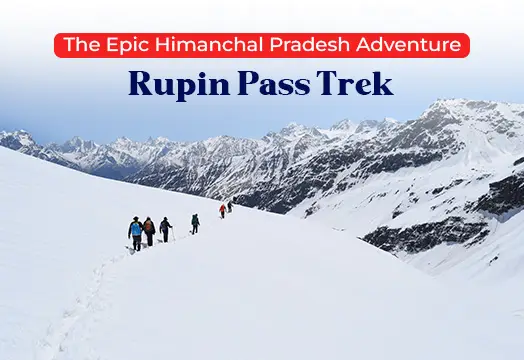
Rupin Pass Trek - The Epic Himachal Pradesh Adventure

Adventure Travel in India- Trek the Himalayas

Kuari Pass Trek - Winter Adventure for Beginners

Trekking in Himachal Pradesh - Buran Ghati Pass

Stargazing on Treks: A Celestial Experience Amidst Majestic Peaks

Blooming Love Story in the Valley Of Flowers

Har Ki Dun Trek - Best Trek for Beginners in Uttarakhand

Uttarakhand trekking Places to Visit in 2024

Best Adventure Company in India in 2024 - Trek The Himalayas

Winter Treks : Explore the Snowy Trails with Trek The Himalayas

Rent A Gear
Trek Articles
Quick Links
Trekking & Hiking
Mountaineering
Multi Sports
Himalayan Pilgrimage
Website Privacy
Terms & Condition
Contact Info
Address: Trek The Himalayas 7/2/1, Convent road, Near SBI Main Branch Dehradun-248001,Uttarakhand
Phone: 8191004846 (Monday-Saturday 10 AM to 10 PM)
Email: [email protected]
2024 Trek The Himalayas. All rights reserved

Kedarnath Yatra 2024 | Complete Guide, Cost, Itinerary
Region: Uttarakhand
Base Camp: Gaurikund
Days: 4 Days
Grade: Moderate
Distance: 32 Km
Min Age: 8 Years+
Best Season: Summer and Autumn
Trek Description
Kedarnath located in Rudraprayag district of Uttarakhand is one of the 12 Jyotirlingas and one of the important Panch Kedar. At Kedarnath, the Hump of Lord Shiva is worshipped and other parts of Lord Shiva are worshipped in the other Panch Kedars.
Kedarnath holds religious and historical significance dating back thousands of years. It’s believed that Adi Guru Shankaracharya rediscovered the Kedarnath temple after it was buried under snow for centuries.
The journey to Kedarnath starts from Rishikesh. A typical itinerary is 3 nights and 4 days long which takes you to places such as Rishikesh , Guptakashi , Gaurikund , and Kedarnath .
The Kedarnath Temple is scheduled to open on May 12, 2024 , this year. The best time to do this trek is May, June, September, and October. Prior to your yatra, you will need to register yourself on the Char Dhaam portal.
The overall trek distance from Gaurikund to Kedarnath is around 16 km so the total distance is approximately 32 km. You may feel the trek distance to be more than 16 km. This is due to the altitude gain of 5,072 feet, requiring greater endurance.
Drive Distance : 185 km
Drive Time : 7-8 hours
Altitude : 4,530 ft
Our journey will start from Rishikesh early morning. The overall driving distance is 163 km and usually takes around 7-8 hours to complete, but it can take more time due to traffic in the peak season.
During our journey, we will follow along the river Ganga until Devprayag , then continue alongside the Alaknanda River , and finally drive alongside the Mandakini River in the last stretch.
Along the way, we will visit Dhari Devi Temple and the confluence points known as prayags, including Devprayag, Rudraprayag, Agastmuni, and Guptkashi.
Overnight stay will be in Guptkashi.
Trek Distance : 16 km
Trek Time : 7-8 hours
Altitude : 6,558 ft
Altitude Gain : 5,072 ft
Next morning drive from Guptkashi to Sonprayag . Driving distance is 30 km and will take 1-2 hours to complete. Once we reach Sonprayag, we will take a local taxi to Gaurikund, which is around 6 km away.
From Gaurikund the trek will start. The overall distance from Gaurikund to Kedarnath is around 16 km. Yatra path is well paved with stones and railing. Altitude gain is 5,072 feet which can lead to AMS (Acute Mountain Sickness). Make sure to ascend slowly, keep enough water with you and snacks.
Along the trail, you will walk with other pilgrims and sadhus. There will be constant movement of mules on the trail. Make sure to give them the side and keep your distance.
By evening we will reach Kedarnath. Check into your accommodation, rest a bit and get ready to join the evening Arti.
Trek Time : 5-6 hours
Wake up early in the morning and get in the line to have Darshan. During peak season it can take hours before you get a chance for Darshan. After darshan, explore places like Kaal Bhairav Temple , Mandakni Ghat , Bhim Shilla , and Adi Shankaracharya S tatue.
Kedarnath Valley is surrounded by beautiful peaks, flora and fauna. Just behind Kedarnath, you will see Kedar Dome , Kedarnath Main , Chorabari Glacier, and Kedarnath Glacier . Near Kaal Bhairav Temple you will find meadows filled with wild flowers, particularly Bhringraj .
Soak in all the peace and spiritual aura of the valley. After your wonderful time, get ready to descend down. Make sure to keep enough water and snacks with you.
By evening we will be back to Gaurikund. Via local taxi, we will go to Sonprayag from Gaurikund and from there to Guptkashi. The night stay will be in Guptkashi.
Today, it’s time to return to Rishikesh. Our journey will take us back from the same route we came. By evening we will be back to Rishikesh and from there you can continue your journey and return home.
What’s Included?
Price inclusion.
- Transportation from Rishikesh and back to Rishikesh
- Stay on a triple, quad, or dormitory sharing basis
- Chardhaam registration and required permits
Price Exclusion
- Meals during the transportation
- 5% GST is not included
- Any items not mentioned in the inclusion
- Any expenses arising from emergencies during the trek
- Any personal expenses
Things to Carry
- 40-50 Ltr Bag Pack With Rain Cover & Comfortable Straps
- Hot & Cold Water Bottle Like Borosil & Milton
- Energy Bar, Dry Fruits & ORS
- Personal Medical Kit
- 2/3 Full Sleeves (Non-Cotton)
- 1 Full Fleece T-Shirt
- 1 Fleece Jacket (Woollen Or Sweater)
- 1 Down Feather/Hollofil Jacket
- 1 Waterproof Jacket/Poncho
- 1 Pair Thermal Inners (Upper And Lower)
- 2 Trek Pants (Avoid Shorts & Denim Pants)
- 1 Pair of Waterproof Gloves
- 1 Pair of Woollen Gloves
- Woollen Cap
- 4 Pairs Of Cotton Socks
- 1 Pair Of Woollen Socks
- 1 Pairs Of Sunglasses (U/V Protected)
- 1 Neck Gaiters (Buff)
- 1 Waterproof & High Ankle Trekking Shoes
- 1 Pair Of Floaters
- Hand Sanitizer & Sunscreen Lotion
- Toothbrush And Toothpaste
- Quick Dry Towel
- Lip Balm & Antibacterial Powder
- Moisturizer
How To Reach Kedarnath
Flight is the quickest and easiest means to reach Rishikesh in Uttarakhand. Booking a flight to this destination is not a hard job, you can get a flight from most metro cities in India.
The nearest airport to Rishikesh is Jolly Grant Airport which is located approximately 25 kilometers from the city center. Several flight operators like Air India, Akasa Air, Vistara, and others operate flights to Jolly Grant Airport, which makes your transportation easy and comfortable.
It is recommended to book a flight at least a month before traveling since the last moment flight booking is comparatively higher than the standard price. If Dehardun flight charges are high then we recommend you take flights to Delhi. From there, you can take UTC, HRTC, buses, railway or hire a taxi to reach Rishikesh.
Rishikesh is one of the major cities in Uttarakhand and it is well-connected to other cities by train. So traveling here via train is another easiest way.
Your train transportation is served by the Yog Nagri Railway Station. You also can opt for Haridwar Railway Station and from there you can reach Rishikesh via bus or taxi.
A road trip is one of the most exciting journeys to reach Rishikesh and start the Dayara Bugyal Trek. It should not be any challenging matter since the city is connected with other major cities like Delhi, Chandigarh, and Jaipur by National Highways.
It might be time-consuming but bus travel is affordable compared to another mode of transport.
Kedarnath is well connected with the road to Sonprayag. During peak seasons you will find multiple private buses from Rishikesh, Haridwar, and Dehradun to Guptkashi or Sonprayag. Bus tickets range from INR 500-600. These are small buses and don’t have much leg space. Pack your bag in a way that you can sit comfortably.
Taxis are also available from Dehradun, Rishikesh, and Hardwar. The cost will depend on total number of seats sold.
Raithal is the point where we start our Dayara Bugyal Trek in Uttarakhand. It is approximately 183 kilometers away from Dehradun, which takes around 6 to 7 hours by public transportation. To reach Raithal you have to reach Uttarkashi first.
The bus to Uttarkashi leaves early in the morning around 5:30 am from Dehradun Hill station. You can also book your ticket online via the UTC portal. The average cost of the ticket is around 350 to 400 INR. Shared taxi option is also available.
If you are traveling via taxi, you will be charged around 400 to 500. You can hire a taxi from Rispana Pul and Parade Ground to Uttarkashi. Upon reaching Uttarkashi, you can rent another taxi to Raithal from Uttarkashi Taxi Stand. You must pay 100 to 150 INR to hire the taxi.
Difficulty Level of Kedarnath
Kedarnath Yatra is in the moderate category. Trek distance and altitude gain make it a bit difficult. The overall trek distance is 16 km from Gaurikund to Kedarnath with an altitude gain of 5,072 feet. Sudden altitude gain of this elevation poses a risk of AMS and Fatigue. Make sure you drink plenty of water, have enough snacks, and are in the best shape.
Physical fitness and endurance are much needed on this Yatra. Before planning your Yatra, train your body in the gym or via running and jogging.
It’s even better if you have done some high-altitude trek before.
Best Time to do Kedarnath
The best time for Kedarnath Yatra is in months of May, June, September, and October. During May and June, the weather is favorable with less rain and not-so-cold temperatures. But it’s also this time when you will find lot of crowd and rush.
If you prefer less crowded and peaceful times then the months of September and October are much suited. But also keep cold temperatures in mind in these months. If you are found with cold temperatures then you can consider Autumn months.
Off Season : Off season in Kedarnath is considered months of monsoon, i.e. End week of June to the First week of September. But these months are also dangerous due to heavy rain, landslides, cloud bursts, and flash floods.
More Info Regarding Kedarnath
After the events of the Mahabharata, Pandavas were in remorse. Their participation in the war led to the deaths of their kin, teachers, and countless others. Their sins hindered their path to Moksha.
Pandavas actions during the Mahabharata, including the use of deceitful tactics on the battlefield did not find favor with Lord Shiva, who is the protector of righteousness. Hence they were in pursuit of Lord Shiva to guide them and free them from their sins.
During their Yatra in the Himalayas, they reached a beautiful valley where they felt the presence of Shiva. Among the heard, Lord Shiva was in the form of a Bull. Bhim tried to approach the Bull but as soon as they touched, Lord Shiva disappeared into the earth.
Later parts of the Bull appeared in different parts of the Himalayas and became known as Panch Kedar.
Kedarnath Valley is blessed with natural resources. As soon as you start your trek you get to see hundreds of wildflowers, water springs, and natural beauty.
You will come across flowers like Himalayan Balsam, Brahma Kamal, Juniper, Cyananthus Lobatus, Anaphalis Margaritacea, and The Himalayan Bistort.
Kedarnath Valley and Kedarnath Wildlife Sanctuary is home to Black bear, Ibex, Monal, and Leopard. The constant movement of humans in and around the valley makes it hard for these animals to show themselves.
- Triyuginarayan Temple
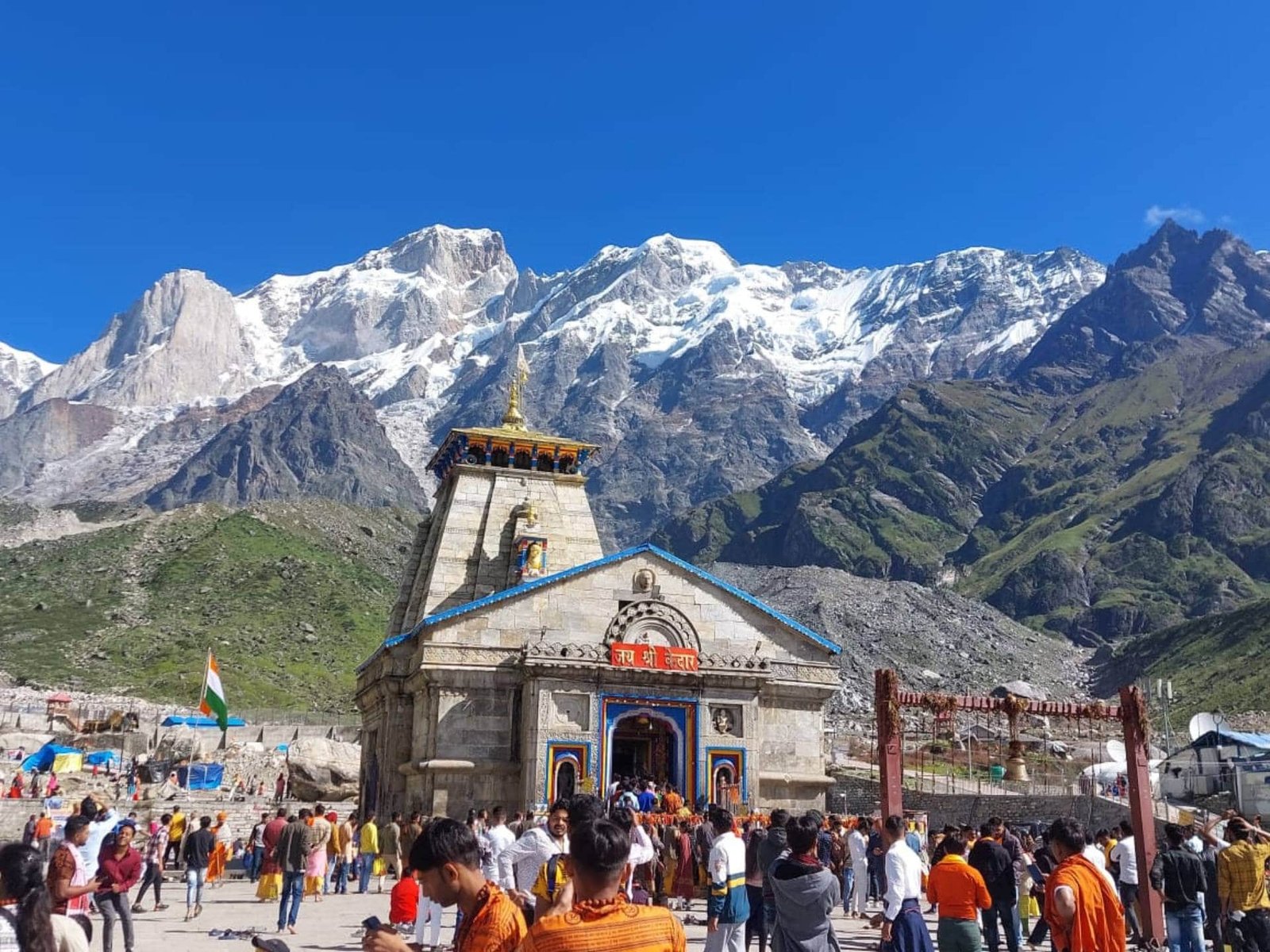
Map of Trail
Kedarnath temple was built by Jagad Guru Adi Shankaracharya.
Kedarnath temple is said to be more than 1,200 years old.
The two peaks visible from the Kedarnath valley are Kedar Peak and Kedar Dome.
The sacred river that flows through Kedarnath is Mandakini.
/ Per Person
Cancellation Policy
Available Dates
Contact us for Booking
Similar Treks

Kuari Pass Trek

Gidara Bugyal Trek
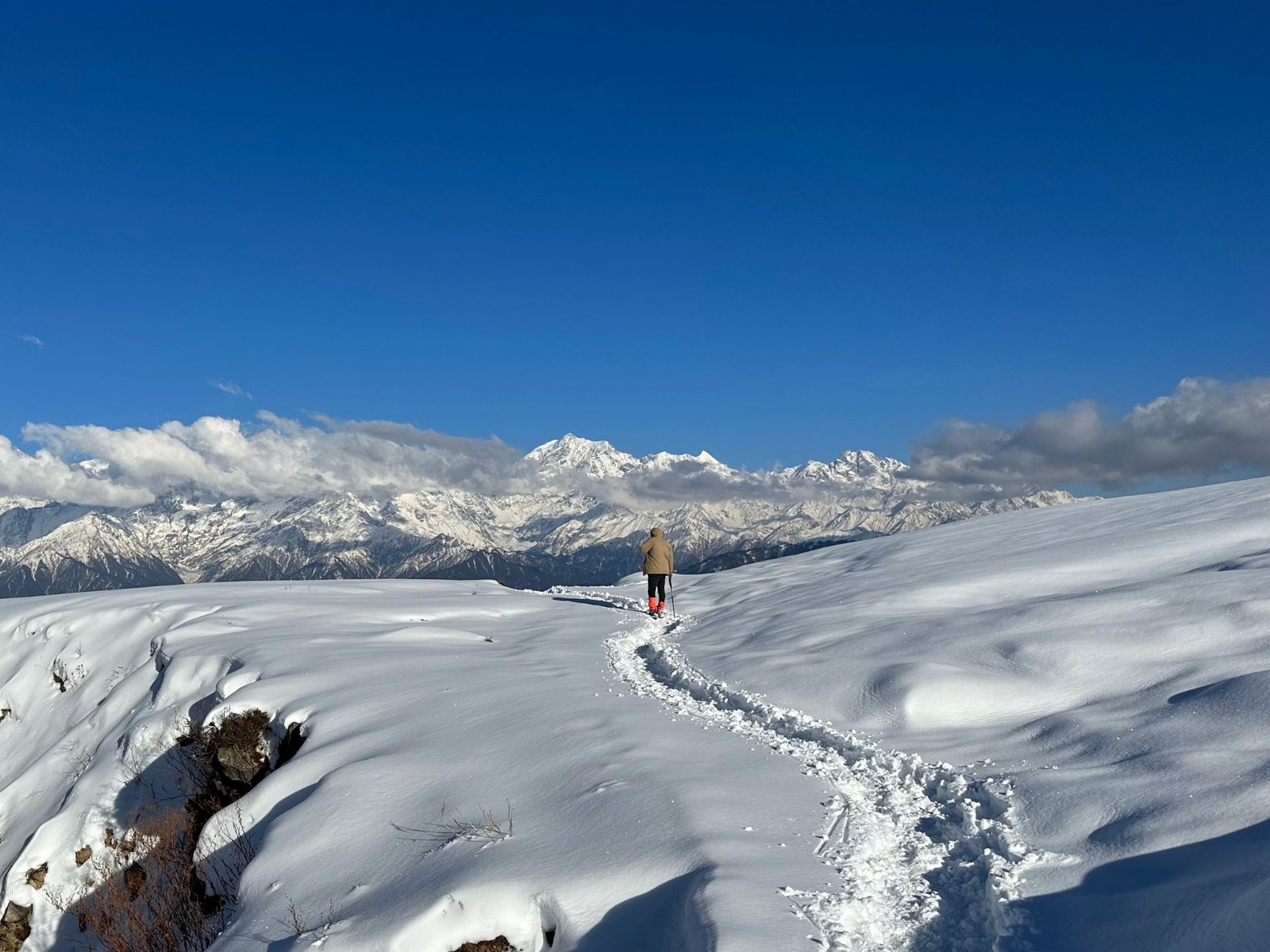
Dayara Bugyal Trek
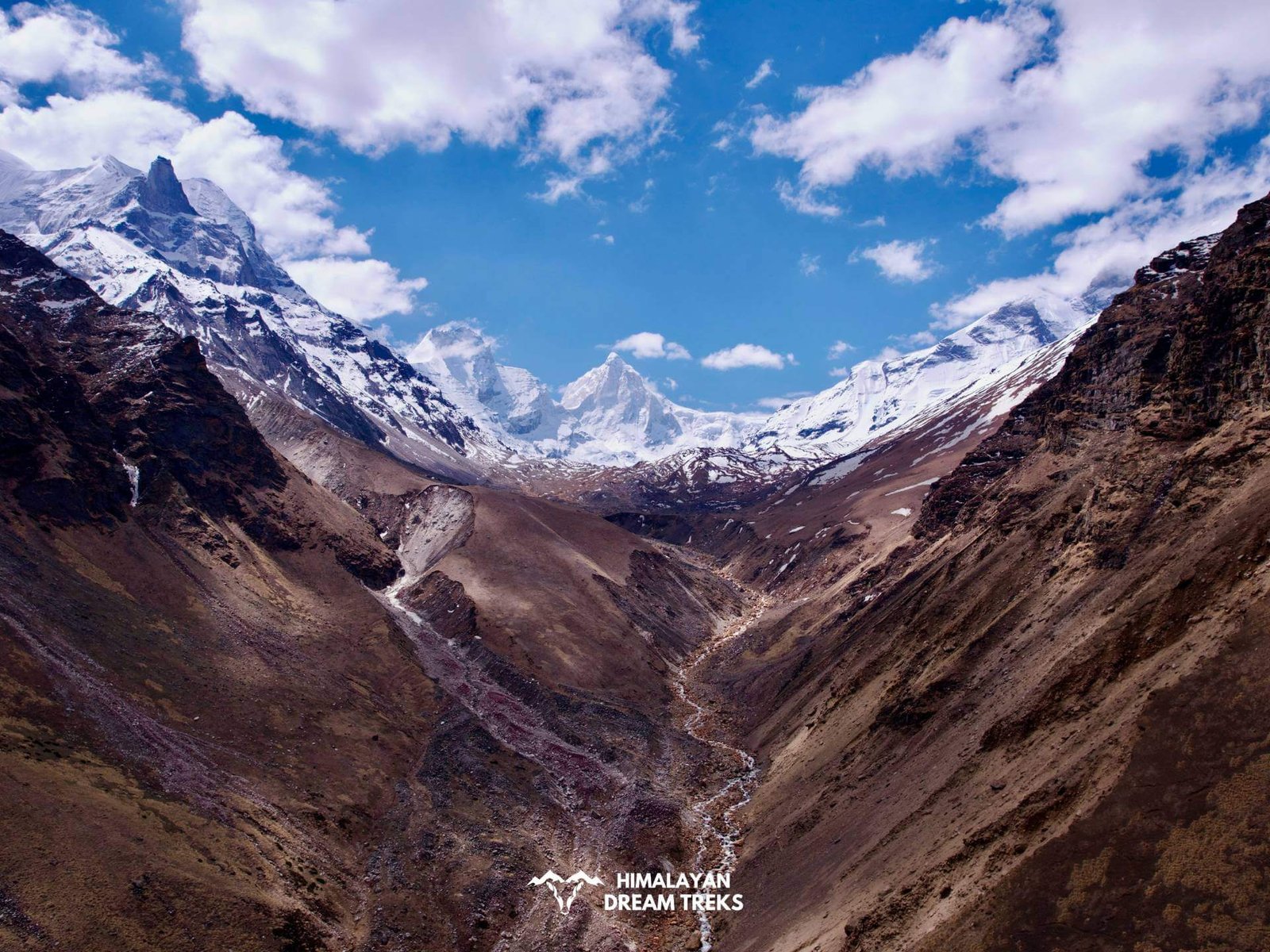
Kedartal Trek
Leave a comment cancel reply.
Email me when someone replies to my comment
Save my name, email, and website in this browser for the next time I comment.
Terms & Conditions
Contact us at 8089693825
Subscribe to our newsletter
Get news and discounts straight to your inbox
We are Associated With

Himalayan Dream Treks
We believe in making the Himalayas more than just a destination; we see them as a life changing experience. Whether you seek spiritual enlightenment, have a passion for trekking, or simply crave adventure, we're here to accompany you on your journey.
Important Links
Why Choose Us?
Advance Payment
Cancellation Policy & Refund
Privacy Policy
Terms & Condition
Career At HDT
Contact Details
+91-80896 93825
+91-94565 46051
Join Our WhatsApp Group
Office Address
Dehradun Office :
10 B, Mothorowala Rd, Dharampur, Ajabpur Kalan, Dehradun, India, Uttarakhand, 248121
© All Rights Reserved 2024 Himalayan Dream Treks
(To the Himalayas and Beyond) — Designed & Developed by DeveloSquad

- Group Tours Calendar
- Planning, Sightseeing & Routes
- Preparing for Ladakh Trip
- Stay, Eat, Permits & Others
- Taxis, Self-Drives & Bike Rentals
- Public Transport & Budget Travel
- Preparing for Spiti Valley Trip

Kedarkantha Trek – A Comprehensive Backpacking Guide for Trekkers
Kedarkantha trek is in one of the most significant religious areas, especially in the Hindu Mythology. The Temple of Lord Kedarkantha (Shivji), which sits at the base of the summit, has stood the test of time and is revered amongst spiritual believers. Millions of pilgrims move mountains to offer their prayers and seek blessings of the Hindu Deity each year.
The temple itself lies at the base of the Kedarnath Peak, facing the Kedar Parvat. A beginner level trek , Kedarkantha is especially beautiful in the winter months. One of the most remarkable crests in the Himalayan region, both nature lovers and ardent trekkers tend to enjoy the experience.
Let's quickly dive into the details:
History of Kedarkantha
In general, Uttarakhand is splattered with great religious sights . Lord Shiv’s Bull avatar wandered in the region. He attained the form to escape from the Pandavas and meditated in the valley in his disguise. But, once his peace was disturbed due to the locals, he fled from Kedarkantha to Kedarnath.
Also, local hearsay says that the Trishul of the Lord, erected in the valley, keeps the place safe from destruction. There was ample proof in their belief in 2013 when the valley suffered great losses due to the massive floods in the region, but the Kedarnath temple was not harmed .
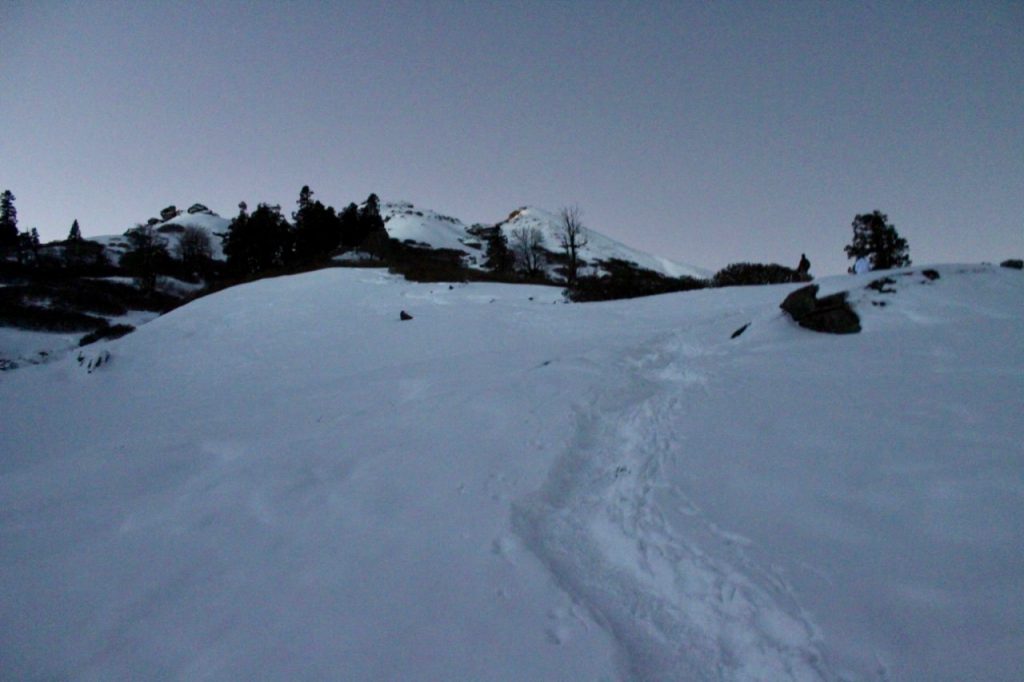
About the Kedarkantha Trek
This is one of those treks where you can climb the summit in the harsh winters. It’s a four-day beginner trek in Uttarakhand , which takes you to the frozen Juda ka Talab and the snow-clad paths. The magical sunrise from the 12500 ft Kedarkantha summit seems like heaven. You can also get the views of various peaks like Pangarchulla and Har Ki Dun from the summit.
The need to connect with your greater purpose and the belief in faith is such a connecting factor that even if you’re not a Hindu, you can feel the faith all around you. It sets the mood for when you start your climb.
The forested floors of the massive mountain peaks, with meadows of Pine Trees and possible snow kissing the hills, makes for a stunning backdrop to your communal journey. Also, right after the base camp, you’ll start witnessing stunning panoramic views all round of famous mountain summits along with the river Tons, which is fed by glaciers.
Kedarkantha Height / Altitude
Kedarkantha is an altitude of 3800 meters in height and offers a 360-degree view of Pangarchulla, Har ki Doon and Swargarohini peaks of the high Himalayas.
Best time to visit Kedarkantha trek
Although Kedarknatha trek can be done at any time of the year, it’s preferred in the winters from January to March as the trek is covered in the blanket of snow and offer some stunning snow-packed views.
It is one of those treks in India where you can easily find snowfall near Delhi in winter . Also, the trek has the most gorgeous campsites. Hence, do not forget to take your own camping gear and camp in the wild on this trek.
In the summer months of April – June, the temperature varies from 3°C to 8°C in daytime and -5°C to -1°C at night. Post monsoon season of September to December witnesses’ temperature of -4°C to 6°C in daytime and -8°C to -15°C at night. For January till April, the weather is -6°C to 2°C in daytime and -10°C to -18°C at night
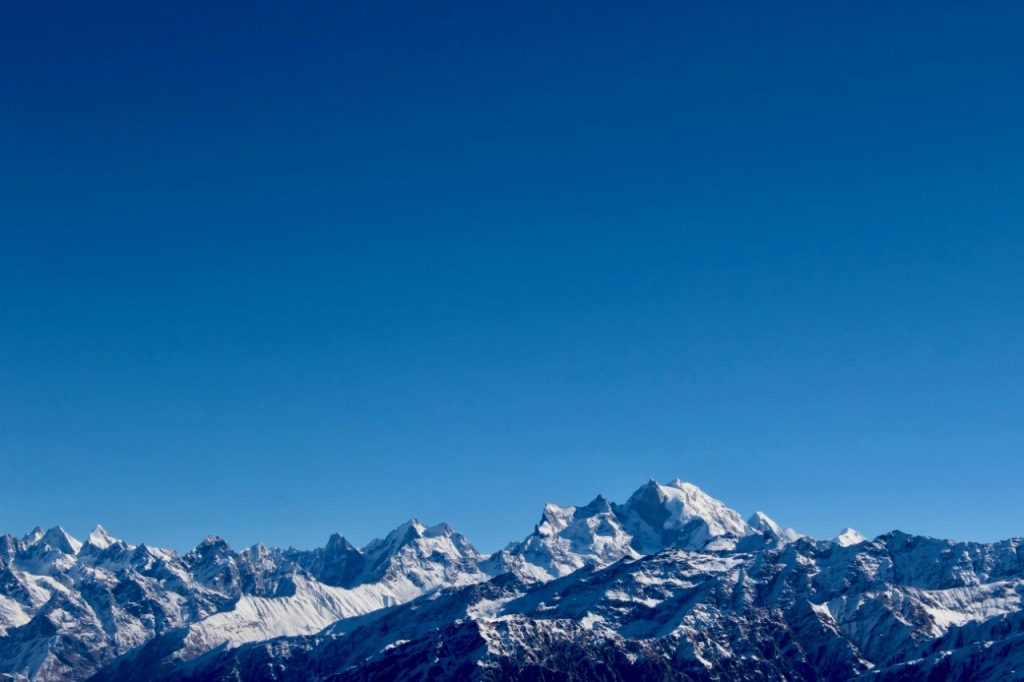
The Beginning Point – Sankri Village
You’ll have to first reach Dehradun from Delhi either by bus, train, flight, or personal transport. After that, you head to Sankri – from where the trek begins. The overall distance of the trek from Sankri to Kedarkantha peak is approximately 25 Kms, covered in a total of 4-5 days along with Juda Ka Talab.
Delhi to Sankri by road
Sankri is a small village 200 km away from Dehradun where trekking for Kedarkantha, Har Ki Dun Trek, and Rupin Pass starts. The route from Dehradun to Sankri is Dehradun – Purola – Mori – Naitwar – Sankri. The journey takes approximately 7 hours by road.
The drive is a very scenic route. Sankri village itself is steeped in natural beauty and a night stay here is a requisite. Enjoy the small hamlet!
By Public Transport
Of course, you might want to take public transport to begin your trek – for the same, there are multiple options to reach your starting point.
Dheeraj Sharma
Two buses run directly from Dehradun to Sankri, one at 5 AM and one at 8 AM from the Mussoorie Bus stands in Dehradun. Bus fare is around Rs 300/- and takes around 10 hours to reach Sankri from Dehradun. Buses run from the Mussoorie Bus Stand, which is 4 km away from ISBT and a half km away from the railway station. Dehradun is well connected with Delhi by buses anyways.
The Nearest airport is Dehradun from Sankri and then you can book a private cab or follow the bus options as mentioned in this article.

A cab costs around Rs 5500/- and can accommodate four to five people. You can book a cab from Dehradun.
You can take a direct train from Delhi to Dehradun in the night and then catch a bus to Sankri in the morning. The best option is to take Nanda Devi AC Express which leaves at 11:50 PM and reaches at 5:40 AM in Dehradun.
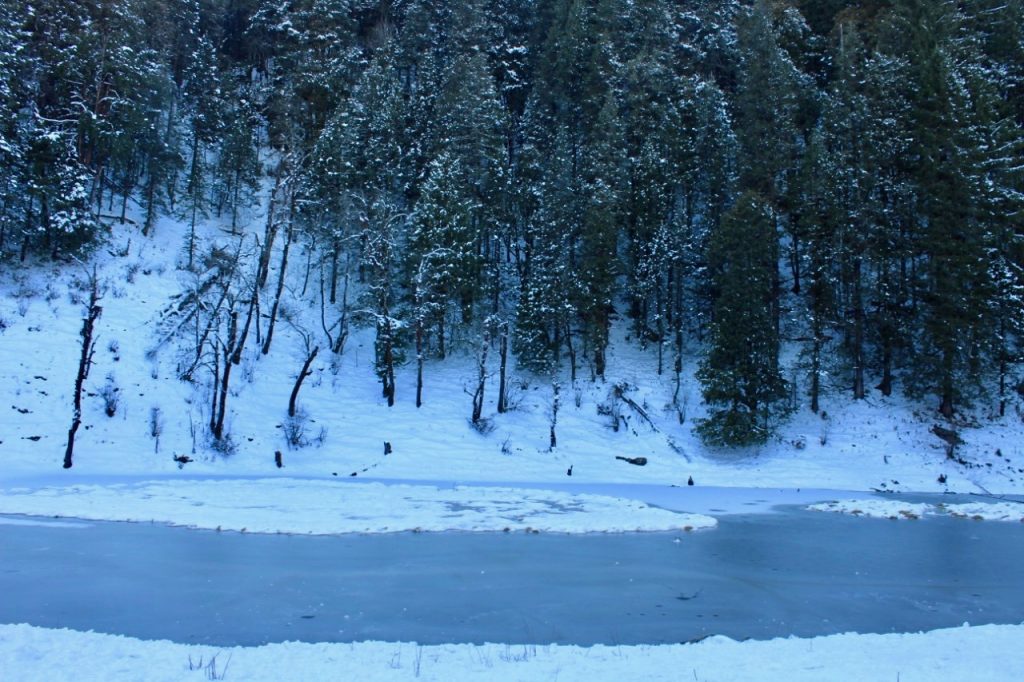
Suggested Itinerary for the Kedarkantha Trek
The best way to experience a trek is with a plan that has some room for movement. The Kedarkantha Trek ideally takes around 4-5 days and encompasses some of the greatest views and the most magnificent campsites along the way.
On most days you won’t be trekking longer than 4-5 hours, giving you ample time to relax and enjoy the beauty along with bonding with your friends. Of course, I would strongly recommend getting a guide for easing your planning requirement.
If you’re not traveling through a package tour – you might also need to carry your own camping gear . However, the Kedarkantha Trek is fairly doable, and beginner-friendly. So, dear trekkers, don’t fret and take one step forward!
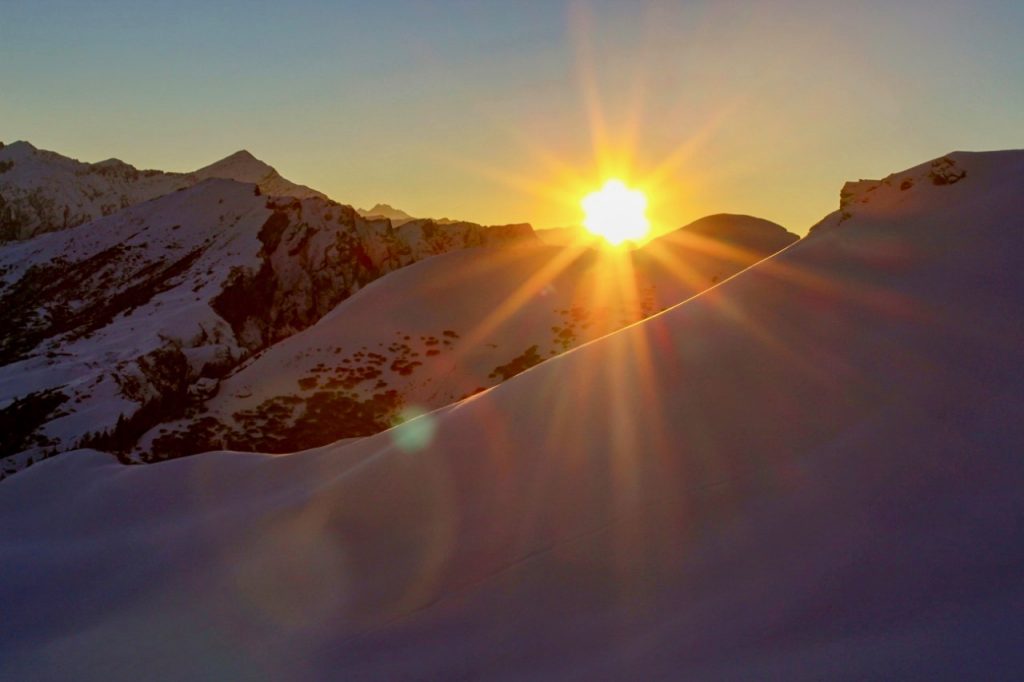
DAY 0 – Starting off
Take an overnight bus from Delhi to Dehradun in the night and reach Dehradun as early as you can in the morning. You can choose to spend some time exploring Dehradun – but honestly, there is so much awaiting you that it is best to push for Sankri. Try reaching before sunrise (taking into consideration your pitstops and leisure time in between). A must is to have your lunch/snack break in Mussourie . The views are insanely green and purely perfect.
DAY 1 – Reaching Sankri
Take the first bus/ drive over to Sankri, which will take around ten hours to reach. If you miss the first bus, then you can take a bus to Purola or Mori whichever is available and then take shared cabs to reach Sankri. There is a forest permit that is needed before you enter Sankri. You’ll have to fill up the details and have a photocopy of your ID. After reaching Sankri, get a room or find a whole package for the trek as per your choice.
You should also check the Trek to Gaumukh – A Step by Step Guide
Day 2 – Sankri to Juda ka Talab
The first campsite is Juda ka Talab which is around 4 Km from Sankri. The starting point of the trek is local Sankri road, through an extension called Sor and then entering into the local trails. This path is the road leading up towards Kedarkantha. Initially, the climb will test you by making you climb multiple bridges through a densely forested area.
From the sharp contrast of your city life, this view will be guaranteed to have you mesmerized. The trail is a little steep at certain points before ultimately entering into the dense forests of Himalayas. A common sight, especially in the remote villages along the way, is of local folks carrying wood & dry leaves on cattle for domestic usage.
Juda ka Talab is based at an altitude of 9100 ft, and the total time it would take you to achieve this milestone is ~4 hours. Around here, you will also sport Langoors swinging about in the trees. They often like to keep to themselves and might vanish before you register their presence. While winter will have a deeply majestic brown & snow around the region, summer months will witness lush greenery and hilly flowers unique to the region.
There are two tea shops between the trek where you can have breakfast. Juda ka Talab campsite is frozen in the winters and gives some astounding views. It takes around 3 hours for a fit person to complete this part of the trek.
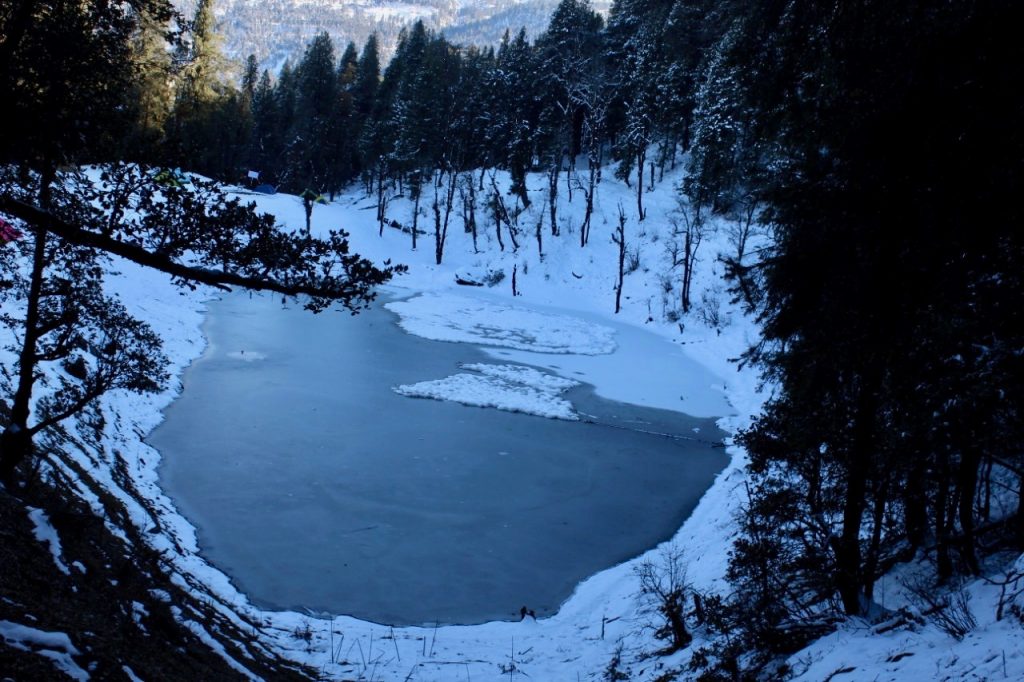
Day 3 – Juda ka Talab to Kedarkantha Base camp
Kedarkantha base camp is also four km away from Juda ka Talab and takes roughly around 3-5 hours to trek, depending upon your fitness and skill. The trek starts from pine and oak trees and then enters into the open mountains. The trail is wide and visible, making for great sightseeing and daydreaming (Can you daydream about what you’re currently experiencing?).
At some points, you will cross some deeply dense forests and steep ridges. With views of shepherd huts in stretched out meadows, and now becoming a common fixture of the views, you make your way towards the base camp. Views include Bandarpoonch, Swargarohini , Kala Nag, and Ranglana – be prepared to be mesmerized.
Kedarkantha peak is visible from the base camp. Kedarkantha base camp is at the height of 11,250 ft in open highlands. This campsite is the finest in the region and gives picturesque views of Dhaulandhar ranges. Since you’ve gained considerable elevation in your three days, it is important to rest and acclimatize yourself as the next day is the summit day.
You should also check the Tungnath – Chandrashilla Trek – A Step by Step Guide

Also, it is mandatory to stargaze – the sky to crystal, the night will enchant you no bounds. However, remain cozy and bundled up throughout and spend the night INSIDE your tents to ensure fully-swinging health.
Day 4 – Kedarkantha Base to Summit; back to Hargaon campsite
So, today’s the day – let’s conquer come mountain peaks, you all! You’ll be climbing from 11250 Ft to 12500 Ft today while reaching back to 8900 Ft at Hargaon Campsite. Since it’s a long day today, as you’ll have to make it to the summit and then back to the Hargaon campsite, you must start your day EARLY (some might argue it is not even the next day. But, oh well, such is the life of a traveler – next day begins when you wake up). Overall the journey is 6 km and should be covered in 7-8 hours.
The trek starts with the gradual ascent, which offers some magnificent views of the snow-covered mountains. You’ll have to cross three hillocks to reach to the peak, and the trek becomes around 75-80 steep at some points. This part of the journey is relatively easier in comparison to the previous days. However, near the end of your climb, you will find the trail becoming more challenging.

N ormally, in the winters sunrise takes place at 7 AM in the morning. Start early as can in the morning around 3 AM so that you can reach in time to witness the most beautiful sunrise of your life.
At the TOP of Kedarkantha!
Kedarkantha summit offers 360-degree arresting views of Himalayan ranges mixed with white and dark blue clouds. There is a small temple dedicated to Shivji and Goddess Parvati, with a small shrine for Lord Ganesh. Take your time, relax, and soak in the free views to your heart’s content – it is hard to describe in words the sights only your heart can capture.
You should also check the Trek to Deoriatal – A Step by Step Guide
After watching the sunrise and spending some time at the summit, get back to the Kedarkantha base camp and then trek down to the Hargaon campsite. It takes around 1:30 to 2 hours for a normal person to reach from base camp to Hargaon. The trek is further amplified thanks to the multiple clearings in the dense forests that lead you to breathtaking views all around.
I would suggest getting to your campsite at Hargaon and, if permissible, arrange for a bonfire to mark the end of your spectacular journey. Be a responsible traveler when making the bonfire and follow/respect the forest rules.
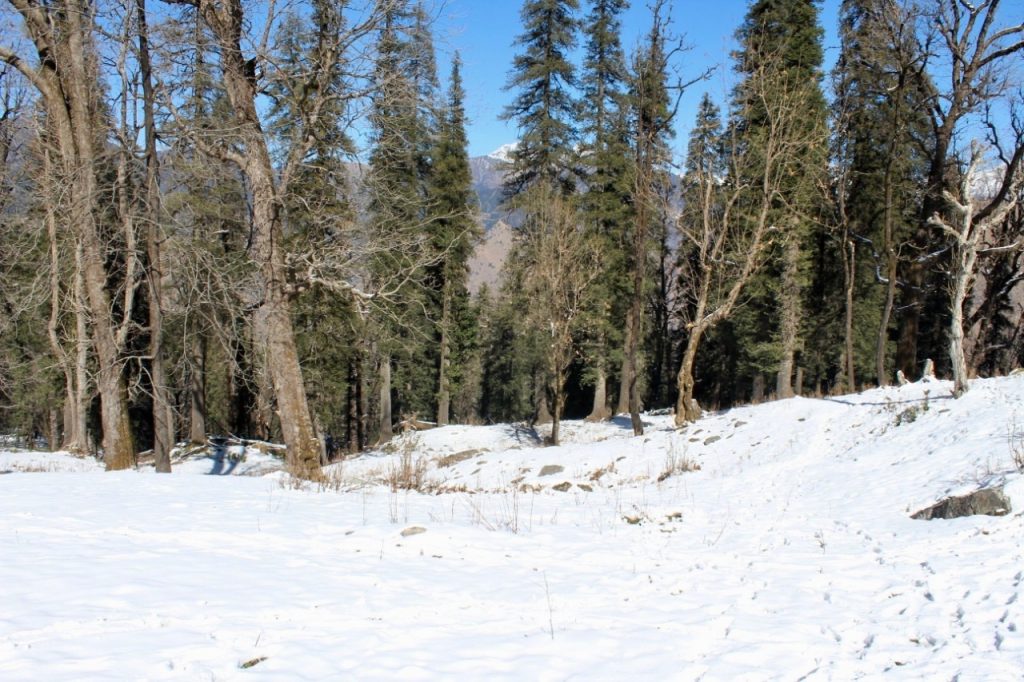
Day 5: Hargaon to Sankri
Sankri is 6 km from Hargaon campsite, but it does not take a lot of time as you’re mostly descending. The journey you can easily cover in 2-3 hours. This final leg will take you down from 8900 ft to 6400 ft. The trail is well marked paved route in between the beautiful nature.
In between the trek from Hargaon to Sankri, you get some splendid views of Har ki Dun valley. Your target should be to reach Sankri by midnight, And if you’ve booked a cab, then you can leave immediately for Dehradun. If you’d like the public transport option, then you can stay one more night and catch the bus in the morning for Dehradun. There are two direct buses from Sankri at 5 AM and 7 AM and take 10 hours.
Accommodation along Kedarkantha Trek
There are various cheap homestays which you can find easily on the trek. Most of the time homestays are easily available but there might be a problem in the peak season.
If you are taking any package, then that agency will provide you the stay itself, and if you are doing this on your own, it’s better to book it online. You can get rooms as low as INR 500s and high as INR 2000.
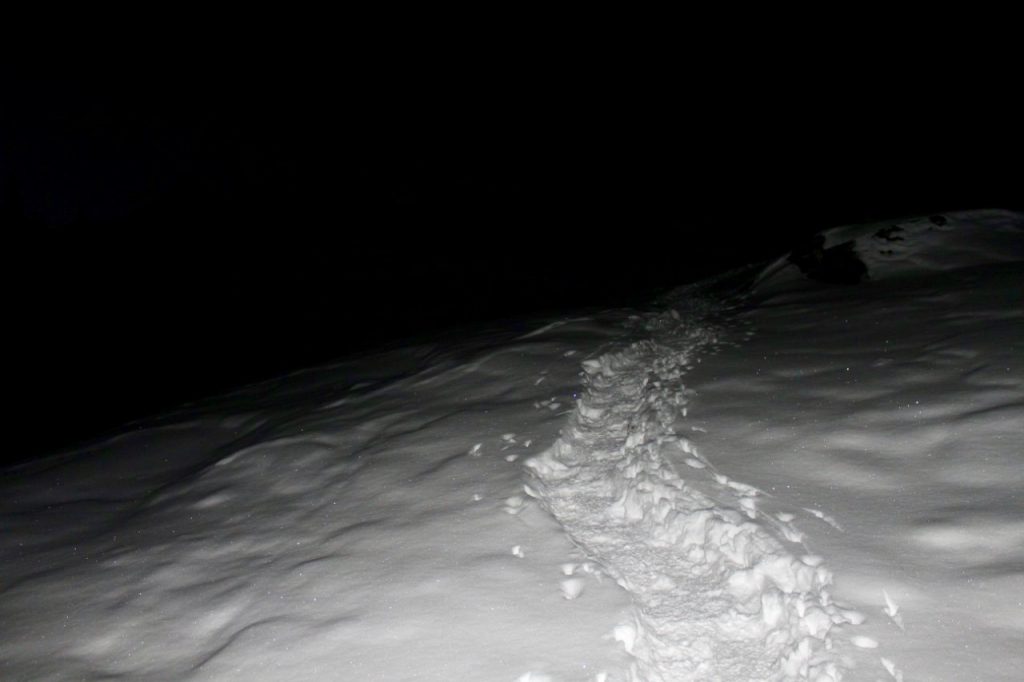
The trek is so beautiful because of the especially beautiful campsites that help you in rejuvenating. This beauty is a unique trait for the region. Walnut and pine trees surround the Akroti Thach campsite, and it is so alluring
Also, the Pukhrola campsite is literally in an open meadow with the summit in clear view – such an absolute delight. You’ll remember your sleepovers almost as much as your trek itself. Stargazing is a must in the meadow
Food options on Kedarkantha Trek
While there are various food options available in Sankri, on the trek, there are very few tea shops that provide basic food. There are two shops before the first campsite which provide tea and Maggi and one on the Kedarkantha base campsite.
If you are trekking on your own, carry food of your own. Also, ensure you carry your own water bottle (Let’s please note pollute the Himalayas- there are no cleaning crews climbing up our pristine hills – let’s vow to keep ‘em clean!) and fill it up when possible/available.
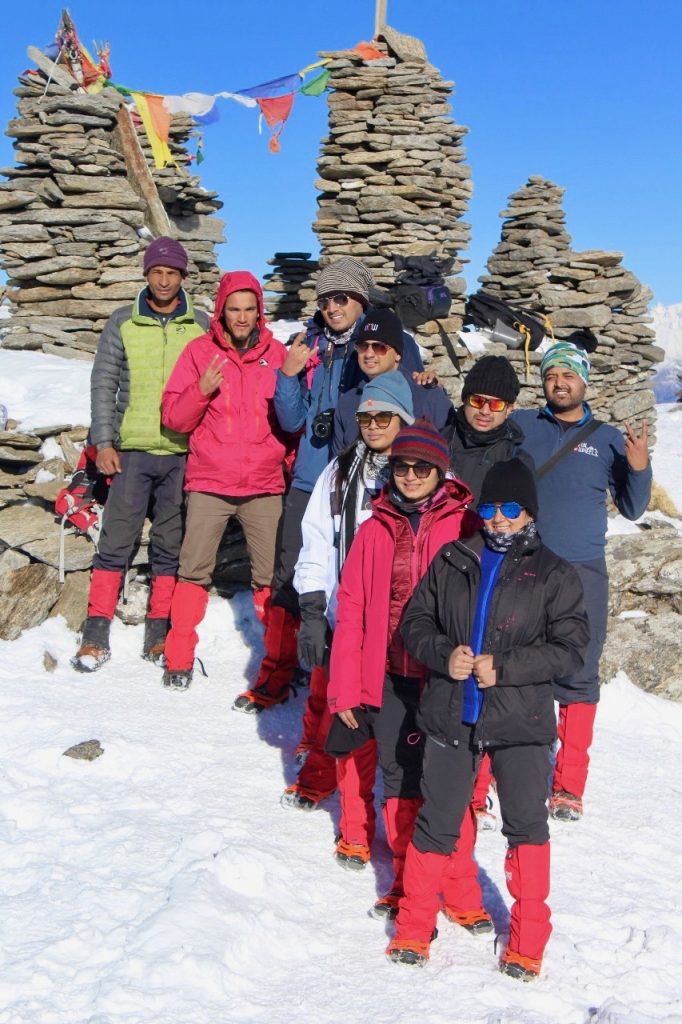
Other Important Tips
Of course, there are some other considerations for any travel we might be planning – some are as below:
ATM availability near Sankri
There are no ATM’s available in Sankri. The last place where you’ll find ATM is Purola. Hence, make sure you are carrying enough cash with you.
Mobile Network at Kedarkantha trek
There is only BSNL network available in Sankri, and as you move above on the trek, there are no networks available. Of course, I am a strong believer that this is how it should be – when you’re trying to connect with yourself/ nature and be more present – why do you need cellphones to distract you and unwarrantedly take your attention?

Other Things to keep in mind
- The availability of a guide is a must for the Kedarkantha trek unless you are a professional. Mountains can be harsh sometimes so, please take a guide with you.
- There are very few water sources on the Kedarkantha trek, and the chances are you might miss most of them. This reason is why the guide is most important on this trek.
- Do keep proper trekking gear for this trek. In the winters, temperature drops to -10 degrees C. Carry a lot of layers that can keep you warm in the high temperatures .
- Proper hiking trekking shoes are a must to do this trek. Forclaz 500 is one of the best shoes which I’ll suggest.
- Please take all your trash back with you to Sankri. Let’s keep these mountains clean for our future generations.
- Normally, travel agencies charge from INR 6000 to INR 9000 for four days of trekking for a roundtrip from Sankri, covering the Kedarkantha Trek and back to Sankri.
- You can get all the trekking equipment like tents, sleeping bags, trekking shoes also on rent from Sankri if you want. The shop is at the front when you enter Sankri.
- You’ll have to take your tent and food if you aren’t traveling with any travel agency.
- Crampons and Gaiters are must need for this trek in winters.
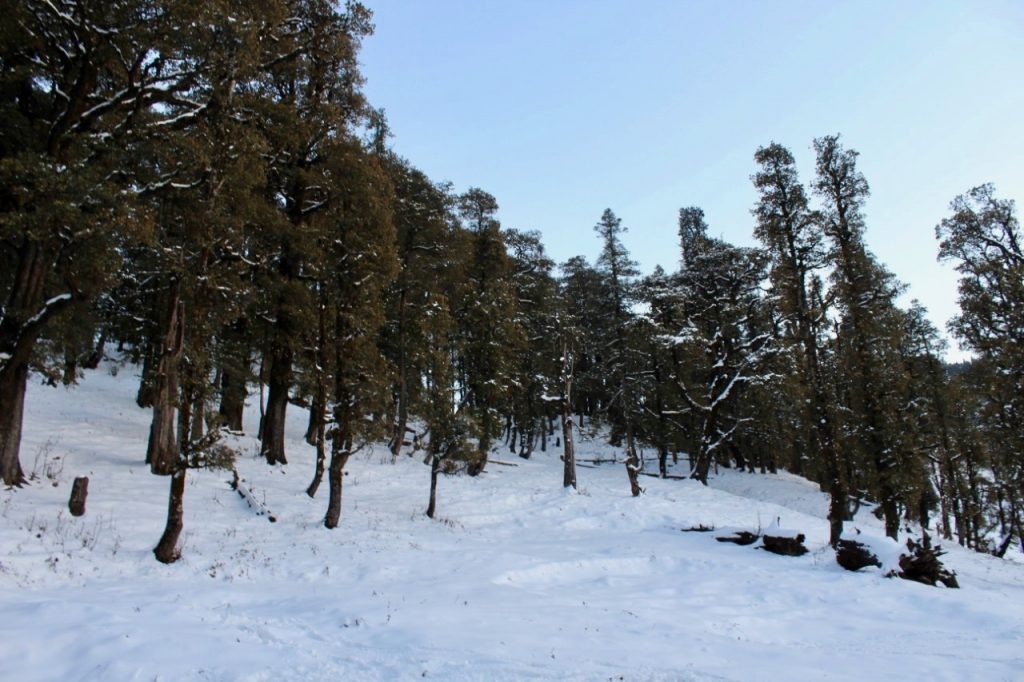
It is a magical experience, getting to complete the Kedarkantha Trek. I hope the above information will help you plan your trek to Kedarkantha. Be safe, and have an amazing trek. If you have any other questions about this trek, then you can ask them in the comments, and we’ll try to help you in every way possible.
Have a travel question?? You can subscribe to my YouTube channel and leave a comment to ask your travel questions about traveling to the Himalayas.
In case any of your friends or families are planning to undertake this trek, please feel free to share this article with them.
Happy Trekking!
Shefali spends most of her time day dreaming about her next big vacation. A happy-go-lucky personality, she is an amalgamation of all the places she’s lived in and experienced! She is always confused as to where to call home, having lived in Chandigarh, Shimla, Dehradun, Mumbai, Hyderabad in India and Vancouver, Abbotsford in Canada. Her love for travel is only challenged by her love for reading and eating delicious food! In order to sustain her dreams, she brought out her inner geek, got an MBA and has a job in the corporate world crunching numbers. Do follow @notravelplans on Instagram for updates on her next great adventure.
Related Posts
Offbeat ladakh: terido & teriphu – teri village travel guide 2024, sethan valley – the most complete guide, chindi & karsog – an offbeat place travel guide [himachal pradesh].
Comments section gets closed in 90 days. To ask your travel questions, you can follow my YouTube Channel for a faster reply or for a much slower reply follow me on Instagram . :)
You definitely should!
An amazing journey I wish I could go there
Type above and press Enter to search. Press Esc to cancel.
Privacy Overview
Ad blocker enabled.

Wildcraft App
Easy Checkout & Free Shipping in App

- CORPORATE GIFTING
Use code APP10 during checkout for additional 10% OFF (Applicable only for app transactions). Use code SAVE10 for additional 10% OFF on min cart of 1999 (Applicable only for the first-time purchaser) and SAVE15 for additional 15% OFF on min cart of 2999 (Not applicable on Backpacks and Luggage)

TOP SEARCHES
- RAIN CHEATER
- HIKING SHOES
- TRAVELCASES
- Jackets & Cheaters
- Sweatshirts & Pullovers
- Joggers & Trackpants
- Pants & Cargos
- Shorts & Cargo Shorts
- Shirts & Tshirts
- Rain Jackets
- Rain Suits & Ponchos
- Thermal Tops
- Thermal Bottoms
- Caps & Hats
- Mufflers & Gaiters
- Travel Cases
- Soft Trolleys
- Hard Trolleys
- Hybrid Trolleys
- Travel Gear
- Duffle Bags
- Duffle Trolleys
- Belts & Wallets
- Travel Accessories
- Technical Gear
- Sleeping Bags & Tents
- Laptop Backpacks
- Messengers & Portfolios
- Trousers & Trackpants
- Capris & Leggings
- WiKi Essentials
- WiKi Rainwear
- Campus Backpacks
- WiKi Boy Backpacks
- WiKi Girl Backpacks
- WiKi Junior Backpacks
- WiKi Slings & Messengers
- Wiki Disney Collection
- WiKi Accessories
- WiKi Lunch Bags
- WiKi Pencil Pouches
- WiKi String Bags
- Wiki Disney Accessories
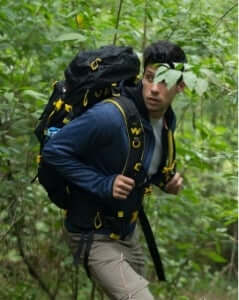
- Luggage Sizes
- Check-in Bags
- Teen's Packs
- Teen's Accessories
- Men's Clothing
- Men's Jackets & Cheaters
- Men's Sweatshirts & Pullovers
- Men's Tracksuits
- Men's Joggers & Trackpants
- Men's Pants & Cargos
- Men's Shorts & Cargo Shorts
- Men's Shirts & Tshirts
- Men's Rain Jackets
- Men's Raincoats
- Men's Rain Pants
- Men's Rain Suits & Ponchos
- Men's Essentials
- Men's Briefs
- Men's Trunks
- Men's Vests
- Men's Socks
- Men's Caps & Hats
- Men's Mufflers & Gaiters
- Men's Gloves
- Men's Thermal Tops
- Men's Thermal Bottoms
- Men's Supermasks
- Women's Clothing
- Women's Jackets & Cheaters
- Women's Sweatshirts & Pullover
- Women's Shirts & Tshirts
- Women's Trousers & Trackpants
- Women's Capris & Leggings
- Women's Rain Jackets
- Women's Raincoats
- Women's Rain Pants
- Women's Rain suits & Ponchos
- Women's Essentials
- Women's Socks
- Women's Caps & Hats
- Women's Mufflers & Gaiters
- Women's Gloves
- Women's Supermasks
- Teen's Clothing
- Teen's Essentials
- Men's Shoes
- Hiking & Trekking
- Even Terrain Running
- Travel Sandals
- Women's Shoes
Kedarnath Trek - A Complete Travel Guide & Tips

Introduction
The best time to visit, the trek itinerary, highlights of the journey, things to keep in mind, things to carry, frequently asked questions (faqs), what is required for kedarnath trekking.
The Kedarnath trek is of moderate difficulty and would require you to carry: A 20-30L capacity rucksack, warm clothes ( jackets , windcheater, and thermal wear), accessories like head gear, gloves, and muffler, personal medical kit and rain cover.
How difficult is the Kedarnath trek?
It is quite easy to cover the Kedarnath Trek, especially since there are multiple transport options available there to make it smoother.
How long is Kedarnath trek?
The Kedarnath Trek covers a distance of 16km and takes almost 6 hours to complete.
Which month is best for Kedarnath?
April-June is the best month to undertake the Kedarnath Trek as the days are quite pleasant, with temperatures ranging between 15 and 25°C with cool breezes.


A Summit Trek In Uttrakhand | India’s Top Most Winter Trek
Easy - Moderate
Highest Altitude
Oct, Nov, Dec, Jan, Feb, Mar, April
Kedarkantha Trek
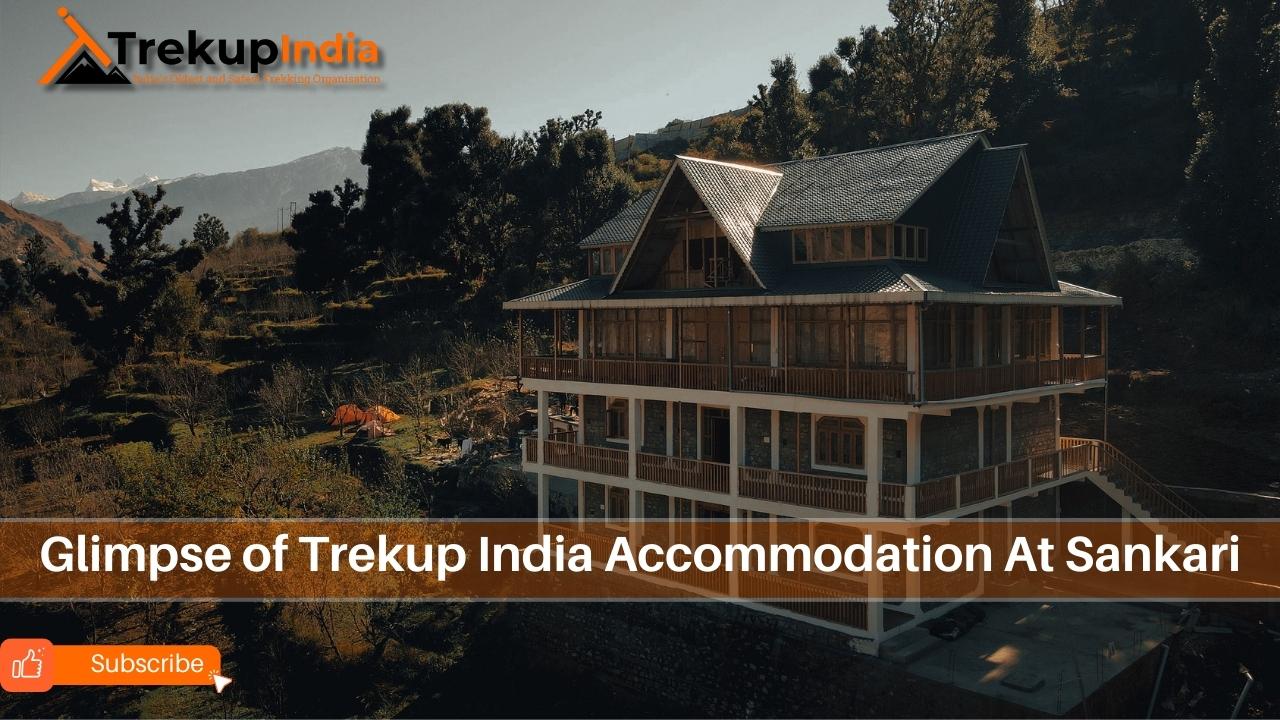
Get Ready to trek the most popular and adventurous Kedarkantha Trek located in Uttarkashi, Uttrakhand, India. Fringed with pine trees and decked with the prettiness of snow, Peak is often considered the best snow-trekking destination across the globe. Located at an altitude of 12,500 ft. above sea level, the trek to this mountain pass in Uttarakhand provides diverse levels of challenges to the voyagers. If you want to experience nature at its best and enjoy a wonderful trek then this Winter Snow Trek is definitely for you. During the trek, you will pass through mesmerizing picturesque views, rich forests, fields as well as snow trails. You need to know that Kedarkantha Summit is nestled in Govind wild life National santuary Park of Uttarkashi. This beautiful peak is encircled by several scenic river valleys, this valley is also known as upper valley of garwal, remotely situated villages the villagers of these villages are living here since Mahabharat Period. Kedarkantha is considered as top most winter snow trek in India, beginners can also do this trek in the Himalayas that you need to experience at least once in your life. Best time to do this trek is from the first week of November to the last week of April, you can find a lot of snowfall here. The campsites of this trek are beautifull all camps are covered with snow after mid november.
Although every trek in the Himalayas is special and known for its own beauty. Trekking often gives you a dose of nature which is not possible in the cities and also offers you the chance to stretch your psychological & physical limits. This Trek is one of those treks in the Himalayas that induce you to witness the beauty of nature that too in its pure form. Right from snow-capped mountains, green pastures forest, frozen lake to a pleasing divine summit, it offers everything that you wish for as a trekker. The summit ascent of trek is extremely rewarding and sure to give you amazing memories. All these views are seen from the starting point Sankri base camp till summit.
As you begin your trek in the early hours of the morning and gradually climb up the steep hill, you will experience breathtaking nature views. Kedar Kantha is popular mainly as a winter trek that starts right from a famous village called Sankri. This beautiful village is almost 210km away from Dehradun.
Generally, in the mountains, winter is quite harsh when it comes to weather. When the snowfall begins, the temperature drops down to minus that further blocks several roads, making most areas unreachable. All these things often make trek exciting and popular because here you can actually experience what winter feels like in the mountains. The temperature here drops to 10 degrees at night and even less but remember such kind of temperature is bearable only with a bit of carefulness. This is the reason why several tourists head towards the base village of this trek called Sankri, especially in the month of December, January, February, and March each year.
The drive from Dehradun to mussoorie and to sankari is one of the most stunning and charming drive in the Himalayas. So, don’t forget to carry your camera. On the way, you will come across the paths filled with snow as well as meadows that are going to offer you a mesmerizing glimpse of the Himalayan Peaks. The silent and peaceful streams along with tranquil lakes are sure to treat all your trekking tiredness and give you a tenderness in nature. You can do ski, if you are good at doing skiing then make sure you try it during the Winter. Skiing will give you the chance to experience an amazing view of the medows of himalyas covered with snow. Get ready to experience the pleasant view that will definitely soothe your eyes because while trekking you will come across rich forests that are wailed with recent snowfals n month of december. Not only this, but the gentleness and kindness of the Local people will surely impress you. This Trek is also considered as the place of Shiva, the ancient Hindu Lord, this trek is no less than a paradise. Silence, as well as the peacefulness of this trek, gives you an amazing feeling and even make you fell like you are in heaven. The paradise sky sight, and sky-knocking mountains, are sure to give you a feeling like you are standing on the edge of the earth. When it comes to this trek, there are several mythological stories behind it. It is believed by the locals of sankri that kedarnath temple initially was here, However, local people still believe that Kedarkantha is the only place of the Lord Shiva Live. Even if you are new to trekking, This Trek is the best trek of all time. Get ready to explore the stunning beauty of the view from Burane range to Bandarpoonch 1 and 2 and in between, you will also get the wonderful sights of Rupin range, Har Ki Dun, Swaragrohini 1 to 4 as well as Black Peak, during your trek. Height and altitude of Kedarkantha Trek is 12,500 ft and is an achievable altitude for all beginners and first-time trekkers. If you are fond of trekking and want to experience nature at its best then do plan for this trek once.
Why is Kedarkantha Trek an ideal choice for beginners?
Location and Geography: Nestled in the heart of Uttarakhand, India, the Kedarkantha trail winds through the enchanting Govind Wildlife Sanctuary in the Western Garhwal Himalayas. It’s a journey that takes you through the spellbinding Tons Valley, a sight to behold and a top trekking destination in India.
Route: The journey to Kedarkantha Peak takes six days and is suitable for beginners and experienced trekkers. It passes through charming villages, lush forests, and captivating meadows, highlighting the beauty of Uttarakhand’s trekking.
Difficulty Level: The trek offers a balanced level of challenge, suitable for those with limited experience. The terrain provides a mix of excitement and accessibility without being overwhelming.
Suitable for Different Age Groups: Kedarkantha is not just a trek; it’s an experience that welcomes families, friends, and solo explorers with open arms. It offers something for everyone, making it an ideal choice for beginners.
No Technical Skills Needed: This beginner-friendly trail eliminates intimidation and does not require extensive technical expertise.
Well-Marked Trail: The trail in Kedarkantha is marked, reducing the chances of getting lost and enhancing the trekking adventure.
Guided by an Experienced Team: Your journey to Kedarkantha is not just about the trek but the experience. With the assistance of experienced guides and trek leaders, your safety is our priority. They will guide you and enhance your knowledge of the region’s culture and natural environment, making your trek more enriching.
For beginners eager to trek, Kedarkantha is an ideal starting point. It offers breathtaking beauty and a deep sense of achievement.
Remember this helpful guide to the Kedarkantha Trek
The Kedarkantha Trek, located in the Himalayas, is famous for hikers due to its stunning scenery, moderate challenge, and easy accessibility. With the winter season approaching, it’s time to start planning your Kedarkantha Trek. This article provides an overview of what to expect during the trek and how to prepare.
Location: The Kedarkantha Peak is in the Uttarakhand Govind Garhwal region. The trek typically starts from the picturesque village of Sankri, known for its beauty and friendly locals. Sankri is easily accessible by road from major cities such as Dehradun and Rishikesh.
Duration: The Kedarkantha trek lasts six days and is suitable for trekkers of all experience levels, from beginners to seasoned hikers.
Difficulty Level: With a moderate rating, Kedarkantha offers a good balance of adventure and accessibility, making it suitable for novice and experienced hikers. The gentle incline provides a pleasant and rewarding experience, making it an excellent option for families with children.
Best Time to Visit: The best time to visit the Kedarkantha Trek is during winter, from December to April. During this time, the area becomes a magical winter landscape with snow-covered trails, frozen lakes, and thick forests.
Altitude: Kedarkantha’s altitude reaches an impressive 12,500 feet. The journey from the base camp to the summit involves an increase in height of 6,100 feet over three days, allowing participants to adjust to the altitude.
Lodging: Accommodations include stays in a Trekup India Luxury Hotel at the base village of Sankari and comfortable twin-sharing tents during the trek.
Offloading Service: Offloading services are available for an additional fee. If booked online through the website, it will cost INR 1600, or at Base Camp Sankri, it will cost INR 2000. The offloading bag weight should be at most 10 kg.
Cloakroom: Upon arrival in Sankri, you can store your luggage at the guesthouse.
Nearest ATM: The last ATM before Sankri is at Mori. For a secure trek, carrying cash with you or withdrawing it at Dehradun is advisable.
The Biodiversity of Kedarkantha Trek in Uttarakhand
Located within the Govind National Park in Uttarakhand, Kedarkantha is a popular trekking destination in India known for its stunning scenery and panoramic summit views. Despite its natural beauty, the region’s incredible biodiversity often goes unnoticed. The trek through the national park showcases a wide variety of plant and animal life, with different vegetation zones transitioning from dense oak and pine forests at lower elevations to picturesque alpine meadows at higher elevations. This unique range of altitudes creates a diverse ecosystem supporting various plant and animal species. Kedarkantha is home to many rare plant species, including the beautiful Brahma Kamal. It is a haven for wildlife such as the Himalayan Monal, Musk Deer, and various bird species. The Kedarkantha Trek is moderately complex and suitable for beginners and experienced trekkers. All of these contribute to the rich biodiversity of the Himalayas.
Please remember the following text about the plants and wildlife you can encounter during the Kedarkantha Trek:
Plant Life in Kedarkantha Trek
1. Rhododendron Blooms
The Kedarkantha Trek offers an extensive view of rhododendron forests in shades of red, pink, and white, especially visible in spring. These forests add a vibrant contrast to the snowy scenery.
2. Oak & Pine Forests
The trek takes you through thick oak and pine forests, which support diverse plant and animal life, including various bird species and small mammals.
3. Moss & Lichen
At higher elevations, you will find a serene landscape adorned with moss and lichen, crucial for maintaining the region’s ecological balance.
4. Medicinal Plants
The trek features the Brahma Kamal, a revered plant species essential to Uttarakhand’s local population.
Wildlife on the Kedarkantha
1. Himalayan Monal
The rare Himalayan Monal, known as the state bird of Uttarakhand, is a sight to behold in the thick forests, showcasing its shimmering feathers. Spotting this magnificent bird is a privilege that adds a touch of exclusivity to your trekking experience.
With its graceful movements, the elusive red fox enhances the beauty of the stunning snowy landscape. Its presence adds a touch of allure to the already picturesque scenery, making your trek even more enchanting.
3. Himalayan Tahr
Spot the impressive Himalayan Tahrs with their curved horns and dense fur in the alpine meadows.
4. Langurs and Macaques
Energetic langurs and macaques add an exciting element to the natural environment.
5. Musk Deer
Spotting the elusive musk deer, a rare and exhilarating experience amidst the breathtaking scenery of the Kedarkantha Trek, is sure to get your heart racing. The thrill of such an encounter is an unforgettable part of your trekking adventure.
Due to its biodiversity, the Kedarkantha Trek is a valuable experience for nature enthusiasts, offering a chance to explore the wonders of the natural world.
- Stay will be on a twin-sharing basis in tents
- + 210 Trek Insurance (Optional)
- Discount Policy
- Transport Optional ( INR - 1,500 extra )
Pickup time 6.30 A.M from Prince Chowk, Near Dehradun Railway Station
- Inclusions & Exclusions
- Food Provided Trekup India
- Safety With Trekup India
Call Our Mountain Experts
Fix Diparture Dates
Kedarkantha trek videos.
Videos by experts watch these videos to prepare well for a Successful Trek

Want To Trek Like Pro?
Check out the following videos if you want to trek like a pro trekker and improve your skills. These videos contain helpful tips, tricks, and techniques to help you trek like a pro. Whether you’re a beginner or an experienced trekker, these videos can provide valuable insights to enhance your trekking experience. So, watch the videos below by Trekup India experts to take your trekking skills to the next level.
Know Everything About Acute Mountain Sickness
Acute Mountain Sickness is a medical condition that can occur when individuals travel to high altitudes, typically above 8,000 feet. It is caused by the decrease in air pressure and oxygen levels in the air as altitude increases. Symptoms of Acute Mountain Sickness may include headache, nausea, vomiting, dizziness, and difficulty sleeping. To avoid Acute Mountain Sickness, it is important to gradually adjust to high altitudes and seek medical attention if symptoms worsen. To learn more about this condition, check out the videos by Trekup India.
Day Wise Detailed Itinerary of Kedarkantha Trek
Day 1: pickup from dehradun and drive to sankri.
- Sankri is located at an altitude of 1920 meters and 6,400 feet.
- Dehradun to Sankri 220km drive which will take almost 10 hours.
- All the trekkers will be pickuped from Hotel garand which is near Dehradun Railway station at 6:30 AM in a Bolero (6-7 seaters), Innova (7 seaters), Tempotravellers (12 seaters) & Bus.
- You will be reaching at Sankri till 05 in the evening.
- Jio & BSNL network available.
- Night stay in guest house and hotel.
Your trip will start from Dehradun for the Kedarkantha Winter Snow Trek. All the trekkers need to arrive at Dehradun before 6 am because till 06:30 am, we will start our drive to Sankri.
You need to know that the distance between Dehradun to Sankri is almost 220km which will take approximately 10 hours to reach. Sankri is located on the National Highway 123 and is a beautiful drive. While driving from Dehradun to Sankri, you will be spell-bounded with the beauty of valleys as well as forests.
Before reaching Sankri about 22km, all the trekkers will get an amazing feeling of serene Himalayas as well as greenery. You will also come across Govind National Park which is well-known for its huge collection of Flora. In this park, you will find the Flora which is available only in this region and nowhere else in the country.
Day 2: Trek from Sankri to Juda-ka-Talab
- On this day we will to 9100 ft from 6400 ft.
- Trekking for 4km will take 2.5 long hours.
- The path will pass through maple trees, oak forests, water streams, and stunning meadows.
- Night stay in tents (twin sharing).
On day 2, you will begin the trek towards Juda Ka Talab which is located at an altitude of 9,100 feet. Till afternoon, you will cover almost 5km which takes 5 hours but this can also vary on the capability of the trekker.
Get ready to experience the diverse adventures on the trail. While walking, ice and slush might bother you a little but the guides of TrekupIndia will help you out so don’t worry.
The trek will start with a beautiful pine & maple forest that will further rise alongside the wildlife as well as pastures. As you trail upwards, you will spot some beautiful huts alongside the fields.
While trekking, you will see a goliath lake on the left and thick pine & oak backwoods on the other side which is a perfect example of beauty. You will get the Luke warm water all around the lake and the rest water will be colder.
In winters, you can see a sheet of ice instead of water, giving you an eye-catchy view. This lake also has a big natural tunnel that offers water to the villagers.
Primarily, you will be climbing through the bridges and one of the exciting things about this trek is that you will find Himalayan Languor. You need to know that they are shy animals and hardly anyone gets the chance to see them.
You might also witness boars, hares as well as martens in this region. Juda Ka Tal is a beautiful destination in the thick pine and oak forest. At night, you will be served with hot & healthy dinner. Your night stay will be scheduled in a camp where you can enjoy the beauty of Mother Nature’s lap.
Day 3: Trekking from Juda-ka-Talab to Kedarkantha Base (Lohasu)
- today we will trek to 11250 ft from a height of 9100 ft.
- Trekking for 4kms which will take time of 2.5 hours.
- Most of the trail is on a ride and under the beautiful oak trees
- You will be passing through some pastures where shepherd log huts can be seen.
- Night stay in tents (twin sharing), giving amazing views of nature.
Get up early in the morning and witness the breathtaking sunrise that will definitely leave you stunned. On day 3, we will begin the trek for Kedarkantha base which is located at a height of 11,250 feet.
Kedarkantha Trek Base i.e Lohasu from Jadu Ka Talab is almost 4kms and it takes 2.5 hours to cover at a moderate speed. You need to know that Jadu Ka Talab is a wonderful lake that is surrounded by pine trees that often gets freeze at the time of winters and also turns out to be a spot for adventures as well as fun activities for the trekkers.
Gradually, the trail will get steeper as you keep on moving upwards. Your trek guide will teach you different skills for snow slopes, so be attentive and listen to him carefully. He might also guide you about how big your footsteps should be.
Your trekking will again start from the dense forest of pine and oak trees. The trail also passes through the steep ridges. As you gradually walk towards the path and reach a height of 10,400 feet, you will witness the snow traces that will definitely give you magnificent views of nature.
Get ready because the spectacular views are still waiting to shock the trekkers because before reaching the base camp all the trekkers can observe the stunning views of different arc-shaped ranges that are covered with snow like Bandarpoonch, Swargarohini, Kala Nag as well as Ranglana that are standing with great pride in the lap of Mother Nature.
At night, you will be served with delicious dinner in your tents only.
Day 4: Early Morning Hike From Kedarkantha base to Kedarkantha peak; descend to Hargaon camp
- We Will WakeUp Early Mornig for the summit push / peak.
- Trekking for almost 7 hours for 6kms trek
- You will see sun rise if we reach on time to summit
- Served with lip-smacking lunch at the camp base only
- After lunch, descending towards Hargaon
- For snacks time we will reach Our next Campsite Hargaun
- Night stay will be organized in tents (twin sharing).
Day 4 is going to be a long one because you will be heading towards the Kedar Kantha peak. Today, you will be trekking from 11,250 feet to 12,500 feet and trek for almost 6kms which will be covered in 7 hours. It is necessary for you to know that the trail will be steeper, so be prepared accordingly.
At the time of trekking, you will see the magical colors of nature as well as the majestic sights of different ranges including Rupin. The reason for calling it Kedar Kantha, rumors from villagers is; 1st they tried to build Kedarnath temple in that peak but they heard some animal’s sound which means omen for a divine event.
Till then they constructed Lord Shiva’s statue till neck ad in Hindi neck is called Kanth as well as Lord Shiva has a lot of names and Kedar is one of them. This is the reason, why it is known as Kedarkantha.
In Kedar Kantha peak, you can treat your eyes with appealing views of Bandarpooch, Swargarohini, Kalanaag, Gangotri as well as Yamunotri. After reaching the summit, the captivating views of nature will definitely balance your emotion and leave you stunned.
On the top, you will also find a small temple which is dedicated to Lord Shiva and Goddess Parvati along with a small shrine of Lord Ganesh too. Apart from this, we will also start descending to Hargaon camp on the same day.
A night stay will be scheduled at the campsites, giving you beautiful views of valleys and nature.
Day 5: Trek from Hargaon camp to Sankri
- Returning back from Hargaon camp (8,900 feet) to Sankri (6,400 feet)
- Trekking for 6kms which will take almost 4 hours
- Descend 2,500 feet through dense pine woodlands
Day 5 is marked for descending further to Sankri from Hargaon Camp. We will be descending from 8900 feet to 6400 feet. The time for descending the 6kms long trail will take almost 4 hours and even more if you follow a moderate speed.
The day has arrived when you need to leave the regal views of the Himalayas as well as snowcapped mountain ranges because we will be heading back to Sankri. It is important for you to know that the trek is going to simple as the distance is short.
Sankri is the stoppage village for several treks like Bali pass, Borasu pass, and many more. The morning at Hragaon camp is going to welcome you with a stunning sunrise right between the pine trees.
After having breakfast, you will pack your back and start descending through a clearly marked paved pathway and reach Sankri.
Day 6: After Having Last tea, coffee with us, Departure from Sankri to Dehradun
- Back to Dehradun which is 220km from Sankri.
- The drive will take almost 8 to 10 hours but, on the way, you will come across beautiful scenes.
- By Tata Sumo or any other vehicle, you will be dropped at Dehradun Railway Station.
On day 6, you will be heading towards Dehradun from Sankri which will take almost 10 hours as you need to cover 220km. You will be leaving Sankri early in the morning so that by evening you reach Dehradun.
By 7 – 8 pm in the evening, you will be reaching Dehradun, so get your bookings done for your hometown accordingly.
Make sure to collect all your memories while driving back to Dehradun.
We’ve prepared a comprehensive Trek Route Map for your upcoming adventure to Kedarkantha Trek , which outlines the entire journey including all stops and trails. This map provides detailed information on the terrain, distance between points of interest, and estimated travel time to help ensure a safe and enjoyable trek. We’ve carefully curated the map to ensure that you have all the necessary information at your fingertips. Please take a moment to review it thoroughly, and don’t hesitate to reach out if you have any questions or concerns.
The Trek Altitude Chart is a useful tool for Trekkers to monitor their altitude changes during their rides, allowing them to plan their routes more efficiently and track their progress over time. This Kedarkantha Trek chart is beneficial for both casual and experienced Trekkers, helping them make the most out of their Trek experience.
Trek Cost Inclusions
- Stay: 3 Nights of tented accommodation at individual campsites of Trekup India on twin sharing and 2 nights at sankari in Trekup India Luxury Hotel on multi sharing basis.
- Meals: Trekup India will provide freshly cooked meals during the trek starting with Dinner on Day 1 to tea, coffee on day 6 (Meals are simple, nutritious, and vegetarian)
- Transport (Optional): Dehradun to Sankari and return. ( 1500 extra )
- Trek Insurance (Optional): Trekup India recommends that all trekkers consider getting trek insurance. This is optional, but highly recommended. Trek insurance covers unexpected events that may occur during your trek. The cost of the insurance starts from INR 210. Please read more about what is included in the coverage and why it is mandatory on treks.
- Trek Equipment: Sleeping bag, Sleeping tents, Kitchen tent, Dining tent, Toilet Tent.
- Amenities: All utensils, sleeping mattresses (Black foam mats), Crampons, and Gaiters for snow.
- Health & Safety: First Aid Box, Oxygen Cylinders, Stretchers, Oxi meters, BP Machines, health.
- Permits: Forest Permits and Camping Permission Fee
- Trek Crew: High Altitude Chef, Helpers, Trek Leader & Guides, and other support teams.
- Potters & Mules: Potters and Mules are to carry all trekking equipment, ration, and vegetables.
Trek Cost Exclusions
- GST 5% (it is Mandatory)
- Any Meals/accommodation beside the itinerary or not mentioned in the program.
- Any Bus / Airfare to/from trek start/end point
- Personal Medical expenses do carry your medication.
- Any personal services such as Laundry, phone calls, liquors, mineral water, etc.
- Any still / video camera fee
- Any Entrance fee Monuments, Monasteries, Museums, Temples – Pay directly on the spot.
- Mules or porter charges to carry private baggage (Offload Charges for bag 365 per day, per bag if paid online (at base camp 2,550). Note: Bag weight should not be more than 10 kg.
- Any emergency evacuation charges
- Any services that are not mentioned in the cost inclusion section.
What should you pack for the Kedarkantha Trek
Kedarkantha Trek is a high-altitude trek. The trekking gear you have to have for this particular trek differs from normal treks. Thus, read this whole segment. There is an important question that the trekker who is doing trek asks, like what all things to carry while trekking. Below, we have provided the details on everything you should take; an easy way to remember is by Head to foot or foot to head. We have prepared from Head to foot.

When trekking it's important to carry headgear to protect your head and face.
Heading out for a trek? Don’t forget to carry headgear to protect your beautiful face and head from the sun, wind, and dust! It’s an essential accessory that keeps you safe and comfortable throughout your adventurous journey. So, make sure you pack it before you step out into nature!
- Head Lamps – When trekking at night, headlamps are essential to illuminate your path while keeping your hands free. Headlamps come in different sizes and lumens, so it is essential to choose one that suits your needs.
- Hats or Cap – Caps or hats are also necessary when trekking in different weather conditions. Caps protect your head from the wind and freezing temperatures at night, while hats provide shade and protection from the sun during the day. It’s essential to ensure that your hat has a strap to prevent it from being blown away by the wind.
- Sunglasses – Sunglasses are also essential for trekking. Your sunglasses should protect your eyes from harmful UV rays and fit your face perfectly to avoid falling off while climbing, jumping, or crossing obstacles. The glass of your sunglasses should also be designed for different weather conditions to provide optimal visibility.
- Buff / Balaclava – Lastly, a buff or balaclava is a must-have to protect your mouth or neck from extreme temperatures and keep them warm. Buffs and balaclavas come in different materials, thicknesses, and designs, so it’s important to choose one that suits your needs and preferences. Depending on the weather conditions and your activities, you can wear them as neck warmers, face masks, or headbands.
When trekking in high altitudes, prepare for cold weather by wearing layers. Layering traps heat, keeps you warm, and allows you to easily adjust your clothing as temperatures fluctuate.
Layering is important for different seasons when trekking. When planning a high-altitude trek, it is important to prepare for the cold weather. Wearing layers is the best approach as it provides both protection and flexibility when the weather changes frequently in the mountains. Layering helps to trap heat and keep your body warm, while at the same time allowing you to easily adjust your clothing as the temperature fluctuates. By wearing layers, you can enjoy your trek comfortably and stay safe in the unpredictable mountain weather
- For spring, summer, and monsoon treks , consider wearing three layers: a woollen sweater, a fleece, and a padded jacket.
- For autumn treks , add one more fleece layer to make it four layers.
- For winter treks , you may need five layers with thermals, a woollen sweater, two fleeces, and a padded jacket.
- T-shirt/sleeve shirt – Bring three T-shirts and two quick-dry trek pants, wearing one and carrying the others. Long sleeve shirts help to protect from sun UV rays. We recommend synthetic T-shirts as they get dry quickly when they get wet.
- Hiking / Trekking Jacket – down jackets (-5 to-10 C) or two-three-layer jackets.
- Thermals – at least two pairs of thermals help keep the body warm during cold weather.
- Undergarments – you can carry them according to your habitual and hygiene requirements.
- Gloves – 1 pair of gloves will keep your hand warm and nice.
- Trek Pants – Bring 2 to 3 comfortable trekking pants. Trekking pants play a significant role, as they are designed for comfort and mobility, making trekking easier. It should be Synthetic so that it gets dry quickly when wet.
- Rain Wear – you can carry a raincoat or Poncho. During long rains and snowfalls, the waterproof jackets start leaking. Still, the Poncho and raincoats keep you dry, so choose accordingly.
Tip: If you choose a raincoat on your trek, carry a small waterproof cover so things inside your backpack can’t get wet. If you carry a Poncho, you don’t need to worry. It protects both you and your backpack.
When it comes to planning a trek, one of the most important aspects is to ensure that you have the right kind of foot gear.
- Trekking shoes which are waterproof and have ankle support. Walking / Hiking sandals which can be used off the trek, i.e., in the morning and evening hours when you reach the campsite, basically to get your feet rest from heavy boots, sometimes used for crossing streams and rivers, it’s more comfortable and safer than crossing barefoot or wetting your shoes. Sneakers (Optional) can be worn for normal driving days or used around the camp.
- Socks – you should at least carry 3 to 4 pairs.
- Microspikes & Gaitors will be provided by Trekup India when required. You don’t have to carry them.
Personal First Aid Kit
Don't forget to pack your personal first aid kit! It's always better to be safe. So, make sure you're prepared for any unforeseen circumstances.
Below are some common medicines generally required/used during your adventure trip; however, please consult your doctors prior.
- Antiseptic towel or water syringe (to clean the wound)
- Butterfly bandage for a small cut
- Cotton and elastic bandages and sterile gauze pad for larger wounds
- Latex gloves are used when the wound bleeds.
- Medicine for Diarrhea (Upset stomach)
- Medicine for cold, flue/fever, headache
- Some pain killers
- ORS pouches
- Quick pain relief spray (External use)
- Any personal medicine prescribed by your doctor
- Dimox / Similar for high altitude sickness
- Bug Repellent
- Carry some nutria/energy bars and drinks (non-alcoholic)
- Note: Kindly consult your doctor before purchasing or taking any medicine.
Gadgets and Other Items
You might also consider bringing a camera, binoculars, portable charger, and snacks. Be well-prepared and tackle any trail with confidence.
- Trekking Poles
- Mobile phone
- Spare batteries for phone and camera, power bank
- Lightweight flashlight or headlight
- A waterproof bag made of plastic is used for the camera.
- Plug/converter for electrical items
- 1-litre water bottle
- A journal with a pen would be a good idea to keep your notes.
- Some book of your interest for the ideal time
- Get into the habit of maintaining a Map and guidebook of the region.
Hygiene & Personal toiletry
Remember to pack hygiene and personal toiletry items such as soap, shampoo, toothbrush, toothpaste, deodorant, and toilet paper.
- Sunscreen with UV protection to shield your skin from harmful rays
- 1 or 2 small quick-drying towels to help you dry off quickly in case of rain or sweat
- Toilet paper, tissues or wet wipes for maintaining hygiene while on the trek
- Toothbrush, toothpaste, and mouth freshener to keep your mouth clean and fresh throughout the journey
- Deodorant or talcum powder to help you stay fresh and odor-free, especially during hot and humid climates
- Shampoo to keep your hair clean and healthy
- Sanitary pads or tampons (for female trekkers) to manage menstrual cycles
- Lip-gloss or salve to protect your lips from dryness and chapping
- Bio-degradable soap to keep yourself clean and hygienic while on the trek
- Nail clipper and other personal items that you use daily
Compulsory Documents to Carry
There are certain documents that you should always carry with you. These documents are not only necessary for your safety and security, but they may also be required by local authorities.
These files must be submitted to the Forest Department before your trek. With none of these, you will not be permitted to trek—original and photocopy of government photo identity card. Carry IDs like Aadhaar, voter ID, etc.
How To Plan Your Trek & Reach Dehradun?
By Air:- The Jolly Grant Airport is the nearest airport to reach Dehradun by flight, located almost 25km away from the city. Regular flights are available from Delhi to Dehradun. However, if you plan to arrive in Dehradun by flight, it is advisable to arrive one day in advance.
By Train:- If you prefer to reach Dehradun by train, two express trains are convenient options. Nandadevi Express (Train no: 12205) departs at 11:50 pm and arrives at 5:40 am, while Dehradun Express (Train no: 12687) departs at 9:10 pm and arrives at 5:00 am. The train journey is overnight.
By Bus:- There is also a regular bus service from Delhi to Dehradun, with both AC and non-AC buses available from the main bus station, ISBT Kashmere Gate. However, it is recommended to take government buses from Kashmere Gate ISBT. The bus will drop you off at Dehradun ISBT, and our staff will pick you up from Dehradun Railway Station, so make sure to reach there.
A Travller or similar vehicle will pick you up from Dehradun Railway Station at 06:30 am, and you will reach Sankri by 05:00 pm.
Kedarkantha Trek Photos
Fitness required & preparation guide for kedarkantha trek.
If you’re preparing for a Kedarkantha Trek, Trekup India recommends jogging as part of your fitness routine. Jogging helps work out the same muscle groups that you’ll use during trekking and can help you build endurance. You don’t need any special equipment to get started.

Fitness Target
Trekup India has put the Kedarkantha Trek into an easy-to-moderate-grade-level trek.
For Easy – Moderate Treks – In order to be well-prepared for your upcoming trek, it is recommended that you focus on building your endurance by aiming to cover a distance of 4.5 kilometers in less than 45 minutes. This will help you to develop the necessary stamina and strength required to successfully complete your journey.
How to Achieve This Fitness Target?
To start preparing for your trek:
- Try jogging for at least five days every week.
- If you find 5 km too difficult at first, begin with 2 km and gradually increase over 2-3 weeks.
- Once you feel more comfortable running 5 km, focus on improving your speed gradually on a daily basis.
It is important to ensure that you can consistently complete 4.5 km in under 40 minutes for at least two weeks before your planned trek. Allow yourself 6-8 weeks to prepare physically for the journey.
Strength Training exercises that benefit Trekking
Trekking is an activity that demands a good level of strength.
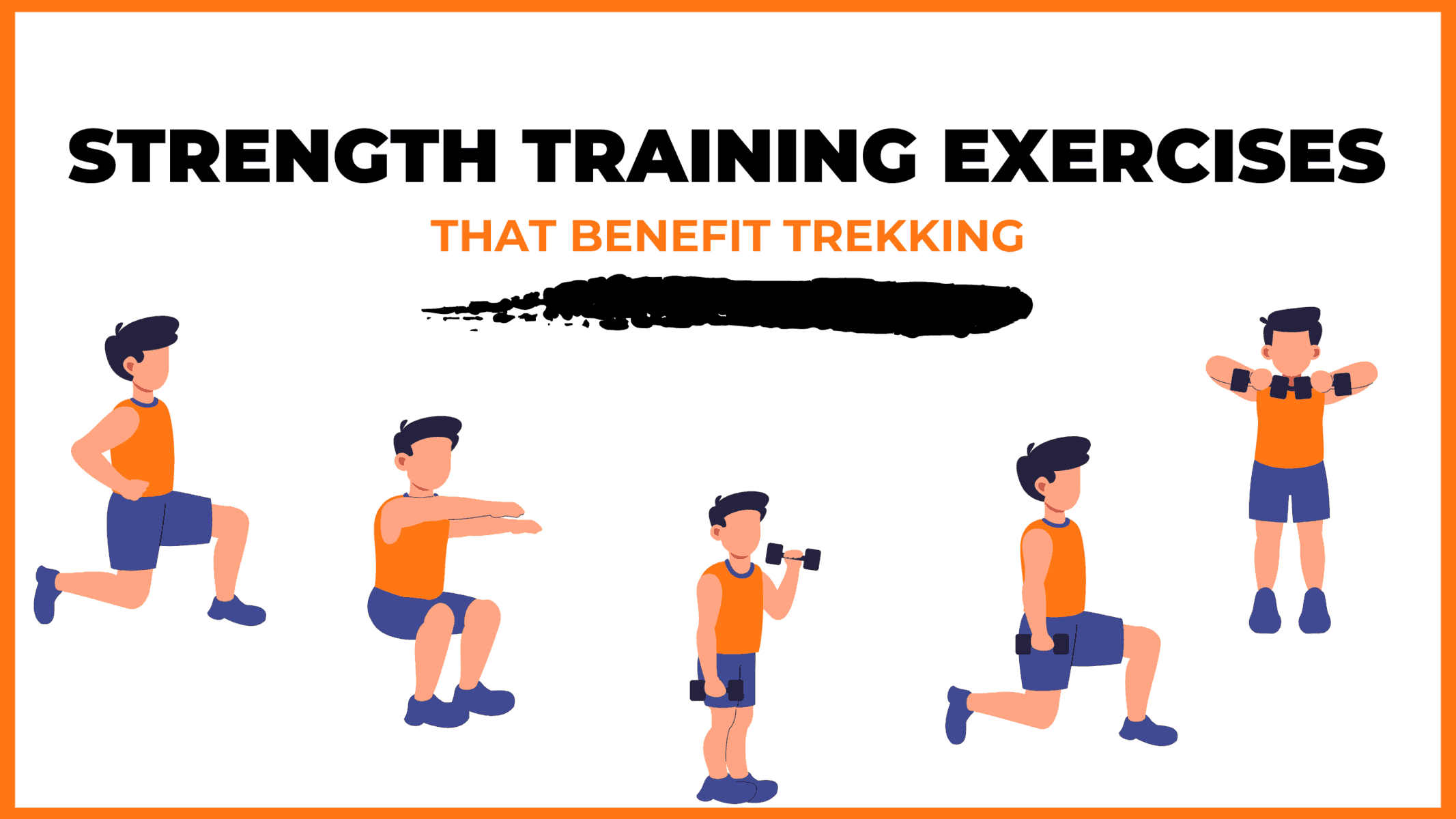
Trekking is a demanding activity that requires good cardiovascular endurance, muscular strength, and overall fitness. To help you prepare for your trek, incorporating bodyweight exercises into your training routine can be an effective way to build strength, improve stability, and enhance endurance, all of which are crucial for a successful trek. In this regard, here’s a breakdown of body weight exercises categorized by the specific body parts they target and the benefits they offer during trekking.
1. Lower Body Exercises
Lower body exercises like squats and lunges are great for building lower body strength, essential for trekking.
Squats are an excellent exercise for building lower body strength, essential for trekking. They target the quadriceps, hamstrings, glutes, and calves. Solid quadriceps and glutes provide power for ascending and tackling uphill climbs, while vital hamstrings aid stability during descents. This is particularly helpful in navigating uneven terrain during trekking.
How to perform Squats Exercises:
- Stand with feet shoulder-width apart, toes pointing slightly outward.
- Lower your body by bending your knees and hips, keeping your back straight.
- Lower until your thighs are parallel to the ground or as low as comfortable.
- Push through your heels to return to the starting position.
Lunges target the quadriceps, hamstrings, glutes, and calves. They improve lower body strength, balance, and stability, crucial for maintaining control on rocky trails and steep slopes. Additionally, they enhance flexibility, reducing the risk of injury while trekking.
How to Perform Lunge Exercises:
- Stand with feet hip-width apart, hands on hips or sides.
- Take a step forward with one foot, lowering your body until both knees are bent at 90-degree angles.
- Push through the heel of your front foot to return to the starting position.
- Repeat on the other side, alternating legs.
2. Upper Body Exercises
Upper body exercises such as push-ups and pull-ups effectively strengthen the upper body, especially the chest and shoulders, which are essential for carrying a backpack during treks.
a. Push-Ups
Targets: Chest, shoulders, triceps, and core.
Benefits for Trekking: Push-ups are an effective exercise to strengthen the upper body, especially the chest and shoulders, essential for carrying a backpack during treks. Improved upper body strength will also help maintain posture and stability while traversing challenging terrain.
How to Perform Push-Ups Exercises:
- Start in a plank position with hands shoulder-width apart and body in a straight line from head to heels.
- Lower your body by bending your elbows until your chest nearly touches the ground.
- Push through your palms to return to the starting position.
- Keep your core engaged throughout the movement.
b. Pull-Ups/Bodyweight Rows:
Targeting the back, biceps, and shoulders can significantly benefit trekking. You can strengthen these muscle groups by performing pull-ups or bodyweight rows and improve your posture and balance while carrying a backpack. Additionally, more muscular back muscles can help reduce the risk of back strain and fatigue during long treks, making your journey safer and more comfortable.
3. Core Exercises
Core exercises like planks and Russian twists can help strengthen the core muscles, which are crucial for maintaining stability and balance while trekking on uneven terrain.
Targets: Abdominals, obliques, and lower back.
Benefits for Trekking: Planks are an effective exercise that helps strengthen the core muscles. These muscles are crucial for maintaining stability and balance while trekking on uneven terrain. A strong core also helps improve posture, reducing the risk of back pain and fatigue during extended hikes.
How to Perform Planks Exercises:
- Start in a plank position with elbows directly under shoulders and body in a straight line from head to heels.
- Engage your core and hold the position, avoiding sagging or arching the back.
- Keep breathing steadily and hold for the desired duration.
b. Russian Twists
Targets: Obliques, abdominals, and lower back.
Benefits for Trekking: Russian twists engage the core muscles, particularly the obliques, improving rotational stability and balance. Enhanced core strength helps prevent injuries and improves overall performance during trekking.
How to Perform Russian Twist Exercises:
- Sit on the ground with knees bent and feet flat, leaning back slightly to engage the core.
- Clasp hands together and twist the torso to one side, bringing the hands towards the ground beside the hip.
- Return to the centre, then twist to the other side.
- Continue alternating sides for the desired number of repetitions.
4. Full Body/Cardiovascular Exercises
Full-body/cardiovascular exercises like burpees and mountain climbers are excellent for improving cardiovascular endurance, strength, and agility.
Burpees are an excellent full-body exercise that targets your legs, chest, arms, and core. This exercise dramatically benefits trekking enthusiasts, improving cardiovascular endurance, strength, and agility. Regularly incorporating burpees into your workout routine can enhance your overall fitness level, which can help you endure long hikes and rugged terrains with ease.
How to Perform Burpees Exercises:
- Start in a standing position.
- Squat down and place hands on the ground.
- Jump feet back into a plank position.
- Perform a push-up.
- Jump feet back to the squat position.
- Explosively jump up into the air, reaching overhead.
- Land softly and repeat the sequence.
b. Mountain Climbers
Mountain climbers target the core, shoulders, chest, and legs. This dynamic, full-body exercise can significantly improve cardiovascular endurance and agility. It is an excellent functional workout for trekking preparation as it engages both the upper and lower body muscles while strengthening the core muscles.
How to Perform Mountain Climbers Exercises:
- Drive one knee towards the chest, then quickly switch legs, alternating in a running motion.
- Keep the core engaged and the hips stable throughout the movement.
- Continue at a moderate to fast pace for the desired duration.
Incorporating bodyweight exercises into your training routine can help you build strength and endurance and prepare your body for the physical demands of trekking. Consistency and proper form are crucial to maximizing the benefits of these exercises and ensuring a safe and enjoyable trekking experience. Engaging your core muscles, including obliques, abdominals, and lower back, with Russian twists can improve your rotational stability and balance, preventing injuries and enhancing overall performance during trekking.
When incorporating strength training exercises into your workout routine, it’s essential to maintain proper form and technique to avoid injury. Start with lighter weights and gradually increase the intensity as you progress, focusing on compound exercises targeting multiple muscle groups simultaneously. Some examples of practical strength training exercises for trekking include squats, lunges, deadlifts, and pull-ups.
Remember to give your muscles time to recover between workouts, and remember to stretch before and after your workouts to prevent injury and improve flexibility. Combining strength training with jogging and proper stretching allows you to take your fitness to the next level and confidently tackle even the most challenging treks.
Our Trekkers Reviews And Expreinces

We provide only Indian vegetarian food, and your meal will mainly consist of Indian bread, vegetables, lentils, rice, and a delicious dessert. During your trek, we will serve three meals a day, including breakfast, lunch, and dinner. You will also be served tea, snacks, and lip-smacking soup in the evening before dinner. If it is a long day of trekking, you will be given a packed snack.
After extensive research on the trekkers’ nutritional requirements, we prepare the menu. Before putting all the meals together, we also consider the altitude and the weather.
The meal we serve during the trek is perfectly balanced with calories, carbohydrates, vitamins, protein, fibre, and minerals. You need to know that all our cooks have great expertise in cooking and have undergone thorough training. So, get ready to enjoy delectable and lip-smacking dishes during your trek. You will be served with lemon tea in the tent to start your day with a refreshed feeling. Before leaving the campsite for trekking, you will be given a hot finger-licking breakfast like upma, Aallu Prantha, Besan Chilla, Poha, Daliya, Corn flakes, and Maggie, along with tea or coffee.
If your trek is longer, we also offer some fresh local fruits such as apples and healthy drinks like Frootie or Maaza. In the afternoon, you will be served a simple & healthy lunch, while at around 04:00 pm, you will be given tea and a light evening breakfast. After you reach your campsite at night, you will be served a hot and delightful dinner.
After reading this, you must have understood the food we provided on the trek; you don’t need to worry about food. Many trekkers repeatedly trek with us because of the food we provide. Thus, we will give you unforgettable experiences.

Trekking with us for the Kedarkantha Trek is entirely safe because we have a team of trek leaders qualified in Wilderness first-aid and complete information about the high-altitude glitches. During the trek, we carry a full first-aid kit that contains all the essential medicines. Before trekking with us, you must ensure that you are medically fit for the trek; for us, your medical fitness is more important than anything else.
Right from our establishment, we at Trekup India have been continuously introducing new safety practices into Indian trekking to ensure the safety of voyagers. Trekup India introduced microspikes and made emergency bottled oxygen mandatory for all treks. Our trek leaders take your daily Pulse oximeter reading. We at Trekup India introduced the radio walkie-talkie as a safety communication device.
How can we ensure that your trek is safe with us?
We have noticed that most trek-organizing organizations do not follow these systems, but with time, they are following us; several competing companies are adopting these practices and organizing great, safe treks.
We ensure complete technical safety in the mountain. Our company has a vast team of more than 100 guides and trek leaders who serve on Himalayan treks. One of the best things about our team is that all the members are trained professionally by the Nehru Institute of Mountaineering, Indian Mountaineering Foundation Delhi, and Hanifle Center Outdoor Education Mussoorie.
Explore our New Safety Protocols
To ensure a perfect Trek, we have introduced some new safety checks to ensure excellent safety for our trekkers.
Our On-trek safety checks include:
- Daily oxygen saturation, along with pulse readings
- Stretchers team appointed on every trek
- Trained mountain staff and complete safety
- Additional oxygen cylinders
- Special medical kit for high-altitude treks
- Microspikes on all types of snow treks
- Experienced Trek leaders, as well as safety
- Technical team on all snowy slopes
For Us, Your Safety Is the Top Priority
At Trekup India, you will find a team with local knowledge and fluency in English and Hindi. This helps ensure that you have a fantastic trek. Not only this, but we also pay attention to your health and safety because this is something we cannot ignore. All the team leaders involved in trekking have already undergone several professional courses in first aid, portable altitude chamber training, CPR, environmental awareness training, and advanced wilderness emergency medicine.
We also carry a complete first aid medical kit on every trek and trip we organize. Apart from the medical kit, we take a portable altitude chamber (if needed) and medical oxygen for all high-altitude treks. Our company has significant expertise in organizing all sorts of group adventure holidays for family groups, school and college groups, and friend groups. We have many travel options that suit different fitness levels and travelling styles.
Regardless of the group size, we value each and every member of our trekking groups. Our commitment to personal attention ensures that your needs and safety are always our top priority.
Who we are?
Trekup India has been a stalwart in the Adventure Tourism industry for 30 years. Since our inception, we have been dedicated to providing top-notch treks, voyages, trekking programs, and high-altitude expeditions. Our extensive experience is a testament to our commitment to your adventure and safety.
We organize treks in Uttarakhand, Kashmir, Sikkim, and Himachal while being part of the trekking community; we feature more than 75 documented Himalayan treks. In addition to other outdoor activities, our company also organizes trips for schools, colleges, and families.
Therefore, we maintain the quality of services offered to our valuable customers.
Must Read These Information Of Kedarkantha Trek
Why you should do kedarkantha trek.
This Trek is one of the famous winter treks that you should definitely go once, in your lifetime. Make sure to carry all your gears properly because the lovely snow-covered scenery and an adventurous summit climb can make anyone go weak in the knees. After March, the snow begins to retreat opening up the lavish green pasture beneath with colorful flowers thriving during the spring and summer seasons. Get ready to camp among the woodlands, deep in the dense forestry of the Govind Vihar National Park right in the Himalayas of Uttarakhand.
You will also trek through the thick forest covered with Himalayan Coniferous trees. If you are a beginner then this trek is the right winter trek for you. During trekking, you will experience a perfect combination of beauty as well as adventure. Not only this, but you will also trek through the dense forests that are covered with ice completely. During the trek, you will learn to camp in clearings on thick mounts of snow. Be prepared because the summit climb will get your adrenaline kicking with the thick snow until and unless you reach the summit.
During the winters, you will get the chance to experience fresh snowfall, high snow, and even extremely cold nights while trekking. Trekking on snow-covered mountains is really worthwhile. It is not only a classic winter trek but also one of the topmost & best winter treks in the entire Himalayas. The breathtaking views of nature are strictly reserved for the trekkers who make the effort. The sight is so amazing that you will forget for your entire life.
From the top, the views are marvelous and beyond your expectations. You will not only see the popular peaks such as Gangotri, Bandarpoonch, Kalanag, Yamunotri, and Swargarohini range but several other unnamed peaks. Trek has the most attractive campsites in the Himalayas such that no trekking place can ever match up the beauty of this winter snow trek. Each of the campsites present in this trek is unique and offers mesmerizing views of the landscape.
There is a charm in this world, you just need to be in the right place for experiencing it. This trek embraced with beauty which gives the photographers a perfect chance to capture some eye-catchy pictures of nature. Every frame appears just like a postcard image.
Best time to do Kedarkantha Trek
In the Indian Himalayas, the Kedarkantha trek is one of the few treks where you can trek any time of the year except July and August month because it is the rainy season of Uttarakhand. In summer, you will find mild weather here. This is the time when neighboring mountains are visible.
In case, you are planning the this trek during the monsoon then you have to face difficulties. During monsoon, landslides take place and lead to road blockage. Although it is going to be a little tireless but the himalayan medows view is definitely priceless of all your efforts.
In Winter, the trail remains covered with silver sheet. As a result, the trek becomes a little hard. During the winters, this trek turns out to be difficult and exciting at the same time. Make sure to carry your heavy woolens during the trek because the temperature drops.
How Difficult is the Kedarkantha Trek
The Kashmir Great Lakes trek is a moderately challenging ascent that reaches an elevation of 13,715 feet. Despite the tranquil and picturesque appearance of the trail in photos, it poses its share of challenges.
The trek spans 75 km over six days, averaging 12 km of trekking each day. You’ll need to ascend and descend 1500 feet daily. This trek has five tough segments that demand careful focus, such as the initial climb to Nichnai Campsite, the steady ascent from Nichnai Campsite to Nichnai Pass, the demanding climb to Gadsar Pass, the rocky stretch from Satsar to Gangabal, and the steep descent to Naranag.
The initial ascent to Nichnai Campsite presents a formidable challenge, as it demands a strenuous climb from Shitkadi (the starting point of the trek) to the Table Top (the first rest area). This grueling journey takes approximately 6-7 hours to complete and involves an altitude gain of 3,000 feet, which can be daunting and potentially lead to altitude sickness.
The journey on the second day of the trek presents another tough challenge with a 3-hour ascent to Nichnai Pass from the Nichnai Campsite. On the third day, you will encounter a 40-minute stretch with large rocks between Satsar and Gangbal. This part lacks a clearly marked path, requiring you to navigate by leaping and maneuvering around the boulders. It can be a difficult passage if you are not mentally and physically ready for it.
Mythological Stories About Kedarkantha Trek
The Harmukh mountain, rising more than 16,000 feet high, is revered in local lore as the abode of Lord Shiva. According to legend, a devout individual endeavored for twelve strenuous years to reach the mountain’s summit to meet the deity but was unsuccessful. Despite this, he achieved enlightenment during his quest and mysteriously disappeared from the hill. In tribute to Lord Shiva, a pilgrimage to Harmukh is undertaken, with devotees ascending to 14,000 feet to pay their respects to the god.
In 1856, Thomas Montgomerie led an expedition to Harmukh as part of the Great Trigonometric Survey, which resulted in the discovery of the renowned mountain K2. Prior to this, the mountain was unnamed and unknown to the surrounding villages due to its immense size. The survey team assigned the name K2, which has persisted as the mountain’s name despite the later adoption of a local name.
Frequently Asked Questions About Kedarkantha Trek
Where is kedarkantha trek located.
It is located in pretty small Himalayan village Sankari in Uttarkashi district of Uttarakhand, India.
How to reach the main pickup location of Kedarkantha Trek i.e. Dehradun?
Please see the info below:- Nearest Airport: Jollygrant Airport, Dehradun Nearest Railway Station: Dehradun Railway Station Nearest Bus Stand: ISBT, Dehradun Bus Stand
How to reach start point of the trek i.e. Sankari?
Normally, Trekup India provides good transportation facilities from Dehradun to Sankari & Back. If you want to use other public mode of transportation than, there are Uttarakhand road ways buses from Dehradun. There are 2-3 daily buses depart in the morning hours only starting at 0530-0730 Hrs, do check and re-confirm the timings from sources.
How many days is Kedarkantha Trek?
it is 5 Nights and 06 Days and this is recommended duration, in order to complete your trek comfortably with proper acclimatization.
How difficult is Kedarkantha Trek?
It is easy to Moderate Trek and one can easily attempt and conquer the Summit. But remember to start some exercise before your trek and you rapidly gain altitude in this trek. Hence you must be physically fit.
How Long is Kedarkantha Trek?
The total trek distance is approx 20-22 Kms and amazing Himalayan trail with mesmerizing landscape, with mind blowing sunrise and 360 degree Himalayan view.
Is Kedarkantha good for beginners?
Yes, off course Kedarkantha trek is an easy to moderate trek and beginners can easily attempt the same, however keep oneself physically fit with 4-5 Kms daily walk and exercise.
What is Best time for do Kedarkantha Trek?
October –April is considered to be Best time, however if you are a snow lover than Mid Nov to Feb, during December you get abundant
What Kedarkantha Trek is Famous for?
There are many unique highlights about Kedarkantha Trek, below are some major points. – Its one of the best and safe snow trek – Its offers 360 degree snow capped peaks – It involves night trekking Experience – The summit offers breath taking sunrise view – Its also believed lord shiv used to meditate here and as per locals original Kedarnath temple was to be built here. – Also, the pretty small village of Sankari it’s unique for up keeping its tradition & Culture.
Which are the Himalayan peaks visible from Kedarkantha Summit?
As the summit offers 360 Degree Himalayan view, below are some of the peaks visible: – Nanda Ghunti, Swargarohini peak, Kalang Peak, Yumnotri ranges, Bandarpunch Mountains, Draupadi ka Danda, Rupin valley, Harkidoon Valley and many more.
Where do we keep our extra luggage, when on trek?
Trekup India provides Luggage store room in Sankari, hence trekkers can leave behind their extra luggage; however ensure that no valuable items or electronic Gadgets are left behind.
How Much Does Kedarkantha Trek Cost?
To be very frank and honest today there are hundreds of operators and hence many rates are selling in the market for this trek from 4000-10000 Per Person, secondly choosing rates means choosing your services. If you are expecting trusted services than 6000-6500 are good rates for this trek along with transportation from Dehradun to Dehradun. Pick you travel agent wisely, don’t feel prey of online frauds.

How to choose right Trek operator for Kedarkantha Trek?
We always advise you not to fall prey of online frauds, therefore ensure the trek operator is at least registered with State Tourism Board. Rest you can also ask if they have affiliation from Organization like (Adventure Tour Operator Association of India-ATOAI), (Indian Mountaineering Foundation of India – IMF) and Ministry of Tourism (MOI).
How much luggage should be we carry for Kedarkantha Trek?
Carry only essential items, do not over burden yourself a backpack of 60-70 liters should be quite enough, your backpack should not exceed 9-10 KG.
What is luggage off loading charges on Kedarkantha Trek?
Trekup India, provides you off loading facilities and it costs approx 450-500 Per bag Per day, weight not exceeding 9 Kg. You can book the same when you arrive in Sankari after meeting our Base Camp manager / Trek leaders.
Is there Extra luggage Store room available in Kedarkantha Trek?
Trekup India provides, luggage store facilities at their accommodation in Sankari, remember not leave any valuable items or electronic gadgets in your left luggage and it should have proper locking system.
Is there any network in Kedarkantha Trek? Which sim Card works better?
Currently Jio network is working quite good in Sankari, no network will be available beyond Sankari.
What should we pack for Kedarkantha Trek?
You can follow the link for complete packing list: Things to pack
How should we prepare for Kedarkantha Trek?
Start your daily walk / run 4-5 Kms a day with some regular Exercise, make breathing exercise mandatory. Quite smoking and alcohol right away.
What temperature we can expect on Kedarkantha Trek?
December- January are coldest months during Day time 10-15 Degree Celsius and during night time upto -4 Degree Celsius.
Is Kedarnath and Kedarkantha Same trek?
No, both are different located in totally different location, Kedarnath is a Yatra Trip and Kedarkantha is a proper Trek. Kedarnath comes in Rudrapryag district and Kedarkantha comes in Uttarkashi both falls in Uttarakhand state.
Similar Treks

Dayara Bugyal Trek

Sandakphu Phalut Trek

Kuari Pass Trek

Chopta Chandrashilla Trek

Brahmatal Trek
Trek Insurance – (Trekup India recommends each trekker get insurance.)
Discount Policy Trekup India
Group Discount: Our group discount policy allows you to save money when booking a trek with a group of 10 or more individuals. You will only need to pay for 9 people, as we waive off the trek fee for one person in the group. It’s important to note that the discount amount does not include the 5% GST. We look forward to hosting your group on our trekking adventure soon!
Trekup India offer special discounts to inspire enthusiastic Trekkers. Checkout our Discount policy here
Transportation to base camp is optional. If you want to book transport, you can also book it at the time of booking; just tell your mountain expert or trek coordinator, and they will guide you. We strongly recommend you book your transport at least seven days before the trek.
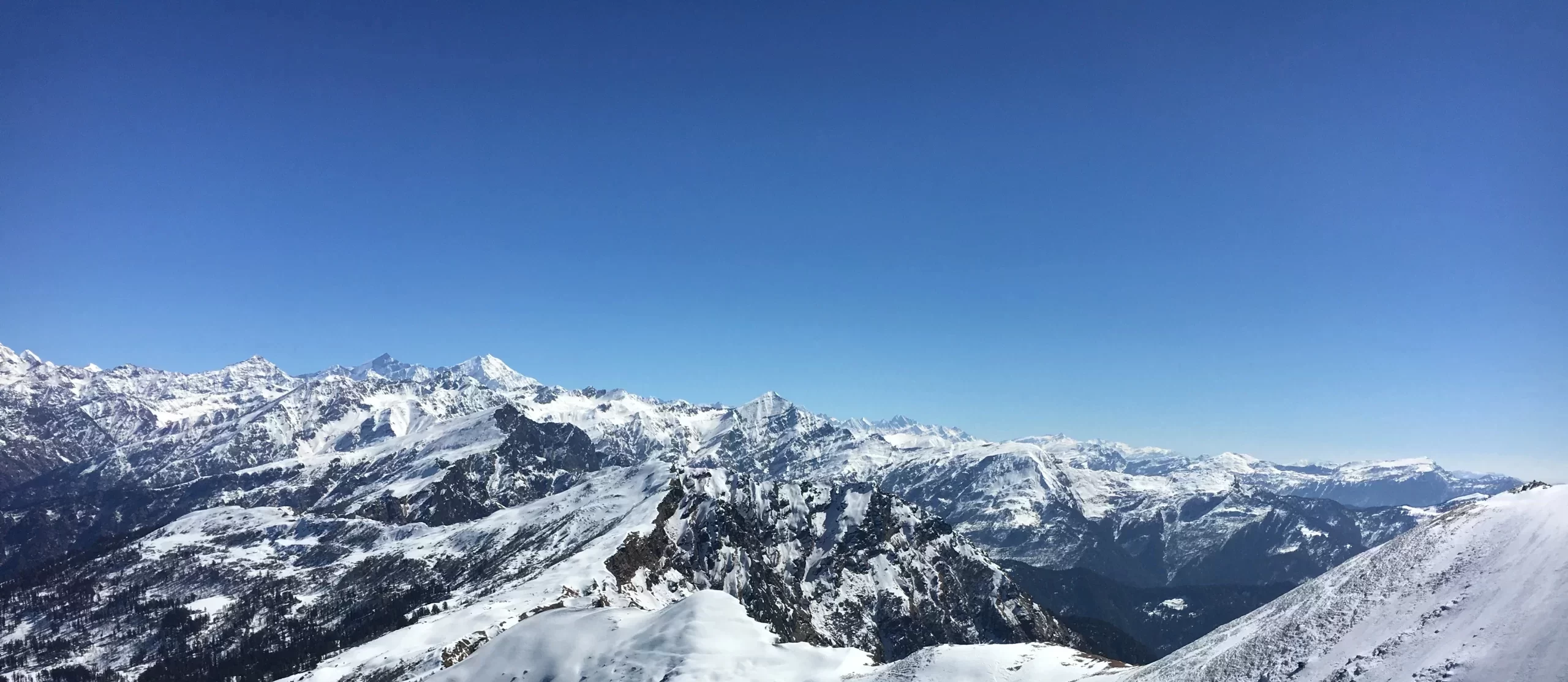
Kedarkantha Trek
The most popular winter trek in india, rated 4.9/5.0 on tripadvisor. 837 reviews, customize your himalayan trip or join our fixed departures, kedarkantha trek overview:, highlights of kedarkantha trek:, 1. sankri: base camp of the trek:, 2. juda ka talab:.
The frozen Juda ka Talab lake, a 3-D view , image credit: khushwant singh
3. Kedarkantha Base Camp:
4. sunrise from the summit of kedarkantha peak:.
3-D view of Sunrise at the Kedarkantha Summit , image credit: Gahan Saraiya
5. The Best Attraction in Winters:
6. cultural exploration:, 7. wildlife on trek:, best time to visit:.
1. Kedarkantha Trek from September to November (Autumn):
2. trek in december, january, february, march, and april (winter and spring):, 3. kedarkantha trek in may and june (summer):, kedarkantha trek difficulty level:, kedarkantha terrain details:.
- Starting Point: From Sankri, some gradual slopes through the oak and pine trees.
- Forest Trails: It passes through deep pine, oak and fir staples. Crossings can be done on water, trails can be very muddy and sometimes to the extent of being slippery.
- Meadows and Clearings: Goes in to open up meadows specially at Juda Ka Talab, with wide open spaces with lots of grassy fields and a great view.
- Snow-Covered Paths: The cross-country trails are covered with snow during winter and early spring. Trekking is not easy due to distinctly different snow conditions. Trekking poles, gaiters, and microspikes are useful.
- Steep Ascent to Base Camp: Hike from Juda Ka Talab to the Base Camp with short steep steps on stones and rocky terrains with many hairpin bends. Views improve with altitude.
- Summit Push: The last trek to reach Kedarkantha is difficult which is steep and path is completely open and many at times it is snow or ice. Must be managed and does require one to have lots of energy.
- Descent: Journey through from meadows and the forest trails. Still a moderately easy hike compared with ascent but a shocker, for knees especially because the slopes are steep.
- Overall, Terrain: It has forest tracks, meadows, and alpine; country characteristics. Varied and interesting trekking experience with different terrains.
Maximize the Kedarkantha Trek Experience with a Good Physical Fitness and Safety Precautions:
Preparation for a good physical fitness:, 1. lower body exercises:.
- Target Body Parts: Quadriceps, hamstrings, glutes, calves.
- Benefits: Strengthens lower body for climbing and descending; stabilizes uneven terrain.
- How-to: Stand feet shoulder-width apart. Lower into a squat, keeping your back straight, then return to standing.
- Benefits: Improves balance and stability on rocky trails; enhances flexibility.
- How-to: Step forward with one foot, lowering your body until both knees are bent at 90 degrees. Push back to start and alternate legs.
2. Upper Body Exercises:
- Target Body Parts: Chest, shoulders, triceps, core.
- Benefits: Strengthens upper body for backpack support and improves posture.
- How-to: Start in a plank position, lower your chest to the ground, then push back up, keeping your core engaged.
Pull-Ups/Bodyweight Rows:
- Target Body Parts: Back, biceps, shoulders.
- Benefits: Enhances posture and reduces back strain; strengthens muscles for carrying a backpack.
- How-to: For pull-ups, grip a bar and pull yourself up until your chin is above it. For rows, use a low bar or TRX straps.
3. Core Exercises:
- Target Body Parts: Abdominals, obliques, lower back.
- Benefits: Improves stability and balance; reduces back pain.
- How-to: Hold a plank position with elbows under shoulders and body in a straight line.
Russian Twists:
- Target Body Parts: Obliques, abdominals, lower back.
- Benefits: Enhances rotational stability and core strength.
- How-to: Sit with knees bent, lean back slightly, and twist your torso side to side.
4. Full Body/Cardiovascular Exercises:
Mountain climbers:.
- Target Body Parts: Core, shoulders, chest, legs.
- Benefits: Improves cardiovascular endurance and agility.
- How-to: In a plank position, alternate bringing knees to chest in a running motion.
- Target Body Parts: Full body.
- Benefits: Boosts cardiovascular endurance, strength, and agility.
- How-to: Perform a squat, jump to a plank, do a push-up, return to squat, and jump up.
5. Additional Tips:
- Consistency & Form: Maintain proper technique and gradually increase intensity.
- Recovery & Flexibility: Allow muscle recovery, and stretch before and after workouts.
- Balance Training: Incorporate strength exercises like deadlifts for overall balance and endurance.
Safety Precautions & Protocols during the Kedarkantha Trek:
1. acclimatization:.
- Importance: Acclimatization helps stabilize oxygen levels in the body. It is crucial for preventing altitude sickness and maintaining physical fitness.
- Spend an extra day at the Sankri base camp or intermediate points to adjust to the altitude.
- Ascend gradually, avoid ascending too quickly.
- Climb high and sleep low. After reaching the campsite, hike to a higher elevation than the campsite's altitude, spend some time there, and then return to the campsite.
- Reduce strength exercises and increase yoga practice with Pranayama or other slow breathing techniques.
2. Weather Preparedness:
- Importance: The weather in Kedarkantha can be unpredictable, with snow and cold temperatures. Knowing weather facts helps trekkers determine the best time to start or not start their trek, and be prepared for any expected weather fluctuations during the hiking.
- Check weather forecasts regularly.
- Be prepared for sudden changes by carrying appropriate gear, such as waterproof jackets or a poncho, and extra pairs of quick-dry socks.
- In the mountains, afternoon rain is more common than other times of the day. So, make sure to start and end your hike before noon.
- If it’s raining continuously, pause on the hike on the spot but avoid stopping near water streams and riffle sections. Try to pass away these areas as quickly as possible.
3. Hydration and Nutrition:
- Importance: Staying hydrated and well-nourished helps maintain energy and health.
- Drink plenty of water at regular intervals throughout the trek.
- Carry high-energy, easy-to-digest foods like nuts, energy bars, and fruits.
- Avoid taking alcohol.
- Avoid consuming sugary foods or drinks during the trek. Excess sugar increases blood glucose concentration, leading to fatigue.
4. Health and First Aid:
- Importance: Immediate response to health issues can prevent serious complications.
- Carry a comprehensive first aid kit, including altitude sickness medication, and be familiar with basic first aid procedures.
- Inform your trek leader of any pre-existing health conditions.
5. Safety Gear:
- Importance: The right gear can prevent injuries and keep you safe in adverse conditions.
- Wear sturdy, broken-in trekking boots with good ankle support.
- Dress in layers to manage your body temperature, especially above the Kedarkantha Base Camp.
- Carry a reliable backpack with a rain cover and other essentials such as a headlamp, rope, oxygen cylinder, gaiters, and microspikes.
6. Emergency Preparedness:
- Importance: Quick action is vital in emergencies.
- The nearest hospital is located in Mori, which is 21 km from the Sanrari Base Camp.
- Keep emergency contact numbers.
- Ensure that your trek leader has communication devices such as a satellite phone or walkie-talkie in case of an emergency.
- Make sure you have appropriate adventure insurance that covers trekking in high-altitude areas.
7. Navigation and Trail Safety:
- Importance: Navigating snowy trails requires caution and skill.
- Follow your guide.
- Follow marked trails and use a compass, maps, or GPS devices to avoid getting lost on the trail.
- Pay attention to trail markers and avoid venturing off the path.
8. Wildlife Awareness:
- Importance: Encounters with wildlife can be a risk.
- Maintain a safe distance from animals.
- Avoid leaving food unattended and keep your campsite clean to avoid attracting wildlife.
9. Group Coordination:
- Importance: Staying connected with your group ensures collective safety.
- Maintain regular communication with your group.
- Follow the trek leader’s instructions and avoid separating from the group.
10. Environmental Responsibility:
- Importance: Protecting the natural environment is essential.
- Follow "Leave No Trace" principles.
- Dispose of waste properly and avoid disturbing wildlife or vegetation.
11. Altitude Sickness Awareness:
- Symptoms: Headache, nausea, dizziness, and shortness of breath.
- If symptoms occur, inform your trek leader immediately.
- Descend to a lower altitude if necessary and seek medical help if symptoms persist.
- On the Kedarkantha Trek, after crossing the Kedarkantha Basecamp (11,250 feet), some trekkers might be affected by AMS. Therefore, keep your walking pace slow and steady until you reach the summit.
Backpacking with essential gear and equipment for the Trek:
Mandatory documents:, accessories:.

Toiletries:
- For trekking in spring, summer, and monsoon: 1 Trek Pant, 1 innerwear (made of nylon), 1 lightweight shirt, 1 fleece Sweater, and 1 poncho
- For Trekking in Autumn, and starting of Winters: 1 Trek Pant, 1 pair of thermals, 1 t-shirt, 1 fleece Sweater, 1 padded jacket, and 1 poncho
- For Trekking in Winters: 1 pair waterproof gloves, 1 Trek Pant, 1 pair of thermals, 1 t-shirt, 1 fleece Jacket, 1 padded jacket, and 1 windproof jacket
- 3 T-shirts (Wear one, carry two)
- 2 pair thermals (Wear one, carry one)
- 2 quick-dry trek pants (Wear one, carry one)
- 3 pair socks (Wear one, carry two)
- 2 pair gloves (Wear one, carry one)
- 1 padded Jacket (Always carry it in your bag, whether you are wearing it or keep it with you in case there is a sudden drop in temperature during evening and morning hours)
Medical Kit:
To reach the base camp of kedarkantha trek:, traveling to dehradun:, dehradun to the basecamp sankri:, private and govt. buses:, regular taxis and cabs:, kedarkantha trek package by himalaya shelter:, dynamic or customised package options for the kedarkantha trek:, kedarkantha trek route map:.
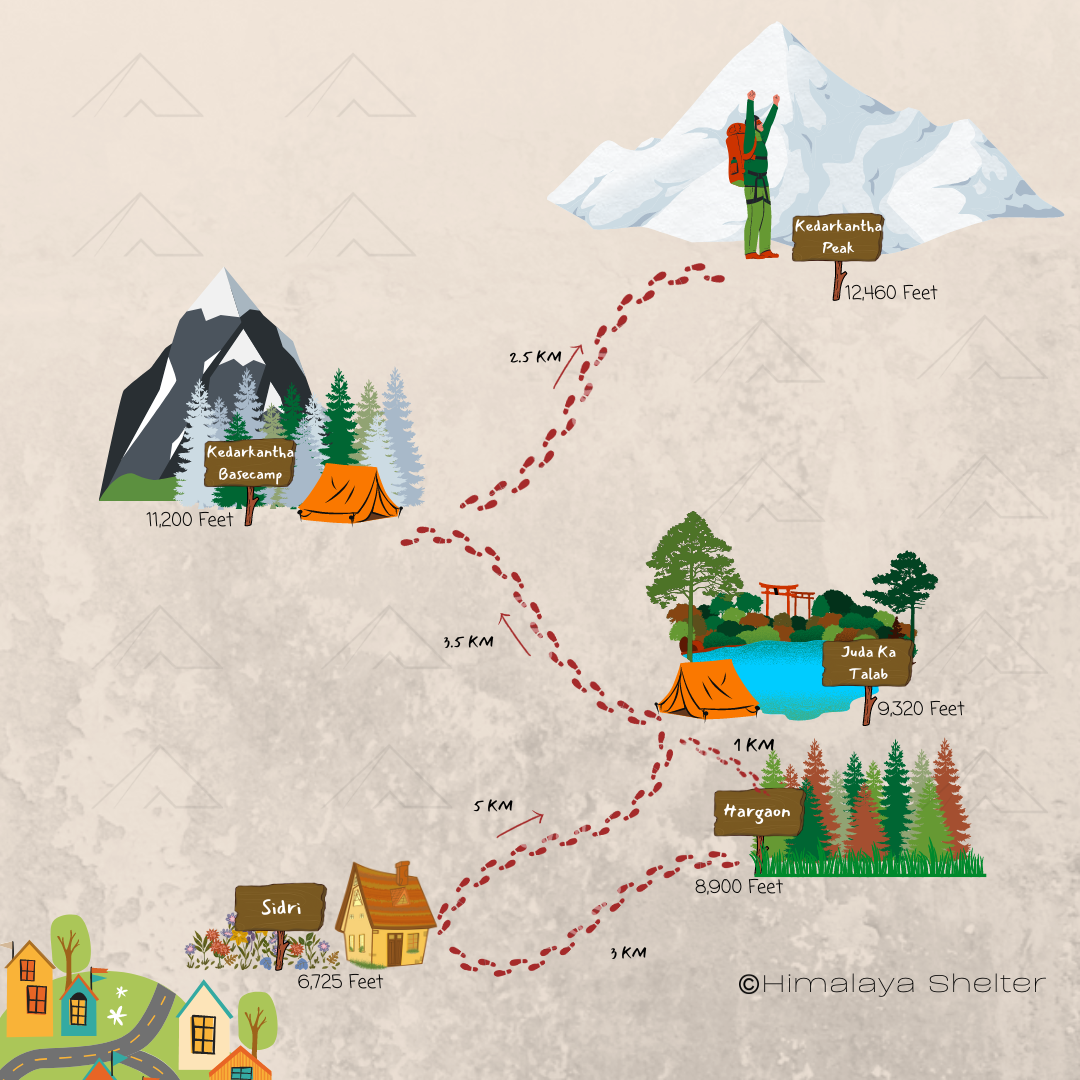
Kedakantha Reviews:
Kedarkantha Trek Itinerary
Day 1 dehradun to sankri (1,920 m): 187 km drive in 8 hours.
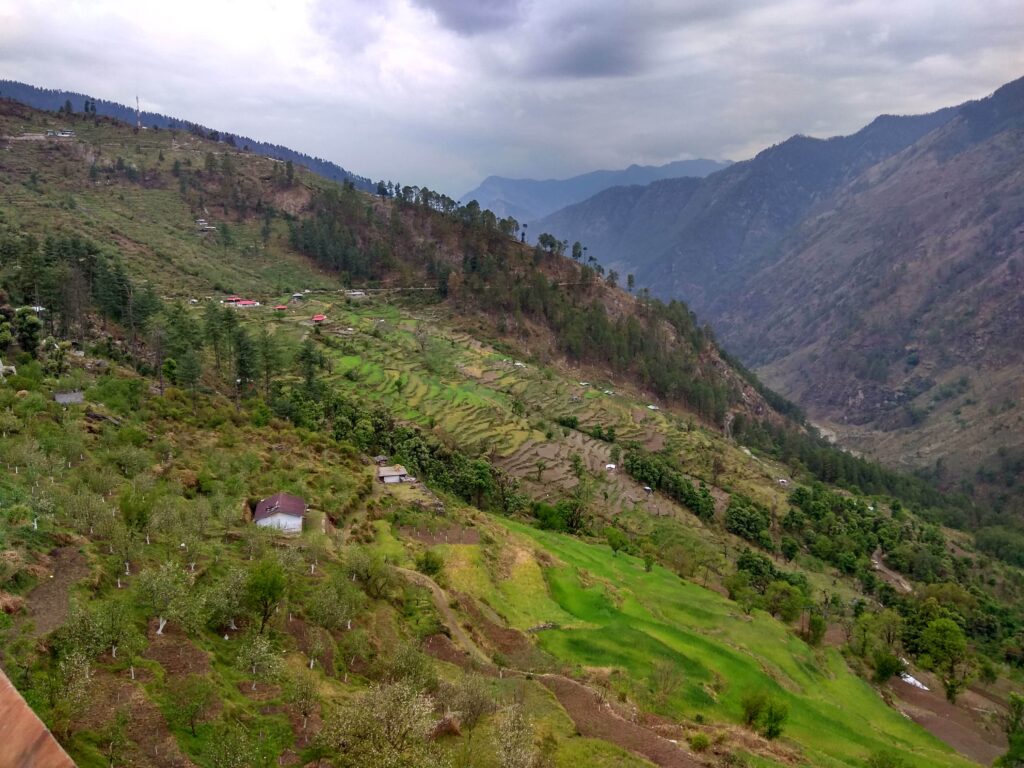
The drive from Dehradun to Sankri takes you through picturesque towns and villages like Mussoorie, Nowgaon, Purola, and Mori. The route is scenic and takes you through a dense pine forest, filling the air with the sweet aroma of pines. After driving through the forests, you’ll reach Mori, where the Tons River joins you on the route. The Tons River is the biggest tributary of Yamuna and is well-known for rafting activities. The 190 km long drive typically takes 8-9 hours to complete, so it’s advisable to start early to reach Sankri by evening. You’ll spend the night at a guesthouse before starting your hike the next day.
Day 2 Sankri to Juda Ka Talab (2,774 m): 4 km trek in 3 to 4 hours
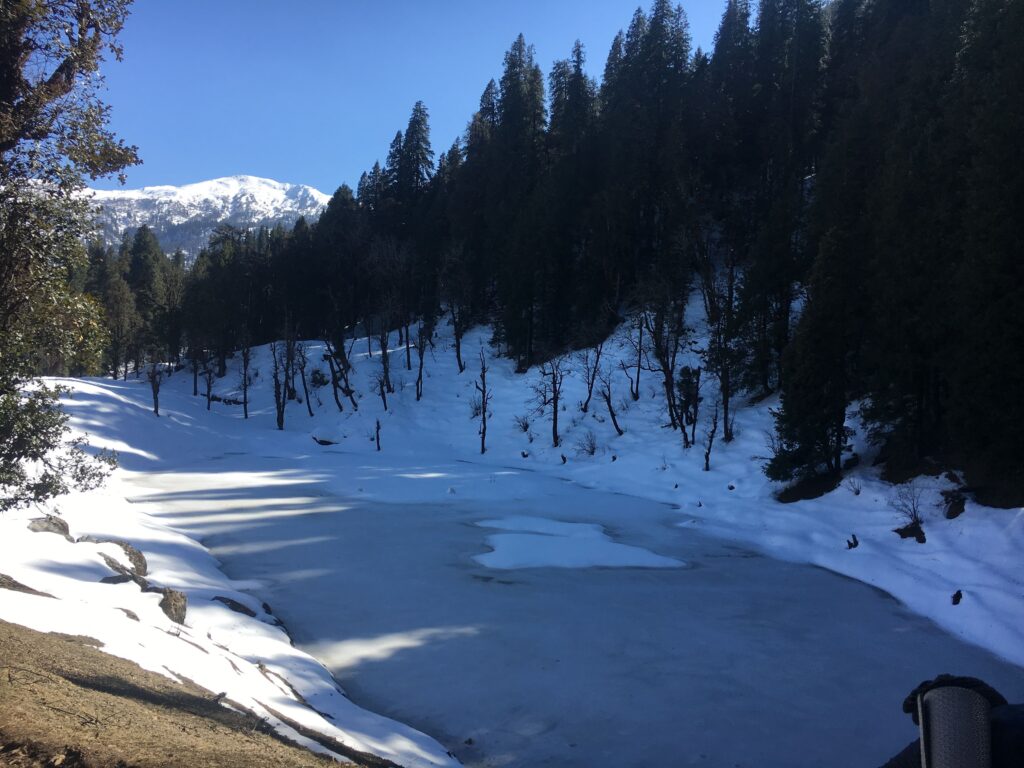
Day 3 Juda Ka Talab to Kedarkantha Base Camp (3,429 m): 4 km in 3 hours
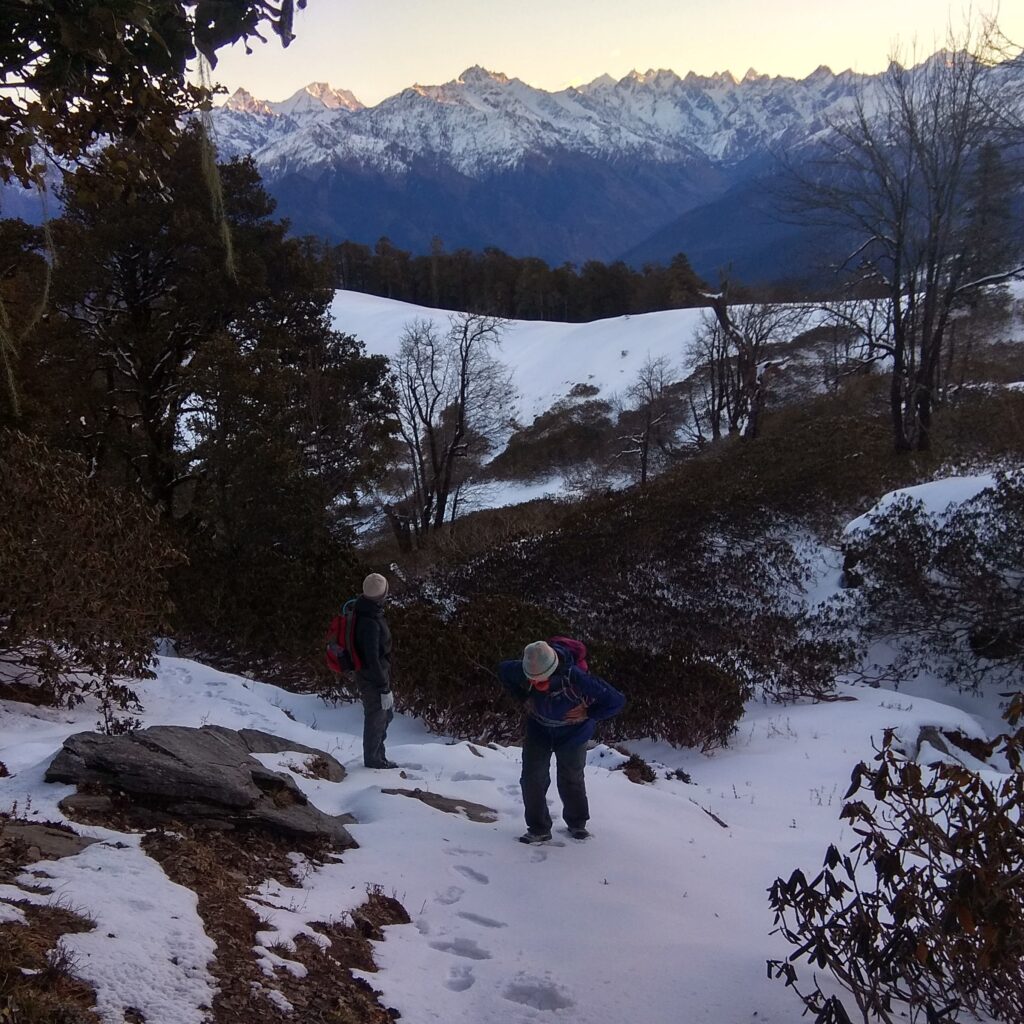
From Juda Ka Talab, the trail leads deeper into dense pine forests until reaching a meadow with shepherd’s huts. Climbing further for another thousand feet, trekkers will finally reach the Kedarkantha base camp, taking around 2-3 hours to complete. The trail from Juda Ka Talab to the base camp is incredibly stunning, providing an ideal setting for photographers and nature enthusiasts alike. Despite being a bit colder due to the lack of insulation, the base camp offers panoramic views of the famous peaks of Uttarakhand, making it an ideal spot for camping.
Day 4 Kedarkantha base camp to Kedarkantha Summit (3,810 m) and back to Hargaon (2,713 m): 8 km in 5-6 hours
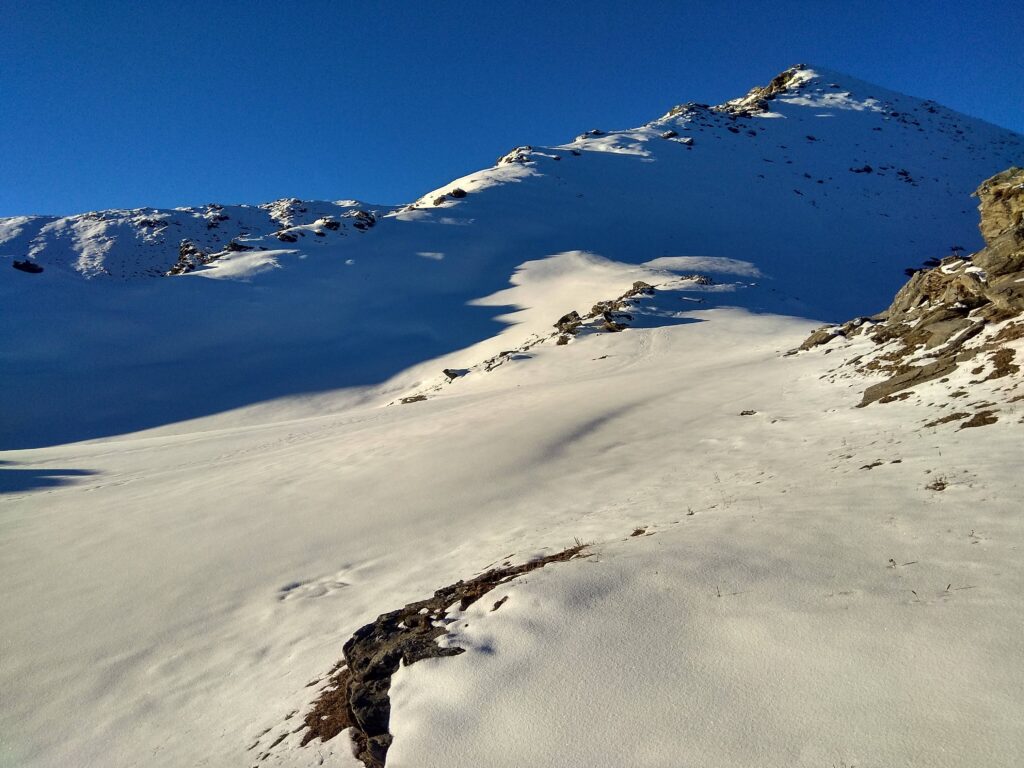
Day 4 is the day you’ve been waiting for! The trek to the summit from the base camp is not long, and upon reaching the top, you’ll be rewarded with a jaw-dropping 360-degree view of the Uttarakhand peaks, the Chaainsheel Pass, and the Kailash ranges of Himachal. You can even see the Har Ki Dun valley below. The Kedarkantha summit is marked by an arrangement of stones with a Trishul pointing to the sky. Legend has it that the peak was meant to be the original Kedarnath temple, but Lord Shiva, who was disguised as a cow hiding from the Pandavas, was disturbed during meditation by the villagers. The interruption made him change his location to the present Kedarnath temple.
After spending time on the summit, we hike back to the base camp and head towards Hargaon (2 km trail) post-lunch. Hargaon is a large camping area en route to Sankri, where we will spend the night before bidding farewell to this beautiful place.
Day 5 Hargaon to Sankri: 4 km trek in 2 to 3 hours
Today is the final day of our trek and we will descend from Kedarkantha to Sankri, which is a 4 km trek taking 2-3 hours. Once we reach Sankri, you can take the rest of the day to explore the charming village and nearby villages like Gangad and Osla, which are known for their warm hospitality and traditional Pahari culture. Sankri is also the last road head to the Govind Balabh Pant Wildlife Sanctuary.
Day 6 Sankri to Dehradun: 187 km drive in 7 to 8 hours

Going back home is always a bittersweet moment, but the journey is made easier by taking the same picturesque road back to Dehradun. As we leave behind the dense pine forests and descend towards the city, the landscape slowly changes and opens up into wider roads. Finally, we arrive in the bustling city, bidding farewell to the serene mountains and valleys of Uttarakhand.
Day 2 How difficult is the trek & what are the challenges?
Kedarkantha trek photos:.

Upcoming Treks
- November 2, 2024 open
- November 3, 2024 open
- November 9, 2024 open
- November 10, 2024 open
- November 16, 2024 open
- November 17, 2024 open
- November 23, 2024 open
- November 24, 2024 open
- December 1, 2024 open
- December 2, 2024 open
- December 3, 2024 open
- December 4, 2024 open
- December 5, 2024 open
- December 6, 2024 open
- December 7, 2024 open
- December 8, 2024 open
- December 9, 2024 open
- December 10, 2024 open
- December 11, 2024 open
- December 12, 2024 open
- December 13, 2024 open
- December 14, 2024 open
- December 15, 2024 open
- December 16, 2024 open
- December 17, 2024 open
- December 18, 2024 open
- December 19, 2024 open
- December 20, 2024 open
- December 21, 2024 open
- December 22, 2024 open
- December 23, 2024 open
- December 24, 2024 open
- December 25, 2024 open
- December 26, 2024 open
- December 27, 2024 open
- December 28, 2024 open
- December 29, 2024 open
- December 30, 2024 open
- December 31, 2024 open
- January 4, 2025 open
- January 5, 2025 open
- January 11, 2025 open
- January 12, 2025 open
- January 18, 2025 open
- January 19, 2025 open
- January 25, 2025 open
- January 26, 2025 open
- February 1, 2025 open
- February 2, 2025 open
- February 8, 2025 open
- February 9, 2025 open
- February 15, 2025 open
- February 16, 2025 open
- February 22, 2025 open
- February 23, 2025 open
- March 1, 2025 open
- March 2, 2025 open
- March 8, 2025 open
- March 9, 2025 open
- March 15, 2025 open
- March 16, 2025 open
- March 22, 2025 open
- March 23, 2025 open
- March 29, 2025 open
- March 30, 2025 open
FAQ's about Trek
What are the things to carry for trek to kedarkantha peak.
Kedarkantha Peak in Winters:-
Adequate Clothing Includes –
- Appropriate Base Layers – i.e. Warmers (avoid cotton warmers/inner wear and choose synthetic or woolen base layers)
- Warm Layer including One Padded or Down Jacket and a fleece or sweater
- A Thin waterproof jacket to protect from Snow, Rain, or wind (Alternatively you can carry a waterproof warm jacket such as a Snow Hiking Jacket which serves the purpose of being warm and waterproof both)
- Two Synthetic Trek Pant/Lowers (avoid jeans, cotton lowers)
- Waterproof Pants (Optional, if using gaiters)
- 1 Warm lower (preferably fleece) for overnight wearing in camp
Equipment & Protective Clothing such as
- Waterproof and Warm Gloves
- Trekking Pole
- Micro Spike (Provided by us)
- Gaiters (Provided by us)
- Woolen Cap/ Scarf
- Neck Gaiter/Balaclava
- Sunglasses (Preferably Polarized if trekking in winter)
- Waterproof High Ankle Shoes
- 3-4 pairs quick drying socks
- 1-2 pairs of woolen socks
- Quick Drying Towel
Why trek with Himalaya Shelter?
“ I have been doing treks with Himalaya Shelter for the last two years and they are awesome people with pure humbleness. “
Writes Priyesh.
We at Himalaya Shelter consider our trekkers part of our community, a family of sorts and really understand the efforts that you put into taking that much-needed break and setting off to the mountains. Some of you may wait for months and even a year to plan out that perfect excursion. That’s why we want it to be “a perfect excursion” for you.
Our testimonials (read below) are a testament to our service-oriented mindset.
We take safety into great consideration and ensure our team is trained to handle emergency situations.
For a better experience, we provide accommodation on Twin Sharing throughout the trek. With most trekking operators you would get triple or even quad sharing accommodation.
Our Accommodation will have attached washrooms
(In Sankri on 1st and 5th Night)
Furthermore, we provide the essential safety gear for your trek – – Crampons – Gaiters Without any additional charges.
We pamper you with great food which keeps you going on the trek. (On our google maps out of 300 reviews over 80 Trekkers mention great food😋)
We do not outsource services to ensure topmost quality throughout your journey. We use our own fleet of Vehicles to ferry you to the base camp and return.
Lastly, being a local operator we are direct stakeholders in the economic and social development of Uttarakhand. Employing locals and helping them progress in their lives goes hand in hand with work. Thus choosing Himalaya Shelter, is a step in helping us help locals progress by ensuring financial independence and social progress.
What will be the pickup point and pickup time from Dehradun on Day 1?
The trek pickup point will be near Dehradun railway station. The exact location will be shared with you prior to departure day.
The departure time remains 7 AM sharp for every group departure.
Trekkers arriving by Flight should ideally arrive 1 day in prior. The Airport (Jolly Grant) is situated at least 1 hour drive away from Dehradun Railway Station in the opposite direction. If you’re arriving by flight it is thus advised to travel a day prior due to lack of early morning flights.
When snowfall starts in Kedarkantha?
Snowfall in Kedarkantha typically starts in late November or early December and continues through the winter months until February.
Is Kedarkantha trek safe in January?
Yes, the Kedarkantha trek in January can be safe, but it also comes with certain challenges due to the winter conditions. The weather can be extremely cold and snowy, so it’s crucial to be cautious and informed before attempting the trek in January.
What is Kedarkantha to kedarnath distance?
The Kedarkantha to Kedarnath distance is approximately 396 kilometers. This distance includes 360 km of driving and 26 km of trekking.
- Kedarkantha summit to Sankri trekking:- 10 km
- Sankri to Gauri kund driving:- 360 km
- Gauri kund to Kedarnath:- 16 km
What is the lowest temperature in Kedarkantha?
The lowest temperature recorded in Kedarkantha was around -12°C (10°F).
What is Kedarkantha Trek route?
The Kedarkantha trek typically starts from the Sankri village to Juda Ka Talab. It is about 4-5 km. From Juda Ka Talab to Kedarkantha Base Camp, it is around 4-5 km. The trail leads through meadows with panoramic mountain views. Then, Kedarkantha Base Camp to Summit is roughly 6-7 km. And finally, Hargaon to Sankri is about 4-5 km. The total trek distance is approximately 20-24 km.
What is the Kedarkantha trek cost?
The Kedarkantha trek price is influenced by various factors such as the time of year, trek duration, group size, and preferences in accommodation and services. You can expect the budget cost between INR 6,000 and INR 12,000 per person for a 4-5 day trek.
This cost typically covers:
- Transportation to and from the trek’s starting and ending points (Sankri / Dehradun / Delhi)
- All meals & Accommodation throughout the trek
- Trekking equipment like Kitchen tent, Dining tent, Toilet tent, etc
- Sleeping bags, Mattresses, Camping stools,
- Trekking permits and fees
- Services of an experienced trek guide and support staff
- Basic First Aid kit
Opting for a group trek is an alternative approach to reduce the overall trek cost. It’s an effective way to cut down on transportation and accommodation expenses. Furthermore, certain operators extend discounts, catering to budget-conscious travelers.
How to reach Kedarkantha trek from Delhi?
The distance from Delhi to Kedarkantha is about 433 km. It takes about 11 to 12 hours of driving from Delhi to Sankri and 10 km of trekking from Sankri to Kedarkantha Peak.
There are three ways to reach the Sankri trek from Delhi.
Kedarkantha from Delhi by Road:-
Bus: Direct buses run between Delhi and Dehradun. They depart from the central bus station in Delhi and arrive at the main depot in Dehradun. Upon reaching Dehradun, you can board another bus that will take you directly to Sankri. After arriving in Sankri, you’ll need to start a 10 km trek to reach Kedarkantha Peak, a journey that typically spans 1 to 2 days.
Kedarkantha from Delhi by Air:-
To reach Kedarkantha from Delhi by air, simply catch a direct flight from Delhi Airport to Jolly Grant Airport in Dehradun. Upon arrival at Jolly Grant Airport, you’ll find a multitude of taxi services available at the exit, ready to take you to Dehradun. From Dehradun to Sankri drive takes around 7 to 8 hrs. Upon reaching Dehradun, you can board another bus that will take you directly to Sankri. After arriving in Sankri, you’ll need to start a 10 km trek to reach Kedarkantha Peak, a journey that typically spans 1 to 2 days.
Kedarkantha from Delhi by Rail:-

It’s recommended to opt for the overnight Kota Express, also known as Nanda Devi Express, departing at 11:50 PM, and arriving in Dehradun at 5:45 AM, aligning with other transportation schedules from Dehradun to Sankri.
How is the Kedarkantha trek route map?
How is the climate of kedarkantha in march.
In March, the weather in Kedarkantha is quite chilly. During the day, temperatures range from about 15 to 10 degrees Celsius, while at night, it can drop to about 10 to 5 degrees Celsius. Sometimes, there might be unexpected snowfall and strong winds. However, for the most part, the sky is clear and sunny, providing stunning views of the snow-covered mountains.
What is the distance of Kedarkantha summit from Sankri basecamp?
The Kedarkantha summit is only about 10 km from Sankri and can be covered in approximately 6 to 7 hours. Most trekkers complete this distance of 10 km in two days, with a daily distance of 4 to 5 km.
Is Kedarkantha trek open in December?
Yes, you can go for the Kedarkantha trek in December. It’s a popular winter trek in India. From December to March, the trek is all covered in snow, making it very special.
But, it can be a bit hard, especially if you’re new to trekking. Kedarkantha weather in December might suddenly change, and there could be a lot of snow and strong winds. The paths can also be slippery.
If you’re thinking of going on this trek in December, it’s really important to be well-prepared and go with a good trekking group. Bring warm clothes, strong shoes, and other things you’ll need for trekking.
How to reach Kedarkantha from Dehradun?
To get to Kedarkantha from Dehradun, first, you need to reach Sankri. Once you arrive in Sankri, begin the trek to Kedarkantha summit, which is approximately 10 km away from Sankri.
How to Reach Sankri from Dehradun :-
Every morning, a limited number of shared cabs and buses depart for Sankri from the vicinity of Dehradun Railway Station.
Govt. Buses and Private Buses-
Only one government bus departs from Dehradun Railway Station to Sankri at 8:00 am. Additionally, two private buses leave around 7:00 am from just outside the Dehradun Railway Station heading to Sankri town. The fare for this journey is approximately Rs. 400 per person, which is roughly the same for both the government and private buses.
Private Cab or Taxies-
You can easily locate shared taxis near Hotel Milan or Hotel Grand, merely a 2-3 minute walk from Dehradun Railway Station. These taxis operate up to Purola, which is 54 kilometers away from Sankri. The journey lasts approximately 5 to 6 hours, with a fare of Rs. 400.
From Purola, you’ll find shared cabs to take you directly to Sankri. However, it’s crucial to bear in mind that these cabs typically depart before noon. Hence, plan to reach Purola in the morning if you choose this route . The cab fare from Purola to Sankri ranges from 200 to 300 rupees. (This fare is applicable only when the taxi is full of passengers; otherwise, the cost may vary based on the number of participants.)
In case you miss the buses or taxis from Dehradun for any reason, or due to personal preference, you also have the option to book a private taxi from the same location or near Prince Chowk, approximately 100 meters away from the Railway Station. This would amount to approximately Rs. 6,000 to Rs. 7,000 for booking a Maxx or Bolero.
Shared or Private Vehicle arranged by Himalaya Shelter-
Himalaya Shelter offers both shared and private transport services directly to Sankri for trekkers. Please note that for shared vehicles, we have fixed departure dates, and it is advisable to book your seats at least a week in advance of the departure from Dehradun. We also offer pickup and drop facilities for your hotel stay in Dehradun.
What is the best time for Kedarkantha Trek?
The best time for Kedarkantha Trek is during the winter months of December to February as the trail to Kedarkantha is completely covered with snow, offering a stunning view of the beautiful landscape and snow-capped mountains of Garhwal Himalayas around the trail. Mt. Swargarohini, Mt. Bandarpunch, and Black Peak are some of the major mountains that look stunning in winter.
Anyone with a moderate level of physical fitness can easily complete the Kedarkantha trek during this time. This period is more suitable for beginners as the trail can be successfully completed even in heavy snow. This period is perfect for beginners to really enjoy the immense pleasure of their first experience on snow-covered landscapes at a high altitude. The climate is generally pleasant and it rarely rains or snowsfall, except that there can be heavy snowfall at sometimes. December is the coldest month when the temperature is often below zero and the rest of the winter months have an average temperature of 15 to 5 degree Celsius during the day and 0 to -5 degree Celsius at night. March to April is best suited for trekkers who want to trek in the snow-clad region as well as enjoy the blooming flowers and rhododendrons making it a perfect combination of winter and spring scenery.
How difficult is the Kedarkantha Trek in winter if I am a beginner trekker?
Kedarkantha trek in winter is considered moderately difficult, but the well-defined trail and gradual ascent make it a good option for beginners. However, without proper gear and basic knowledge of the trail, even an easy trek can become highly challenging and risky.
Below are some of the major difficulty points and skills that can be considered to help reduce the overall difficulty of Kedarkantha trek in winter, especially for beginners:
- Snow-covered trails with slippery patches and vergas: Wear waterproof hiking boots, gaiters and micro-spikes on snowy trails and follow marked footprints. Also use trekking poles for support.
- Cold temperatures in winter: Be prepared with 5 layers of clothing as the temperature can drop below zero.
- Cold weather conditions and heavy snowfall: Make sure you have appropriate gear like ponchos, gloves, mufflers and extra socks. Also, keep a polythene bag to ensure your stuff stays dry in the backpack.
- Steep climb while reaching the summit: Keep your walking pace consistent and move slowly. Also do some general warm-up before trekking.
- Multiple trails increase the risk of getting lost: Always follow the guide and obey their instructions. Trekking with a guide also ensures safety and better way management on snow-covered trails.
- Feeling a little hungry while hiking: Feeling a little hungry while hiking is not a big problem, but it can reduce your overall trek experience. So, carry chocolate bars, nuts and other energy snacks to maintain your energy levels on the trail.
Is there any chance of Acute Mountain Sickness during the Kedarkantha Trek?
Yes, AMS can be expected as the Kedarkantha Trek goes up to approximately 12,500 feet (3,800 meters) above sea level. For most trekkers, this altitude is well attainable. However, those who are sensitive to changes in altitude might face mild symptoms of AMS such as headaches, confusion, vomiting, difficulty in sleeping, dizziness, nausea, and undue tiredness. It should be understood that having a high physical fitness level does not minimize the likelihood of getting AMS because altitude sickness results from variations in atmospheric pressure.
To minimize the risk of AMS, follow these tips:
- Ascend Gradually: Staying away from steep vertical gain is good advice to follow. Travel with care if you want to avoid the development of AMS; the altitude should be changed gradually by no more than 300 m per day.
- Stay Hydrated: Increase the intake of water to the body to reduce the viscosity of the blood, thus facilitating the increased transport of oxygen to the tissues at higher altitudes.
- Avoid Alcohol and Caffeine: Both could dehydrate your body, limit blood flow, and enhance your probability of getting sick.
- Acclimatize Properly: Take appropriate breaks, apply some form of stretching routines, and also try to understand the signs of your body.
If the symptoms do not vanish, one should start to descend as fast as possible, possibly not waiting for the onset of serious problems.
To know more about AMS, read this blog: Acute Mountain Sickness .
Does Himalaya Shelter charge extra cost for participants who arrive late at the pickup point?
No, Himalaya Shelter does not charge any extra cost for a delayed arrival at the pickup point. We generally wait for up to 1 hour after the scheduled pickup time. However, if the delay exceeds this timeframe, travelers will need to reach the Sankri basecamp from Dehradun on their own, and all associated travel expenses will be their responsibility.
What is the cost of the Kedarkantha Trek package offered by Himalaya Shelter?
Himalaya Shelter provides the trek package, offering the trek from Sankri (without transportation) for INR 6,500 per person and from Dehradun (with transportation) for INR 8,000 per person. the package cost covers transportation from Dehradun, accommodation for 5 nights, a variety of meals plan, safety equipment, camping gear, guides, cooks, a First Aid Kit, and a trekking permit. However the trek prices can vary according to the customization features and additional services.
How to find the best cost for a Kedarkantha Trek package?
Generally, the cost ranges from Rs. 6,000/- to Rs. 12,000 per person. Choosing cheaper rates tends to be more likely choosing bad services and frauds. Getting the best services at the best price is a skill. To ensure you are getting the best Kedarkantha Trek cost, consider the following tips:
- Compare Prices : Before you book online, always compare the prices offered by different trekking companies so that you can get the best price. It is important to compare the services that are mandatory to be included in the trek package.
- Book in Advance : Kedarkantha treks should always be planned and booked well in advance of the season, especially during winters, which is the peak time. Due to the high demand, trekking groups often fill up quickly, making it difficult to find booking tickets. Booking in advance can also help you secure early bird discounts on the standard trek cost.
- Look for Package Inclusions : It is important to check the package inclusions carefully because sometimes the trek cost is cheaper due to the hidden cost for different types of services that should be included in the package like transportation from Dehradun to Dehradun (depand on package type ), lunch, accommodation, tea-snacks, hot water, oxygen cylinder, etc. So, always look at the inclusion of services while getting the cheapest price for Kedarkantha trek.
- Group Discounts : Remember, there could be certain offer which are available in groups or just a certain number of discounts.
- Read Reviews : You should read some customer reviews who have had previous experience with the trekking company so that you are assured that the company offers value for money and also meets high standards. Himalaya Shelter is one of the best trekking operators in India known for high quality services and budget prices. This quality service is reflected in the feedback and reviews given by previous visitors and customers .
- Consult Local Experts and Tour Operator : Local trekking agencies or local guides are usually cheaper and they are better acquainted with the trekking trails. Kedarkantha trek is one of the best winter treks in India , which is why there are many companies selling this trek online, but only a few companies like Himalaya Shelter are tour providers instead of outsourcing.
By following these steps, you can identify the best package cost that is suitable for the Kedarkantha Trek.
What is the best time to do the trek and how is the weather?
What are the top highlights of the trek, kedarkantha trek package cost inclusions.
- Pick-up location: Prince Chowk, near Dehradun Railway Station
- Pick-up Time: 6:30 - 7:00 am
- Guest house accommodation for the night stay of first day and the second-last day of the itinerary | Triple Sharing in one room.
- Alpine tent accommodation for the night stay of Day 2, Day 3 and Day 4 of the itinerary | Twin Sharing in one tent.
- Meals during transportation will be excluded.
- Meals will be provided according to a North Indian food menu.
- The package cost includes a total of 5 breakfasts, 4 lunches, 4 evening tea snacks, and 5 dinners.
- BMC & AMC certified Guide.
- Cook and support staff.
- Clean sleeping bags and mattresses
- Good quality ‘A’ shaped or dome tents
- Camping stools, Table
- Crampons and gaiters (only if required)
- Toilet Tent with portable toilet seat
- Kitchen Tent & Cooking Pots
- Dining Tent & Dining Table
- Plates, spoon, glass, bowl (Carry a lunch box for packed lunches)
- Gas Stove & Cylinder
- First-Aid kit with Oximeter and Portable Oxygen Cylinder.
- Forest entry charges for Indian nationals (Additional charges will be applicable for international tourists).
- Porter and mule support to carry camping and cooking equipment NOT personal luggage.
- Your designated hotels may not reopen by the time you reach there. While we are making alternate arrangements, do understand that things may not be as “tip-top” as our designated hotels.
- The gurudwara, Hemkund Sahib may not be open. While we are trying to take permission to go to Hemkund Sahib, if it does not happen, then do understand that the pandemic has put restrictions beyond our control.
Package Cost Exclusions
- Personal expenses like tips, personal medicines, phone calls etc.
- Any transport support during the trek apart from what is included in the package cost.
- Any cost or services not mentioned in the Inclusions.
- Accommodation in Dehradun or in the last day of the trek.
- Adventure Insurance.
- Package cost arising due to unforeseen incidents like bad weather, medical evacuation, roadblocks etc.
- Porter and mule support to carry personal Luggage can be arranged at an additional cost of INR 400 per bag per day (weighing up to 12 kg).
- Keeping the Himalayas clean is our own responsibility. Reduce the use of Plastic when you are in the abode of the Sacred Himalaya. 🌱
- 17-07-2021 to 23-07-2021 open
- 17-07-2021 to 23-07-2021 close
Send Request
Your query has been successfully registered. we will contact you within 24 hours., something went wrong.try after sometime..
Kedarnath Trek Guide
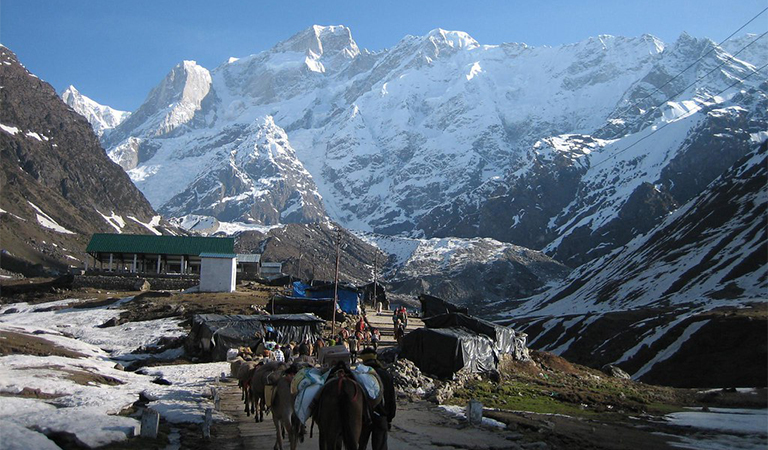
Kedarnath, holding at an altitude of 3,553 meters from the sea level, is located in the Rudraprayag district of Uttarakhand. Of all the Chardham Yatra , Kedarnath Yatra holds greater importance because of its religious significance and also because of the level of difficulty it involves to reach the shrine of Lord Shiva. The journey to this holy shrine includes a trek from Gaurikund . Though Kedarnath trek is known to be very difficult, however, with a well-planned Kedarnath Travel Guide , you can complete it at ease. Shrine Yatra offers you the opportunity to avail a specially curated trek guide to Kedarnath only for you.
Route to Reach Kedarnath by Trek
The devotees need to reach Gaurikund first because the 16 kilometres Trek to Kedarnath begins from there. You can reach Sonprayag from Haridwar, Rishikesh by Taxi or Bus via Guptkashi. You may also avail air route to Guptakashi/Phata/Sitapur via Dehradun or can also do Kedarnath helicopter yatra . You may also reach Kedarnath by Road from Delhi by buses or Taxi. Follow the Route- Delhi >> Haridwar >> Rishikesh >> Devprayag >> Rudraprayag >> Guptakashi >> Sonprayag >> Gaurikund >> Kedarnath . According to the New Trek Route to Kedarnath after the flood, follow the trek route given below:
- Reach Gaurikund from Sonprayag approx 6 Kms by sharing taxi.
- Trek again to Jungle Chatti approx 4 Kms via Rambara Bridge.
- Bheembali Linchauli, approx 4 Kms.
- Reach Kedarnath Base Camp from Linchauli, Approx 4 Kms.
- Visit Kedarnath Temple from Kedarnath Base Camp, 1 km.
Kedarnath Trekking Time
The trek to Kedarnath begins from 4 AM, early in the morning and continues till 1:30 PM in the afternoon. No treks can be commenced after that because Kedarnath is located in the Kedarnath Wildlife Sanctuary so a specific time shall be maintained. Those pilgrims who want to return same day, leave before 5 PM from Kedarnath.
Facilities to Avail During Trekking to Kedarnath
While doing the Kedarnath trek, you can go on foot or you can also avail Palki Dandi, Kandi, Mule or Ponies. Helicopter services to Phata Helipad and others are also available from Kedarnath Helipad. En-route, there are many lodges, guest houses, ashramas and camps where you can find cheap accommodations and good food. There are plenty of refreshment options available throughout the trek route. Tented accommodations, drinking water facilities and some shops and restaurants are available in the route. You can also find several medical and first aid facilities near Lancholi and Base Camp. There are several police check posts and also a government hospital located only 200 metres from the Kedarnath Temple for some medical emergencies.
Things to Remember Before Going for Kedarnath Trek
- Make sure you have medical fitness and you are physically fit to climb the steep slopes. Especially, individuals with respiratory problems and high blood pressure should avoid the trek.
- If you want to avail Palki or Pony services for the trek, then bookings are required either from Gaurikund or Sonprayag.
- Remember not to carry heavy baggage during the trek because it may slow down your trekking pace.
Follow the complete trek guide to Kedarnath to avail a smooth and flexible Kedarnath trek with Shrine Yatra.
Get Free Quotes from Our Tour Expert!
- write for us
- testimonial
- term & condition
- privacy & policy
- we are hiring
- share your travel experience
- nepal tour packages
- himachal trekk packages
- uttrakhand trekk packages
- Sikkim Trek Packages
- flight ticket booking
- hotel booking
- www.shrinetaxi.com
- www.thekumbhyatra.com
pay securely now
Kedarnath Trek – A Complete Guide
Table of Contents
Where is Kedarnath?
Kedarnath (3,553 metres, approximately) is a Hindu temple dedicated to Lord Shiva located in the Rudraprayag district of Uttarakhand. It lies just below the base of the mighty Kedarnath peak (6,940 metres), and is the First Kedar to be visited in case you are staying true to the sequence of the Panch Kedar circuit. The other four being Madhmaheshwar , Tungnath , Rudranath, and Kalpeshwar .

I want to drive there myself. What is the motorable route?
Haridwar – Rishikesh – Devprayag – Srinagar – Rudraprayag – Augustmuni – Kund – Guptkashi – Sonprayag – Gaurikund
Distance from Haridwar to Gaurikund: 237 km
The motorable road ends at Gaurikund, but you’ll need to park your vehicle at Sonprayag. No private vehicles or even taxis from outside are allowed to go beyond Sonprayag . The only option is to board one of the shared taxis that specifically run from Sonprayag to Gaurikund. This more than sorts it out in case you are driving here yourself.
The road is more or less well-maintained except for a few patches that fall under the landslide zone. Road from Guptkashi to Sonprayag is patchy at best.

I want to opt for public transport.
- Take a bus or shared taxi (Max) from Haridwar/Rishikesh to Sonprayag
- Take a shared taxi (Max) from Sonprayag to Gaurikund
Buses, both local and of Uttarakhand State Transport, and shared taxis start plying from Haridwar/Rishikesh to Sonprayag as early as 4 am.
That being said, you should know that all the local buses take their own sweet time and multiple halts. All the buses and taxis will drop you at Sonprayag. After this, there is no other choice but to board another shared taxi to Gaurikund.
It should cost one person 1000-1200 bucks, Haridwar to Haridwar.

How long is the trek? How is the trek route like? Do I need a guide? Is there any Medical Aid available?
Gaurikund – Rambara Bridge – Jungle Chatti – Lancholi – Base Camp – Kedarnath (16 km)
It is a well laid out trek all the way through, paved and pretty straight forward.
From Gaurikund to Rambara Bridge (about 7 km) it is gradual yet easy ascent.
It is a steep, gradual ascent after crossing the bridge at Rambara, all the way to the base camp, where it flattens. The last 1 km or so is an easy walk to the temple.
You do not need a guide. Horses, Mules, Palanquins, and Porters are available at Gaurikund. It’s better to book them at Gaurikund itself; you will find many at several points on trek too but they will ask for a price higher than the altitude you will be standing at.
Medical and First Aid facilities are available at several places including Lancholi and Base Camp. There even is a small government hospital just 200 metres from the temple. And police check posts on several points.

Where to stay, eat, and how much will it cost?
There are many Lodges, Ashrams, Guest Houses, and Camps running from Gaurikund to Base Camp that provide cheap accommodation, both private and government run, including GMVN Lodges at Lancholi and Base Camp . The prices can vary from INR 500 per room to INR 2000 , depending on the rush of pilgrims. While the rates shoot up in May-June (peak season), they also go drastically low in the months of September-October (the best time to do this trek).
However, don’t expect anything in terms of luxury; expect basic rooms, warm quilts, simple but good food. There are plenty of tea/coffee shops on the way that also offer food. Expect to pay around INR 100 for a hearty meal for one person .

Is it possible to do Gaurikund-Kedarnath-Gaurikund in one day?
Yes. It depends on your fitness. We had set out at around 2 am and were back by 5 pm the same day, from Gaurikund to Kedarnath and back. Approximately 35 kilometres in 15 hours, which includes 4 hours of wait in the queue outside the temple (it was May). I’ve been told time and again this is a small feat. I am not proud of it. We were behind schedule and had to make up for it. I don’t like to test my speed against distance. Time to me is mostly irrelevant. I like to walk easy. Sit in silence. Maybe lie down. Take a gander at the grandeur. Look into the soul of these mountains. Feel a beat or two. Click a few pictures. Start again. Repeat again. Must we tie self-made accomplishments to places such as these?
This is the gist of it. If you have any further queries, feel free to leave a comment below or contact me through Facebook or Instagram . I’ll get back to you as soon as I can. Stay safe, travel responsibly!

Type your email…
Photographer by day. Travel Writer by night. And a Copywriter in between.
You may also like
The pahadi organic – a true-blue pahadi experience, kalpeshwar trek – a complete guide, tungnath trek – a complete guide, char dham yatra – finding devotion in destruction, pindari glacier trek – ringing in the new..., deoria tal – of epics, myths, and the..., deoria tal trek – a complete guide, chandrashila – why this should be your first..., binsar – romancing old-world wilderness and the himalaya, madhmaheshwar trek – a complete guide, leave a reply cancel reply, 22 comments.
Very crisp and adequately informative.
Thanks, Papia. 🙂
Hey Bro, Thanks for this description..!!
Thanks for reading, bro.
Hi Mohit..Beautifully written! To the point! I was planning this trek in September this year..Had a couple of doubts…If I start at say 5 in morning from Sonprayag..Take a shared taxi to Gaurikund. how long does the shared taxi take from Sonprayag to Gaurikund? If I start at 5 from Sonprayag, what time can I expect to start the trek from Gaurikund? I plan to reach the temple by say afternoon and stay overnight..Is there any place I can book on the spot to stay overnight and begin my descent the next day? I’ll be traveling solo! Thanks!
Hi Jatin. Thank you for reading! 🙂
- The distance from Sonprayag to Gaurikund is approximately 4 km. It shouldn’t take you more than 10 minutes to reach Gaurikund. However, this will be a shared taxi and it will not start until it can accommodate all the passengers it has the capacity to. So, I’d say add another few minutes. That being said, September is not the peak season; there shouldn’t be any hassles.
You can start the trek from Gaurikund the moment you reach there.
There are plenty of Lodges, Dharamshalas, and Guest Houses around the temple. Finding a room, on the spot, will be no trouble at all.
All the best! 🙂
Hi Mohit. This is an apt description for anyone who wants to go to Kedarnath. I’m planning to go in early October. Just had a couple of queries. Is it better to take a shared taxi from Rishikesh to Sonprayag? Rather than a bus which might halt at every place and as you said will take own sweet time to reach. Don’t mind paying a little extra for taxis if required. Also, apart from the registration for the yatra which can be done online is there any other registration or fitness certificate required before starting the trek? Thanks!
Hi, Rakesh. Thank you for reading. Shared taxis are relatively faster but almost always cramped. Buses are more breathable. Personally, I prefer buses. No fitness certificate is required.
A very detailed guide to Kedarnath trek, Mohit! I read your blog very carefully to understand your experience and other important things about Kedarnath like how will it cost. Thank you for sharing this article I will visit this place with my friends and family.
Thank you for reading, Manoj. 🙂
Very succinct and a treat to read. I loved the combination of pictures clubbed with crisp text for an amazing experience. Great work brother. Can I have a few of these pictures for one of my videos.
Thank you for appreciating. 🙂
The colour tone is just just just awesome.
Thank you for appreciating.
Hi mohit We r planning to go in d month of may .. I ve one clarification.. 1.Can we start trek around 12 pm? Bec we ll reach gowrikunda @11am. 2. Can we stay middle of d trek. Is any accommodation on d middle?
- You can start anytime.
- Please refer to ‘Where to Stay, Eat, and how much will it cost’ section on the post. All the best.
Hello Mohit , For an ordinary people is easy trek or very diffcult?
Hi. The trek itself is not difficult. It might seem a little long and tiring. But should be manageable as long as you take it easy. All the best.
Dear Mohit – All guides are so well written – Every thing at one place – I have saved all these for my preparations when I go
Thank you! Glad I could be of help. All the best.
Hi Mohith, Thank for the blog. Any good suggestion for stay at Gaurikund and at Kedarnath top? Rakesh
Hi. Thank you for reading it. It’s been 6 years since I wrote this. New properties will have come up by now. Even if you don’t have booking, you’ll be able to find one to your liking on the spot. Thank you!
- Weekend +91 87 6262 3333
- Himalayan +91 9886 444 809
- International +91 84968 85968
- [email protected]
- One Day Treks
- Two Day Treks
- Himalayan Treks
- International Treks
- Private Treks
- Group Adventures

- Trek to Kedarkantha Peak
- Secure & Easy Booking
- Best Price Guaranteed
- 1000+ Happy Customers
- Winter Treks 2024 & 2025
Secure your registration with just a 20% deposit today and pay the remainder 30 days before the departure date. Your journey awaits! ✈️
The minute you think of snow trekking in India, one of the most gorgeous treks that come to mind is the Kedarkantha summit trek. This trek is all about introducing you to a winter wonderland unlike any other. This trek is all about exploring the fun side of trekking and is a perfect fit for anyone who's trying their hand at Himalayan trekking for the first time. This trek is easy and comfortable for a novice summiter and gives you every Nomad an opportunity to summit a snow-laden peak in Uttarakhand.
Perfect for a Beginner
The total Kedarkantha trek distance is around 25km. The kedarkantha trek route is easy and just as breathtaking, the trail that this trek has is usually most meant for hardcore trekkers but Kedarkantha is an exception. With the Kedarkantha trek, you can experience an adventure like no other with a thrilling summit climb in a frozen fairyland. Kedarkantha trek height is 3810 m (12,500 ft).
You'll Fall in Love With The Campsites
The best part about the Kedarkantha trek is that the summit is one of the highlights of the trek, other highlights include dramatic campsites with the best-known views in the entire Indian Himalayan region. You'll see that the campsite is surrounded by a forest of snow-capped pine trees and abandoned huts of local shepherds. The sunset seen from the Kedarkantha base camp would be one of the best experiences of your life. Kedarkantha trek best time is in the winter season.
Mind-Bewitching View from the Kedarkantha Summit
It's a known fact that any summit in any part of the world can be extremely rewarding, the Kedarkantha summit is no less. The trail may be extremely beautiful, but the view that you get after your climb to the top is unbelievable. Kedarkantha trek height is 3830 m (12,500 ft). You will notice that some of the mighty Himalayan peaks will be clearly seen from here. From Swargarohini to Black Peak and Bandar ki Poonch in the Gangotri and Yamunotri ranges to Har Ki Dun and glimpses of the Kinnaur Ranges from Himachal Pradesh, the view from the summit is fulfilling, gratifying and unforgettable. Best time for Kedarkantha trek is from December to March.
The Legend of Kedarkantha
Another thing that pulls Nomads to trek to Kedarkantha peak is the deep-rooted mythology that makes this trek extremely mysterious and revered. Kedarkantha is also called "Kedar Khand" which loosely translates to "Section of Lord Shiva", which also happens to be a historic name in the local community. The meaning of Kedarkantha however, is Throat of Lord Shiva . The mythology is that Kedarkantha was where Lord Shiva used to meditate before moving to Kedarnath.
The very famous and beautiful Juda Ka Talab is where the water droplets fallen from Lord Shiva's hair turned into a small pond. The sighting the revered and sacred Swargarohini peak is one of the rewarding attractions of the trek. Swargarohini translates to " Stairway to Heaven " and is the same peak where the Yudhishthira, the eldest of the Pandavas along with his dog reached heaven from this godly peak. Kedarkantha trek price is mentioned below.
Are you interested for Kedarkantha winter trek? Get in touch with us today!
- Day 1: Arrive at Mussoorie
- Day 2: Travel from Mussoorie to Sankri
- Day 3: Trek to Juda ka Talab from Sankri
- Day 4: Trek to Kedarkantha Base Camp from Juda ka Talab
- Day 5: Trek to Kedarkantha Peak from then back to Kedarkantha Base Camp
- Day 6: Trek to Sankri from Kedarkantha Base Camp
- Day 7: Travel from Sankri to Mussoorie
- Day 8: Travel back to home.
Detailed Itinerary for Kedarkantha Trek:
Day 1: Mussoorie
Altitude: 6,170 ft (1880 m)
On Day 1 you arrive in Mussoorie, you will now check-in to a 3-star hotel spend some time unwinding. Later, you meet your fellow Nomads for a quick introductory session after which you will have a short briefing on tomorrow's trek with your trek lead. You will stay the night in Mussoorie.
Day 2: Sankri
Altitude: 6,455 ft (1,920 m) Travel Duration: 7-8 hours
On Day 2, you start traveling towards Sankri from Mussoorie. The beautiful drive takes you through banks of Yamuna river and later Tons river. You will also see picturesque pine trees on the route today. As you arrive in Sankri, you will notice that the air is crisper and extremely fresh, making this a refreshing change from your city life. You check in to a resort in Sankri post-arrival and spend some time relaxing. Sankri, is as gorgeous as can get giving you brilliant photo-opportunities. A good evening stroll around the village is perfect to fill up your Instagram feed & to get yourself warmed up for the trek the next morning. Stay the night at the resort in Sankri.
Day 3: Juda ka Talab
Altitude: 8,858 ft (2,700 m) Trek Duration: 3-4 hours
Today you wake up early, freshen up and after a hearty breakfast, start your trek. The trail today is mostly uphill and takes you through a beautiful forest section for the most part of the trek. To start with, you walk from Sankri to Saur village and from here is where the actual climb starts. Towards the end of today's trek, you reach the famous Juda Ka Talab, the pond that freezes during winters and this is where you will be camping tonight.
Day 4: Kedarkantha Base Camp
Altitude: 11,253 ft (3,430 m) Trek Duration: 3-4 hours
The trek from Juda Ka Talab to Kedarkantha base camp is not long but is definitely steep. The trail gives you good views of the Rupin & Supin valley and goes through the abandoned huts of villagers and shepherds. Post the steep stretch you will walk through pine forests and into a clearing, a meadow surrounded by rich oak and Rhododendron forests on one side. This is the Kedarkantha Base Camp and this is where you will be camping the night. You will be given an early dinner and asked to go to bed quite early after prepping you for the summit climb the next day.
Day 5: Kedarkantha Summit Day
Altitude: 12,500 ft (3,810 m) / 11,253 ft (3,430 m) Trek Duration: 7-8 hours
Today is the day of the summit and you start the trek at 3 AM in the morning. The climb to the summit is about 4-5 hours long and depending on the amount of snow, the trek lead and guide will decide on the best possible way to reach the summit. If all goes well, you will reach the summit just in time for sunrise. From the peak the sunrise is extremely rewarding and astounding. From the peak, you can get a clear view of the Kinner Kailash ranges in Himachal Pradesh. Kedarkantha winter trek offers mind blowing views of the snow clad mountains. You will also see various mountains from the Yamunotri & Gangotri region such as Swargarohini, Black Peas, Bandar ki Poonch etc. and you can also see the Har Ki Dun peak and some other underlying valleys. You will spend some good amount of time on the peak before heading back down to base camp. Upon reaching base camp, you can unwind for the rest of the day and stay overnight in the Kedarkantha Base Camp.
Day 6: Sankri
Altitude: 6,455 ft (1,920 m) Trek Duration: 4-5 hours
On Day 6 you start your journey back to Sankri passing the Juda Ka Talab and finally arriving in Sankri. You can choose to relax in the resort or you can head out for a beautiful walk and catch the glimpse of sunset in the vallet. Stay the night in Sankri.
Day 7: Mussoorie
Altitude: 6,170 ft (1880 m) T ravel Duration: 7-8 hours
Today you start traveling towards Mussoorie. You can expect to arrive in Mussoorie in late afternoon. Check in to your hotel and rest for the day.
Day 8: Your City
Travel back to your city.
Trek Insurance
Trekking in the Himalayas comes with its own set of risks. While adventure is fun and can be extremely thrilling, nature can be unpredictable, and to help secure you during your trek, it is of utmost importance that you are covered with insurance.
We've gone a step ahead and made sure that you don't have to worry about scouting for the best insurance option out there. When you trek with us, your insurance comes as a part of your inclusions. To know more about the benefits covered and sum insured, click here .
Risk and Liability
We will endaevor to make your program smooth and as pleasant as possible. However, the entire course of trekking depends on the ranges of the mighty mountains, physical health, and environmental conditions. Therefore, TrekNomads shall not be responsible for any changes in the itineraries due to unavoidable circumstances and natural disasters such as landslide, road blockage, flood, snowing, cancellation of flight and delay, any type of sickness including altitude sickness.
Fitness Criteria
This trek requires a good level of fitness.
If you're not already following a fitness regime, you would need to follow the regime that will be shared with you. The training routine is spread over four months and you would be expected to work out at least 4 times a week. The regime is designed to help you climb smarter even in higher altitudes. The regime consists of a good combination of exercises that works on all parts of your body including - Upper Body, Core, Endurance, Lower Body, Shoulder strength and along with streamlining your breathing pattern. When followed religiously, you can rest assured that you will be ready for the trek. Not only does this regime help you with the trek, but it will also help you inculcate a sense of fitness in your day-to-day life.
Do’s and Don’ts:
- We believe in leaving the mountains in a better condition, which is why we follow a no-litter policy on our treks. Each trekker will have to bring back the waste that is created during the trek.
- Trekking is best enjoyed when you’ve worn comfortable clothes. Try and avoid wearing Jeans, bright colours and heavy apparel as much as possible.
- A lighter backpack always helps you have a better trek, try and carry just as much as needed.
- Always be in sight of your trek lead, if you feel the need to stop for any reason at all, please keep the trek lead informed.
- If you do come across any reptiles, animals or even insects during the trek, please keep your calm and let it patiently pass by. Any kind of noise and panic will scare them as well.
- Do not venture out into the forest/waterfalls on your own as it may be dangerous.
- Trekking is a good adventure, having said that, it is our primary responsibility to take good care of ourselves and be compassionate towards fellow trekkers
- If, at any point, during the trek, you feel uneasy or unwell, please inform the trek lead immediately
- Tune in to the sounds of nature while on a trek and avoid carrying speakers or playing music during the course of the trek
- To help you enjoy the trek to the fullest, we avoid smoking and consumption of alcohol, and other intoxicants during the course of the trek
- 2 nights stay at a 3-star hotel in Mussoorie
- 2 nights stay at a resort in Sankri
- 3N camping stay along the trail of Kedarkantha
- The majestic view of Swargarohini, Kinner Kailash, Yumnotri, Gangotri, and other Himalayan ranges is a divine pleasure. Kedarkantha gives a 360-degree view of Himalayan ranges.
What is included in the tour
- Transportation to & fro from Mussoorie to Sankri
- 2 nights 3-star hotel stay at Mussoorie
- 2 nights resort/hotel stay at Sankri
- 3 nights tented accommodation during the trek
- Porter for 1 Bag (Max 5-6 kgs)
- Trek equipment: Sleeping bags, Mattresses, Utensils, Ropes
- Tents: Trekkers tent (twin/triple sharing), Kitchen & Dining tent, Toilet tent
- Entry Permit Fee, Guide Fee & Driver Bata
- Standard vegetarian food for breakfast, lunch, snacks, and dinner during trek days
- 1 Mountaineering qualified & professional trek Leader
- Local Guide (Number of guides depending on the group size)
- 1 High Altitude chef & support staff
- Porters for carrying common equipments (like rations/tents/utensils/groceries)
- The facility of keeping extra luggage at Mussoorie when leaving for the trek
- Personal accident insurance
- Insurance, meals, transportations daily salary of guide & porter
- Basic First Aid Kit
- All government, local taxes and service charges
- 15% discount coupon on Gokyo Trek Apparel and Gear
- 10% discount coupon on Fast&Up products
- 20% discount coupon on BMore products
- Personalized Dri-Fit T-shirt
- TrekNomads goodies
What is NOT included in the tour
- The cost to reach Mussoorie and back
- Airport Pick up and Drop Off
- Personal trekking gear
- Tips for guide, chef, porter, etc (calculated per person)
- Excess baggage/porter charges
- Local sightseeing and entrance fee, camera fee, etc
- Mineral water or any type of soft drinks
- Hot water for shower, etc, during the trek
- Extra meals apart from inclusions
- Food during travel days
- Lunch and dinner at Mussoorie 4-star hotel stay
- Any other expenses incurred apart from inclusions
- Any other tickets like cable chair, cable car, etc.
- All personal, medical, evacuation and emergency expenses like extra day stay out of itinerary, helicopter services and vehicle charges due to delays, landslides and evacuation
- Expenses incurred for guide or porter during extra days stay, transport, flight, helicopter service, etc (divided amongst the group which utilises the services of guides/porters on extra days)
- Expenses incurred for accommodation, travel, food, etc due to the closure of trek route by government officials, defence personnel and tourism department based on weather conditions, security concerns, etc
Other Details:
- Trek Gradient: Easy-Moderate
- Trek Distance: 25+ Km
- Assembling Point: Mussoorie
- Travel Distance: 200+ Km
- Best Months to trek: January, February, March, April, May, June, From Mid September, October, November, December
Loading the map...

Recognitions

OTHER POPULAR TOURS
![Valley of Flowers Trek and Hemkund Sahib [Premium] - Tour Valley of Flowers Trek and Hemkund Sahib [Premium] - Tour](https://vl-prod-static.b-cdn.net/system/images/000/326/464/f004eeac1383bb5aea2b18eb9400c343/x400gt/VOF_Banner.png?1684915067)
Valley of Flowers Trek and Hemkund Sahib [Premium]
![Kashmir Great Lakes Trek [Premium] - Tour Kashmir Great Lakes Trek [Premium] - Tour](https://vl-prod-static.b-cdn.net/system/images/000/414/735/bed5a46f080cd0e89659ed19c0c6d7aa/x400gt/TrekNomads_Website_Banner__13_.png?1684931452)
Kashmir Great Lakes Trek [Premium]
![Everest Base Camp Trek [Premium] - Tour Everest Base Camp Trek [Premium] - Tour](https://vl-prod-static.b-cdn.net/system/images/000/352/493/2f06596a5543585d0f67bc5c9eabe2dd/x400gt/Everest_Base_Camp.png?1684317973)
Everest Base Camp Trek [Premium]
OTHER ACTIVITIES

- Testimonials
- Customized Private Treks
- Corporate Outings
- Cancellation Policy
Online booking system by Vacation Labs | © 2024 TrekNomads
.png?w=auto&h=400)
Kedarnath Trek
Kedarnath trek overview.
Kedarnath trek is a remote trek that starts at Gaurikund, which is the base camp of the trek. It is a moderate-level trek and can be embarked on by even novice trekkers without any prior experience. The Kedarnath trek distance is 16 km and you will need to trek for 5 to 6 hours to reach the Kedarnath base camp at an altitude of 3583 m. Trekkers who are not accustomed to long journeys and high altitudes may find it difficult to complete the trek. Hence reasonably good physical fitness is required for this trek.
Experience the incredible natural beauty as you journey from Rishikesh to Sonpragyag. The first base camp of the Kedarnath trekking is at Gaurikund, which offers a magnificent range of himalayan range which can be explored by a jeep or shuttle feeling spellbound looking at the surroundings.
The trek from Gaurikund will start the next day and for 5 to 6 hours you will be captivated with the beauty of the surrounding mountains, running streams and greenery. See the tips of the snow covered mountains which will become more and more visible with your ascend. Witness the peaceful energy as you get to see the famous Kedar Nath Temple as your top destination. Get blessings from one of the temples of the Chota Char Dham of Uttarakhand which is dedicated to Lord Shiva. There will be several points on the way where you will be able to make a stop including Jungle Chatti, Bheem Bali, Linchauli and finally Kedarnath Base camp.
Book Kedarnath Trek Package
You may also book.
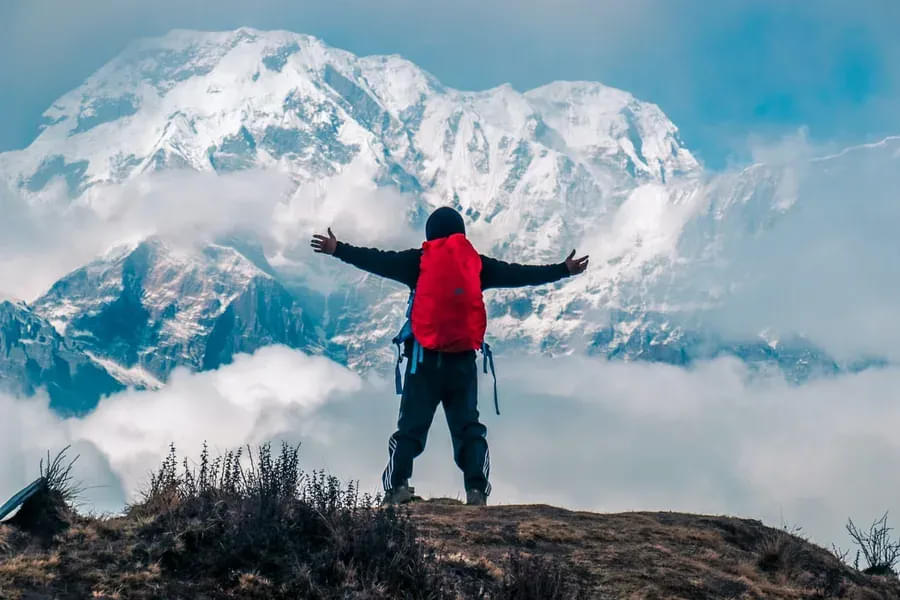
Quick Facts of Kedarnath Trek

Kedarnath Trek Maximum Altitude: 3583 m
Grade: Moderate
Kedarnath Trek Duration: From Gaurikund to Kedarnath: 7 to 8 hours
Trekking distance: From Gaurikund to Kedarnath: 16 km
Trail type: Medium to steep
Railhead: Nearest Railway station is Rishikesh Railway station, 221 km from Kedarnath
Airport: Jolly Grant Airport, near Dehradun, about 239 km from Kedarnath.
Snow Season: November to April
Service from: Delhi
Base camp: Gaurikund
Best season: Summer (April to June)
Region: Garhwal Himalayan range near the Mandakini river, in the state of Uttarakhand, India.
Who can participate: Anyone who is physically fit can participate as there is no prior experience that is required for this trek.
Short Itinerary for Kedarnath Trek
Day 1: Arrival in Delhi
Day 2: Travel from Delhi to Haridwar (By Train - 217.6 km)
Day 3: Drive from Haridwar to Guptkashi (Altitude 1,319 m) (By Road - 203.5 km)
Day 4: Travel from Guptkashi (Altitude 1,319 m) to Gaurikund (Altitude 1982 m) and then Trek to Kedarnath (Altitude 3583 m) (By Road - 15.3 km & Trek - 14 km)
Day 5: Trek to Vasukital( Altitude 4,135 m) (Trek - 8 km) and Back to Kedarnath(Altitude 3583 m) (Trek - 8 km)
Day 6: Trek to Gaurikund (Altitude 3583 m) (Trek - 14 km) - Drive to Rudraprayag (Altitude 690 m) (Drive - 41.2 km)
Day 7: Drive back to Rishikesh (By Road - 141.7 km)
Day 8: Travel back to Delhi
Kedarnath Trek Detailed Itinerary
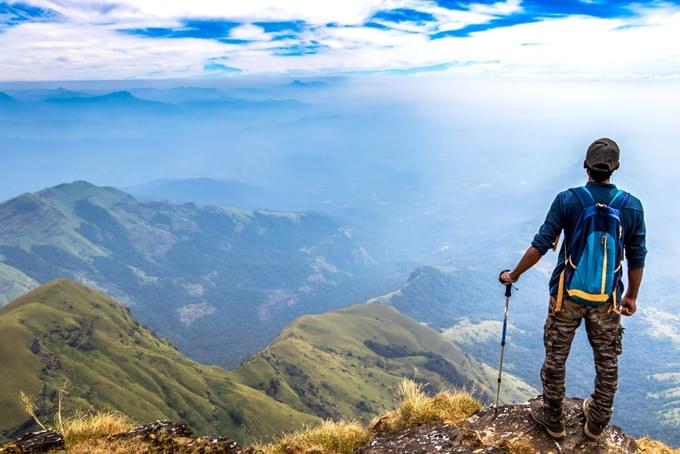
Arrival in Delhi
Your Kedarnath trek will start as soon as you arrive at Indira Gandhi International Airport in Delhi.
You will be transferred to your hotel in a spacious and comfortable vehicle.
Check in for the night and take a rest in the hotel after enjoying a delicious dinner.
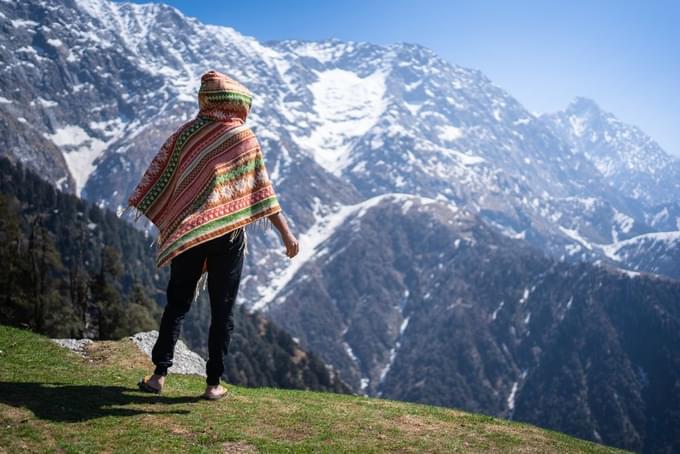
Travel from Delhi to Haridwar by train
Distance: 217.6 km
Duration: 6 hours and 20 minutes
On the second day of your Kedarnath trekking trip, you will need to wake up early in the morning and check out of your Delhi hotel after having a sumptuous breakfast.
You will be taken to the railway station in a comfortable vehicle and board the train for Haridwar.
Enjoy the journey to Haridwar for 6.5 hours and arrive at the Haridwar railway station.
You will find yourself heading towards your place of accommodation in a spacious and comfortable car.
Spend the evening exploring the local attractions of the town at a leisure pace on your own.
Return to the hotel to have a delicious dinner in the night.
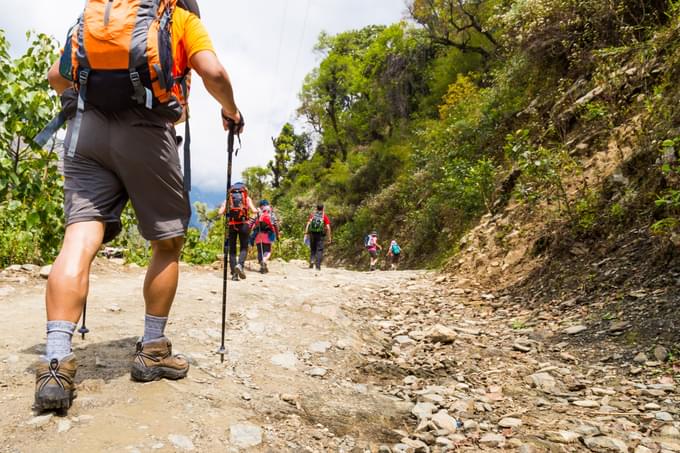
Drive from Haridwar to Guptkashi
Altitude: 1,319 m
Distance: 203.5 km
Start your day 3 with a hearty breakfast and then check out of your Haridwar hotel.
You will be proceeding towards Guptkashi by road. You will be traveling 203.5 km via National Highway 7.
Reach Guptkashi after 6 hours and 20 minutes and check-in your hotel.
Freshen up, spend some time exploring the city and then enjoy a scrumptious dinner, and rest overnight at your hotel.
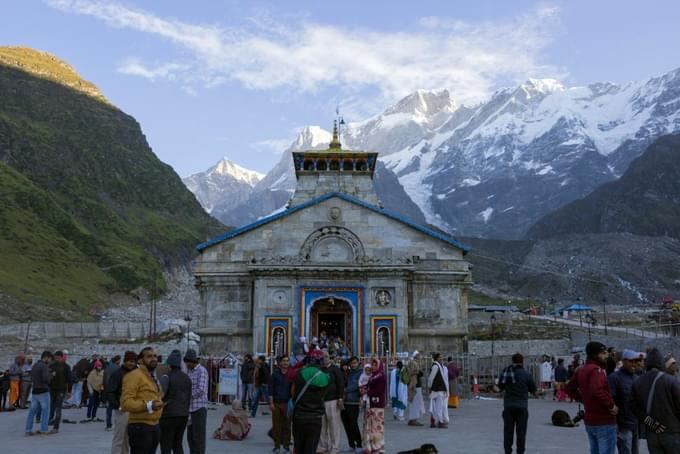
Travel from Guptkashi (Altitude 1,319 m) to Gaurikund (Altitude 1982 m) and then Trek to Kedarnath (Altitude 3583 m)
Altitude: 1,319 m to 1982 m to 3583 m
Distance: By Road - 15.3 km & Trek - 14 km
Duration: By Road - 1 hr 12 min & Trek - 6 hours
Start your morning with a delicious breakfast and feel energized to start the most important day of your trekking tour when you will finally trek to Kedarnath dham.
Check out of your hotel and proceed on your journey to the base camp of the Kedarnath trek, Gaurikund from where you will proceed to Kedarnath temple located at an altitude of 3583 m.
Ensure you start on time to reach there on time as trekkers are only allowed between 4:00 AM to 1:30 PM.
The Kedarnath trek distance is 16 km and will take you 5 to 6 hours to reach.
Carry your packed lunch and start your trek.
Your 1st stop will be Jungle Chatti at 4 km from Gaurikund which you will reach after trekking through the Rambara Bridge.
Take a break to enjoy the stunning view before you continue for another 3 km to reach Bheembali.
Your scenic journey to Bheembali will include a magnificent view of snow-covered mountains and temple walls.
Continue on Kedarnath trekking for 4 km more to reach Linchauli and take a break and enjoy the stunning mountain view.
Next, proceed towards Kedarnath base camp which is at a distance of 4 km from Linchauli and located at an altitude of 3583 m.
From this location, you will be able to watch the panoramic view of the valley, where you can enjoy the tranquil ambience of the place and explore the lush surroundings.
Reach Kedarnath and stay overnight at the hotel after a mouthwatering dinner.
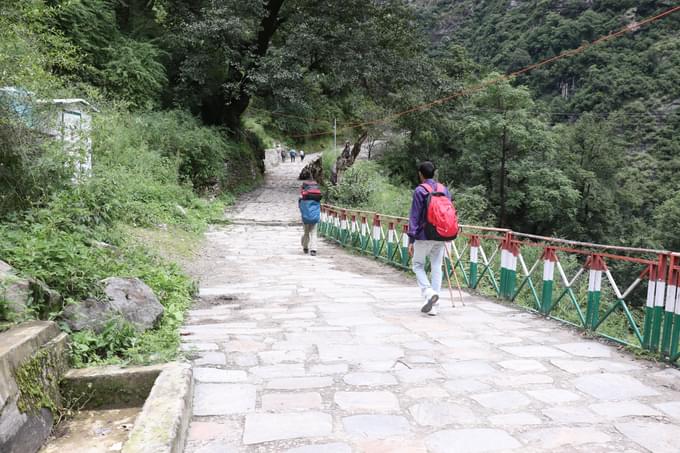
Trek to Vasukital( Altitude 4,135 m) (Trek - 8 km) and Back to Kedarnath(Altitude 3583 m) (Trek - 8 km)
Altitude: 3583 m to 4,135 m
Distance: 8 km
Duration: 5 -6 hours one way
Start your morning with the breathtaking view of the surrounding mountains and get ready for visiting one of the famous temples of India. Visit the temple to offer your prayers and receive Lord Kedarnath’s blessings.
Carry your packed lunch and start your picturesque trek to Vasuki Tal.
Reach Vasuki Tal and feel enchanted looking at the beauty of the pristine and explore the area to enjoy the natural splendors for a while.
Start your descent to Kedarnath in the evening and reach your hotel to enjoy a piping hot dinner and retire for the night.
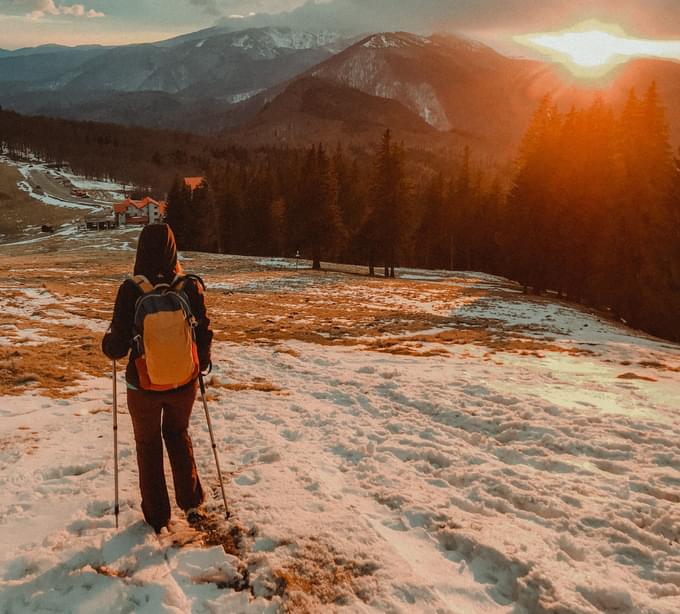
Trek to Gaurikund (Altitude 3583 m) (Trek - 14 km) - Drive to Rudraprayag (Altitude 690 m) (Drive - 41.2 km)
Altitude: 3583 m to 690 m
Distance: Trek - 14 km & By Road 41.2 km
Duration: Trek - 6 hours, Drive - 2 hr 46 min
Wake up to the scenic beauty and tranquil ambience of Kedarnath and enjoy a healthy breakfast at your hotel.
Start your descending trek to Gaurikund and carry a packed lunch with you.
Trekking for 6 hours to cover the distance of 14 kms down to reach Gaurikund.
Once you reach Gaurikund, you will start your journey to Rudrapayag by road. Reach Rudraprayag after travelling for 2 hr 46 minutes.
Reach your hotel, have a mouthwatering dinner and rest overnight.
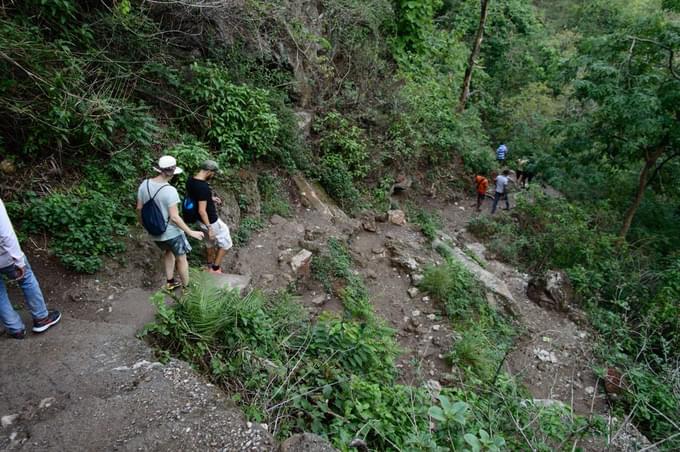
Drive back to Rishikesh (By Road - 141.7 km)
Distance: 141.7 km
Duration: 4 hr 10 min
Wake up in the morning and enjoy a flavourful breakfast at your hotel.Check out of your hotel and proceed on your journey to Rishikesh by road.
Reach the city of Rishikesh in about 4 hours and 10 minutes, travelling a distance of 141.7 km.
Reach Rishikesh, check-in your hotel and freshen up.
Enjoy a delicious hot dinner before you retire to rest overnight at your hotel.
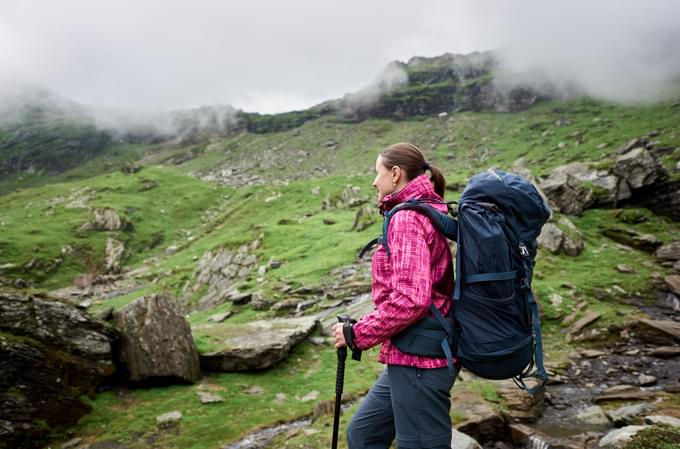
Travel back to Delhi
Distance: 268.1 km
Duration: 5 hr 7 min
Wake up on the last morning of your Kedarnath trek to the serene atmosphere of Rishikesh and enjoy a hearty breakfast at your hotel.
Check out of your hotel and proceed for a sightseeing tour of the Yoga Capital of India.
Complete sightseeing by evening and proceed towards the Haridwar railway station in a comfortable and spacious vehicle and leave for Delhi.
Your trekking trip comes to an end at Delhi railway station from where you will proceed on your onward journey back home with wonderful memories of the amazing places you have visited.
Things to Carry for Kedarnath Trek

Mandatory Documents:
- Original as well as photocopy of any government photo identity card such as Driving License, Aadhar Card, Voters ID, etc.
- Passport and Visa need to be provided by International Travelers
- Medical Certificate (the first part needs to be filled by a registered Doctor and you will need to fill up the second part)
- Certificate of Declaration
- Trek Pants will be more comfortable during the trek than jeans or trousers.
- Jackets to protect you against chilly weather.
- Warm clothing such as fleece or woollen layers for nights.
- Thermals to keep you warm at night.
- T-shirts which are more comfortable than shirts and dry fast.
- Raincoat to keep you dry in case there is rain.
- Head cover such as a cap or balaclava to protect your head during the trek.
- Socks (woolen and regular)
- Do not carry too many clothes as you have to carry them during your trek.
Get yourself sturdy well-fitted trekking footwear so that your feet do not hurt during the trek.
Other Essentials:
- A strongly built 50 to 60 liters backpack with a good support is an absolute must for a trek. Ensure there is a rain cover as well.
- Personal toiletry items such as toothpaste, toothbrush, toilet paper, sanitiser etc. and must carry sunscreen to protect your skin.
- Personal medical kit with items such as prescribed medicines and common ones for altitude sickness, pain relief, headache, fever, stomach problem, motion sickness, allergies, diarrhea, etc. Also an antiseptic cream, a pain relief spray, bandage and cotton for cuts.
- Hiking pole for support during the trek.
- Water bottle to refill with water to hydrate yourself during the trek.
- Sunglasses for protecting the eyes.
- Woolen and waterproof gloves to protect your hands.
- Torch to use at night.
- Camera with rechargeable batteries to capture the scenic beauty.
Know Before You Go for Kedarnath Trek
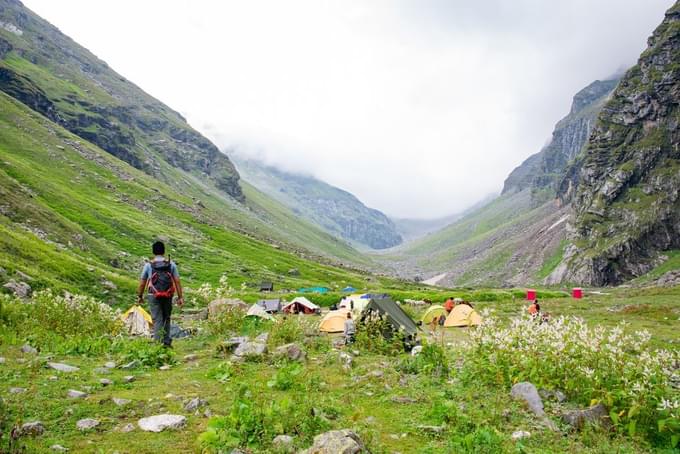
Get your medical checkup done to ensure fitness before you go on a trek.
People with heart, respiratory and blood pressure problems should not go trekking without a doctor’s advice. The trek is also not recommended for pregnant ladies.
You will need to abide by government rules and complete the trek within the stipulated time frame of 4 am to 1.30 pm.
Pay attention to your trek instructor and follow the traditional Kedarnath trek route.
If you are unable to complete the trek in a day, there are several places in between where accommodations are available.
Carry some light snacks such as dry fruits to keep you energized. You can also stop at the several food stalls and eateries on the way to get some food.
Wear clothes and shoes that are comfortable for trekking.
Carry a medical kit which may come in handy for sprains, cuts etc.
Be careful as you walk. Do not get distracted while walking, which might result in losing your foothold and spraining your legs.
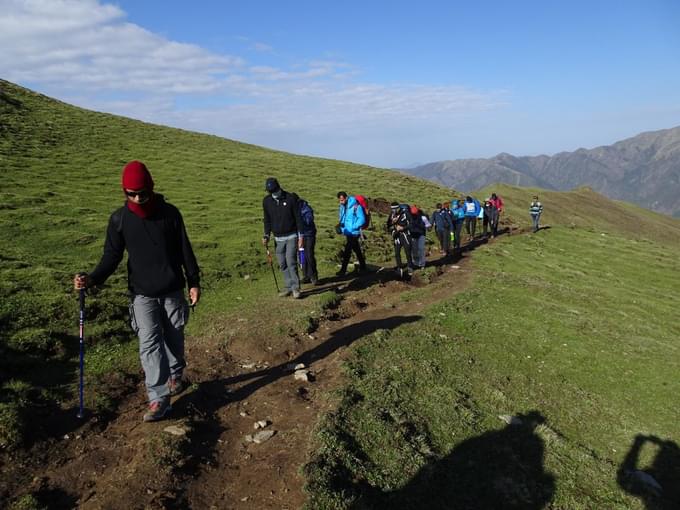
There is only one route which you will be taking when you go on your Kedarnath trek.
Base Camp: Gaurikund: You will be starting at the base camp at Gaurikund which is located 5 km from Sonprayag. Your vehicle will take you to Sonprayag and from there you have to travel by shuttle or jeep to reach Gaurikund.
First Stop: Jungle Chatti: Once you start from Gaurikund, you will need to trek through the Rambara Bridge for 4 km to reach Jungle Chatti.
Second Stop: Bheem Bali: The trek from Jungle Chatti to Bheem Bali is 3 kilometers and has a spectacular view of snow-capped mountains and temple walls. There are accommodations available here for those who want to take a break or stay the night.
Third Stop: Linchauli: Next is the 4 km trek from Bheem Bali to Linchauli. The trail has a stunning mountain view for you to enjoy. Linchauli also has accommodations for those who wish to stop and stay the night.
Fourth Stop: Kedarnath Base Camp: You will need to travel for 4 km from Linchauli to reach the base camp. You can opt to stop here for the night or proceed to reach the temple.
Final Destination: Kedarnath Temple: You will only need to travel for 1 km to reach the Kedarnath Temple, your final destination.
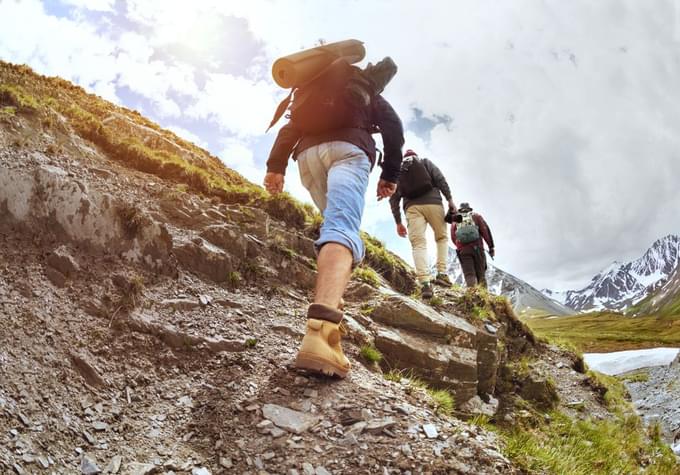
Summer (April to June): During this time, the weather is comparatively warm and there is no rain and snowfall. You will be able to enjoy trekking during these months as the temperature will be mild. Also, the weather is ideal for visiting the temple, sightseeing and indulging in activities. The temperature is around 17 degrees during these months.
Autumn (September to October): The weather during these months is favourable, making it ideal for trekking. You will be able to enjoy the scenic beauty of the surroundings with the clear sky while travelling during these months.
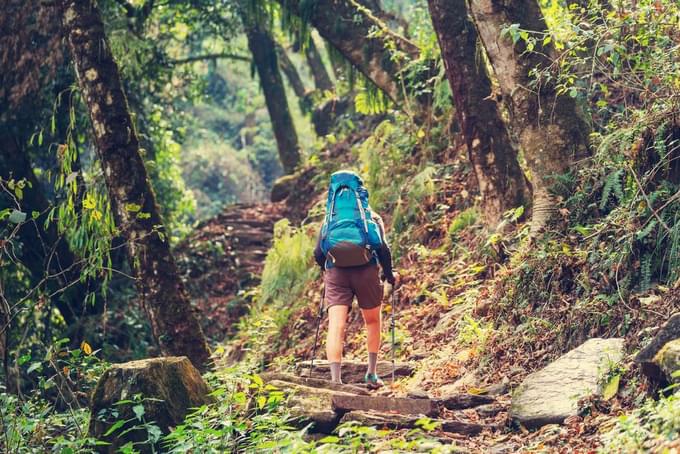
By Air: Rishikesh does not have an airport of its own but you can fly to its nearest airport, Jolly Grant Airport in Dehradun. The airport received daily flights from several major cities in India. You will need to travel for 35 km to reach Rishikesh from Dehradun. You can opt for a taxi or go for bus services available from Dehradun. The other alternative is to reach Delhi by flight and take a bus to reach Rishikesh.
By Road: Rishikesh is well connected with several cities and states by road by National Highway 58. You can get buses from Delhi, Haridwar, Dehradun and other places and reach one of the two bus stands of Rishikesh - the Main Bus Stand and the Yatra Bus Stand. Alternatively, you can also take a rented vehicle and travel by road. If you are traveling from Delhi, you can reach in 6 to 7 hours via Modinagar and Roorkee. Those traveling from Dehradun can also opt for a shared jeep.
By Train: Rishikesh has its own railway station but only few trains which run on a daily basis. Hence, it might be better to travel by train to Haridwar which is well connected with major cities of India. Once you reach Haridwar, you will need to travel for 25 km to reach Rishikesh by a bus or a taxi.
General Trivia About Kedarnath

Kedarnath in local dialect means ‘lord of fields’, named after Kedar, the deity who is an incarnation of Lord Shiva who is considered to be the embodiment of all passions - love, fear, hatred, death and mysticism, expressed through his various forms.
Legend has it that Lord Shiva hid in a form of bull to avoid the Pandavas. One of the Pandavas, Bhima recognised him and tried to capture the bull from behind. But before Bhima could catch the bull, it disappeared, and later the hump of the bull appeared in Kedarnath and is worshiped since then.
Why to Go for Kedarnath Trek?
Going for the Kedarnath trek is one of the most popular and scenic treks in India, where you find beauty, peace, and amazing memories. It is a highly celebrated pilgrimage site and is one of the Chota Char Dham or Char Dham of Uttarakhand. The temple is located at an astonishing height of 3583 m and is very near to Chorabari Glacier, the birthplace of the Mandakini River. The whole area is covered with snow-capped mountains and is spectacular to look at. Once you start your journey from Rishikesh, you will be mesmerized by the stunning scenic view, first of the Ganges flowing along with you and then by the beauty of the famous Kedarnath Mountain. The trail is not too difficult, hence if you enjoy a good health condition, you can go for this trek, even if you are a novice.
FAQs of Kedarnath Trek
How difficult is the kedarnath trek.
Being at an elevation of 3583 m, Kedarnath trek may prove to be a moderate-level trek, which is strenuous for those trekkers who are beginners. Hence, it is strongly advised that they go for a medical fitness test to ensure that they are physically fit. They should also learn about altitude sickness and inform their trekking guides as soon as any symptom is noticed. People with heart, respiratory and blood pressure problems should not go trekking without a doctor’s advice. The trek is also not recommended for pregnant ladies. Those who feel that they will not be able to continue the trek for 5-6 hours may take a break at Bheembali or Linchauli and stay overnight and continue the journey the next day.
Is the Kedarnath trek safe?
Yes, the Kedarnath trek is very safe and reliable, in spite of being located at a high altitude. The government has taken initiative to build new trails and better safety protocols to ensure safety for all trekkers.
Can the Kedarnath trek be completed in one day?
Yes, it is possible to complete the trekking in one day. The trekking trail from Gaurikund to Kedarnath camp is 16 km and it takes 5 to 6 hours to reach there. If you start early in the day, it is possible to complete the trek in a single day. However, the Kedarnath trek is also adventurous and strenuous, so you will need to plan the trip as per your ability.
Can we do the Kedarnath trek at night?
No, as per Government norms, you can only do the Kedarnath Trek between 4 am till 1:30 pm. This timing has been set keeping in mind the safety of the travelers. So if you start late and cannot complete the trek by 1:30, you can make a stopover at Jungle Chatti, Bheem Bali or Linchauli and start your journey the next morning.
What clothing should I wear for the Kedarnath trek?
It is preferable to wear clothes which are comfortable. The best is to wear trek pants, t-shirts and a jacket. You must carry woolens as it will be chilly once you reach the top. Wear a head cover such as a cap to cover your head. Wear a sunglass for eye protection and wear sturdy well-fitted trekking footwear so that your feet do not hurt during the trek.
Where should I stay while trekking in Kedarnath?
There are several hotels and guest houses at Sonprayag as well as Gaurikund where you can stay before or after your trek. Guest Houses and cottages are also available at Kedarnath Base Camp for you to stay in once you reach the final destination. You can also stay at guest houses and dormitories near the temple as well. If you need to stop during your journey from Gaurikund to Kedarnath Base Camp, you can stay at accommodations available at Jungle Chatti, Bheem Bali or Linchauli.
What are the common mistakes that you need to avoid while trekking?
Do not carry too much weight.
Do not hike too fast or slow.
Do not wear clothes which can make you uncomfortable.
Do not go on the trek without consulting a doctor to ensure fitness.
Do I need to register with the Uttarakhand Government before going for the Kedarnath trek?
Yes, you will need to register with the Uttarakhand Government before going for the Kedarnath trek. You can either register online beforehand or register at Sonprayag before your trek.
Treks in Himachal
Treks in uttarakhand, weekend treks in india, treks in ladakh & kashmir, treks in nepal, treks in sikkim.
.png?w=auto&h=400)
The content and images used on this site are copyright protected and copyrights vests with the respective owners.
© 2024 www.heyhimalayas.com All rights reserved.

A Guide for Kedarnath Trek
Planning to go for the Kedarnath Yatra ? If yes then make sure you have a complete guide for the 18 km long Kedarnath Trek and thus enable yourself to have a journey that is satisfying and fulfilling both in terms of divinity and comfort. If you are looking for a travel guide for the Kedarnath Trek then look no more as we have prepared for you a complete catalogue of the Kedarnath Trek that will make your journey to Kedarnath easy and joyous.
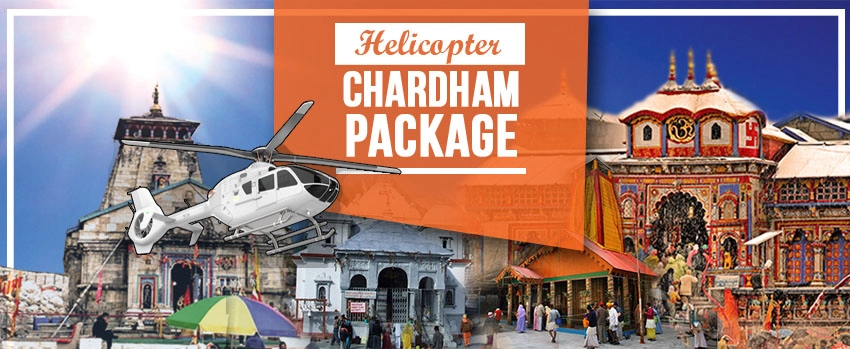
Visit Kedarnath by Road (Till Sonprayag)
To reach at Kedarnath by road you need to book a taxi or bus service which can be privately run or by the GMOU ltd. To reach at Kedarnath from Delhi you need to travel till Dehradun for which you can choose any medium be it road, rail or airways. From Dehradun travel till Haridwar and from Haridwar the following route will be your Guide to the Kedarnath Trek.
New Delhi to Haridwar 206km >> Haridwar to Rishikesh 24km >> Rishikesh to Devprayag 74km >> Devprayag to Srinagar 34km >> Srinagar to Rudraprayag 33km >> Rudraprayag to Gaurikund (via Tilwara-Agastmuni-Chandrapuri >> Kund >> Guptkashi >> Phata >> Sitapur >> Sonprayag) 74km >> Gaurikund to Kedarnath (by trek) 18km.
You can also visit Kedarnath from Delhi by boarding a direct bus from Delhi Bus Stand Kashmiri Gate to Gaurikund which is run by the Uttarakhand Transport Corporation. From Gaurikund further continue your trek to Kedarnath.

Visit Kedarnath by Air
To reach Kedarnath by air you can book a seat for yourself in a helicopter. If travelling by a helicopter till Kedarnath you can from Dehradun as well as Haridwar and Rishikesh .
From Dehradun- travel till the Shastradhara Helipad in Dehradun. The Helicopter will drop yoiu at your destination within a time period of 40 minutes.
From Haridwar/Rishikesh- If you are planning to travel to Kedarnath from Rishikesh/Haridwar via Helicopter then travel from Haridwar/Rishikesh till Phata via taxi which is at an approx distance of 200km and 195km respectively.
Kedarnath Trek Guide – How to Reach Kedarnath by Trek
After you reach till Sonprayag you will have to travel in a shared cab which charges Rs 20 per person this cab will take you till Gaurikund, Further from Gaurikund the trek to Kedarnath begins the directions of which are listed below as your Guide to Kedarnath Trek.
Kedarnath Trek Distance
The trek to Kedarnath is a 18 km trek which starts from Gaurikund till Kedarnath. The trek has changed since the 2013 flood disaster in Uttrakhand and since then the 14 km trek to Kedarnath has increased to a 16km trek.
Route Map of the Kedarnath Trek
The Kedarnath trek is a 18 km trek which starts from Gaurikund. Earlier the route followed was from Rambara, it was a well developed, well fenced and a facilitated trek route. However the Gov has now changed the trek Route of Kedarnath after the 2013 disaster as the old trek route to Kedarnath was completely erased. The New Trek Route to Kedarnath is given below which will be your Travel Guide to Kedarnath Trek .
- Reach at Gaurikund (6km approx) through shared taxi from Sonprayag
- Gaurikund to Jungle Chatti(6km) through the Rambara Bridge.
- Jungle Chatti to Bheembali (4km)
- Bheembali to Linchauli (3km)
- Linchauli to Kedarnath Base Camp (4km)
- Kedarnath Base Camp to Kedarnath Temple (1km)

Features of the Kedarnath Trek
The Kedarnath Trek is a 18km medium to steep trek which requires a good level of physical fitness. Before going for the trek every pilgrim has to get themselves checked that whether they are capable of trekking or not. Timings of Kedarnath Trek from Gaurikund commences from 04:00AM in the morning till 01:30PM. This timing is fixed because Kedarnath is located in the Kedarnath Wildlife Sanctuary and therefore the pilgrims are not allowed to trek anytime. No pilgrim is allowed to leave after this specific time. These are high altitudes trek so it is advisory for the ones with respiratory problems to first consult with a doctor before trekking.
Facilities at the Kedarnath Trek
The Kedarnath Trek facilities include the services of Palki/Dandi, Kandi & Mule/Ponies. Anyone can book these services from the booking counter at Gaurikund/Sonprayag. Different distances have different rates such as the Gaurikund to Kedarnath Dandi will cost Rs 4450, Kandi will cost Rs 3350 and the Poni will cost Rs 4100. In the midst of the trek there are proper facilities of tented accommodation, drinking water and small shops/ restaurants are also there in the trek route. There is also Helicopter services from the Kedarnath helipad to Phata and other helipads.
Things to Remember Before Going on the Kedarnath Trek
- Do get a check up before going on the trek to Kedarnath.
- People with Respiratory disorders and High Blood Pressure should not trek to Kedarnath.
- If you want to travel through Kandi, Ponies and Palki make sure that the prior booking is done at Gaurikund/Sonprayag booking counter.
- Trek between 04:00AM to 01:30PM as this is the only time when pilgrims are allowed to trek to Kedarnath.
- In case you won’t be able to cover the trek till late evening you can take Palki or Ponies to reach to your destination. You can also stay in the camps which are set up in between the trek at Jungle Chatti, Bheem Bali and Lincholi for a night and start journey next morning.
So here is a Complete Guide to Kedarnath Trek for you which will help you to analyze and go for your Kedarnath Yatra, making it more divine and comfortable.
Kedarnath Trek Guide Faqs
Embark on a journey through the Kedarnath Trek with our concise FAQ guide, providing essential information for your adventure in the Himalayas. Explore the spiritual essence of this revered pilgrimage route amidst the awe-inspiring mountain scenery.
What is the best time to undertake the Kedarnath Trek?
The best time to undertake the Kedarnath Trek is usually from May to June and then from September to November. During these months, the weather is relatively stable, with clear skies and pleasant temperatures, making it ideal for trekking. However, it's important to check current weather conditions and any potential risks before planning your trek.
What is the popular route for the Kedarnath Trek?
The most popular route for the Kedarnath Trek is via Gaurikund. This route spans approximately 16 kilometers and offers picturesque views of villages, forests, and mountains. It's the traditional and well-established path taken by most trekkers, providing a scenic and immersive experience through the stunning landscapes of the Himalayas.
What are the essential items to pack for the Kedarnath Trek?
Essential items to pack for the Kedarnath Trek include sturdy hiking boots, warm clothing layers, waterproof jacket and pants, first aid kit, high-energy snacks, and personal toiletries. Additionally, carry any necessary permits or identification documents and pack light but nutritious food items for sustenance during the trek.
What is the altitude of Kedarnath and how does it affect trekkers?
The altitude of Kedarnath is approximately 3,583 meters (11,755 feet) above sea level. This high altitude can affect trekkers in several ways, including decreased oxygen levels, which may lead to altitude sickness symptoms such as headache, nausea, and fatigue. Trekkers need to acclimatize properly by ascending gradually, staying hydrated, and recognizing signs of altitude sickness to ensure a safe and enjoyable trekking experience.
How difficult is the Kedarnath trek?
The difficulty of the Kedarnath trek can vary depending on factors such as the route chosen and individual fitness levels. Overall, it's considered a moderately challenging trek, especially due to the high altitude and variable weather conditions. The trek involves ascending steep paths, navigating rocky terrain, and trekking for several hours each day. However, with proper preparation, including physical fitness training and acclimatization, most trekkers with moderate hiking experience can successfully complete the Kedarnath trek.
Are there any accommodation options available along the Kedarnath trek route?
Yes, there are accommodation options available along the Kedarnath trek route. These include guesthouses, lodges, tents, and camping sites at various points along the trail. Many villages en route offer basic accommodation facilities for trekkers, providing meals and overnight stays. Additionally, there are temporary tented accommodations set up during the peak trekking seasons to cater to the influx of tourists. It's advisable to book accommodation in advance, especially during the busy pilgrimage seasons, to ensure availability.
How much time it take to complete the Kedarnath trek?
Starting from Gaurikund, the Kedarnath trek covers a distance of roughly 16 kilometers. Along the way, hikers are treated to magnificent views of the Himalayas, passing through lush forests, majestic waterfalls, and winding rivers. Typically taking 6 to 8 hours to complete, this trek presents a moderate level of difficulty, balanced by the awe-inspiring scenery.
What are the highlights or attractions of the Kedarnath trek?
The highlights of the Kedarnath trek include breathtaking views of the Himalayan landscapes, serene forests teeming with wildlife, captivating waterfalls cascading down rugged cliffs, and the opportunity to immerse oneself in the spiritual ambiance of the revered Kedarnath Temple. Additionally, trekkers can experience the warmth of local hospitality in quaint mountain villages along the route, making the journey both enriching and unforgettable.
Add Comments and Suggestions or Ask Questions about "A Guide for Kedarnath Trek "
We would be glad if you can comment below and provide your valuable suggestions and feedback on A Guide for Kedarnath Trek. If this A Guide for Kedarnath Trek page have any wrong information/list or out of context content, then you can report us as well.
If you have any questions, you can also ask as in the following comments section. Our team will try to provide you answers/solutions.
Why the prices are not as per the MRP? And why the prices of room is too high no fixed price, no proper facilities, they are cheating the pilgrims, shared taxi in which 12 people has to sit otherwise they will wait there. The trek is full of donkey sit all the way
What is the height at base camp and pick at kedarnath
Can we visit Kedarnath, Badrinath, gangotri and yamunotri
I am Heart patient should i go kedarnath after check up
Yes you can go if you are fit, The trek is too steep if you are planning then take proper medicine along with you
Is the Kedarnath trek open a day before temple opening? I want to go there on 8th May and stay overnight to offer prayers next day. The temple opens on 9th May. Can I trek on 8th May?
Yes, trek will be open by then.
Thanks for the question even i am trekking on 8th will see you
Planning a Trip? Confirm Your Booking Below
Easy steps to book char dham package.
We will analyze your requirements & find best Char Dham travel agents/operators whose expertise matches your travel request.
2. Get upto 3 quotes in your MAILBOX
Get contacted by upto 3 selected Char Dham travel agents/operators. They will provide you the best Char Dham itinerary option according to your budget.
3. Choose Best Travel PLAN
Choose best option among them & enjoy the trip. Give us your feedback

Destinations
Char dham yatra packages.
- Char Dham Packages
- Chardham Helicopter Packages
- Do Dham Packages
- Teen Dham Tours
- Badrinath Packages
- Kedarnath Packages
- Gangotri Packages
- Yamunotri Packages
- Chardham Leisure Hotels
- Fixed Departure Tours
- Winter Chardham Packages
- Hemkund Tours
Char Dham Hotels
- Chardham Hotels
- Hotels in Badrinath
- Hotels in Kedarnath
- Hotels in Gangotri
- Hotels in Yamunotri
- Hotels in Barkot
- Hotels in Joshimath
- Hotels in Auli
- Hotels in Srinagar
- Hotels in Devprayag
- Hotels in Guptkashi
- Hotels in Harsil
- Hotels in Ukhimath
- Hotels in Uttarkashi
- Hanumanchatti
- Rudraprayag
- Sayanachatti
- Srinagar Garhwal
- Karanprayag
- Jankichatti
Get Tour Details
- Chardham by Helicopter
- Chardham by Road
- Chardham Temples
- About Chardham
- Opening/ Closing Dates
- Chardham Registration
- 4 Dhams Weather
- News/Update
Outdoor Gear

30 Things To Carry For Kedarkantha Trek
This blog post covers a specific list of things to carry for Kedarkantha trek. It details 30 essential items from trekking gear, equipment, camping essentials, and more along with tips and advice for each. Additional information on renting select gear is also provided.
Nestled in the Garhwal Himalayas, the Kedarkantha trek is one of the most popular winter treks in India. The views of the snow-capped peaks and alpine forests along the way make it a trekker’s paradise. The trek starts from the quaint hamlet of Sankri, Uttarakhand at 6,400 ft and culminates at the Kedarkantha peak at 12,500 ft.
The views of majestic Himalayan peaks like Swargarohini, Bandarpoonch, and Kalanag from the top are breathtaking. However, trekking in the cold climate of winter requires proper preparation, planning, and packing. Having the right clothing, gear, footwear, accessories and other essentials is key to having a safe and comfortable trekking experience.
So whether you are an experienced mountaineer or a newbie going on your first Himalayan trek, use this guide to make sure you pack wisely and prepare thoroughly before embarking on the thrilling winter trek to Kedarkantha Peak! To fully enjoy this moderately difficult trek, proper planning and packing are crucial.
Things To Carry For Kedarkantha Trek: A Complete Guide
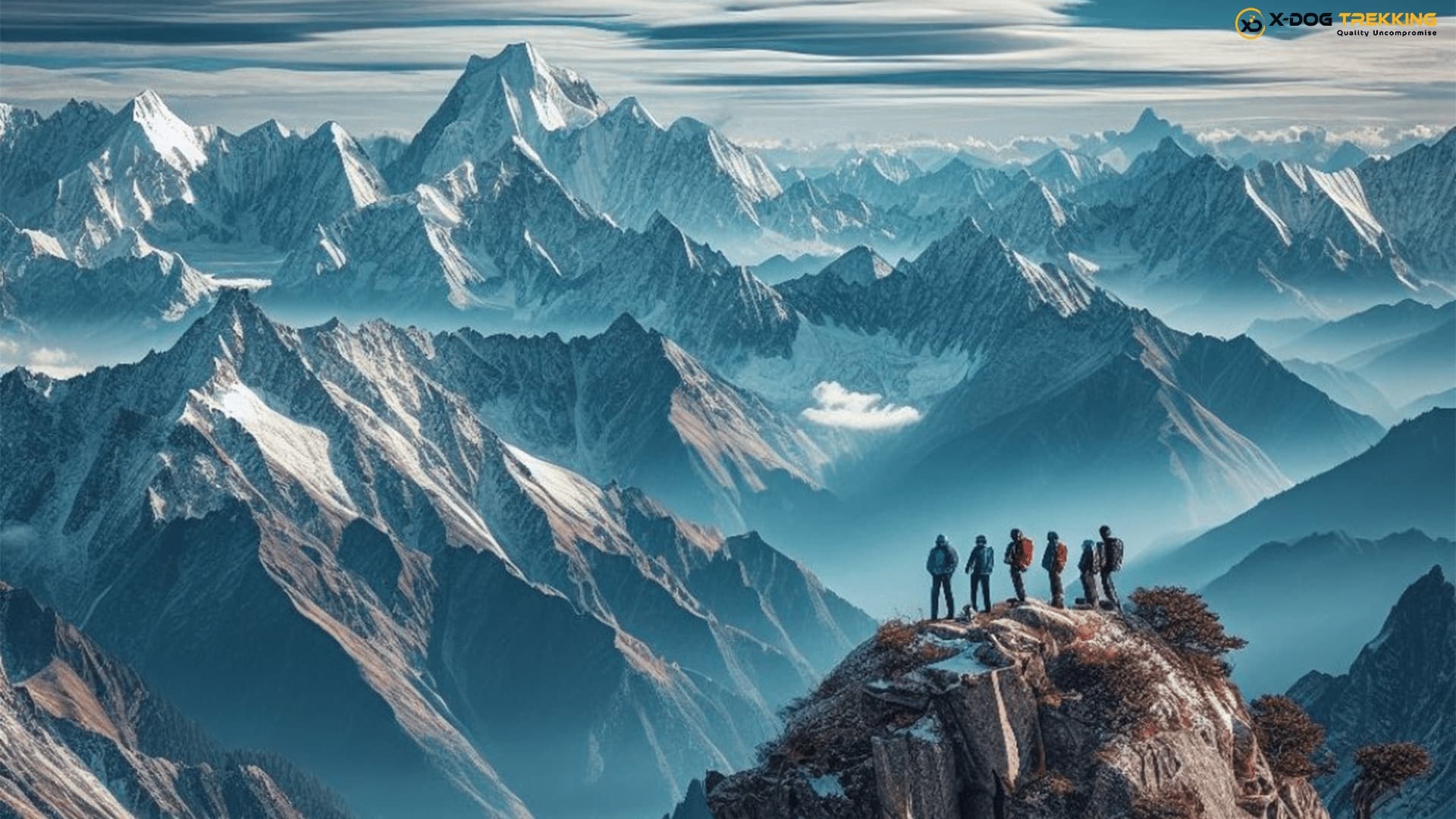
1. Valid ID Proof
Carrying an original and valid photo identity proof is mandatory for any trek in India. This is needed at checkposts and campsites. Recommended ID proofs are an Aadhar Card, Driving License, Voter ID, or Passport. Avoid carrying originals and keep 2-3 photocopies instead. If you are a foreign national, carry your passport and valid Indian visa. Keep your ID proof safe and secured during the trek.
2. Good Quality Backpack
Your backpack is the most essential piece of trekking gear. Go for a branded backpack with a capacity of 60-70 liters. It should have a good hip belt to transfer weight to the hips, adjustable straps, a ventilated back panel, and an expandable collar.
The material should be durable like nylon or polyester with a waterproof rain cover. Waterproof the bag with ponchos or plastic wraps as porters sometimes stack bags carelessly. Go on short hikes wearing the loaded pack to test comfort. Alternatively, rent good backpacks from trek gear rental companies.
➛ Best Trekking Backpack On Rent
3. Trekking Shoes
Ideal trekking shoes are waterproof, have good grip, provide ankle support, and have a sturdy build. The outsole should be from reputed brands like Vibram with deep lugs for traction on slippery terrain.
High ankle collars add support and prevent debris from getting inside. Break in new shoes by wearing them around before the trek. If you don’t want to buy expensive shoes, renting is a good option. Make sure the shoes are still in good condition, fits well, and are comfortable.
➛ Trekking Shoes For Rent (Waterproof)
4. Trekking Poles
Trekking poles are very useful in the mountains as they improve stability, reduce strain on the knees, and help propel you forward. Adjustable aluminum trekking poles are lightweight and offer versatility for uphill and downhill sections. They distribute the load by up to 25% from the knees to the shoulders and arms.
Look for comfort grips, adjustable wrist straps, anti-shock features, and interchangeable tips. Learn the correct techniques to maximize efficiency. Renting poles is suggested for infrequent trekkers. Make sure the poles are not damaged, are of proper height, and have good grips.
➛ Mountain Trekking Pole For Rent (Anti-shock)
5. Headlamp
A headlamp frees up your hands at camp for cooking, changing clothes, etc. in the dark. Look for one with different lighting modes, brightness settings that go beyond 100 lumens, and a red light mode that preserves night vision.
It should have an adjustable band to fit perfectly on your head. Always carry spare batteries since cold can drain them faster. A headlamp also comes in handy if you get caught in the dark during summit attempts. Consider renting a headlamp if you won’t use it much otherwise.
➛ Best Rechargeable Head Torch For Rent
6. Sunglasses
Sunglasses are mandatory for eye protection in the snowy environment at high altitudes. Go for wrap-around polarized glasses from reputed outdoor brands that cut glare from sun, snow, and water. UV-protected lenses with a 100% UV 400 rating offer complete protection.
If you wear prescription glasses, you can get custom sunglass inserts for your frames. Make sure the sunglasses fit over your prescription glasses comfortably without slipping. Carry a neck cord to prevent loss and a hard case for protection. Avoid cheap low-quality sunglasses that can harm your eyes.
7. First Aid Kit
A first aid kit can be a lifesaver in the mountains. Stock it with essential medications, bandages, antiseptic creams, pain relief sprays & gels, cotton, gauze, medical tape, blister care supplies, scissors, hand sanitizer, disposable gloves etc. Also, include any personal medications.
Make sure all the medications are unexpired. The kit should be portable, waterproof, and readily accessible. Know how to use each component. You can customize readymade kits available from outdoor retailers. Renting a first aid kit makes sense if you are new to trekking. Just replenish any item you use during the trek.
8. Raincoat and Pants
A good quality waterproof and breathable rain jacket and pant is vital for protection from rain, wind, and snow. It should have taped or sealed seams to prevent leakage along with hoods, storm flaps, and adjustable hems. 2-3 layer jackets with ventilation options are ideal.
Get ones that pack small and are lightweight. Choose bright colors for visibility. Make sure they are roomy enough to layer clothes underneath. Cheap plastic ponchos are not ideal. You can rent good rain gear from outdoor gear rental companies before the trek. Check for defects in zippers, tears, etc before renting.
➛ Best Waterproof Rain Coat For Rent
9. Backpack Rain Cover
If your backpack does not come with an inbuilt rain cover, get a removable one. It should be made from a waterproof material and fit snugly over the pack without sagging. Make sure you get the right size rain cover for your backpack.
Attach it properly over all the extremities of the pack. Seam-sealed designs prevent leakage. Having this extra layer of waterproofing gives added protection for your belongings inside. You can easily rent a rain cover along with your backpack from any gear rental company.
➛ Backpack Cover for Rain for Rent
10. Day Pack
You need a hardy but compact 15-20 liter day pack to carry your essentials during summit attempts, day hikes, and as a summit bag. It should have side pouches for quick access to water bottles, front stash pockets to quickly access snacks or layers, and chest/waist straps for stability.
Look for an air mesh back panel for ventilation and minimal weight. Keep it light by packing only necessities like water, snacks, spare layer, first aid, phone, etc. inside. Hydration-compatible day packs allow the use of hydration bladders or water bottles. These are easily available for rent if you don’t want to buy one.
11. Trekking Gaiters
Gaiters are worn over trekking shoes to prevent debris like pebbles, gravel, snow, and dust from getting inside. They also keep the pants from getting caught in the lugs. Look for durable, water-resistant ones with secure closures.
Make sure they are high enough to fit over your shoes and socks without sagging. The bottom should be reinforced and have a sturdy front clip. Try wearing your gaiters before renting to assess sizing and comfort. Examine for any damage or wear and tear if renting used gaiters.
➛ Shoes Gaiters On Rent
12. Camping Slippers
Camping slippers are a nice luxury that makes hanging time at camp comfortable. They should be lightweight, pack down small, quick-drying, and have a rugged sole with tread for grip.
Closed-toe designs prevent stubbing the toes on rocks. Make sure they are not too tight or loose when trying out before renting. Wear with fresh socks to relax your feet after long trekking days. They can be easily rinsed and dried overnight for reuse.
13. Sun Cap
A wide-brimmed sun cap protects your face, ears, neck, and head from harsh UV rays at high altitudes. Choose one with UPF rating and chin straps or drawcord to prevent it from being blown away by the wind. Mesh side panels allow ventilation and sweat evaporation.
Go for a cap made from quick-dry, breathable fabric. Make sure it fits you well without being too tight or loose when renting. Adjust the chin strap for a snug fit. Wear a cap over a woolen beanie for layered protection. Renting caps is ideal if you won’t use them much afterward.
➛ Best Trekking Hat On Rent (Summer Cap)
14. Balaclava
A balaclava protects the head, neck, and face from cold winds, sunburn, and frostbite. Merino wool balaclavas are excellent as wool insulates even when wet. Choose one that fits snugly and covers all exposed areas fully.
It should have some stretch to pull down easily over the head when required. Make sure there are no gaps around the nose or eyes when trying one for renting. Carry a spare balaclava in case the one in use gets wet. You can also opt for a multifunctional buff instead of a balaclava.
➛ Best Merino Wool Balaclava On Rent
15. Thermal Innerwear
Woolen or synthetic thermal inners trap body heat and wick away sweat to keep you warm and dry. They are meant to be worn next to the skin under other layers. Avoid cotton which soaks up sweat.
For the top, choose long sleeves and a close-neck design. The bottom should be full-length ankle-length leggings. Try on the thermals with your other layers before renting to assess sizing and layering comfort. Look for any defects in stitching or pilling in the fabric.
16. Quick-Dry T-shirts
Quick dry synthetic t-shirts prevent sweat accumulation, odor, and chill. Branded trekking t-shirts also come with a UPF rating for sun protection. Choose light-colored full sleeves and a breathable, lightweight fabric that fits snugly.
Carry at least 2-3 t-shirts to cycle through during the length of the trek. Make sure there are no visible stains, tears, or loosening of shapes when renting used ones. Wash and sun dry overnight to sterilize before wearing.
17. Fleece Jacket
A fleece jacket traps air and provides excellent insulation and warmth for its weight. Although not waterproof, fleece dries quickly when wet. Choose a thick 200-300 gram weight fleece from Polartec or Thermolite.
It is worn over base layers and under a down or rain jacket. An unzippable jacket allows for ventilation adjustment. Ensure proper arm and body length when renting. Check for damaged zippers, collar elastics, and any pilling in the fabric.
18. Puffy Down Jacket
Warm, compressible, and lightweight, down jackets are unbeatable for insulating capacity. The feathers trap heat while allowing moisture to escape. 900+ fill power down provides maximum warmth with minimal weight.
Get duck or goose down with water-resistant DWR coating. Make sure it fits comfortably over other layers. When renting, examine for missing feathers through the outer fabric. Do a blow test for leakage and assess the loft and compressibility.
➛ Best Columbia Jacket For Winter On Rent (-16 Degree Ultra Light)
19. Waterproof Trekking Gloves
Waterproof insulated gloves provide hand protection and dexterity for activities like setting up tents, cooking, etc. They have a better grip compared to mittens. Look for breathable waterproof membranes like Gore-Tex and PrimaLoft insulation.
Ensure proper fit without constricting circulation when trying before renting. The outer shell should be abrasion-resistant. Examine the gloves inside-out for any leakage, torn insulation, or separating seams if used. Known brands are more reliable for quality.
20. Trekking Pants
Preferred over jeans, trekking pants are light, quick-drying, and abrasion-resistant. They are made from soft shell fabric or convertible designs with zip-off lower legs. Useful features are UPF rating, vent zips, durable fabric, and gusseted crotch.
They provide ease of movement over varied terrain. Try sitting, squatting & stretching when renting to assess comfort and fit. Look for any tears, holes or loose stitching in used ones. Wash and sun dry pants overnight to get rid of bad odors before use.
21. Trekking Socks
Proper trekking socks can prevent painful blisters and keep feet comfortable. Look for wool or synthetic padding around toes, heels, and ankles prone to blisters. Quick-drying, moisture-wicking liner socks worn under help too.
The socks should not be too tight or loose when worn with the trek shoes. When renting, check for holes, sagging elastic, and worn fabric along the toes and heels. Socks are best rented new rather than used ones.
22. Hydration System
A 2-3 liter capacity hydration bladder system allows you to drink water frequently without taking off your pack. The long sip tube makes reaching the nozzle easy. It carries more water than bottles.
Look for wide mouth openings for easy cleaning and anti-microbial properties to prevent mold. Make sure the bite valve, tubing, and seals are intact when renting used ones. Scrub thoroughly with chlorine tablets before use.
23. Reusable Cutlery
Carry your own reusable spoon, fork, and insulated mug. This avoids generating trash from disposable plates and cutlery on the trek.
Opt for durable, lightweight options. Metal spoons tend to develop a weird smell over time. Rent cutlery along with your camping gear or from trek gear rental companies. Make sure they are not chipped or bent.
24. Sunscreen Lotion
Generous use of SPF 30+ broad spectrum UVA/UVB sunscreen is vital in the high UV environment of the mountains. Reapply every few hours even if not directly sunny. Zinc-based creams stay on better than lotions.
Check if you have any allergies when trying a new sunscreen. When renting, check manufacturing dates and use before the product expires. Don’t rent previously opened or used tubes. Discard any sunscreen past its shelf life.
25. Lip Balm
Intense sun and cold dry winds make lip balm essential to prevent chapped and cracked lips. Beeswax-based balms stay on better than oils or petroleum jelly. SPF protection is an added bonus.
When renting, opt for sealed new lip balm sachets. Don’t use ones that have been opened or used previously. Remember to apply the balm generously and reapply every few hours during the trek.
26. Biodegradable Toiletries
Carry travel-sized toiletries for bathing and sanitation needs like small soaps, sanitizer, sunscreen, toothpaste tablets, etc. Opt for biodegradable eco-friendly options that won’t pollute water bodies when the used waste is discharged.
Items like soaps, shampoos, and wet wipes come in handy mini packs that are just right for a short trek. When renting toiletries, ensure the products are sealed, unused, and not past expiration dates.
27. Trekking Sandals
Sturdy trekking sandals with dampening midsoles and good grip make easy camp shoes. Their quick-drying open design is perfect for stream crossings or relaxing at camp. Ankle straps add stability over rocky terrain.
Test sandals with the trek socks you will be wearing when renting to check sizing. Make sure the straps, buckles, and lugs are not worn out or damaged. Proper fit should allow some wiggle room for feet to swell on long days.
28. Camera / GoPro
Capture the stunning Himalayan landscapes with your digital camera, GoPro, or phone camera. Carry spare batteries or power banks to manage battery life. Get a dry bag or waterproof case to protect the camera from rain and falls.
When renting, check everything is in working order – batteries, memory card, lenses, etc. Examine for any physical damage like cracks or dents. Know how to operate the camera before the trek begins.
➛ Gopro Camera On Rent
29. Portable Charger
Recharge your phone, camera, GPS device, etc. anywhere with a power bank. Get one with a capacity of at least 10,000 mAh and multiple charging ports. Ensure the power bank is fully charged before renting. Check that it is functional by attaching a device and charging for a few minutes.
30. Camping Stove
A camping stove is an essential item for cooking food and boiling water during treks. Small portable stoves powered by gas cylinders offer a reliable flame even in windy conditions compared to open fires. Choose lightweight canister or liquid fuel stoves from brands like MSR, Primus, or Coleman based on fuel availability. Make sure all tubes, valves, and gaskets are intact if renting a used stove. Understand the safe usage and priming before use. Reputed outdoor gear rental companies like XDog Trekking in Bangalore offer well-maintained camping stoves for rent.
➛ Coleman Portable Butane Camping Stove On Rent
What should I carry with me for the Kedarkantha trek?
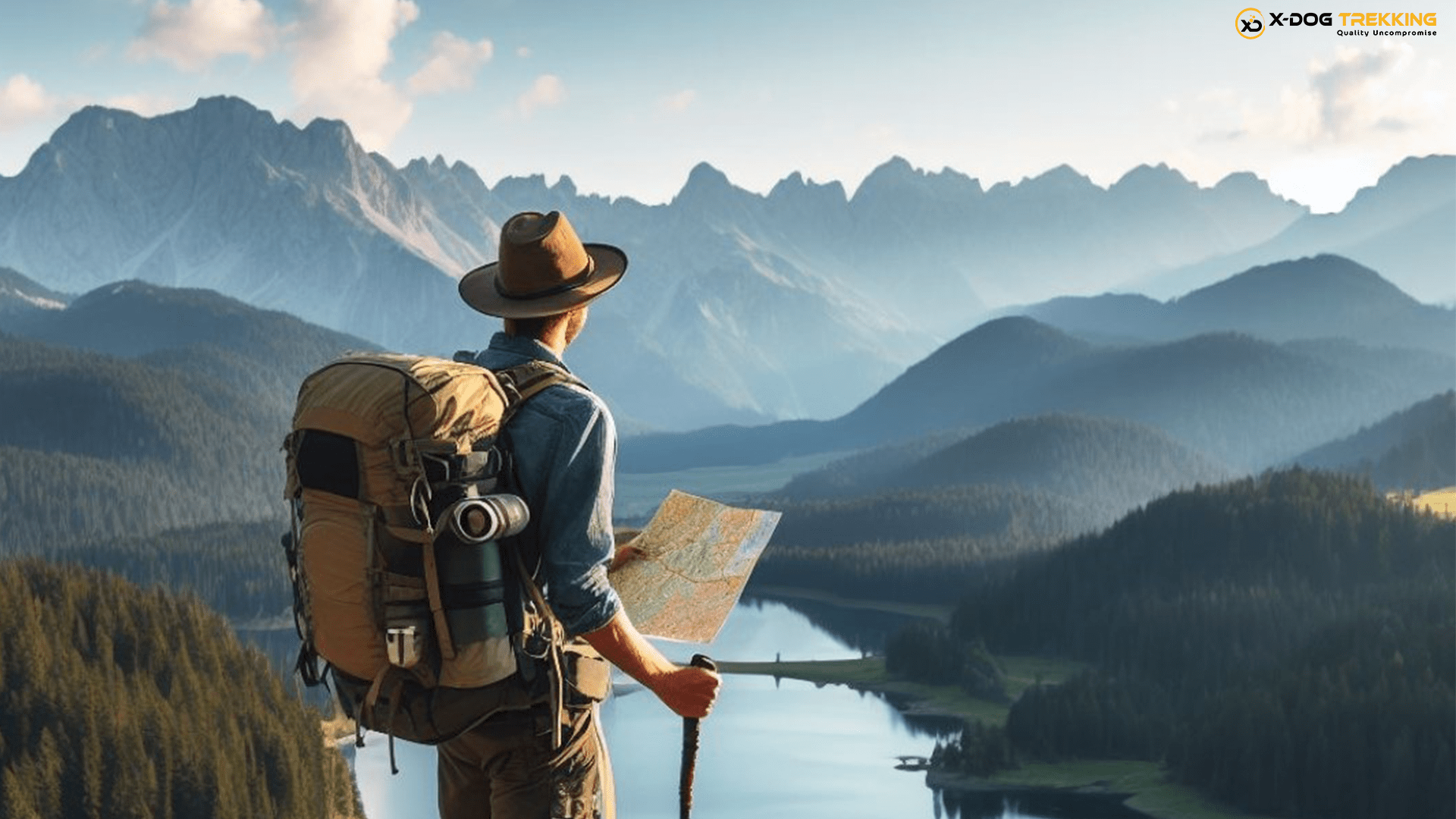
➢ Necessary Camping Gear
- Sleeping Bag: A warm and comfortable sleeping bag is essential for a good night’s sleep, especially at high altitudes where temperatures can drop significantly at night. Choose a sleeping bag with a temperature rating that matches the expected conditions.
- Sleeping Mat: A comfortable sleeping mat provides insulation and cushioning between you and the cold, hard ground. It can significantly improve your sleep quality and comfort during the trek. Consider a self-inflating sleeping mat for added convenience.
- Tent: A lightweight and weather-resistant camping tent is crucial for safe and comfortable camping throughout the trek. Choose a tent with adequate space for you and your belongings, and ensure it has a waterproof rating to withstand potential rain or snow.
➢ Trekking Essentials
Carrying valid photo ID proof is mandatory for any trek in the Himalayas. Keep your Aadhar card, driving license, voter ID, or passport along with a few photocopies. Invest in a good quality backpack with a capacity of 60-70 liters and a rain cover. Waterproof trekking shoes providing ankle support and sturdy soles give grip on slippery trails. Adjustable trekking poles improve stability and reduce knee strain on steep sections. Don’t forget a headlamp, UV-protected sunglasses, and a well-stocked first aid kit.
➢ Staying Dry
Waterproof and breathable outer layers like raincoats and pants protect from getting wet in unpredictable mountain weather. Use a rain cover for the backpack if it is not water-resistant. Trekking gaiters worn over shoes prevent snow and debris from getting inside.
➢ Clothing Essentials
Woolen gloves, balaclava, and thermal inners worn next to the skin prevent sweat accumulation and keep you warm in the cold. Quick dry t-shirts and trek pants are preferred over jeans for ease of movement. Fleece and down jackets provide insulation in freezing temperatures. Get woolen trekking socks to avoid blisters.
➢ Other Accessories
A sturdy daypack to carry summit gear, a hydration system to drink water on the move, a reusable cutlery set to avoid plastic trash, and biodegradable toiletries are must-haves. Trekking sandals give respite from closed shoes at camp. Don’t forget sun protection like wide-brimmed caps, sunglasses, and high SPF sunscreens.
➢ Electronics
Power banks let you recharge mobile devices on the go. Good cameras capture stunning views better than phones. Make sure you carry spare batteries as cold drains them faster.
➢ Cooking Gear
Portable camping stoves like MSR Whisperlite are essential for cooking meals and boiling water. Renting one is a good option for occasional trekkers. Reputable outdoor gear rental companies like XDog Trekking in Bangalore offer well-maintained equipment.
➢ Additional Tips
Try to pack light and minimize luggage weight. Waterproof your gear using dry bags or plastic wraps. Don’t forget vital medicines, energy food items, and mandatory documents. Proper preparation and packing ensure a safe and comfortable trek.
FAQs about Kedarkantha Trek
The Kedarkantha Trek is a captivating Himalayan expedition that takes you to the summit of Kedarkantha Peak, offering panoramic vistas of snow-capped peaks, lush meadows, and verdant forests. This 4-5 day trek, spanning approximately 25 kilometers, commences from Sankri village and culminates at the peak, where you’ll be rewarded with breathtaking views of the surrounding mountains.
The Kedarkantha Trek unfolds its beauty during the winter months, from November to April, when the weather is favorable, with clear skies and pleasant temperatures. The snow-capped peaks and the crisp mountain air create an enchanting spectacle. However, if you prefer a milder climate and blooming meadows, the summer months, from May to June, offer an alternative trekking season.
The Kedarkantha Trek falls under the moderately challenging category, making it suitable for both beginners and experienced trekkers. The well-defined trail with gradual ascents provides a manageable challenge, while the high altitude demands physical fitness and acclimatization.
To embark on this trek, you’ll need to obtain a Forest Permit from the Forest Check Post at Mori, located approximately 70 kilometers from Dehradun. The permit costs ₹50 per person per day.
A well-equipped backpack, sturdy trekking shoes, warm clothing, rain gear, a sleeping bag, a headlamp, and a first aid kit are essential items for your Kedarkantha Trek. Trekking poles and a water bottle are also highly recommended.
Planning and packing properly for a trek is essential to maximize safety and enjoyment. This comprehensive packing list covers all the essential clothing, gear, accessories, and items you need to carry for the Kedarkantha trek. Additional items can be rented from outdoor gear rental companies to reduce load. Following the layering system and packing light are key tips. Let me know if you have any other trekking questions!
Related Posts

Bike Riding Gear for Rent in Bangalore at the Lowest Price
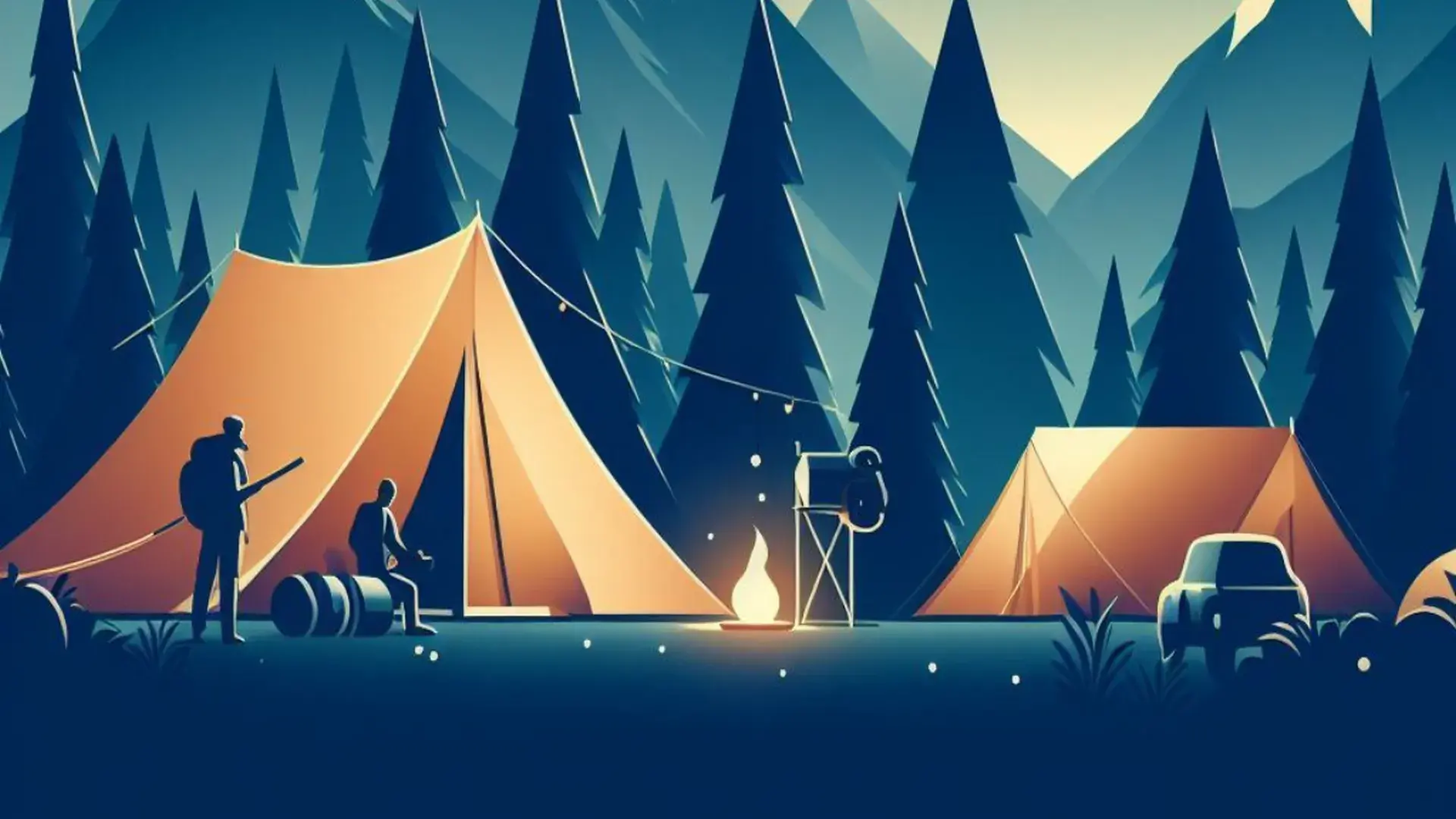
How to Choose the Right Trekking Tents for Rent?
Leave a comment cancel reply.
Your email address will not be published. Required fields are marked *
Save my name, email, and website in this browser for the next time I comment.
KEDARKANTHA TREK
The finest summit climb for beginners

Have questions? Speak to our expert Trek Advisors Talk to our Trek Advisors
We have an expert team of Trek Advisors to help you choose the right trek. So if you have questions like, "Can I do this trek?" or "Who else is trekking?", please get in touch. Talk to our Trek Advisors
TREK DIFFICULTY
Easy Moderate
TREK DURATION
HIGHEST ALTITUDE
12,500 feet / 3,810 metres
SUITABLE FOR
8 to 62 years
Kedarkantha (not to be confused with the popular Temple Kedarnath) is a 6-day long trek in Govind Pashu Vihar National Park in Uttarakhand (6 when including the travel days from Dehradun to the base camp and back). Kedarkantha is easily one of the most popular treks in India — popular amongst seasoned trekkers and beginners alike.
There are many reasons why it is a very popular trek to do in the Indian Himalayas. The most important of them is this — the summit climb .
The summit climb of Kedarkantha is a very rewarding one. Right from the base camp of the trek, the summit looms large. As you start your trek in the early hours of the morning and steadily climb up the steep slope of snow, the world opens up around you.
The climb is not easy. The entire stretch is steadily steep. As you get closer to the summit, it gets tricky as well. But the big mountains of the upper Himalayas keep you company until you finally reach the summit.
As you stretch yourself and take in the views of the Himalayas from the summit, you feel a strong sense of satisfaction and accomplishment. This is an unparalleled feeling.
Did you know Indiahikes was the first to explore and document Kedarkantha? Read the untold story here.
Very few treks offer the same adventure, making it popular among beginners for its finest summit climb.
Outside the summit, the trek is also unique for its beautiful clearings . Very rarely you will find stunning clearings on a trek that makes way for some rest spots and beautiful campsites . This trek is filled with clearings on all the different routes. What's more, the clearings are just at the right locations, giving you beautiful vantage points to appreciate the trek and its views.
The third biggest reason this trek is unique is its beautiful forests . All three routes have beautiful diverse forests that will immerse you. If you are not careful, you will get lost in them (in a good way).
Ever since Indiahikes explored and opened up Kedarkantha as a winter trek in 2011, many other organisers have followed suit. Having explored and trekked this route for over a decade, we know every nook and corner on the trail.
Kedarkantha Videos

Kedarkantha - Complete Trek Information
We have always wanted trekkers to be well-informed before they go on a Himalayan trek. Knowledge is the difference between a safe trek and a dangerous one. It’s also the difference between a wholesome experience and a superficial experience.
Use this section to learn about the Kedarkantha trek. It has in-depth information about each day of the trek, what to expect, and how you need to prepare for it. Many years of expertise have gone into this content. Trekkers find that extremely useful.

Quick Itinerary (Kotgaon Route)
Get your trek plan
Drive from Dehradun to Kotgaon
Drive Distance: 200 km | Duration: 10-11 hours | Pick up point for Indiahikes trekkers: Grand Legacy Hotel, near Laal Pul , Dehradun or Library Chowk, Mussourie | Pick up Time: 6.30 am | Location of Indiahikes basecamp: Kotgaon
Transport will be arranged at 6.30 AM. The cab can also pick you up from Library Chowk, Mall Road, Mussoorie at 7.30 AM. This cost has to be borne by trekkers and paid directly to the driver. Cost of the cab – Rs 6,500 per vehicle for an SUV, shared among 5-6 trekkers, or Rs 10,000 per vehicle for a Tempo Traveller, shared among 11-12 trekkers.
Trek from Kotgaon to Khujaai
Trek Distance: 5.3 km | Trek Duration: 5 hours | Altitude Gain: 6,400 ft to 9,460 ft
Trek from Khujaai to Bhoja Dhadi
Trek Distance: 3 km | Trek Duration: 3.5 hours | Altitude Gain: 9,460 ft to 10,700 ft
Trek from Bhoja Dhadi to Khujaai via Kedarkantha Summit
Trek Distance: 9 km | Trek Duration: 7-8 hours | Altitude Gain: 10,700 ft to 9,460 ft via 12,500 ft
Trek from Khujaai to Kotgaon
Trek Distance: 5.3 km | Trek Duration: 4-5 hours | Altitude Loss: 9,460 ft ft to 6,400 ft
Drive back from Kotgaon to Dehradun
Drive Distance: 200 km | Drive Duration: 10-11 hours | Drop off point for Indiahikes trekkers: Grand Legacy ( near Laal Pull ) Hotel, Dehradun
This transport cost has to be borne by trekkers and paid directly to the driver. Cost of the cab – Rs 6,500 per vehicle for an SUV, shared among 5-6 trekkers, or Rs 10,000 per vehicle for a Tempo Traveler, shared among 11-12 trekkers.
Please note: The distance between campsites may vary by 100 meters depending the weather conditions and the route you take. The altitude may also vary by 100 feet for similar reasons.
IMPORTANT POINTS
➤ Documents required: It is mandatory for trekkers to carry a copy of their photo id and medical certificate for entry at forest check posts on the trek. The medical certificate along with the disclaimer form will be part of the Safety Check-in done by the trek leader when you arrive at the base camp.
➤ Stay facility: At the base camp, your stay will be arranged in lodges. Do not bring any packaged food , tags from your new clothes or any waste with you. We follow a Dustbin Free Zone and No Wet Wipes Policy at our base camps in line with our spirit of Green Trails .
- On the trek, you will be staying 2 in a tent.
➤ Cloakroom facility for excess luggage: We have a Cloak Room facility at the base camp for excess luggage. Every trekker is permitted to leave behind one piece of luggage at no charge. Anything beyond one piece of luggage is chargeable at Rs 500 per luggage. (The luggage could be a backpack/suitcase/duffel bag or anything similar.). Do not leave behind any valuables in the cloakroom.
➤Documents required: It is mandatory for trekkers to carry a copy of their photo id and medical certificate for entry at forest check posts on the trek. The medical certificate along with the disclaimer form will be part of the Safety Check-in done by the trek leader when you arrive at the base camp.
➤Stay facility: At the base camp, your stay will be arranged in lodges. Do not bring any packaged food, tags from your new clothes or any waste with you. We follow a Dustbin Free Zone and No Wet Wipes Policy at our base camps in line with our spirit of Green Trails.
➤Cloakroom facility for excess luggage: We have a Cloak Room facility at the base camp for excess luggage. Every trekker is permitted to leave behind one piece of luggage at no charge. Anything beyond one piece of luggage is chargeable at Rs 500 per luggage. (The luggage could be a backpack/suitcase/duffel bag or anything similar.). Do not leave behind any valuables in the cloakroom.

Quick Itinerary (Gaichawan Route)
Drive from Dehradun to Gaichawan Gaon
Drive Distance: 195 km | Drive Duration: 10-11 hours | Pick up point for Indiahikes trekkers: Grand Legacy ( near Laal Pull ) Hotel, Dehradun | Pick up Time: 6.30 am
Trek from Gaichawan Gaon to Julota
Trek Distance: 5.5 km | Trek Duration: 4-5 hours | Altitude Gain: 5,600 ft to 8,950 ft
Trek from Julota to Pukhrola
Trek Distance: 3 km | Trek Duration: 3-4 hours | Altitude Gain: 8,950 ft to 10,800 ft
Trek from Pukhrola to Akhoti Thach via Kedarkantha Summit
Trek Distance: 8 km | Trek Duration: 6-7 hours | Altitude Gain: 10,800 ft to 9,170 ft via 12,500 ft
Trek from Akhoti Thach to Gaichawan Gaon
Trek Distance: 7.2 km | Trek Duration: 5-6 hours | Altitude Loss: 9,170 ft to 5,600 ft
Drive back from Gaichawan Gaon to Dehradun
Drive Distance: 195 km | Drive Duration: 10-11 hours | Drop off point for Indiahikes trekkers: Grand Legacy ( near Laal Pull ) Hotel, Dehradun | Drop off Time: 7 pm

How Does Each Day Look (Kotgaon Route)
Complete day-wise guide
Day 1 (Pick-up Day): Drive from Dehradun to Kotgaon

Drive Duration: 10-11 hours | Drive Distance: 185 km

Altitude: 6,520 ft
The trek begins at Kotgaon. The journey takes you past Mori and Purola. You see beautiful valleys and forest cover throughout the journey.
At the Naitwar Barrier, you need to take permission. A government-issued ID is essential for this. Take the road that goes straight towards Sankri. Take a right turn in about 30 minutes.
This takes you to Kotgaon surrounded by small hamlets called Shialdi, Paisar, Guradi, Suchan Gaon, Dargar Gaon and Dewara. The guest house where you will be staying is in Shialdi.
Roam around this quaint village and be enchanted by the sound of the Tons river.
Day 2: Trek from Kotgaon to Khujaai
Trek Duration: 5 hours | Trek Distance: 5.5 km
Altitude Gain: ⇗ 2,940 ft (6,520 ft to 9,460 ft)

Difficulty: Easy-Moderate. Gradual ascent in the forest till Mohlani meadows. A combination of ascents and descent to Khujaai
Highlights: Mohlani meadow. It’s a huge clearing with a grand view of the surroundings.
The trek starts from Kotgaon. Start off from the road that goes towards right from the Kotgaon campus. About a kilometre of walk on the road leads to a small suspension bridge. Watch out for the beautiful views of the valley on your left. Just before the suspension bridge, the trail deviates towards the right. Take this trail.
Now, you enter the dense forest. This is a beautiful section predominantly of oak trees. Gradually ascend in the dense jungle for about an hour. You come across a small clearing surrounded by bushes and trees. This is your first resting point.
The forest section continues. It’s a bit of an ascent from here. Savor every bit of it. Listen to the sound of the wind, chirping birds and the rustling of leaves. In another hour, you reach Mohlani meadows. This is a huge clearing and opens up on one side to the grand views of the hills. It is surrounded by tall pine trees on other sides. There is a small Matrishakti Mandir. There is a water source too. Replenish your water supplies here.
Continue in the forest section again for half an hour to reach another small clearing. From here, it’s a bit of a descent. Listen to the sounds of the gushing water stream. Within a few minutes, you come across a small wooden bridge. Cross the bridge and start ascending. About 15-20 minutes of gradual ascent from here takes you to the Khujaai campsite.
The Khujaai campsite is a huge clearing in the middle of dense forest. This is where you spend the rest of the day. Explore around a bit. To your right, you can see the next day’s trail. To your left, there is a cattle space and shepherds’ huts. A little ahead from this is a space where there are a lot of boulders. You can sit and enjoy the view from here. If the weather permits, do not miss out on views of the starlit sky at night.
Day 3: Trek from Khujaai to Bhoja Dhadi
Trek Duration: 3.5 hours | Trek Distance: 3.5 km
Altitude Gain: ⇗ 1,280 ft (9,460 ft to 10,740 ft)
Difficulty: Easy. A combination of ascents and descents in the forest and meadows.
Highlights: Stunning sunset views from Bhoja Dhadi
Start the trek from the trail that goes to the right in the south-west direction from Khujaai. About a kilometre of an ascent in the forest section takes you to Tatalona meadows. It’s a beautiful clearing. Rest here for sometime.
From the meadows, about 600 metres of a descent takes you to a water stream. The gushing stream, the boulders and all of this in the middle of a dense forest makes it a beautiful setting.
Cross this stream. The trail further is again an ascent in the forest section. It can get slippery when it rains. So be mindful of your footing. In about 20 minutes you will reach another small clearing.
Take a steep right turn here. The trail now is through boulders. About another 100 metres of a descent takes you to another water stream. Cross this stream and start your final ascent to Dhoka. It’s another 700 metres of an ascent in the forest section.
Dhoka in Garhwali means “meadow with a big boulder”. Aptly, it is a huge meadow with one big boulder at one end. From here onwards, snow-clad mountains start making their appearance. A little ahead of Dhoka is Bhoja Dhadi, where you stay for the night. Do not miss the alpen glow on these peaks during sunset. You can also see Kedarkantha summit up ahead of you.
Take a good rest as tomorrow will be a long day.
Day 4: Trek from Bhoja Dhadi to Khujaai via Kedarkantha Summit
Trek Duration: 7-8 hours | Trek Distance: 9 km
Altitude Gain and Loss: ⇗ 1,760 ft ⇘ 3,040 ft (10,740 ft to 9,460 ft via 12,500 ft)
Difficulty: Moderate. 2-3 hour steep ascent to reach the summit. Steep descent to Khujaai
Highlights: Stunning views of the Himalayan ranges from the summit.
There is a trail on the right of Bhoja Dhadi campsite. Start ascending on this trail. Soon, you will reach a section of beautiful rhododendron trees. Meander your way through them to reach a clearing in about 500 metres.
Now you are almost out of the treeline. Continue ascending on a grassy trail. The trail slowly transitions from grassy to muddy. Be cautious as it could get slippery. Ascend in a zigzag manner.
You will soon reach a point where the trail from Sankri joins. It’s a steep ascent from here onwards to all the way up to the summit. You see the Phulara ridge on your left from here. It takes around 2.5-3 hours to reach the summit from Bhoja Dhadi.
Once you are at the summit, you’re surrounded by the mountain ranges and valleys. You see the Rupin and Har ki Dun valleys. You see Mt Swargarohini, Mt Bandarpoonch and Mt Kalanag predominantly. You see Jaonli, Gangotri, Draupadi Ka Danda and Jorkanden peaks at a distance.
After spending some time at the summit, retrace your way back to Dhoka and further to Khujaai.
Day 5: Trek from Khujaai to Kotgaon
Trek Duration: 5 hours | Trek Distance: 5.3 km
Altitude Loss: ⇘ 2,940 ft (9,460 ft to 6,520 ft)
Difficulty: Easy-Moderate. A gradual descent through a narrow forest trail.
Highlights: Lovely dense oak forest
From Khujaai, you find a trail going further down. It’s a descent all the way to the Kotgaon.
It’s a narrow trail in the dense forest section, consisting predominantly of oak trees. Savour the forest walk for one last time, as today is the last day of your trek.
Retrace the way back to Kotagon from here and stay at the Indiahikes Community Campus for the day.
Day 6: Drive from Kotgaon to Dehradun
Duration: 9-10 hours | Drive Distance: 185 km
Start early in the morning, preferably before 7.00 AM since the journey takes at least 10 hours. Plan your travel from Dehradun post 7.00 PM on this day.

How Does Each Day Look (Gaichawan route)
Get your questions answered here
Day 1 (Pick-up Day): Drive from Dehradun to Gaichawan
Drive Duration: 10-11 hours | Drive Distance: 200 km | Altitude: 5,570 ft The trek begins at Gaichawan Gaon. The journey takes you past Mori and Purola. You see beautiful valleys and forest cover throughout the journey.
At the Naitwar Barrier, you need to take permission. A government-issued ID is essential for this. After the barrier, take a right turn to go to Gainchawan Gaon. The road that goes straight takes you to Sankri. After taking the right turn, take another right turn in about 30 minutes.
Gaichawan Gaon is known as the Apple Valley of this district of Mori. You will see apples being grown in this region.
One can see a strong influence of Kathkuni Architecture which has come from Himachal Pradesh. The houses are built using an interlocking mechanism of rocks and wood. An alternate lego block of this sustainable way of building houses without using cement is something very rare and remote to witness.
Our homestay at Gaichawan Gaon is a cultural hotspot. The storage is almost a hundred years old in the basecamp. You will be able to see the Kothar here, which is the grain bank. You have underground levels. Under that, there is another floor section to keep ration. The residents of the house store their ration in it. It is generally two storey and a little elevated from the ground. It has a very small entrance and inside you’ll find four compartments dedicated to different grains and the upper storey is used to store dry meat etc. for the winters.
Day 2: Trek from Gaichawan to Julota
Trek Duration: 5.5 hours | Trek Distance: 5.2 km | Altitude Gain: ⇗ 3,350 ft (5,570 ft to 8,920 ft)
Difficulty: Moderate. Gradual ascent for 2 to 2.5 hours followed by a steep ascent
Highlights: Unique culture and architecture at Haltwar. Lovely pine and oak forests to enter into clearings.
There’s a motorable road to Haltwar which is a work in progress. From Gaichawan Gaon, you will have to stick to the villager’s path that goes through apple orchards and farmlands. The Suchan Gaon and Dargar Gaon villages are unique in their culture, in their architecture and lifestyle. Haltwar is at a distance of 3 km from Gaichawan Gaon if you come through these villages and 6 km via the motorable road.
Haltwar is a small village with few houses. While spotting a building with Kath-Khuni architecture, do notice the waste hotspot around the village where you can leave the mountains better.
You get beautiful views of the Rupin Valley from here. Experience local cuisine such as siddu in one of Dhabas in Haltwar. Kamlesh Ji’s dhaba is a no packaged food dhaba.
From Haltwar, the trail first goes inside a light forest that ascends gradually. In some time, you see a beautiful clearing amidst pines and oaks. Soon you see a wooden bridge over a stream bed. There’s a water source here to refill your water bottles.
After the clearing, you enter a dense forest of pine and oak. The trail from here on gets gradually steeper and more like a staircase made of slabs of rock. After gaining some altitude, the incline becomes more gradual.
This place is a magical experience when you trek while observing the silence with birds chipring around you. Dont forget to get immersed in this rich ecosystem as a few maple trees and Rohdodendrons start popping sparsely in the forest.
Follow the trail through the forest until you reach another lovely clearing. This second clearing indicates about you getting closer to the campsite of Julota.
From here it is a gradual ascent until you start noticing few dome shaped tents to reach a stunning clearing where you get to witness a beautiful sunset. This is your Julota campsite.
Day 3: Trek from Julota to Pukhrola
Trek Duration: 3.5 hours | Trek Distance: 3.50 km | Altitude Gain: ⇗ 1,950 ft (8,920 ft to 10,870 ft)
Difficulty: Easy. Half a kilometre ascent to a meadow followed by half a kilometre of a level walk. Gradual ascent which becomes steep for the last 300 meters to Pukhrola.
Highlights: A moderate climb through forests and clearings followed by a rewarding sunset
Today’s trek is quite short but there’s close to 2,000 ft of altitude gain through a couple of bigger clearings. So remember to keep yourself hydrated well. The trail is steeper and the terrain is undulated and mixed.
The trek starts with passing through some charming golden oaks. The fallen wooden log with moss and smaller being living transports you to another world.
Within 400 metres of Julota, you reach a clearing. Pass this clearing and walk for another 400 metres to reach the next clearing. This is called Shiun Ka Thatch.
The trail again goes through a thick forest section of Oaks and opens into a much bigger clearing called Moru Ka Thatch. You will see a dhaba near the end of the clearing where you can try the local dishes of Siddu, Sidku or Pua. Take a short break here to enjoy the serenity of the place.
After Moru Ka Thatch, you trek through a tree-covered area on steep terrain. The tree cover slowly loses density and you see Rhododendron and drawf rhododendron trees. You will cross a few streams on the trail. It is colorful in Spring and snowy capped in Winter making it a perfect forest to spend time in.
In 45 minutes to an hour, you reach an amphitheatre-like setting. You can see a lot of mountain ridges from this meadow. This is Pukhrola, our new base in Kedarkantha. You can also see the Kedarkantha summit up ahead of you.
Take a good rest and enjoy the picturesque sunset here. Do not miss the night sky with billions of stars above you.
Note: The cold in the open is intense and it often gets windy. Ensure you layer up once you reach the campsite to trap the heat after your trek.
Day 4: Trek from Julota to Akhoti Thatch via Kedarkantha Summit
Trek Duration: 7-8 hours | Trek Distance: 9 km | Altitude Gain and Loss: ⇗ 1,630 ft ⇘ 4,230 ft (10,870 ft to 8,270 ft via 12,500 ft)
Difficulty: Easy to moderate. 2-3 hour steep ascent to reach the summit. Steep descent to Akhoti Thatch.
Today you make the final push towards the summit. Start from Pukhrola at 4.00 AM.
The route goes on the western ridge of the mountain and it gets steep at multiple points. Climb in a zigzag way in such places. It takes 2-3 hours to reach the summit by this route. On the summit, you are surrounded by mountain ranges and valleys.
You see the Chainsheel Pass, Rupin valley, and Har Ki Dun Valley. Mt Swargarohini also comes into view along with Mt Bandarpoonch and Mt Kalanag. Some of the other peaks you see include Jaonli, Gangotri, Draupadi Ka Danda and Jorkanden.
After spending some time on the summit, retrace your way to Pukhrola. Reach Pukhrola by lunchtime. Have lunch and trek down to Akhoti Thatch.
Akhoti Thatch campsite is 2 km from Pukhrola. It will take 2.5-3 hours to complete this stretch through the forest section. A slight deviation from the trail towards Pukhrola takes you on the trail towards Akhoti Thatch. This campsite is a nice big clearing amidst walnut trees and hence the name.
Day 5: Trek from Akhoti Thatch to Gaichawan
Trek Duration: 4-5 hours | Trek Distance: 4 km | Altitude Loss: ⇘ 2,700 ft (8,270 ft to 5,570 ft)
Difficulty: Easy. Gradual descent all the way.
Highlights: Beautiful Oak and Rhododendron forests. View of Kedarkantha Peak from afar.
After breakfast, start moving towards Gaichawan. This is 6 km from Akhoti Thatch. The trail after Akhoti Thatch and till reaching Haltwar is untouched and serene.
The trail goes through thick Oak and Rhododendron forests. There are a few small clearings and river streams while on the way down. The trail is not that well-made because not too many trekkers come here.
After 2 hours and almost 2 km of descent from Akhoti Thatch, we reach an opening with shepherd huts. Take a small break here before starting your next phase of the descent.
This next section is a thrilling experience for trekkers to cross. You have a small waterfall which needs to be traversed carefully. There is space for only one trekker to navigate on the trail here. If you are lucky, you can catch glimpses of Martins and red foxes in the early morning.
The route descends further towards Haltwar, which is one and a half hours away. While on the way to Haltwar, you can see Gaichawan Gaon from a small opening in the forest. It takes another 1.5 hours to reach Gaichawan Gaon as you end your memorable experience of trekking to Kedarkantha.
Day 6: Drive from Gaichawan Gaon back to Dehradun
Drive Duration: 10-11 hours | Drive Distance: 200 km

How Difficult is the Kedarkantha Trek?
This will tell you just how fit you must be

Easy-Moderate
Suitable for Beginners
At Indiahikes, while rating a trek difficulty we consider a number of factors. These include, altitude gained every day, length of trek everyday, highest altitude, nature of the terrain, weather etc. Based on this, we rate a trek as easy or difficult or somewhere in between.
Kedarkantha is categorized as an easy-moderate trek. At Indiahikes, we classify a trek as easy-moderate if it fits the following criteria:
- The ascent is gradual and evened out
- The trek is 5-6 days long
- The altitude reached is within 14,000 ft
- The trek has easy and multiple exit points
Kedarkantha fits all of these criteria very well. In Kedarkantha, you climb an altitude of 5,500-6,000 ft within 3 days. The ascent is gradual and steady. Of course, there are certain steep sections spread out, but when well-prepared, they are easy to tackle.
Also, every day of the trek, you climb for a maximum of 4 hours (except on the summit day which in general tends to be longer).
Next, the trek reaches a maximum altitude of 12,500 ft. Hence, it is extremely well-suited for beginners and trekkers who are looking to not do a demanding trek.
Last, as mentioned earlier, Kedarkantha is a stand-alone mountain. Hence the trek presents multiple routes to the summit. The biggest asset is that these routes provide multiple exit routes making it an ideal trek in terms of safety. This is especially important when you are looking to trek on your own.
What raises the difficulty level to easy-moderate?
Although this trek has all the components of an easy trek, the aspect of Kedarkantha which makes it an easy-moderate trek is its summit climb. The summit climb is long and steep.
Not just that, the duration of the summit day is also quite long. You are looking at about 7-8 hours of the trek on the summit day with about 5 hours of steady climb and 2-3 hours of fast descent. This is challenging on the legs and you need a good level of fitness to comfortably finish this day.
Considering all of this, the trek has been marked as easy-moderate.
Safety on the Kedarkantha Trek
- Safety - Terrain Wise
- Safety - Altitude Wise
- Safety – Weather Wise
- Emergency Exits and Closest Hospitals
When it comes to terrain, Kedarkantha can be considered as highly safe . The entire route is marked with:
- Well marked trails
- Well trodden routes
- Gradual ascents
- Well placed campsites (important when considering AMS)
- Easy and multiple exit points
There are hardly sections that are challenging and require technical assistance. The only tricky section is the ridge walk closer to the summit. However, even this section does not require technical assistance.
In this trek, you are climbing around 6,300 ft in the first three days and reaching a maximum altitude of 12,500 ft. Naturally, you can get hit with AMS.
Few aspects of the trek that helps mitigate AMS :
- The campsites are placed well within a normal altitude gain for each day. With a steady pace, the chances of getting AMS are less.
- The second day is shorter in length and altitude gain. This gives you ample opportunity to rest and acclimatize before the long summit day.
- On the third day, you lose a lot of height. This helps recover from most AMS symptoms that might occur on the summit day.
However, there are still chances of getting hit by AMS.
In this trek, the symptoms can start right from day 1. Most trekkers present with the starting symptoms of AMS – usually headache or tiredness mixed with perhaps lack of appetite or sleep. The immediate step to take would be to start on a curative course of Diamox which is 250 mg, every 12 hours followed by ample rest.
The earlier you treat these symptoms, the higher the chances of recovering and completing the trek.
If you present with symptoms that persist for more than 12 hours, descend to the base camp .
As you climb higher and proceed beyond 11,000 ft, there are chances of HAPE/ HACE to occur as well. In our history of running this trek, we have never had a trekker present with HAPE/HACE. Nevertheless, it is better to be prepared and mindful of the symptoms. Read and learn more about HAPE/HACE and how to tackle it here .
Here’s a Complete Guide to Acute Mountains Sickness, HAPE and HACE:
- What Is Altitude sickness? A Quick Look At AMS, HAPE And HACE
- How To Treat Altitude Sickness – AMS, HAPE, & HACE
- How To Prevent Acute Mountain Sickness (AMS), HAPE and HACE
- 3 Life Saving Drugs You MUST Have To Tackle Altitude Sickness – AMS, HAPE and HACE
The trek is safe for all the ten months of the year it is open. The trek can get slippery and tricky when there is a lot of snow. However, this can be managed with the right gear – microspikes, gaiters, etc.
The trek also gets extremely cold in the winter and can result in cold-related injuries. But this can be tackled with the right winter gear, right technique of layering and good insulation techniques.
Emergency Exits: Kedarkantha is one trek that has multiple routes and thereby multiple exit points to safety. You can follow them easily on the map below.
You can exit the trek from Sankri, Kotgaon or Gaichawan Gaon . In case of an emergency, the closest exit point to the hospital would be Kotgaon. It is also the nearest road head when compared to the other exit points of the trek.
Note: As you can see, the three trails in Kedarkantha are interconnected. There are multiple bridging routes in between to move from one route to the other within the trek. However, this requires extensive knowledge of the trails to navigate. So, we strongly recommend against switching a route unless you are with a team who knows the trek like the back of their hand.
Closest Hospitals: For mild medical issues, the closest medical assistance can be found in Mori and then in Purola. This includes simple fracture, sprain, etc.
Government Hospital Mori – Sankari Rd, Mautar, Uttarakhand – 249128
Primary Health Center Mori, Uttarakhand – 249128 Ph: 01373 234 486
2. Barkot
Government Hospital Barkot, Uttarakhand – 249141
Swami Vivekanand Dharmarth Chikitsalay Barkot, Uttarakhand – 249141 Ph: 095576 19690
However, for major medical emergencies, the nearest hospital is in Mussoorie or Dehradun – which is almost 8-9 hours away from the base camp of the trek.

Best Time to do the Kedarkantha Trek
Time your trek well
Kedarkantha trek is one of the few treks in the Indian Himalayas where you can trek for the most part of the year. Kedarkantha trek is accessible for 10 months of the year except for July and August (the peak rainy months in Uttarakhand).
The 10 months cover four different seasons –
Winter – December to February Spring – March and April Summer – May and June Autumn – Mid September to November
Each of these seasons has something very different to offer in terms of terrain, difficulty and weather.
Kedarkantha in Winter (December, January and February)
Kedarkantha is most popular as a winter trek and it is rightly so. The beautiful snow-covered landscape and an adventurous summit climb especially in the winter can make anyone go weak in the knees. It was discovered, documented and brought out to Indian trekking by Indiahikes as a winter trek.
Kedarkantha is a perfect winter trek – especially for beginners. What makes it perfect is how it brings about beauty and adventure together in the right proportion. You get to trek through dense forests that are covered with snow. You will learn to camp in clearings on thick mounds of snow.
The summit climb will get your adrenaline kicking with the thick blanket of snow to the summit. These make the trek in winter a memorable and a unique experience even for experienced trekkers.
Note: Kedarkantha trek gets extremely crowded from the Sankri side starting December 15th until mid-January. It is at this time, you will appreciate the more quiet and pristine Gaichawan Gaon route which Indiahikes trekkers go on.
Read Vikash Lavaniya's Blog on Kedarkantha - 7 Lessons My First Winter Trek Taught
Kedarkantha in Spring (March and April)
Kedarkantha in March still carries quite a bit of snow – especially the higher campsites towards the summit. What you will also see are the Rhododendrons and the freshly exposed grasslands blooming. This is a sight to watch especially when you see the flush of colours in contrast against the snow backdrop as you climb higher.
Snow melts away by April in Kedarkantha. Kedarkantha in April is a must to experience the beautiful landscape come alive after its long winter hibernation. The weather is much more pleasant to trek and camp in and the spring is in full force during this month. There is a riot of colours all along the way.
Kedarkantha in Summer (May and June)
Kedarkantha in May is marked with bright sun in the morning. In the evenings, the cold is not as harsh as in the other months.
Kedarkantha in June has occasional rainfall. Monsoon sets in only in July. The entire trek turns lush green.
In May and June, crowds are less as most of them are now moving towards the higher altitude treks. All in all, a great time to trek if you are looking to enjoy the trek in more isolation.
Kedarkantha in Autumn (September, October and November)
Right after the monsoon, the entire trek comes alive in September. The meadows and the forests are fresh and alive during September and continue to be so in October as well. The air is crisp and the views of the upper Himalayas are strikingly clear.
The trek does get cold as we proceed towards November. And the feeling of incoming winter sets in during November. The views and the terrain remains crisp and beautiful for the trekker.
All in all, the ten months are ideal for anyone to do the trek.

How to Reach the Base Camp
Plan your travel

Planning your onward flight/train booking
If you are travelling from Bengaluru, Chennai, Pune, Mumbai or any other city, book your air tickets for Day Zero, which is the day before Day 1 on the itinerary. If your trek start day is 25 August, book your air tickets for 24 August to either Delhi/Dehradun.
There are two options.
Option 1: Fly directly to Dehradun
We recommend this. It gives you an added rest day at Dehradun. Most metros are directly connected to Dehradun. However, if the cost of the flight ticket to Dehradun is too high, book to Delhi and connect to Dehradun by train/bus.
Tip : Train is the best option to get to Dehradun. Bus journeys are often delayed by a few hours.
Taxis are available from the airport (plenty). Prepaid taxis are available (look for the pre-paid taxi counter just out of the conveyor belt at the arrivals). You can also flag down a taxi (bargain a bit) with taxis outside the airport. Airport taxis are exorbitant. They usually charge between Rs 800 to Rs 1,000 to Dehradun.
Usually, most passengers take taxis from the airport. Try to hook up with co-passengers on the flight for your taxi ride to Dehradun.
Pro Tip : If you want to save real money try to catch an auto just outside the airport terminal complex. They usually come there to drop passengers off. Autos are not allowed to enter the airport complex. They charge approximately Rs 300 to Dehradun.
If autos are not available, walk for a further 1.5 km to get to the Rishikesh Dehradun highway. From the highway, you can flag down regular town buses or shared autos (shared autos are called Vikram's ). Bus fare is about Rs 30 to Dehradun. Shared autos charge about Rs 20.
Option 2: Flying to Delhi/Dehradun
Flying to Delhi may be a lot cheaper than getting to Dehradun. Make sure to book a flight that reaches Delhi by 8.00 pm. You must arrive in Delhi on Day Zero and not on Day 1.
Note: If you notice the difference in air ticket prices between Delhi and Dehradun is less than Rs 1000 then book directly to Dehradun. The rest and shorter travel time are worth the difference.
Next, book yourself on the Nanda Devi Express to Dehradun (Train No: 12401). It is a fully AC train that leaves at 23.35 hrs from Hazrat Nizamuddin and gets to Dehradun at 5.40 am.
Note : Earlier the Nanda Devi express would depart from New Delhi railway station. From 26 Aug 2019, it leaves from Hazrat Nizamuddin railway station. The train now comes from Kota. So expect about 15 to 30 mins delay in arrival. The train number has changed too from 12206 to 12401.
At Hotel Grand Legacy ( near Laal Pull ), Dehradun/Library Chowk, Mussourie, wait for Indiahikes pick up at 6.30 am/7.30 am. Contact your driver by 6.00 am. The number of your transport coordinator will be shared with you a day or two before your departure.
Caution : Do not book on any other train except the Nanda Devi Express. The other option, Mussoorie express, is notorious for its delay. Your pickup vehicle may leave without you. If you do not get tickets on the Nanda Devi Express, take a bus from Delhi to Haridwar, but do not book on the Mussoorie express. Pro Tip : Take the afternoon Jan Shatabdi express from New Delhi railway station (leaves at 3.20 pm) to arrive at Dehradun by 21:10 in the night. Stay overnight at Dehradun. Take the Indiahikes to pick up the next morning directly from Hotel Grand Legacy ( near Laal Pull ), Dehradun/Library Chowk, Mussourie.
Bus : If in case you do not get a train ticket, there are regular Volvo AC buses from Delhi’s ISBT Kashmiri Gate to Dehradun. You also get Non-AC buses. Buses are frequent and not usually crowded. You can get a bus almost every half hour. Buses take 7-8 hours to get to Dehradun from Delhi. AC bus tickets cost about Rs 700.
Note: The last metro line from airport to New Delhi to reach Kashmiri gate is 23:15. It costs you Rs 60.
Planning your return flight/train booking
Booking your return tickets requires some thought. First, keep some buffer time in mind before booking tickets. If you are scheduled to reach Dehradun around 6.30 pm, book your onward bus or train tickets only after 9 pm. In case you are stuck in traffic or get delayed at your lunch spot, you will have some buffer time to catch your bus/train.
Next, if your onward flight departs from Delhi/Dehradun, then book flight tickets for Day 7.
Sometimes trekkers worry if they can book an early morning flight out of Delhi on Day 7. Yes, you can. But book flights that depart only after 8 am. Do not book any flight between 6.00 and 8 am. You may not reach Delhi in time.
How to get to Delhi on time for an early morning flight .
If your flight is early, say between 8.00 and 9.00 am, then there are two options.
Train : Take the Nanda Devi Express from Dehradun (12402) that leaves at 22:40 hrs to get to Hazrat Nizamuddin Railway Station at 04:50 in the morning. From Hazrat Nizamuddin, you get airport buses from outside the station as well as taxis. The Metro train is somewhat inconvenient from Hazrat Nizamuddin.
Note : Earlier Nanda Devi express would arrive at the New Delhi railway station. From 26 August 2019, it has been extended up to Kota. It no longer goes to the New Delhi railway station. Instead, it goes to Hazrat Nizamuddin railway station . The train number has changed from 12206 to 12402.
Bus : The other option is to take a bus from Dehradun. It is about a 6½ – 7 hrs journey to Delhi. So if you take a bus that leaves around 9.00 pm, then expect to reach Delhi at around 04.00 am (ISBT Kashmiri Gate). A bus that leaves at 10:00 pm will reach Delhi around 05.00 am. AC Volvo buses are the fastest, so opt for them. Non AC buses can take up to 7-8 hrs for the journey.
From Kashmiri Gate ISBT you get Airport buses or taxis.
Note : Metro trains in Delhi do not start before 5.00 am.
If you are taking a flight out of Dehradun
If you are taking a flight out of Dehradun then book yourself on Day 7 . Most metros are now well connected by Dehradun by flight.
Planning your hotel/stay
In Dehradun, look for hotels around your pick up point. There are quite a few options available online and it is not difficult to find last-minute hotel bookings.
Hotel options at Dehradun
1. Hotel Grand Legacy is where your pick up is. It's a nice option. It has clean rooms with good amneties. Rooms ranges from Rs 1,800 onwards depending on the booking website.
Location: https://goo.gl/maps/tcbToJs1qnu3JP349
Phone: +91-9358774612
2. Nomads House is another new backpacker hostel in Dehradun. The atmosphere is good. The place is neat and clean. Indiahikes trek leaders love Nomads House. It is about 10 mins from the Dehradun railway station. Bunk beds start at Rs 400, rooms start at Rs 800. Shared autos are easily available to get to Nomads House.
Location: https://g.page/NomadsHouse?share
Phone: +91-9760596464
3. Hotel Drona , which is a government property owned by the GMVN is decent. It is an old, but large and spacious property. It is about 1.5 km from Dehradun railway station. Rooms start at Rs 750.
Phone: +91-9568006631
Book online https://gmvnonline.com/room-tariff.php?trhID=9&adults=&child=&checkindate=&checkoutdate=
Location: https://goo.gl/maps/sjWSkGhe5LfAN8wDA
4. Simran Guest house is another option near Grand Legacy. It has very basic amneties with rooms starting from Rs 700 onwards.
Location: https://g.page/simran-guest-house?share
Phone: +91 - 9219882447
Hotel options near Jolly Grant Airport
1. Sun n Soil Backpackers hostel is a great option, if you want to stay near Jolly Grant airport. It's a great place for the backpackers and travellers as it has a different ambience. Bunk beds start at Rs 450, rooms start at Rs 1,000.
Location: https://g.page/sun-n-soil-backpacker-hostel?share
Phone: +91 - 9634570743
What if you miss the Indiahikes pickup?
Getting to kotgaon on your own.
If you miss the Indiahikes pick-up from Dehradun, here is how you can get to Kotgaon base camp on your own.
Bus from Dehradun to Sankri
There is a direct bus from Dehradun Railway Station to Jakhol. It leaves at 7 am. The cost per ticket is Rs 400/-. Get down at Motwar. Kotgaon is about 3 km away from Motwar and is not on the same route as Sankri. Take a shared taxi from Motwar to Kotgaon. There are private buses that leave from outside Dehradun Railway Station 6:30-7:30 AM to Sankri as well.
Alternatively, there is a trekking route from Motwar to Kotgaon base camp. This is a well-marked 1 km long trail but is a steep ascent. It may become difficult if you have more luggage.
If you are reaching Dehradun late, you can take a bus to Purola/Naugaon and then a private cab to Motwar
Tip : While this bus hopping may sound cumbersome, we do it regularly at Indiahikes. They are a fun and a good way to know the real Uttarakhand. You also get to meet very interesting local people. So while no one wants to miss a pickup, don’t be too disheartened if it happens. You may just experience one of your best travel moments!

Packing List
Things you must take on the trek
- Mandatory Documents
- The Essentials
- Personal Medical Kit
These are documents required for legal purposes by Indiahikes and the forest department. Without any of these, you will not be allowed to trek.
- Original and photocopy of government photo identity card. Anything such as a driver’s license, Aadhar Card, or passport will do. This is required by the forest department for your identification.
- Disclaimer certificate: There are two sections in this. The first part is a personal medical record. The second part is a legal requirement. Download the PDF, read carefully, fill in and sign it. This must be handed over to your Trek Leader during registration at the base camp. – Download disclaimer certificate
- Medical certificate: The medical certificate needs to be filled out by an MBBS doctor, without which the forest department will not issue permissions for your trek. It is also a requirement by Indiahikes – Download medical certificate Note: Indiahikes has a panel of doctors who can help you with a medical certificate. They are available for online consultation. To get in touch with them, please write to [email protected] . They will respond to you within 24 hours. Consultation fee: Rs 300
Keep important documents in a clear plastic cover and slide them into the inner pocket at the back of your backpack. This keeps them from getting wet.

Before you purchase any gear, make sure you visit the Crosstrek Rental store , where you can get custom-made high quality gear at 5% of the buying cost.
You can rent trekking shoes, backpacks, padded jackets, trekking poles, rainwear and headlamps for less than Rs 1400 for the entire duration of your trek. Visit our Crosstrek Rentals store here.
Here is a list of everything you need for your trek.
Shoes and backpack
- Trekking shoes with ankle support ( Available on rent )
- Backpack with rain cover ( Available on rent )
Warm Layers and Clothes
- Warm layers ( Padded jackets available on rent ) - 3 layers if you're trekking in spring, summer and monsoon (1 woollen sweater, 1 fleece, 1 padded jacket) - 4 layers if you're trekking in autumn (1 woollen sweater, 2 fleece, 1 padded jacket) - 5 layers if you're trekking in winter (1 pair of thermals, 1 woollen sweater, 2 fleece, 1 padded jacket)
- 3 Collared T-shirts (Wear one, carry two)
- 2 quick-dry trek pants (Wear one, carry one)
Accessories
- Sunglasses ( Available on rent )
- Sun cap, preferably with flaps ( Available for purchase )
- Waterproof gloves ( Available for purchase )
- Woollen socks (2 pairs of Dry fit + 1 pair of Woollen)
- Headlamp ( Available on rent )
- Trekking pole ( Available on rent )
- Rain jacket + pants / poncho ( Poncho is available on rent )
Toiletries:
- Moisturiser
- Light towel
- Lip balm or vaseline
- Toilet paper ( Wet wipes are strictly not allowed on our treks )
- Reusable plastic covers (for used clothes)
- Steel lunch box, spoon and a coffee mug ( Lunch box is available on rent )
- Two water bottles or Hydration Pack ( Water bottles are available on rent )
Once you run through this list, don't miss this ultimate guide on what gear to take on a trek . It contains tips on what gear to choose, where to get it from and how much to spend on it.
Our only tip: Keep your backpack light. Indiahikes practices low impact sustainable trekking in every aspect of the trek. Carrying your own personal backpack reduces your impact on the mountains by 20% . We expect all our trekkers to carry their own backpacks unless they have a justifiable reason not to.

Carry these medicines with you, easily accessible at all times. Do not take any medicine unless you have consulted your trek leader .
- Diamox (1 Strip): It is important to carry Diamox as part of the Live Saving Drugs. Read more about Diamox here on how it reduces the chances of Acute Mountain Sickness on the trek.
- Dolo 650 (5 tablets): This is a paracetamol. It helps to tackle fever, mild pain
- Avomine (4 tablets): Carry this especially if you are prone to motion sickness. Pop one-half hour before the start of your road journey.
- Combiflam (5 tablets): Take a combiflam if you get a sudden twist of the leg or a muscle strain. It is a pain reliever. It also contains paracetamol.
- Digene (4 tablets): Take it if you feel the food that you’ve taken is undigested. Alert your trek leader immediately. It could be a sign of AMS.
- ORS (6 packs): Consume a pack of ORS water at least once a day, usually mid-day when you are in the middle of your trek. It replenishes essential salts lost while trekking. Tip : It also makes cold water easier to drink.
- Knee Brace (optional) : Carry this if you are prone to knee injury or have known issues of knee pain.
Our trek leaders carry a high altitude medical kit with them which also consist of Life Saving Drugs . If there is an emergency our trek leaders know how to tackle it. Meanwhile, contact your trek leader before consuming any of these medicines listed here.
Pro Tip: We find that these medicines by trekkers are rarely used. But you cannot do away with them. At the end of the trek please donate unused medicines to your trek leader. Some of these medicines get distributed to villages on the trek and some are added to the Indiahikes medical kit.

Why get fit for Kedarkantha Trek
Fitness matters for the trek
We recommend jogging as the best routine to get fit for a trek. It works on the same muscles that you use while trekking — your calves, glutes and hamstrings. It helps increase your stamina day by day. It is also an easy routine that does not require any equipment or tools.
Fitness target:
To do this trek comfortably, you must be able to cover 5 km in under 38 minutes. This is the minimum fitness required for this trek.

How to achieve this fitness?
- Start jogging at least 4 days a week
- If you cannot run 5 km immediately, start with 2 km and increase to 5 km over 2-3 weeks.
- Once you’re able to run 5 km, increase your pace day by day.
- Gradually increase your pace and bring it down to 5 km in less than 38 mins.
- You must be able to run 5 km in 38 mins consistently for at least 2 weeks before the trek.
This trek requires at least 6-8 weeks of preparation. The longer, the better. So plan your trek soon and start preparing.
Here's a complete guide to get you trek fit.
Strength training tips:
How to get Fitness Approval from the Indiahikes team:
Every trekker needs fitness approval from the Indiahikes team 20 days before the trek date. Without this, you will not be allowed on the trek.
What to upload?
- A minimum of 3 screenshots of your runs/jogs/walks/cycling
- Monthly summary of your routine
Why fitness matters:
Every high-altitude trek comes with a set of challenges. Steep ascents and descents, uneven terrain, snow walks, stream crossings, pass crossings, and summit climb. Even the easiest of treks have some of these challenges if not all of them. Without fitness, trekkers struggle, get injured easily, lag behind, or simply fail to complete the trek.
At Indiahikes, we take pride in the fact that our trekkers are among the fittest in the country. Those who do not meet the fitness requirements are often sent back. Our philosophy is that trekking and fitness go hand in hand. Without fitness, there’s no trekking.
Complete guide to get trek fit

Frequently Asked Questions
Kedarkantha Trek is an 18 km long trek that spans over 4 days (6 if you include the travel days from Dehradun and back). On the first day, you trek for about 5 km for about 4 hours. The second day is shorter where you trek for about 2 km over 2 hours.
The third day is the longest day of the trek as you trek to the summit and come back to the next campsite. On this day, you trek about 6 km over 6-7 hours. On the last day, you trek for 5-6 km again over 5 hours.
Kedarkantha trek reaches a maximum altitude/height of 12500 ft. Depending on the starting point, there are three altitudes you start the trek from:
Sankri – 6,455 ft Kotgaon – 6,520 ft Gaichawan Gaon – 5,600 ft
From the starting point, the trek climbs a height/altitude of more or less 6,000 ft during the length. You steadily climb up the first three days of the trek till the summit and climb down on the last two days. Please check the short/detailed itinerary to understand the trek in more detail.
Kedarnath and Kedarkantha are not the same. The distance between Kedarkantha and Kedarnath is around 370 km by road. They are a 12-hour-journey away from each other. Kedarkantha is a Himalayan summit in the Govind Pashu Vihar National Park in Uttarakhand. It is a popular trekking trail that takes trekkers to the top of a summit, from where you see fantastic views of the Garhwal Himalayas. It is known for its beautiful forest trails, pretty campsites and the remote villages on the trail. Kedarnath, on the other hand, is a revered Hindu temple in Uttarakhand. It is considered one of the 12 most sacred Shiva Temples in the world (the Jyotirlingas). It has enormous religious and mythological significance, attracting pilgrims from all over the world.
Yes you can!
If you are above the age of 58 years, you’ll need to submit a Treadmill Test (not older than 12 months) within a week of completing your trek registration. Apart from this, you should also be able to jog 5 km in 45 minutes.
Network and connectivity are sparse in Kedarkantha. But there are few locations where you can rely on a good network for communication on the trek route.
The last ATM en route to the base camp is in Mori. Mori has an SBI bank with an ATM attached to it. However, the ATM is empty of cash many times. In such a case, you may head out to an SBI authorized cash withdrawal centre. You can swipe your card and get cash from the person servicing the desk. This centre is located on the first floor, two buildings to the right of SBI.
Although Mori has this possibility, we strongly encourage trekkers to bring cash or to withdraw cash from the 3 ATMs available in Purola (SBI, ICICI and Axis Bank ATMs) .
Sankri/Gaichawan Gaon/Kotgaon are the last points that are electrically connected. However, the electricity is extremely intermittent and can be absent for most part of the day during winter/late summer (when the monsoon starts to set in).
So, we strongly encourage you to bring additional batteries for your cameras and a power bank with more than 10,000 mAh to last you the entire trek.
Pro Tip: Beware that the power from your batteries will drain faster in cold temperatures of this region. So, put the batteries in a small pouch and keep them inside your sleeping bag to keep them warm during the night.
At Kedarkantha, you have the opportunity to drop your luggage at the base camp for the duration of the trek. Every trekker is permitted to leave behind one piece of luggage at no charge. Anything beyond one piece of luggage is chargeable at Rs 500 per luggage. (The luggage could be a backpack / suitcase / duffel bag or anything similar.).
At the end of the trek, the cloakroom belongings will be brought back to you.
Please do ensure that you do not leave valuables in our cloakroom facility. If you do so, do inform our staff so that they can take the necessary precautions to keep it safe.
Having too many mules on a trail isn’t good for the ecosystem. This is why, at Indiahikes, we do not encourage offloading. A trekker carries his/her own backpack in the true spirit of trekking.
But if — due to a medical condition — you are unable to carry your own backpack, you may offload your backpack.
The cost of offloading on the Kedarkantha trek is Rs 1,680 for the trek.
Find details about the offloading process here.
5 Reasons Why Indiahikes

When we brought out new trails in Indian trekking, safety came with us. Back in 2012, we were the first to introduce microspikes, and two years later, pulse oximeters became standard thanks to us. Nobody does safe treks like Indiahikes. In the mountains, emergencies don't care who you're with – everyone knows that when trouble hits, you look for the yellow tents of Indiahikes.

We are pioneers in trekking. Since 2007, we have brought out treks that have become India's most famous treks: Roopkund, Rupin Pass, Buran Ghati, Kedarkantha, Kashmir Great Lakes, Tarsar Marsar, Brahmatal, Phulara Ridge—the list goes on. In 2023 alone, we brought out five new treks in Indian trekking. We know treks better than anyone . This comes directly from the reason why Indiahikes was born: to bring out trek information and enable trekkers to trek on their own.

More than 25,000 people trek with us every year. We are the largest trekking organisation in India. 24% of our trekkers come back to trek with us every year. Over 4,000 students from the top educational institutions trek with us every year. Aside from this, families with children choose to trek with Indiahikes knowing that our treks are the safest. We have taken over 8000 children trekking so far, and the number continues to grow.

We focus on designing transformative experiences. Our trek leaders conduct thought-provoking exercises that help you reflect and contemplate. This impact stays with you for a long time. Trekkers return feeling energised, more confident, or developing abilities to deal with difficulties. Many have changed careers, rethought their core values, become more humble, shown gratitude to others, or started a new fitness journey.

Since 2012, we have pioneered sustainable practices that have become standard in trekking. Using eco-bags, our trekkers have cleared over 120 tonnes of litter from the mountains. We do not carry packaged foods; instead, we serve freshly made food. We do not light campfires; we carry coal to light angethis to keep you warm. Our bio-toilets not only keep our toilets odour-free but also enrich the soil. When you trek with us, you leave mountains better.
Photo Gallery
Winter (Dec-Feb)
Spring & Summer (Mar-Jun)

Expert Speak
Lakshmi Selvakumaran, Head of Experience

Lakshmi Selvakumaran heads the Experience team at Indiahikes. She handles the Learning and Development and Training functions of Indiahikes. She is keen to make Indiahikes the best learning place for everyone. With her team, she is constantly working toward making trekking a more sustainable sport in India. She is a strong advocate of zero waste and a vegan lifestyle.
Here’s Lakshmi talking about one of the top treks in our country.
What I Like and Don’t Like About the Kedarkantha Trek
What I Like About the Kedarkantha Trek
Lakshmi Selvakumaran heads the Experience team at Indiahikes. She handles the Learning and Development and Training functions of Indiahikes. She is keen to make Indiahikes the best learning place for everyone. With her team, she is constantly working toward making trekking a more sustainable sport in India. She is a strong advocate of zero waste and a vegan lifestyle. Here’s Lakshmi talking about one of the top treks in our country.
1 . The Drive to the Base Camp
It is one of the most beautiful drives you will ever have to any trek. The 18 km stretch of the dense pine forest after Purola and the drive through the Mori valley alongside River Tons will stay with you for a long time. Do not miss to watch out for them.

The drive from Purola to Kotgaon snakes through lovely pine forests. It’s worth the long journey! Picture by Sreenath
2 . The culture of Kotgoan
If you are trekking with Indiahikes, you are in for a treat. Very rarely will you get to experience how the local people live? In this trek, you get to see it. You will be spending both your first night and the last night at our campus in Kotgaon.
Although they are close to each other, their houses look different, they dress different and their lifestyle is a little different. You will get to experience this up close.

A temple located in the quaint village of Kotgaon - the base camp of your trek. Picture by Jothiranjan
3 . The Forests
When you are in the forests of Kedarkantha, especially the stretch from Kotgaon to the summit, you will feel this sense of oneness with your surroundings more strongly.
Many factors bring this about:
– The forests in this stretch are the least travelled. Apart from the villagers, only our trekkers take this route. So in a lot of ways, this route has stayed pristine. If you are not careful, you can get easily lost.
Unlike the other forests, where the forest looks almost manicured and arranged, this stretch of the forest has its wilderness intact. You will feel it strongly the moment you enter it.
– The forest is extremely dense and immersive. The sun plays hide and seek and this makes this stretch all the more magical.
– It is also diverse. Along with Deodar, Pine and Oak, you will see more variety of trees and shrubs that you do not see on the other side.
The forest from Kotgaon to the summit is one of my favourite forests that I have ever trekked in. The diversity, contrasting colours, and the density – all give a very surreal feel to this section.
I would be most happy to do this trek again and again just for these forests. However, the other sides of Kedarkantha equally offer some of the most beautiful forests climbs in the Himalayas.

You’ll not see golden Oak forests like the Kedarkantha trek on any other trail. Picture by Jothiranjan
4 . The Clearings
Kedarkantha has many such clearings on all sides. No other trek offers such clearings. I have done almost 11 treks so far and I am yet to find a trek that has such beautiful clearings.
It is one trek in the entire Himalayas, where you have no dearth of campsites. One of the reasons we have been able to open multiple routes in this trek is because of these clearings.
Other factors make these clearings even more special. They are:
– Each of the clearings on this trek is so uniquely different from the other.
– The views you get from each of the clearings are stunning. The sunsets from these clearings are absolutely out of the world.
– The clearings are very well spaced along the route. So, with the forest and the clearings together, each day’s trek feels complete. You will find a clearing every 2 hours of the trek. Such is the number and ideal placement of these clearings.

One of the clearings on your way to the Kedarkantha summit. Picture by Jothiranjan
5 . Multiple Routes
Being a standalone mountain, this trek is blessed with multiple routes to reach the summit and all of them are unique and beautiful in their way.
This allows everyone to explore this trek in the way we want to – going with the popular route or choosing the quieter trail, adapting the route depending on the weather, etc. There are plenty of ways to reach the summit.

The summit climb to the Kedarkantha is one of the most challenging sections on the trek. Picture from Indiahikes Archives
6 . The Sunsets
This trek offers some of the most dramatic sunsets and it is precisely so because of the placement of the campsites. The campsite Bhoja Dhadi faces the western side of the sky and is wide open to the sky. This makes the sunsets along this trail absolutely must watch on the trek.
The sunsets I have witnessed have stayed with me until now. All I need to do is close my eyes and remember to be transported back there.

The sunsets on the Kedarkantha trek is an absolute treat to watch. Picture by Vasudev Sharma
7 . The Summit
The trek is famous for its summit and is rightly so. The first is that this is a proper summit marked by a cairn. Of all the 12,500 ft treks in the Himalayas, Kedarkantha is one of the two summit treks. The rest are all mostly passes or high points on a range.
This itself is special. The second is the route to the summit. As soon as you clear the tree line, the summit is right in front of you. So, right from the beginning of the trek, you know where you are trekking to and it creates an instant aspiration. This builds the challenge of the trek right from the beginning of the summit day.
The third is the slope. The summit is a steady climb at almost an inclination of 45 to 60 degrees. In many places, especially in snow, it gets challenging even for experienced trekkers. This again makes the summit climb a rewarding one.
Fourth, is the views that accompany along. Although the views are not the most prominent or the highlights of the trek, the upper Himalayas do accompany the entire way up. This does add a charm to the entire climb giving respite when you take a break.

The view from the Kedarkantha summit is extremely rewarding with the Garhwal Himalayas spreading to the horizon. Picture by Jothiranjan
What I Don't Like About the Kedarkantha Trek
1 . The Crowd
I will be very frank here that during the peak winter season, the Sankri route is extremely crowded. As a person looking for peace, I would not want to do the trek during this time. But luckily, we do have the alternative routes that we, at Indiahikes, run precisely to give you the exclusiveness you will want while trekking.
We talk about this route in more detail below but just giving you an idea of what you can expect if you want to take the Sankri route normally.
2 . The Hydro Project
As I mentioned before, the trip to the base camp is one of the most beautiful ones – especially driving by River Tons from Mori till Naitwar. However, this charming route has changed dramatically ever since the Hydroelectric project started along this route. Frankly, I am not a fan of it. Because of the deforestation that this stretch has seen ever since the project started.
So, there you go. Aside from these, there is hardly anything that I will fault with this trek. Precisely why, I believe it is one of the most famous treks in the Indian Himalayas today.
Other Treks Like Kedarkantha

Deoriatal Chandrashila
Get Trek Info

Dayara Bugyal Trek

Brahmatal Trek

Deoriatal Chandrashi...
A summit climb to one of India's best panoramas
An ideal Himalayan trek for beginners and families
Trek to a high-altitude lake in Mt Trishul's shadow
Treks by Categories
Treks by season, treks by month, treks by duration, treks by difficulty.
- Easy - Moderate
- Moderate - Difficult
Treks by Region
- Uttarakhand
- Himachal Pradesh
- Lahaul and Spiti
- Jammu & Kashmir
- West Bengal
- Chhattisgarh
- Madhya Pradesh
Treks by Experience
- Family Treks
- Stargazing Treks
- Senior Treks
- Adventure Therapy
- Summer Camps
- Youth Camps
Quick Links
- Upcoming Treks
- Cancellation policy
- Work with us
- Our sustainability practices
Follow Us On
- Privacy Policy
- Terms & Conditions
080 468 01269
Mon to Sat - 9.30 AM to 7.30 PM
Sun - 9.30 AM to 6.30 PM
Bengaluru Office
139, Defence Colony Road, Defence Layout, Sahakar Nagar, Bengaluru, Karnataka - 560092
Dehradun Office
Mohabbewala, Titan Road, Near Titan Factory, Chandramani Khalsa Dehradun - 248002
© 2024 Indiahikes Private Limited
All images are copyrighted by their respective authors.

Experience The Himalayas
Experience The Himalayas with us…
Kedarnath Trek

The Kedarnath temple, located at an altitude of 3583m, is one of the Panch(5) Kedars of Lord Shiva and is revered as one of the most important shrines of Lord Shiva.
It is a relatively easy trek of 23km. This distance will shortly be reduced by another 5km once the repair work of the route post the destructive floods that ravaged the area in 2013, is complete. This trek is typically a pilgrim’s trek with the trail until Bhimbali being a level one and one that doesn’t offer too many views. However, your patience until Bhimbali will pay off as the trail does get interesting from there onward and Kedarnath itself offers stunning views of mountain peaks.
For the more adventurous ones, there is a trek to Vasuki Tal (not to be confused with the Vasuki Tal in Gangotri Valley) which is a high altitude lake. Please note that the Gandhi Sarovar or Chorabari tal no longer exists over there as it was destroyed completely during the floods.
Inclusions and Exclusions
An important Jyotirlinga of Lord Shiva, Kedarnath is a Must-visit pilgrimage site. The temple is flanked by the mighty Himalayas in the backdrop.
Arrive at Haridwar and check in to your hotel.
Drive to Guptkashi about 200km from Haridwar. Overnight at a guest house / hotel here.
We drive to Son Prayag today. We get our permissions and medical certifications from here. If a shuttle to Gaurikund is available we take that, otherwise we'd have to cover that stretch of 5km on foot which is pretty easy. From Gaurikund we trek another 9km to reach Bhimbali via Jungle Chhatti. We break for lunch at Bhimbali. From Bhimbali we start towards Limchouli which is a relatively steep trek (although the trail is well paved). At Limchouli we stay at Govt. appointed guest rooms.
Today's trek is steep but again the trail is very well paved. Start early to avoid ponies on the way. From Limchouli, you will start seeing great views of the mountains and in no time, you'll be in Kedarnath. The temple is located around 500m away from the guest houses. The afternoon and evening are free to explore the area.
Trekkers wanting to go up to Vasuki Tal would need to start very early in the morning so as to be able to back in Kedarnath by noon time as the weather is very unpredictable.
Today we come straight down to Son Prayag where our vehicle will be waiting for us. From here, we can drive to a nearby temple Triyugi Narayan , around 12km from Son Prayag. The sacred fire that burns in this temple is believed to be the very fire round which Lord Shiva and Goddess Parvati had married each other. Couples offer wood to the fire as a mark of respect. We can drive back to Guptkashi from here or also drive to Ukhimath for those wanting to embark on the Tunganath and Chandrashila trek.
- 1) Transfers in a non-ac cab ex Rishikesh.
- 2) Accommodation throughout the trip in hotels/guest houses.
- 3) First Aid Kit with oxygen cylinder
- 4) Services of a guide
- 5) Breakfast included on all days.
Exclusions:
- 1) Any meals except breakfast
- 2) Tips/Gratuities.
- 3) Any other expenses of a personal nature.
- Group Size 5-15 people
Related trips you might interested in

Gaumukh Tapovan Trek

Kalindi Pass

Valley of Flowers Trek
Kedarnath Trek - Discovering its Mystique.
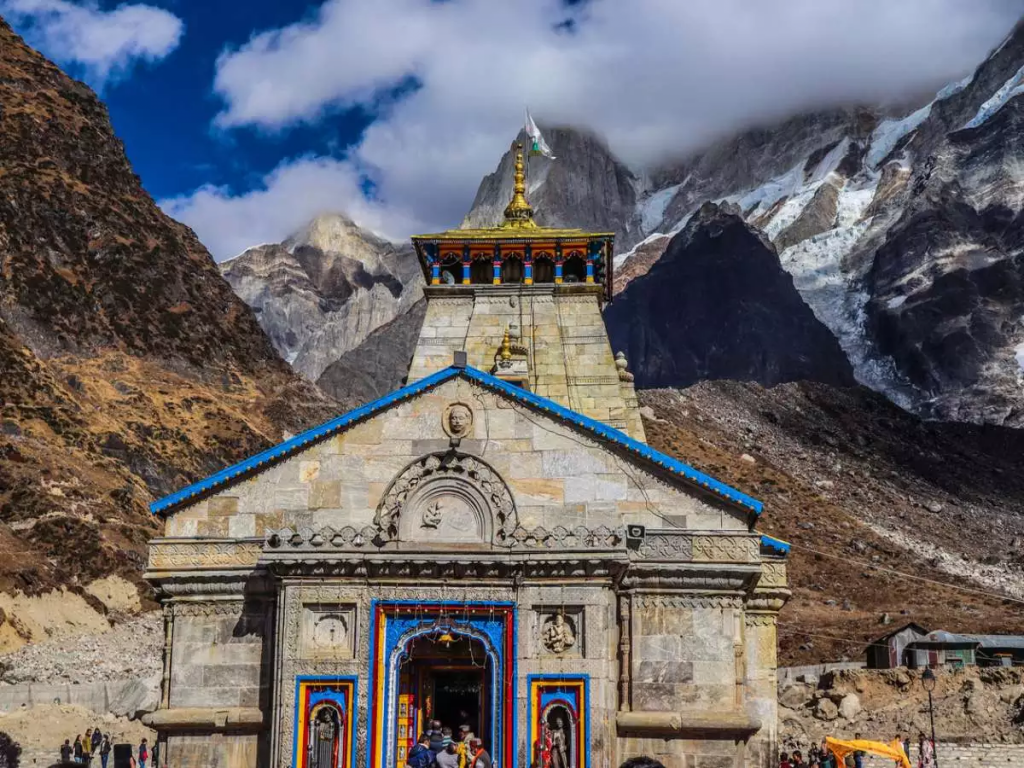
Introduction:
Kedarnath Trek – Nestled amidst the mighty Himalayas lies the sacred destination of Kedarnath, a revered pilgrimage site for Hindus and a trekker’s paradise. The Kedarnath Trek offers not only breathtaking views of nature but also a glimpse into the rich history and spirituality of the region.
History and Mythology: Kedarnath Temple
The history of Kedarnath is intertwined with Hindu mythology. Legend has it that after the great Mahabharata war, the Pandavas sought redemption for their sins of fratricide. Lord Shiva, unwilling to forgive them, took the form of a bull and fled, diving into the ground at Kedarnath. The hump remained visible, thus giving rise to the revered Jyotirlinga of Kedarnath.
The Trekking Experience: Kedarnath Trek
Embarking on the Kedarnath Trek is not just a physical journey but a spiritual odyssey. The trek typically starts from Gaurikund, where devotees take a dip in the hot springs before commencing their journey. The trail winds through picturesque landscapes, lush forests, and challenging terrains, offering a test of endurance and faith.
Attractions of Kedarnath / What to See in Kedarnath
Kedarnath Temple : This ancient Hindu temple dedicated to Lord Shiva is the main attraction of the town. It’s one of the twelve Jyotirlingas and holds immense religious significance for Hindus. The temple’s architecture, nestled amidst the Himalayas, is awe-inspiring. Chorabari (Gandhi Sarovar) : This glacial lake is located around 3 km from Kedarnath and is believed to be the place where Mahatma Gandhi’s ashes were immersed. The trek to Chorabari offers serene views of the surrounding mountains and glaciers. Bhairavnath Temple : Situated around 1 km away from Kedarnath Temple, this temple is dedicated to Bhairava, a fierce manifestation of Lord Shiva. It’s believed that visiting this temple is essential for a complete pilgrimage to Kedarnath. Vasuki Tal : A picturesque lake located at an altitude of around 4,150 meters above sea level, Vasuki Tal is surrounded by breathtaking Himalayan peaks. It’s a popular trekking destination, offering stunning views of the surrounding landscapes. Trijuginarayan Temple : Located around 5 km away from Kedarnath, this temple is believed to be the place where Lord Shiva and Goddess Parvati got married. The eternal flame burning at this temple is said to have witnessed their wedding. Gaurikund : Situated around 16 km from Kedarnath, Gaurikund is a small town known for its hot water springs. It’s also the starting point for the trek to Kedarnath Temple. Rambara : Located en route to Kedarnath Temple, Rambara is a scenic spot surrounded by lush greenery and towering mountains. It’s a popular camping site for trekkers and pilgrims..
Activities in Kedarnath
Spiritual exploration:.
- Visit Kedarnath Temple : Explore the ancient and revered Kedarnath Temple dedicated to Lord Shiva.
- Offer Prayers : Participate in religious rituals and offer prayers at various temples and sacred sites.
- Attend Aarti : Experience the divine atmosphere by attending the evening aarti (ritual of worship) at Kedarnath Temple.
Nature and Adventure:
- Trekking : Embark on treks to scenic spots like Vasuki Tal, Chorabari, and Gaurikund.
- Pilgrimage Trek : Undertake the pilgrimage trek from Gaurikund to Kedarnath Temple.
- Scenic Views : Enjoy panoramic views of the Himalayas and surrounding landscapes.
- Photography : Capture the breathtaking natural beauty of the region through photography.
Cultural Immersion:
- Explore Local Culture : Interact with locals and learn about their customs, traditions, and way of life.
- Visit Trijuginarayan Temple : Explore the historic Trijuginarayan Temple associated with the marriage of Lord Shiva and Goddess Parvati.
- Attend Festivals : If your visit coincides with local festivals, participate in the celebrations to experience the vibrant culture of the region.
Relaxation and Reflection:
- Meditation : Find peace and tranquility amidst the serene surroundings for meditation and introspection.
- Hot Springs : Relax and rejuvenate in the natural hot water springs of Gaurikund.
- Nature Walks : Take leisurely walks amidst the lush greenery and serene atmosphere for relaxation and reflection.
Adventure Sports (Depending on Availability):
- Helicopter Ride : Experience a thrilling helicopter ride offering aerial views of Kedarnath and the surrounding Himalayan peaks.
- Pony Rides : Enjoy pony rides for a unique perspective of the landscape, especially during the trek to Kedarnath Temple.
Wildlife and Nature Observation:
- Bird Watching : Explore the rich avifauna of the region through birdwatching expeditions.
- Flora and Fauna : Observe the diverse flora and fauna of the Himalayan ecosystem.
Environmental Conservation:
- Responsible Tourism : Practice responsible tourism by minimizing your environmental footprint and respecting the local ecosystem.
- Educational Tours : Participate in educational tours or workshops focused on environmental conservation and sustainability.
Inspire Tourist in Kedarnath
🌟 discover divine majesty in kedarnath 🌟.
Welcome to a land where spirituality gracefully intertwines with splendor, where ancient temples majestically stand tall amidst the towering Himalayan peaks, and where every step becomes a profound journey of self-discovery. Welcome to Kedarnath!
Embark on a Spiritual Odyssey :
Embark on a journey deep into the heart of Hindu spirituality as you gracefully visit the sacred Kedarnath Temple, a timeless symbol of devotion and faith. Let the echoes of hymns resonate within you and the soothing scent of incense gently guide you on a soul-stirring pilgrimage.
Embrace Nature’s Magnificence :
Immerse yourself in the breathtaking beauty of the Himalayas as you gracefully trek through pristine forests, marvel at cascading waterfalls, and deeply breathe in the crisp mountain air. From the tranquil shores of Vasuki Tal to the majestic vistas of Chorabari, every moment unfolds as a captivating brushstroke of Mother Nature’s masterpiece.
Experience Cultural Richness :
Immerse yourself deeply in the rich tapestry of Kedarnath’s culture and traditions. Explore the historic temples, witness the age-old rituals, and engage with the warm-hearted locals, whose hospitality knows no bounds. Let every encounter along the way be a joyous celebration of unity amidst diversity.
Renew Your Spirit :
Reconnect deeply with yourself amidst the serene surroundings of Kedarnath. Meditate in the tranquil meadows, soak in the healing waters of Gaurikund, and find solace in the comforting embrace of the mountains. In Kedarnath, every moment graciously extends an invitation to rediscover inner peace and serenity.
Create Unforgettable Memories :
Whether you’re a seeker of adventure or a seeker of the soul, Kedarnath graciously offers experiences that will linger with you forever. Capture the breathtaking sunsets that paint the sky in hues of gold, embark on thrilling treks that courageously test your limits, and forge bonds that beautifully transcend language and borders.
Come, Be Enchanted :
Allow Kedarnath to gracefully weave its magic upon you. Let its timeless allure gently awaken your spirit, ignite your senses, and tenderly leave an indelible imprint on your heart. In every whisper of the wind and every gentle rustle of the leaves, hear the resounding call of the mountains, warmly beckoning you to embark on a journey of a lifetime.
Kedarnath Awaits Your Presence!
SEASONS OF KEDARNATH:-
Kedarnath experiences distinct seasons throughout the year, each offering its own unique charm and opportunities for exploration. Here’s a glimpse into the different seasons of Kedarnath:
Spring (March to May) :
- As spring gracefully unfolds in Kedarnath, a sense of renewal permeates the air as the snow begins to melt, revealing the lush green meadows and vibrant blooming flowers. The weather during this season is pleasantly mild, making it ideal for trekking and engaging in various outdoor activities. Pilgrims can joyfully embark on their sacred journey to Kedarnath Temple amidst the vibrant colors of nature, further enriching their spiritual experience.
Summer (June to August) :
- During the summer months, Kedarnath welcomes visitors with mild temperatures during the day and pleasantly cool nights, creating an ideal atmosphere for exploration. It marks the peak pilgrimage season, with a significant influx of devotees making their way to the revered Kedarnath Temple. Amidst this bustling period, the surrounding Himalayan landscapes reveal their most picturesque vistas, enticing adventurers with abundant opportunities for trekking and sightseeing.
Monsoon (July to September) :
- During the monsoon season, Kedarnath experiences heavy rainfall, often resulting in landslides and disruptions in travel. Despite the challenges posed by the rain, the region’s lush greenery flourishes, imbuing the surroundings with a serene and refreshing atmosphere. Pilgrims are advised to exercise caution and stay updated on weather conditions before planning their visit during the monsoon.
Autumn (October to November) :
- As autumn gracefully unfolds in Kedarnath, it heralds a transitional period characterized by clear skies, pleasant temperatures, and breathtaking views of the surrounding Himalayas. Following the monsoon season, the crowds gradually thin out, offering travelers a more serene and peaceful experience amidst the majestic landscape. This season presents an excellent opportunity for trekking and engaging in various outdoor activities before the arrival of winter.
Winter (December to February) :
- As winter descends upon Kedarnath, it gracefully blankets the landscape in a layer of snow, transforming the region into a pristine winter wonderland. During this season, the Kedarnath Temple remains closed, safeguarded from the heavy snowfall and harsh weather conditions. However, adventurous travelers can still immerse themselves in the beauty of Kedarnath through activities like snow trekking and photography. Nevertheless, such endeavors demand careful planning and thorough preparation to ensure a safe and memorable experience amidst the snowy wilderness.
Each season in Kedarnath offers a unique perspective and presents travelers with diverse experiences, whether it’s the spiritual journey of pilgrimage, the thrill of adventure amidst nature, or the simple joy of witnessing the changing seasons in the lap of the Himalayas.
ENQUIRY NOW
- FEATURES OF KEDARNATH
Sacred Pilgrimage Site:
- Kedarnath is revered as one of the holiest pilgrimage sites in Hinduism, drawing devotees from around the world to pay homage to Lord Shiva.
Historic Temple:
- The ancient Kedarnath Temple, dating back over a thousand years, stands as a testament to architectural brilliance and spiritual devotion.
Breathtaking Location:
- Perched amidst the Garhwal Himalayas, Kedarnath offers awe-inspiring views of snow-capped peaks, verdant valleys, and pristine alpine meadows..
Challenging Trek:
- The journey to Kedarnath involves a challenging trek spanning approximately 16 kilometers, rewarding trekkers with adventure and spiritual fulfillment.
KEDARNATH– VITAL INFORMATIONS
- TEMP –May- June-20℃/Min- 5 ℃
- Best time to visit Chopta.-(May-Jun)/(Sep-Oct)
- Kedarnath Situated in – Ukhimath
- Recommended days in Chopta –4 D & 3N
- Nearest Railways Station from Kedarnath – Rishikesh
- Nearest Airport from Kedarnath- Jolly Grant
- Kedarnath is Famous for – the Shiva Temple, Snow-clad peaks, and Natural Beauty.
CHOPTA TRAVEL GUIDE
- Trekking in Kedarnath
- Camping in Kedarnath
- Kedarnath in Summer
- Kedarnath in Monsooon
- Kedarnath in Winter
- Adventure Activities in Kedarnath
- KedarnathFAQs
KEDARNATH TRAVEL TIPS
Kedarnath map direction tip.
- Before embarking on the journey to Kedarnath, ensure you have a reliable map or GPS navigation system. The trekking route is well-marked but can be challenging in certain sections, so having a map handy can help you stay on track and reach your destination safely.
Kedarnath Trek Tips
- Be prepared for the trek by wearing comfortable trekking shoes, carrying sufficient water and snacks, and dressing in layers to adapt to changing weather conditions. Start early in the day to avoid trekking during the hottest hours, and take regular breaks to rest and acclimatize to the altitude.
Kedarnath Tour Transport Tip
- The nearest major town to Kedarnath is Gaurikund, which is accessible by road from cities like Rishikesh and Haridwar. From Gaurikund, the trek to Kedarnath begins, and pony and palanquin services are available for those who prefer not to trek the entire distance.
Kedarnath ATM’s Tip
- There are limited ATM facilities in Gaurikund, so it’s advisable to carry sufficient cash with you for the duration of your stay and trek. It’s also recommended to inform your bank about your travel plans to ensure seamless transactions if using international cards..
Kedarnath Market Tip
- Gaurikund has a small market where you can purchase essential supplies like snacks, water, trekking gear, and religious offerings. However, the options may be limited, so it’s best to carry any specific items you may need during your trek.
- Best Hotel of Chopta – Hotel Gokuldham
KEDARNATH IMAGES | BEST TIME TO VISIT KEDARNATH | HOW TO REACH KEDARNATH | KEDARNATH ACTIVITIES | KEDARNATH TOURS | KEDARNATH WEATHER

IMAGES
VIDEO
COMMENTS
The trek leads to the Kedarnath temple, one of the four major shrines in Hinduism, located at an altitude of 3,583 meters (11,755 feet) above sea level. The trek to Kedarnath starts from a place called Gaurikund, which is located at a distance of 16 km from Kedar Nath Temple.
The trek to Kedarnath Temple offers several beautiful and scenic locations that you can visit along the way. Here are some of the most popular places to visit during the Kedarnath trek: Gaurikund: Gaurikund is the base camp for the Kedarnath trek and is located at an altitude of 1,982 meters (6,503 feet) above sea level.
Kedarkantha Trek Cost: Rs. 7,500.00 Per Person including all costs of the trek from 05 nights to 06 Days from Dehradun to Dehradun. Summer Temperature:- Day 5°C to 15°C and Night 2° C to 5° C. Winter Temperature:- Day -2°C to -5° C and Night -5°C to -10°C. Kedarkantha Summit -Altitude: - 12,500 feet.
Trek to Kedarnath: The main way to reach the temple is by trekking from Gaurikund. The trekking distance is around 16-18 km, and it usually takes about 6-8 hours to complete. ... Kedarnath Temple: At an altitude of around 3,583 meters (11,755 feet), the Kedarnath Temple is one of the holiest Hindu shrines dedicated to Lord Shiva. Pilgrims and ...
Challenges Faced During the Trek. While the Kedarnath Trek offers a spiritually enriching experience, it also presents several challenges that pilgrims and trekkers need to be aware of: Altitude: The trek involves ascending to high altitudes, with Kedarnath Temple located at an elevation of approximately 3,583 meters (11,755 feet). Altitude ...
🏔️ Kedarnath trek distance - 16 Km (From Gaurikund). 🏔️ How Much Time It Takes For Kedarnath Trek: 3 to 4 Days . 🏔️ Difficulty Level: Moderate. 🏔️ Altitude: 3583 Meters . You can reach Gaurikund by air, train, bus, and taxi from various points like Dehradun, Rishikesh, and Haridwar.. Further, if you have physical limitations, you can make this beautiful journey by ...
The winter months, spanning from December to April, transform the region into a magical winter wonderland, Kedarkantha trek best time in our opinion. Trekking through the powdery snow, adventurers encounter frozen lakes, dense alpine forests, and a challenging yet rewarding journey. The chilly temperatures add an element of thrill, making it an ...
Day 2: Guptkashi to Sonprayag, then Trek to Kedarnath. Trek Distance: 16 km. Trek Time: 7-8 hours. Altitude: 6,558 ft. Altitude Gain: 5,072 ft. Next morning drive from Guptkashi to Sonprayag. Driving distance is 30 km and will take 1-2 hours to complete.
Kedarkantha Trek - All You Need to Know Kedarkantha Trek at a Glance. Difficulty: Moderate (Suitable for Beginners) Kedarkantha Trail: Dense Pine & Oak forests, open meadows & snow during winters. Region: Uttarakhand Base Camp: Sankri (200 kms from Dehradun) Kedarkantha Altitude: 6,000 ft at Sankri to 12,500 ft. at Kedarkantha Peak Kedarkantha Trek Distance: 25 km (Approx)
The temple itself lies at the base of the Kedarnath Peak, facing the Kedar Parvat. ... About the Kedarkantha Trek. ... Kedarkantha Height / Altitude. Kedarkantha is an altitude of 3800 meters in height and offers a 360-degree view of Pangarchulla, Har ki Doon and Swargarohini peaks of the high Himalayas. ...
Kedarnath is a scenic, revered temple town in the mighty Garhwal Himalayas, also known as the "Abode of The Gods". The journey towards this pilgrim site of Lord Shiva is beautiful; the lush green landscapes, the stunning backdrop of the Kedarnath range by the beautiful Mandakini River, the sound of the temple bells that take you to an altitude of almost 3,600 feet.
The reason for calling it Kedar Kantha, rumors from villagers is; 1st they tried to build Kedarnath temple in that peak but they heard some animal's sound which means omen for a divine event. ... When planning a high-altitude trek, it is important to prepare for the cold weather. Wearing layers is the best approach as it provides both ...
Make sure you have appropriate adventure insurance that covers trekking in high-altitude areas. 7. Navigation and Trail Safety: Importance: Navigating snowy trails requires caution and skill. ... Legend has it that the peak was meant to be the original Kedarnath temple, but Lord Shiva, who was disguised as a cow hiding from the Pandavas, was ...
Kedarnath, holding at an altitude of 3,553 meters from the sea level, is located in the Rudraprayag district of Uttarakhand. Of all the Chardham Yatra, Kedarnath Yatra holds greater importance because of its religious significance and also because of the level of difficulty it involves to reach the shrine of Lord Shiva.The journey to this holy shrine includes a trek from Gaurikund.
Kedarnath (3,553 metres, approximately) is a Hindu temple dedicated to Lord Shiva located in the Rudraprayag district of Uttarakhand. It lies just below the base of the mighty Kedarnath peak (6,940 metres), and is the First Kedar to be visited in case you are staying true to the sequence of the Panch Kedar circuit.
Altitude: 12,500 ft (3,810 m) / 11,253 ft (3,430 m) Trek Duration: 7-8 hours. Today is the day of the summit and you start the trek at 3 AM in the morning. The climb to the summit is about 4-5 hours long and depending on the amount of snow, the trek lead and guide will decide on the best possible way to reach the summit.
Travel from Guptkashi (Altitude 1,319 m) to Gaurikund (Altitude 1982 m) and then Trek to Kedarnath (Altitude 3583 m) Altitude: 1,319 m to 1982 m to 3583 m Distance: By Road - 15.3 km & Trek - 14 km Duration: By Road - 1 hr 12 min & Trek - 6 hours Start your morning with a delicious breakfast and feel energized to start the most important day of your trekking tour when you will finally trek to ...
The altitude of Kedarnath is approximately 3,583 meters (11,755 feet) above sea level. This high altitude can affect trekkers in several ways, including decreased oxygen levels, which may lead to altitude sickness symptoms such as headache, nausea, and fatigue.
Things To Carry For Kedarkantha Trek: A Complete Guide. 1. Valid ID Proof. Carrying an original and valid photo identity proof is mandatory for any trek in India. This is needed at checkposts and campsites. Recommended ID proofs are an Aadhar Card, Driving License, Voter ID, or Passport.
Kedarkantha (not to be confused with the popular Temple Kedarnath) is a 6-day long trek in Govind Pashu Vihar National Park in Uttarakhand (6 when including the travel days from Dehradun to the base camp and back). Kedarkantha is easily one of the most popular treks in India — popular amongst seasoned trekkers and beginners alike.
Kedarnath is a pilgrimage site or tirtha dedicated to the Hindu deity Shiva.It is one of the four pilgrimage spots that form a part of the Uttarkhand Char Dham yatra or Chota Char Dham yatra. [6] The temple's construction is credited to the Pandava brothers mentioned in the Mahabharata. [7] [8] However, the Mahabharata does not mention any place called Kedarnath.
Gallery. The Kedarnath temple, located at an altitude of 3583m, is one of the Panch (5) Kedars of Lord Shiva and is revered as one of the most important shrines of Lord Shiva. It is a relatively easy trek of 23km. This distance will shortly be reduced by another 5km once the repair work of the route post the destructive floods that ravaged the ...
Kedarnath Trek Tips; Be prepared for the trek by wearing comfortable trekking shoes, carrying sufficient water and snacks, and dressing in layers to adapt to changing weather conditions. Start early in the day to avoid trekking during the hottest hours, and take regular breaks to rest and acclimatize to the altitude. Kedarnath Tour Transport Tip